Birds of Yucatan listed by their systematic.
Mittelsaeger Weibchen auf Lago Maggiore, Locarno. 2021-04-06 13.18.48 Northern Lago Maggiore
First observed in 🇨🇭 on 2021-04-06.
This bird appears across the great seas in the following continents:
Europe, North America.
Personal notes: ![]() Zuerst gesehen in Lago Maggiore in Locarno. Jan 2022 auch als Wintergast am Pfaeffikersee. [Link]
Zuerst gesehen in Lago Maggiore in Locarno. Jan 2022 auch als Wintergast am Pfaeffikersee. [Link]
Appearance and identification: ![]() In winter you can admire a few of these birds with the straggly tuft. [Link]
In winter you can admire a few of these birds with the straggly tuft. [Link]
Habitats:
River and lake
Looks similar to:
Greater scaup.
Krickente am Aa-Bach beim Südende des Pfäffikersee 2021-01-26 15.41.54 Pfäffikersee
First observed in 🇨🇭 on 2021-01-26.
This bird appears across the great seas in the following continents:
Europe, North America, South America, Africa, Asia.
Wintergast am Teich am Aa-Bach beim Südende des Pfäffikersee
Etymology: ![]() Die hellen «krrik»-Rufe der stimmfreudigen Erpel verhalfen dieser Art zu ihrem deutschen Namen. [Link]
Die hellen «krrik»-Rufe der stimmfreudigen Erpel verhalfen dieser Art zu ihrem deutschen Namen. [Link]
Vocalization: ![]() Male: characteristic, short, highly resonant and metallic "plytt". A bit similar to Pintail, but higher pitched and lacking accompanying whistling sound. Female: various quacking sounds generally quicker paced, more nasal and noticeably higher pitched than Mallard. [Link]
Male: characteristic, short, highly resonant and metallic "plytt". A bit similar to Pintail, but higher pitched and lacking accompanying whistling sound. Female: various quacking sounds generally quicker paced, more nasal and noticeably higher pitched than Mallard. [Link]
Physical details: length=34-38 cm,
wingspan=58-64 cm,
weight=200-450 g
Habitats:
River and lake
Call:
Blup blup, fast wie vom Computer generiert, fur mich nohe Noten (obwohl Sonogram nur 2.5 KHz zeigt)
Krickente Ruf von XenoCanto
♫ Krickente Ruf von XenoCanto Source: XENOCANTO
XC619133-Krickente von Peter Bosman, Belgium.mp3
(call)

Call attributes:
Call melody: simple rhythmic, slow, Frequency: low (1-3 KHz),
Loeffelenten am Greifensee bei Silberweide Es gab dutzende davon, dazwischen eine Krickente. 2021-02-08 15.20.36
First observed in 🇨🇭 on 2021-02-08.
This bird appears across the great seas in the following continents:
Europe, North America, South America, Africa.
Wintergast am Greifensee.
PK: white, black, rust-brown, yellow eyes, black spoonbill, red legs.
Vocalization: ![]() Male is characteristic and most often heard: A hoarse nasal knocking sound "took took", often staccato or disyllabic. Female similar to Mallard but flatter and more creaking. [Link]
Male is characteristic and most often heard: A hoarse nasal knocking sound "took took", often staccato or disyllabic. Female similar to Mallard but flatter and more creaking. [Link]
Physical details: length=44-52 cm,
wingspan=70-84 cm,
weight=470-800 g
Habitats:
River and lake
Profile Wikipedia eBird Vogelwarte BirdLife ZH ornitho.ch Audubon AllAboutBirds Xeno-Canto BirdID NABU
Spiessente Paar. 2022-02-05 13.14.54 Klingnauer Stausee (man-made lake)
First observed in 🇨🇭 on 2022-02-05.
This bird appears across the great seas in the following continents:
Europe, North America, South America, Africa, Asia.
Long tailfeathers make the name obvious, also a thin white stripe from the white neck up the back of the head.
Vocalization: ![]() Female: similar to Mallards coarse laughing sound, but with a more emphasized first "haaa", and a more silent accelerating subsequent "laugh". Male: Pleasant, resonant "plop" similar to Teal, but lower pitched, richer, mellower and not so metallic. Accompanied by a higher pitched, slightly raspy whistling "aiiooo" rising and falling in pitch. [Link]
Female: similar to Mallards coarse laughing sound, but with a more emphasized first "haaa", and a more silent accelerating subsequent "laugh". Male: Pleasant, resonant "plop" similar to Teal, but lower pitched, richer, mellower and not so metallic. Accompanied by a higher pitched, slightly raspy whistling "aiiooo" rising and falling in pitch. [Link]
Physical details: length=51-66 cm,
wingspan=51-66 cm,
weight=500-1100 g
Habitats:
River and lake
Schnatterente am Greifensee bei Silberweide Es gab dutzende davon, dazwischen eine Krickente. 2021-02-08 15.45.18
First observed in 🇨🇭 on 2021-02-08.
This bird appears across the great seas in the following continents:
Europe, North America, Africa.
In my mind this is the chocolate duck.
Etymology: ![]() The etymology of the word gadwall is not known, but the name has been in use since 1666.[9] [Link]
The etymology of the word gadwall is not known, but the name has been in use since 1666.[9] [Link]
Nabu: Die Schnatterente fällt aber – wie ihr Name schon vermuten lässt – durch ihre Art der Nahrungssuche auf. Sie durchschnattert das Wasser mit ihrem Schnabel. [Link]
Chocolate bill, black-and-white pattern on head, shoulders, belly, sides of wings, chocolate patterned wings, black butt, a bit of white before the butt.
Appearance and identification: Nabu: Die Schnatterente ähnelt auf den ersten Blick so sehr der weiblichen Stockente, dass man diese schnell verwechseln kann. [Link]
Wintergast am Greifensee.
Calls: ![]() Males display-call a short dry rattling or croaking sound and some high whistling notes. Female quacking similar to Mallard, but drier and shriller. [Link]
Males display-call a short dry rattling or croaking sound and some high whistling notes. Female quacking similar to Mallard, but drier and shriller. [Link]
Physical details: length=46-56 cm,
wingspan=84-95 cm,
weight=550-1000 g
Habitats:
River and lake
Call:
Automatically generated from Xeno-Canto recording
♫ Schnatterenten, Moewen und an 29 Sekunden eindeutig ein Jet von Swiss, da wir in Neeracherried sehr nach am Kloten Flughafen sind, BirdNet schlaegt auch Teichrohrsaenger vor, wie auch ein Moewe-Typ aus Kalifornien. ![]() Source: Zoom H6 2021-10-24 13.12.46 Neeracherried (song?)
Source: Zoom H6 2021-10-24 13.12.46 Neeracherried (song?)

Wikipedia: Lesser scaup Source: OTHER
1200px-Lesser_scaup_-_Aythya_affinis.jpg
General: ![]() The lesser scaup (Aythya affinis) is a small North American diving duck that migrates south as far as Central America in winter. It is colloquially known as the little bluebill or broadbill because of its distinctive blue bill. The origin of the name scaup may stem from the bird's preference for feeding on scalp—the Scottish word for clams, oysters, and mussels; however, some credit it to the female's discordant scaup call as the name's source.[2] It is apparently a very close relative of the Holarctic greater scaup or "bluebill" (A. marila), with which it forms a superspecies.[3][4] The scientific name is derived from Ancient Greek aithuia an unidentified seabird mentioned by authors including Hesychius and Aristotle, and Latin, affinis "related to", from its resemblance to the greater scaup.[5]
[more]
The lesser scaup (Aythya affinis) is a small North American diving duck that migrates south as far as Central America in winter. It is colloquially known as the little bluebill or broadbill because of its distinctive blue bill. The origin of the name scaup may stem from the bird's preference for feeding on scalp—the Scottish word for clams, oysters, and mussels; however, some credit it to the female's discordant scaup call as the name's source.[2] It is apparently a very close relative of the Holarctic greater scaup or "bluebill" (A. marila), with which it forms a superspecies.[3][4] The scientific name is derived from Ancient Greek aithuia an unidentified seabird mentioned by authors including Hesychius and Aristotle, and Latin, affinis "related to", from its resemblance to the greater scaup.[5]
[more]

Wikipedia: Ring-necked duck Source: OTHER
Aythya-collaris-001.jpg
![]() The ring-necked duck (Aythya collaris) is a diving duck from North America commonly found in freshwater ponds and lakes.[2] The scientific name is derived from Greek aithuia, an unidentified seabird mentioned by authors including Hesychius and Aristotle, and Latin collaris, "of the neck" from collum, "neck".[3]
[more]
The ring-necked duck (Aythya collaris) is a diving duck from North America commonly found in freshwater ponds and lakes.[2] The scientific name is derived from Greek aithuia, an unidentified seabird mentioned by authors including Hesychius and Aristotle, and Latin collaris, "of the neck" from collum, "neck".[3]
[more]
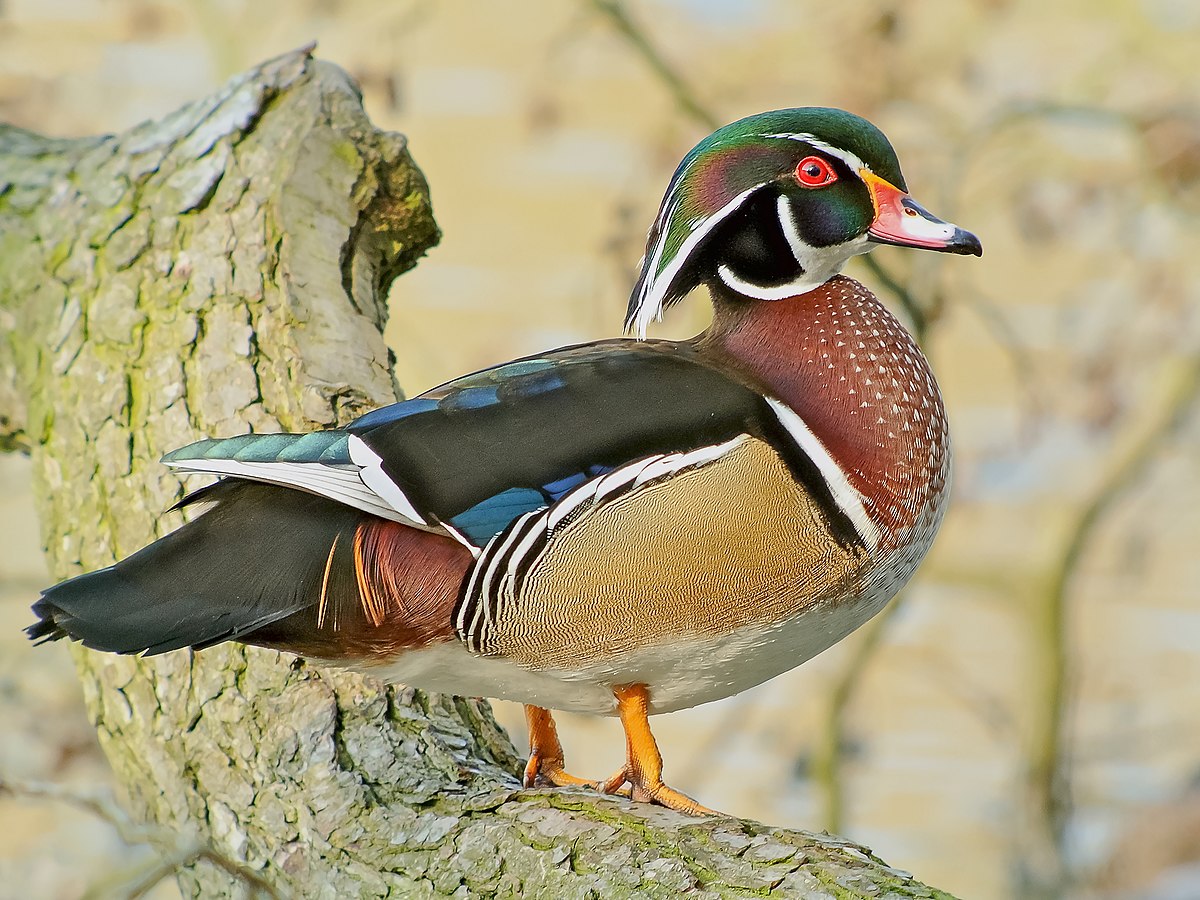
Wikipedia: Wood duck Source: OTHER
1200px-Wood_Duck_%28Aix_sponsa%29%2C_Parc_du_Rouge-Clo%C3%AEtre%2C_Brussels.jpg
This bird appears across the great seas in the following continents:
Europe, North America.
![]() The wood duck or Carolina duck (Aix sponsa) is a species of perching duck found in North America. It is one of the most colorful North American waterfowl.[2][3]
[more]
The wood duck or Carolina duck (Aix sponsa) is a species of perching duck found in North America. It is one of the most colorful North American waterfowl.[2][3]
[more]

Wikipedia: Muscovy duck Source: OTHER
MuscovyDuck.jpg
![]() The Muscovy duck (Cairina moschata) is a large duck native to Mexico and Central and South America. Small wild and feral breeding populations have established themselves in the United States, particularly in Florida, Louisiana, Massachusetts, and the lower Rio Grande Valley of Texas, the Big Island of Hawaii, as well as in many other parts of North America, including southern Canada. Feral Muscovy ducks are found in New Zealand, Australia, and in parts of Europe.
[more]
The Muscovy duck (Cairina moschata) is a large duck native to Mexico and Central and South America. Small wild and feral breeding populations have established themselves in the United States, particularly in Florida, Louisiana, Massachusetts, and the lower Rio Grande Valley of Texas, the Big Island of Hawaii, as well as in many other parts of North America, including southern Canada. Feral Muscovy ducks are found in New Zealand, Australia, and in parts of Europe.
[more]

Wikipedia: Masked duck Source: OTHER
1200px-Masked_duck_%28Nomonyx_dominicus%29.jpg
![]() The masked duck (Nomonyx dominicus) is a tiny stiff-tailed duck ranging through the tropical Americas. They are found from Mexico to South America and also in the Caribbean. Primarily not migratory, masked ducks are reported as very uncommon vagrants in the southernmost United States, along the Mexican border and in Florida. As of 2000, the conservation status for masked ducks in Texas is 3,800 birds.[2] On April 1, 1962, it was recorded from Lowndes County, Georgia, where it was photographed by Alexander Wetmore.[3]
[more]
The masked duck (Nomonyx dominicus) is a tiny stiff-tailed duck ranging through the tropical Americas. They are found from Mexico to South America and also in the Caribbean. Primarily not migratory, masked ducks are reported as very uncommon vagrants in the southernmost United States, along the Mexican border and in Florida. As of 2000, the conservation status for masked ducks in Texas is 3,800 birds.[2] On April 1, 1962, it was recorded from Lowndes County, Georgia, where it was photographed by Alexander Wetmore.[3]
[more]
![]() Die Zwergschneegans (Anser rossii), auch Ross-Schneegans, ist eine in Nordamerika einheimische Art der Feldgänse und gehört damit zu den echten Gänsen (Anserini). Sie wird zuweilen auch mit der Schneegans (Anser caerulescens), der Kaisergans (Anser canagicus) und der Streifengans (Anser indicus) in eine eigene Gattung mit dem wissenschaftlichen Namen Chen gestellt. Sie ist die kleinste der arktischen Gänse. Die Art wurde erstmals 1861 durch J. Cassin wissenschaftlich beschrieben.
[more]
Die Zwergschneegans (Anser rossii), auch Ross-Schneegans, ist eine in Nordamerika einheimische Art der Feldgänse und gehört damit zu den echten Gänsen (Anserini). Sie wird zuweilen auch mit der Schneegans (Anser caerulescens), der Kaisergans (Anser canagicus) und der Streifengans (Anser indicus) in eine eigene Gattung mit dem wissenschaftlichen Namen Chen gestellt. Sie ist die kleinste der arktischen Gänse. Die Art wurde erstmals 1861 durch J. Cassin wissenschaftlich beschrieben.
[more]
Blue-winged teal (Spatula discors)
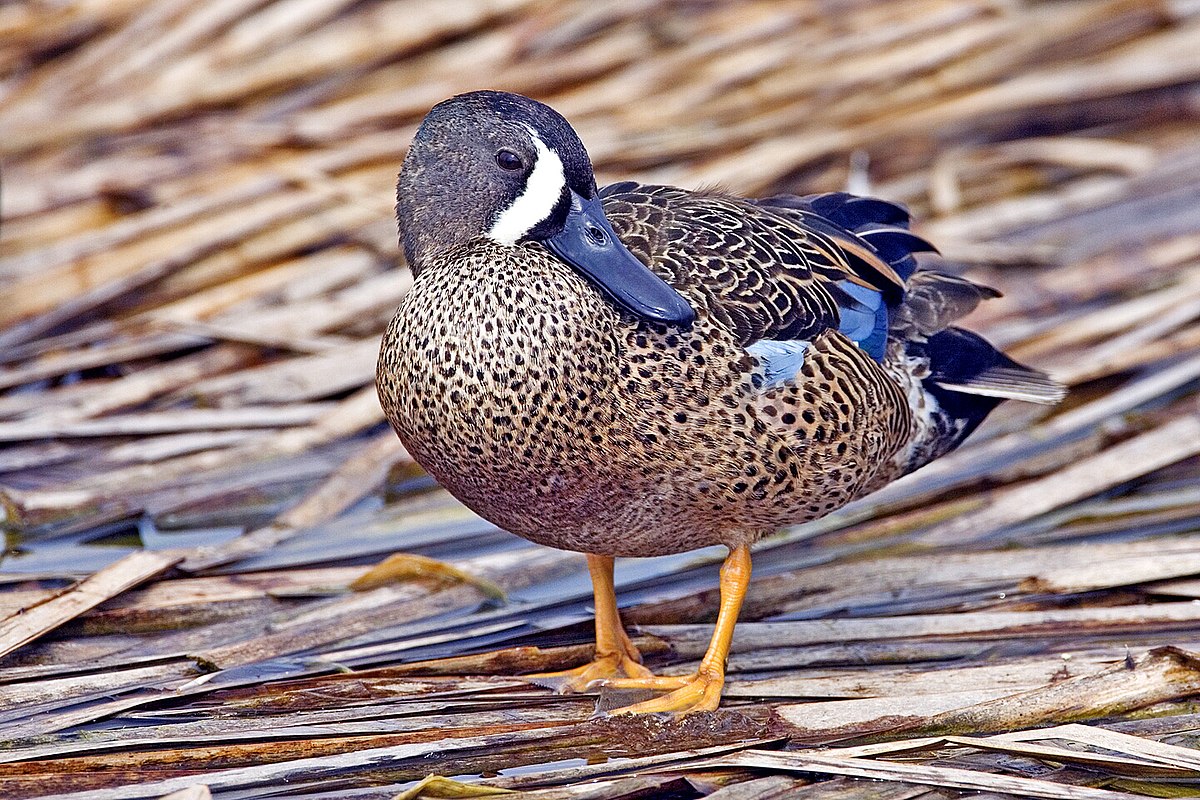
Wikipedia: Blue-winged teal Source: OTHER
1200px-Blue-Winged_Teal.jpg
![]() The blue-winged teal (Spatula discors) is a species of bird in the duck, goose, and swan family Anatidae. One of the smaller members of the dabbling duck group, it occurs in North America, where it breeds from southern Alaska to Nova Scotia, and south to northern Texas. It winters along the Pacific and Atlantic coasts and south into the Caribbean islands and Central America.
[more]
The blue-winged teal (Spatula discors) is a species of bird in the duck, goose, and swan family Anatidae. One of the smaller members of the dabbling duck group, it occurs in North America, where it breeds from southern Alaska to Nova Scotia, and south to northern Texas. It winters along the Pacific and Atlantic coasts and south into the Caribbean islands and Central America.
[more]

Wikipedia: Fulvous whistling-duck Source: OTHER
1200px-Dendrocygna_bicolor_wilhelma.jpg
This bird appears across the great seas in the following continents:
North America, South America, Africa.
![]() The fulvous whistling duck or fulvous tree duck (Dendrocygna bicolor) is a species of whistling duck that breeds across the world's tropical regions in much of Mexico and South America, the West Indies, the southern United States, sub-Saharan Africa and the Indian subcontinent. It has plumage that is mainly reddish brown, long legs and a long grey bill, and shows a distinctive white band across its black tail in flight. Like other members of its ancient lineage, it has a whistling call which is given in flight or on the ground. Its preferred habitat consists of wetlands with plentiful vegetation, including shallow lakes and paddy fields.
The nest, built from plant material and unlined, is placed among dense vegetation or in a tree hole. The typical clutch is around ten whitish eggs. The breeding adults, which pair for life, take turns to incubate, and the eggs hatch in 24–29 days. The downy grey ducklings leave the nest within a day or so of hatching, but the parents continue to protect them until they fledge around nine weeks later.
[more]
The fulvous whistling duck or fulvous tree duck (Dendrocygna bicolor) is a species of whistling duck that breeds across the world's tropical regions in much of Mexico and South America, the West Indies, the southern United States, sub-Saharan Africa and the Indian subcontinent. It has plumage that is mainly reddish brown, long legs and a long grey bill, and shows a distinctive white band across its black tail in flight. Like other members of its ancient lineage, it has a whistling call which is given in flight or on the ground. Its preferred habitat consists of wetlands with plentiful vegetation, including shallow lakes and paddy fields.
The nest, built from plant material and unlined, is placed among dense vegetation or in a tree hole. The typical clutch is around ten whitish eggs. The breeding adults, which pair for life, take turns to incubate, and the eggs hatch in 24–29 days. The downy grey ducklings leave the nest within a day or so of hatching, but the parents continue to protect them until they fledge around nine weeks later.
[more]

Wikipedia: Black-bellied whistling-duck Source: OTHER
1200px-Whistling_duck_flight02_-_natures_pics-edit1.jpg
![]() The black-bellied whistling duck (Dendrocygna autumnalis), formerly called the black-bellied tree duck, is a whistling duck that breeds from the southernmost United States, Mexico, and tropical Central to south-central South America. In the US, it can be found year-round in peninsular Florida, parts of southeast Texas, coastal Alabama and seasonally in southeast Arizona, and Louisiana's Gulf Coast. It is a rare breeder in such disparate locations as Arkansas, Georgia, Tennessee, and South Carolina, though it is now a common breeder in parts of central Florida. There is a large population of several hundred that winter each year in Audubon Park in uptown New Orleans, Louisiana. Since it is one of only two whistling duck species native to North America, it is occasionally just known as the "whistling duck" or "Mexican squealer" in the southern USA.
[more]
The black-bellied whistling duck (Dendrocygna autumnalis), formerly called the black-bellied tree duck, is a whistling duck that breeds from the southernmost United States, Mexico, and tropical Central to south-central South America. In the US, it can be found year-round in peninsular Florida, parts of southeast Texas, coastal Alabama and seasonally in southeast Arizona, and Louisiana's Gulf Coast. It is a rare breeder in such disparate locations as Arkansas, Georgia, Tennessee, and South Carolina, though it is now a common breeder in parts of central Florida. There is a large population of several hundred that winter each year in Audubon Park in uptown New Orleans, Louisiana. Since it is one of only two whistling duck species native to North America, it is occasionally just known as the "whistling duck" or "Mexican squealer" in the southern USA.
[more]
Neotropic cormorant (alternate) (Nannopterum brasilianum)
Great egret / Silberreiher (Ardea alba)

Silberreiher in Deutschland, von WikiCommons Von Andreas Eichler, CC BY-SA 4.0, https://commons.wikimedia.org/w/index.php?curid=59954907 Source: OTHER
Wikicommons 2016.10.30--Silberreiher.jpg
First observed in 🇨🇭 on 2021-02-24.
This bird appears across the great seas in the following continents:
Europe, North America, South America, Africa, Asia.
Auf dem Heimweg von Schwanden haben wir bei Benken ganz weisse Reiher gesehen.
Laut ornitho.ch waren sie Silberreiher.
Bei den meisten Quellen heisst es, sie sind in der Schweiz nur Durchzüger oder Wintergäste.
Aber laut Balzari und Gygax, brüten auch einige Vögel am Lac Neuchatel seit 2013.
Vocalization: ![]() Silent outside breeding ground. [Link]
Silent outside breeding ground. [Link]
Calls: ![]() In colonies various harsh calls like a dry, and mechanical "kerrrrrrr", and a very nasal "geet" or "ga-geet ga-geet" are heard. [Link]
In colonies various harsh calls like a dry, and mechanical "kerrrrrrr", and a very nasal "geet" or "ga-geet ga-geet" are heard. [Link]
Physical details: length=85-102 cm,
wingspan=140-170 cm,
weight=960-1030 g
Habitats:
Wetland
Call:
Partly an awkward quack: uck uck. Rattles. Deep-toned urrr. Higher-toned trill.
Call attributes:
Call melody: non-musical, slow, Frequency: low (1-3 KHz),
Great blue heron / Kanadareiher (Ardea herodias)
Profile Wikipedia eBird A-Z Animals Audubon AllAboutBirds Xeno-Canto
Great blue heron. 2022-04-28 18.15.08 Maryland
First observed in Maryland on 2021-06-17.
General: ![]() The great blue heron (Ardea herodias) is a large wading bird in the heron family Ardeidae, common near the shores of open water and in wetlands over most of North America and Central America, as well as the Caribbean and the Galápagos Islands. It is a rare vagrant to coastal Spain, the Azores, and areas of far southern Europe. An all-white population found in south Florida and the Florida Keys is known as the great white heron. Debate exists about whether this represents a white color morph of the great blue heron, a subspecies of it, or an entirely separate species.[2][3] The status of white individuals known to occur elsewhere in the Caribbean, and very rarely elsewhere in eastern North America, is unclear.[3]
[more]
The great blue heron (Ardea herodias) is a large wading bird in the heron family Ardeidae, common near the shores of open water and in wetlands over most of North America and Central America, as well as the Caribbean and the Galápagos Islands. It is a rare vagrant to coastal Spain, the Azores, and areas of far southern Europe. An all-white population found in south Florida and the Florida Keys is known as the great white heron. Debate exists about whether this represents a white color morph of the great blue heron, a subspecies of it, or an entirely separate species.[2][3] The status of white individuals known to occur elsewhere in the Caribbean, and very rarely elsewhere in eastern North America, is unclear.[3]
[more]
Black-crowned night-heron / Nachtreiher (Nycticorax nycticorax)

Wikipedia: Black-crowned night-heron Source: OTHER
1200px-BCNH_CMCNJ_for_Wiki.png
This bird appears across the great seas in the following continents:
Europe, North America, South America, Africa, Asia.
![]() The black-crowned night heron (Nycticorax nycticorax), or black-capped night heron, commonly shortened to just night heron in Eurasia, is a medium-sized heron found throughout a large part of the world, except in the coldest regions and Australasia (where it is replaced by the closely related nankeen night heron, with which it has hybridized in the area of contact).
[more]
The black-crowned night heron (Nycticorax nycticorax), or black-capped night heron, commonly shortened to just night heron in Eurasia, is a medium-sized heron found throughout a large part of the world, except in the coldest regions and Australasia (where it is replaced by the closely related nankeen night heron, with which it has hybridized in the area of contact).
[more]
Calls: ![]() Most commonly hear call is a nasal, soft croaking "roack", like cross between Raven and frog. [Link]
Most commonly hear call is a nasal, soft croaking "roack", like cross between Raven and frog. [Link]
Physical details: length=58-65 cm,
wingspan=105-112 cm,
weight=500-800 g
Habitats:
Wetland
Snowy egret / Schmuckreiher (Egretta thula)
Profile Wikipedia eBird Audubon AllAboutBirds Xeno-Canto
Snowy egret at John's Pass, Madeira Beach, Florida. 2023-09-27 11.51.14 Florida
First observed in Yucatan on 2023-04-15.
This bird appears across the great seas in the following continents:
North America, South America, Africa.
General: ![]() The snowy egret (Egretta thula) is a small white heron. The genus name comes from Provençal French for the little egret, aigrette, which is a diminutive of aigron, 'heron'. The species name thula is the Araucano term for the black-necked swan, applied to this species in error by Chilean naturalist Juan Ignacio Molina in 1782.[3]
[more]
The snowy egret (Egretta thula) is a small white heron. The genus name comes from Provençal French for the little egret, aigrette, which is a diminutive of aigron, 'heron'. The species name thula is the Araucano term for the black-necked swan, applied to this species in error by Chilean naturalist Juan Ignacio Molina in 1782.[3]
[more]
Little blue heron / Blaureiher (Egretta caerulea)
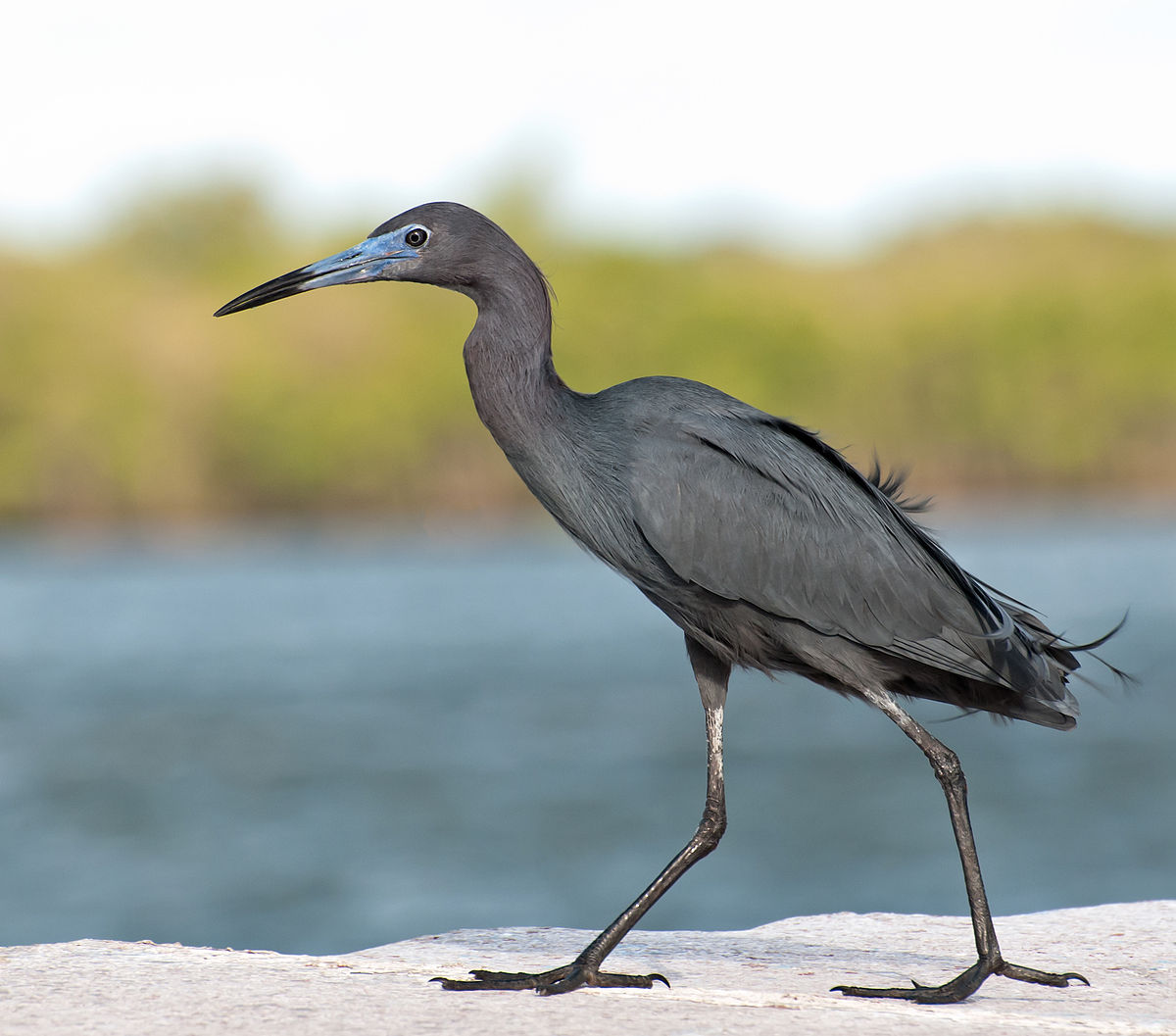
Wikipedia: Little blue heron Source: OTHER
1200px-Egretta_caerulea_-Cananeia%2C_Sao_Paulo%2C_Brasil-8.jpg
This bird appears across the great seas in the following continents:
North America, South America, Africa.
![]() The little blue heron (Egretta caerulea) is a small heron belonging to the family Ardeidae.
[more]
The little blue heron (Egretta caerulea) is a small heron belonging to the family Ardeidae.
[more]
Tricolored heron / Dreifarbenreiher (Egretta tricolor)
Profile Wikipedia eBird Audubon AllAboutBirds Xeno-Canto
Beautiful tricolored heron near Las Coloradas. 2023-04-15 10.04.30 Yucatan
First observed in Yucatan on 2023-04-15.
![]() The tricolored heron (Egretta tricolor), formerly known as the Louisiana heron, is a small species of heron native to coastal parts of the Americas; in the Atlantic region, it ranges from the northeastern United States, south along the coast, through the Gulf of Mexico and the Caribbean, to northern South America as far south as Brazil. In the Pacific region, it ranges from Peru to California, but it is only a nonbreeding visitor to the far north.
[more]
The tricolored heron (Egretta tricolor), formerly known as the Louisiana heron, is a small species of heron native to coastal parts of the Americas; in the Atlantic region, it ranges from the northeastern United States, south along the coast, through the Gulf of Mexico and the Caribbean, to northern South America as far south as Brazil. In the Pacific region, it ranges from Peru to California, but it is only a nonbreeding visitor to the far north.
[more]
Reddish egret / Rötelreiher (Egretta rufescens)
Profile Wikipedia eBird Audubon AllAboutBirds Xeno-Canto
Elegant reddish egret near Las Coloradas. 2023-04-15 10.05.52 Yucatan
First observed in Yucatan on 2023-04-15.
![]() The reddish egret (Egretta rufescens) is a medium-sized heron. It is a resident breeder in Central America, The Bahamas, the Caribbean, the Gulf Coast of the United States, and Mexico.[2] There is post-breeding dispersal to well north of the nesting range. In the past, this bird was a victim of the plume trade.
[more]
The reddish egret (Egretta rufescens) is a medium-sized heron. It is a resident breeder in Central America, The Bahamas, the Caribbean, the Gulf Coast of the United States, and Mexico.[2] There is post-breeding dispersal to well north of the nesting range. In the past, this bird was a victim of the plume trade.
[more]
Yellow-crowned night heron / Krabbenreiher (Nyctanassa violacea)
Yellow-crowned night heron in Manzanillo, Costa Rica. 2020-03-13 09.00.32 Costa Rica
First observed in Costa Rica on 2020-03-13.
![]() The yellow-crowned night heron (Nyctanassa violacea), is one of two species of night herons found in the Americas, the other one being the black-crowned night heron. It is known as the "bihoreau violacé" in French and the "pedrete corona clara" in Spanish.
[more]
The yellow-crowned night heron (Nyctanassa violacea), is one of two species of night herons found in the Americas, the other one being the black-crowned night heron. It is known as the "bihoreau violacé" in French and the "pedrete corona clara" in Spanish.
[more]
American bittern / Nordamerikanische Rohrdommel (Botaurus lentiginosus)

Wikipedia: American bittern Source: OTHER
1200px-Botaurus_lentiginosus_28079.JPG
This bird appears across the great seas in the following continents:
North America, South America, Africa.
![]() The American bittern (Botaurus lentiginosus) is a species of wading bird in the heron family. It has a Nearctic distribution, breeding in Canada and the northern and central parts of the United States, and wintering in the U.S. Gulf Coast states, all of Florida into the Everglades, the Caribbean islands and parts of Central America.
[more]
The American bittern (Botaurus lentiginosus) is a species of wading bird in the heron family. It has a Nearctic distribution, breeding in Canada and the northern and central parts of the United States, and wintering in the U.S. Gulf Coast states, all of Florida into the Everglades, the Caribbean islands and parts of Central America.
[more]
Cattle egret / Kuhreiher (Bubulcus ibis)
Cow-plus-cattle egret. 2020-03-07 15.17.34 Panama
First observed in Costa Rica on 2018-02-27.
This bird appears across the great seas in the following continents:
Europe, North America, South America, Africa, Asia.
![]() The cattle egret (Bubulcus ibis) is a cosmopolitan species of heron (family Ardeidae) found in the tropics, subtropics, and warm-temperate zones. It is the only member of the monotypic genus Bubulcus, although some authorities regard two of its subspecies as full species, the western cattle egret and the eastern cattle egret. Despite the similarities in plumage to the egrets of the genus Egretta, it is more closely related to the herons of Ardea. Originally native to parts of Asia, Africa, and Europe, it has undergone a rapid expansion in its distribution and successfully colonised much of the rest of the world in the last century.
[more]
The cattle egret (Bubulcus ibis) is a cosmopolitan species of heron (family Ardeidae) found in the tropics, subtropics, and warm-temperate zones. It is the only member of the monotypic genus Bubulcus, although some authorities regard two of its subspecies as full species, the western cattle egret and the eastern cattle egret. Despite the similarities in plumage to the egrets of the genus Egretta, it is more closely related to the herons of Ardea. Originally native to parts of Asia, Africa, and Europe, it has undergone a rapid expansion in its distribution and successfully colonised much of the rest of the world in the last century.
[more]
Vocalization: ![]() Usually silent away from breeding ground. In the colonies a chorus of various coarse sounds can be heard. Most distinct is a disyllabic "rick-rack". Other sounds includes short, guttural utterings, or drawn, harsh shrieks. [Link]
Usually silent away from breeding ground. In the colonies a chorus of various coarse sounds can be heard. Most distinct is a disyllabic "rick-rack". Other sounds includes short, guttural utterings, or drawn, harsh shrieks. [Link]
Physical details: length=48-53 cm,
wingspan=90-96 cm,
weight=300-400 g
Call:
Automatically generated from Xeno-Canto recording
♫ XC353848 - Western Cattle Egret - Bubulcus ibis - flight call - sevilla, andalucía, Spain. Source: XENOCANTO
XC353848 - Western Cattle Egret - Bubulcus ibis - flight call - sevilla, andalucía, Spain.mp3
Spain (flight call)

Call attributes:
flight call Frequency: ,
Green heron / Grünreiher (Butorides virescens)
Green heron. 2023-04-16 08.37.04 Yucatan
First observed in Yucatan on 2023-04-16.
General: ![]() The green heron (Butorides virescens) is a small heron of North and Central America. Butorides is from Middle English butor "bittern" and Ancient Greek -oides, "resembling", and virescens is Latin for "greenish".[2]
[more]
The green heron (Butorides virescens) is a small heron of North and Central America. Butorides is from Middle English butor "bittern" and Ancient Greek -oides, "resembling", and virescens is Latin for "greenish".[2]
[more]
Boat-billed heron / Kahnschnabel (Cochlearius cochlearius)

Boat billed heron in Cahuita, Costa Rica. 2020-03-17 16.57.49 Costa Rica
First observed in Costa Rica on 2020-03-17.
![]() The boat-billed heron (Cochlearius cochlearius), colloquially known as the boatbill, is an atypical member of the heron family, and was formerly placed in a monotypic family, the Cochlearidae. It lives in mangrove swamps from Mexico south to Peru and Brazil. It is a nocturnal bird, and breeds semicolonially in mangrove trees, laying two to four bluish-white eggs in a twig nest.
[more]
The boat-billed heron (Cochlearius cochlearius), colloquially known as the boatbill, is an atypical member of the heron family, and was formerly placed in a monotypic family, the Cochlearidae. It lives in mangrove swamps from Mexico south to Peru and Brazil. It is a nocturnal bird, and breeds semicolonially in mangrove trees, laying two to four bluish-white eggs in a twig nest.
[more]
Least bittern / Amerikanische Zwergdommel (Ixobrychus exilis)
Profile Wikipedia eBird Audubon AllAboutBirds Xeno-Canto
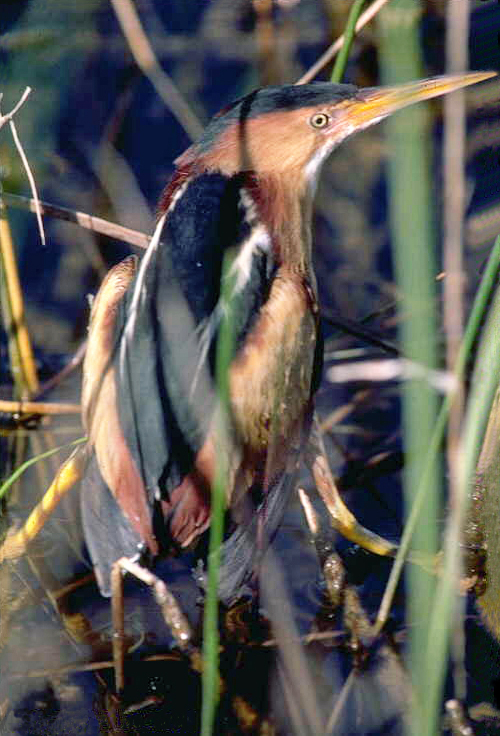
Wikipedia: Least bittern Source: OTHER
Ixobrychus_exilis.jpg
![]() The least bittern (Ixobrychus exilis) is a small heron, the smallest member of the family Ardeidae found in the Americas.
[more]
The least bittern (Ixobrychus exilis) is a small heron, the smallest member of the family Ardeidae found in the Americas.
[more]
Bare-throated tiger-heron / Nacktkehlreiher (Tigrisoma mexicanum)
Profile Wikipedia eBird Xeno-Canto

Wikipedia: Bare-throated tiger-heron Source: OTHER
1200px-Tigrisoma_mexicanum_3.jpg
![]() The bare-throated tiger heron (Tigrisoma mexicanum) is a wading bird of the heron family, Ardeidae, found from Mexico to northwestern Colombia, with one recorded sighting from the United States in Hidalgo County, Texas.[2] It is 80 cm (31 in) in length and weighs 1,200 g (42 oz).
[more]
The bare-throated tiger heron (Tigrisoma mexicanum) is a wading bird of the heron family, Ardeidae, found from Mexico to northwestern Colombia, with one recorded sighting from the United States in Hidalgo County, Texas.[2] It is 80 cm (31 in) in length and weighs 1,200 g (42 oz).
[more]
Agami heron (Agamia agami)
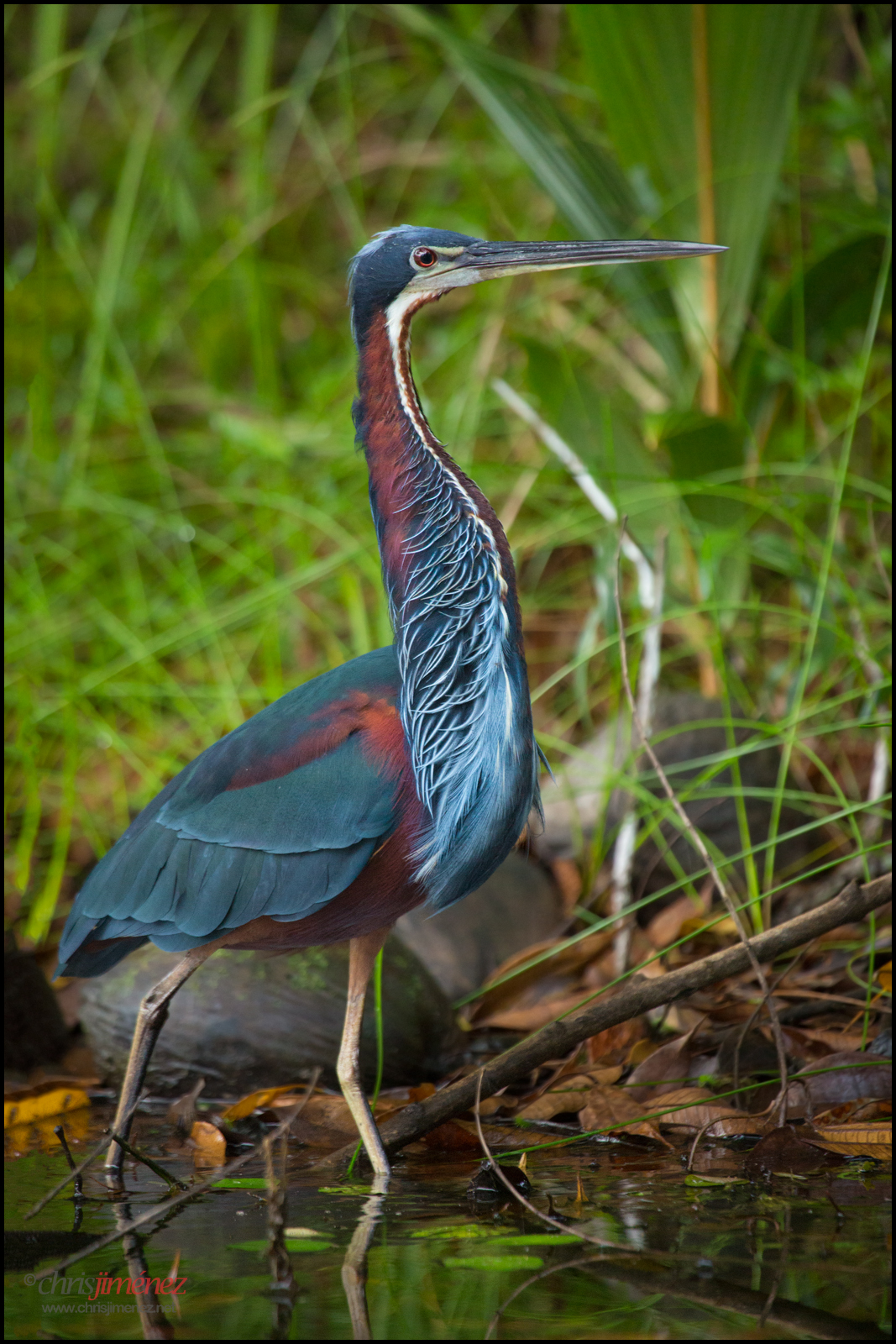
Wikipedia: Agami heron Source: OTHER
Agami_Heron_%28Agamia_agami%29.jpg
![]() The agami heron (Agamia agami) is a medium-sized heron. It is a resident breeding bird from Central America south to Peru and Brazil. It is sometimes known as the chestnut-bellied heron, and is the only member of the genus Agamia (Reichenbach, 1853). In Brazil it is sometimes called Soco beija-flor, meaning 'hummingbird heron', thanks to its unique coloration pattern.[2]
[more]
The agami heron (Agamia agami) is a medium-sized heron. It is a resident breeding bird from Central America south to Peru and Brazil. It is sometimes known as the chestnut-bellied heron, and is the only member of the genus Agamia (Reichenbach, 1853). In Brazil it is sometimes called Soco beija-flor, meaning 'hummingbird heron', thanks to its unique coloration pattern.[2]
[more]
American anhinga (Anhinga anhinga)
Wonderful patterns of an anhinga near RIo Lagartos. 2023-04-15 08.57.48 Yucatan
First observed in Yucatan on 2023-04-15.
Magnificent frigatebird / Prachtfregattvogel (Fregata magnificens)
Profile Wikipedia eBird Audubon AllAboutBirds Xeno-Canto
Magnificent frigatebirds in Puerto Morelos. 2023-03-26 13.47.02 Yucatan
First observed in Yucatan on 2023-03-26.
This bird appears across the great seas in the following continents:
North America, South America, Africa.
![]() The magnificent frigatebird (Fregata magnificens) or man o' war is a seabird of the frigatebird family Fregatidae. With a length of 89–114 centimetres (35–45 in) and wingspan of 2.17–2.44 m (7.1–8.0 ft) it is the largest species of frigatebird. It occurs over tropical and subtropical waters off America, between northern Mexico and Perú on the Pacific coast and between Florida and southern Brazil along the Atlantic coast.[1] There are also populations on the Galápagos Islands in the Pacific and the Cape Verde islands in the Atlantic.
[more]
The magnificent frigatebird (Fregata magnificens) or man o' war is a seabird of the frigatebird family Fregatidae. With a length of 89–114 centimetres (35–45 in) and wingspan of 2.17–2.44 m (7.1–8.0 ft) it is the largest species of frigatebird. It occurs over tropical and subtropical waters off America, between northern Mexico and Perú on the Pacific coast and between Florida and southern Brazil along the Atlantic coast.[1] There are also populations on the Galápagos Islands in the Pacific and the Cape Verde islands in the Atlantic.
[more]
American white pelican / Nashornpelikan (Pelecanus erythrorhynchos)

Wikipedia: American white pelican Source: OTHER
1200px-American_White_Pelican.jpg
![]() The American white pelican (Pelecanus erythrorhynchos) is a large aquatic soaring bird from the order Pelecaniformes. It breeds in interior North America, moving south and to the coasts, as far as Central America and South America, in winter.[2]
[more]
The American white pelican (Pelecanus erythrorhynchos) is a large aquatic soaring bird from the order Pelecaniformes. It breeds in interior North America, moving south and to the coasts, as far as Central America and South America, in winter.[2]
[more]
Brown pelican (Pelecanus occidentalis)
Profile Wikipedia eBird Audubon AllAboutBirds Xeno-Canto
Brown pelican, Madeira Beach, Florida. 2023-09-27 11.48.26 Florida
First observed in Panama on 2020-03-08.
![]() The brown pelican (Pelecanus occidentalis) is a bird of the pelican family, Pelecanidae, one of three species found in the Americas and one of two that feed by diving into water. It is found on the Atlantic Coast from New Jersey to the mouth of the Amazon River, and along the Pacific Coast from British Columbia to northern Chile, including the Galapagos Islands. The nominate subspecies in its breeding plumage has a white head with a yellowish wash on the crown. The nape and neck are dark maroon–brown. The upper sides of the neck have white lines along the base of the gular pouch, and the lower fore neck has a pale yellowish patch. The male and female are similar, but the female is slightly smaller. The nonbreeding adult has a white head and neck. The pink skin around the eyes becomes dull and gray in the nonbreeding season. It lacks any red hue, and the pouch is strongly olivaceous ochre-tinged and the legs are olivaceous gray to blackish-gray.
[more]
The brown pelican (Pelecanus occidentalis) is a bird of the pelican family, Pelecanidae, one of three species found in the Americas and one of two that feed by diving into water. It is found on the Atlantic Coast from New Jersey to the mouth of the Amazon River, and along the Pacific Coast from British Columbia to northern Chile, including the Galapagos Islands. The nominate subspecies in its breeding plumage has a white head with a yellowish wash on the crown. The nape and neck are dark maroon–brown. The upper sides of the neck have white lines along the base of the gular pouch, and the lower fore neck has a pale yellowish patch. The male and female are similar, but the female is slightly smaller. The nonbreeding adult has a white head and neck. The pink skin around the eyes becomes dull and gray in the nonbreeding season. It lacks any red hue, and the pouch is strongly olivaceous ochre-tinged and the legs are olivaceous gray to blackish-gray.
[more]
Red-billed tropicbird / Rotschnabel-Tropikvogel (Phaethon aethereus)
Profile Wikipedia eBird Audubon AllAboutBirds Xeno-Canto

Wikipedia: Red-billed tropicbird Source: OTHER
1200px-Red-billed_tropicbird.jpg
This bird appears across the great seas in the following continents:
North America, South America, Africa.
![]() The red-billed tropicbird (Phaethon aethereus) is a tropicbird, one of three closely related species of seabird of tropical oceans. Superficially resembling a tern in appearance, it has mostly white plumage with some black markings on the wings and back, a black mask and, as its common name suggests, a red bill. Most adults have tail streamers that are about two times their body length, with those in males being generally longer than those in females. The red-billed tropicbird itself has three subspecies recognized, including the nominate. The subspecies mesonauta is distinguished from the nominate by the rosy tinge of its fresh plumage, and the subspecies indicus can be differentiated by its smaller size, more restricted mask, and more orange bill. This species ranges across the tropical Atlantic, eastern Pacific, and Indian Oceans. The nominate is found in the southern Atlantic Ocean, the subspecies indicus in the waters off of the Middle East and in the Indian Ocean, and the subspecies mesonauta in the eastern portions of both the Atlantic and the Pacific Oceans and in the Caribbean. It was one of the many species described by Carl Linnaeus in his 1758 10th edition of Systema Naturae.
[more]
The red-billed tropicbird (Phaethon aethereus) is a tropicbird, one of three closely related species of seabird of tropical oceans. Superficially resembling a tern in appearance, it has mostly white plumage with some black markings on the wings and back, a black mask and, as its common name suggests, a red bill. Most adults have tail streamers that are about two times their body length, with those in males being generally longer than those in females. The red-billed tropicbird itself has three subspecies recognized, including the nominate. The subspecies mesonauta is distinguished from the nominate by the rosy tinge of its fresh plumage, and the subspecies indicus can be differentiated by its smaller size, more restricted mask, and more orange bill. This species ranges across the tropical Atlantic, eastern Pacific, and Indian Oceans. The nominate is found in the southern Atlantic Ocean, the subspecies indicus in the waters off of the Middle East and in the Indian Ocean, and the subspecies mesonauta in the eastern portions of both the Atlantic and the Pacific Oceans and in the Caribbean. It was one of the many species described by Carl Linnaeus in his 1758 10th edition of Systema Naturae.
[more]
Brown booby / Weißbauchtölpel (Sula leucogaster)
Profile Wikipedia eBird Audubon AllAboutBirds Xeno-Canto

Wikipedia: Brown booby Source: OTHER
1200px-Atob%C3%A1-pardo.jpg
This bird appears across the great seas in the following continents:
North America, South America, Africa, Asia.
![]() The brown booby (Sula leucogaster) is a large seabird of the booby family, Sulidae, of which it is perhaps the most common and widespread species.[3] It has a pantropical range, which overlaps with that of other booby species. The gregarious brown booby commutes and forages at low height over inshore waters. Flocks plunge-dive to take small fish, especially when these are driven near the surface by their predators. They only nest on the ground, and roost on solid objects rather than the water surface.[3]
[more]
The brown booby (Sula leucogaster) is a large seabird of the booby family, Sulidae, of which it is perhaps the most common and widespread species.[3] It has a pantropical range, which overlaps with that of other booby species. The gregarious brown booby commutes and forages at low height over inshore waters. Flocks plunge-dive to take small fish, especially when these are driven near the surface by their predators. They only nest on the ground, and roost on solid objects rather than the water surface.[3]
[more]
Red-footed booby / Rotfußtölpel (Sula sula)
Profile Wikipedia eBird Audubon AllAboutBirds Xeno-Canto
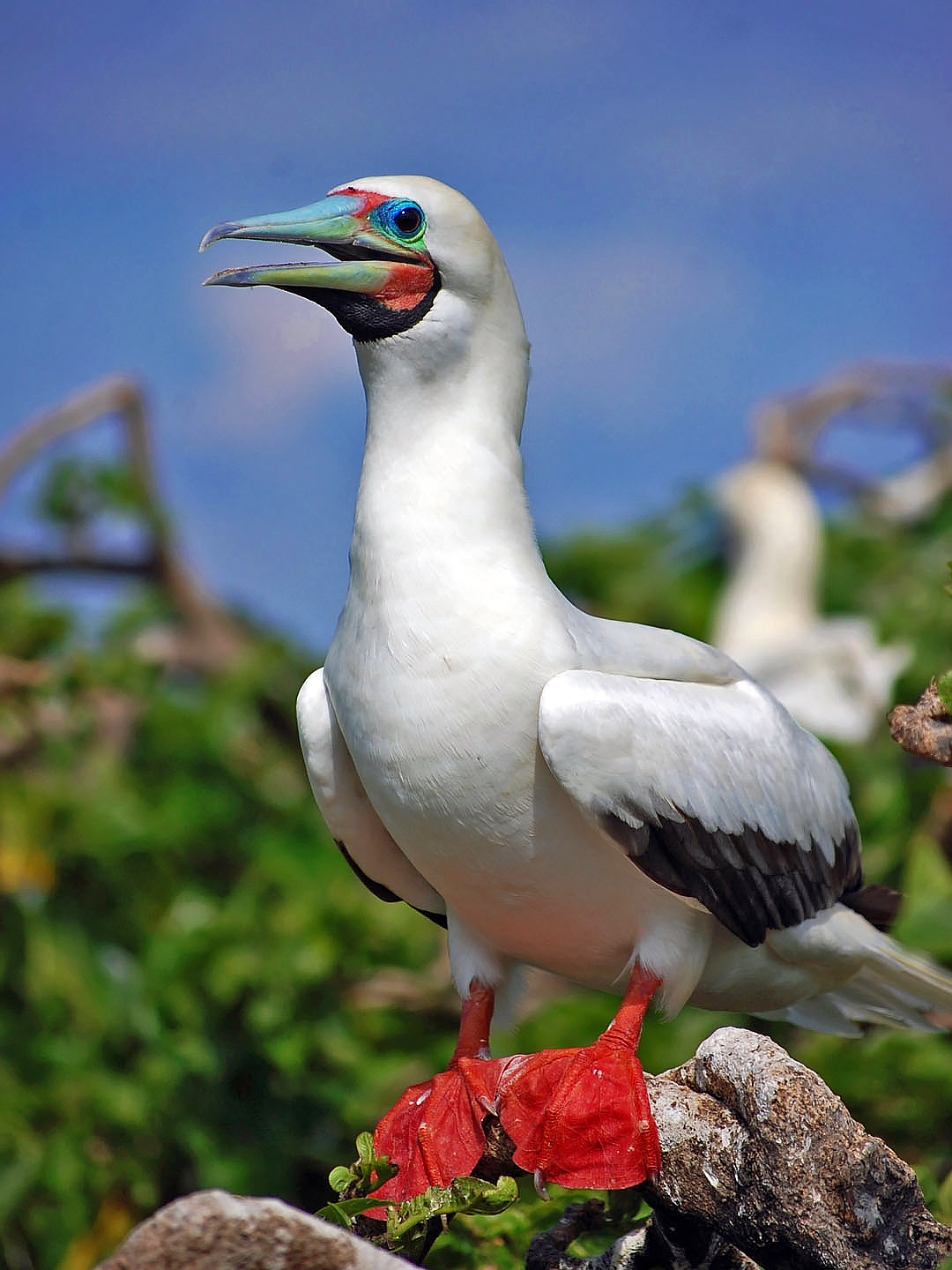
Wikipedia: Red-footed booby Source: OTHER
Sula_sula_by_Gregg_Yan_01.jpg
This bird appears across the great seas in the following continents:
North America, South America, Africa.
![]() The red-footed booby (Sula sula) is a large seabird of the booby family, Sulidae. Adults always have red feet, but the colour of the plumage varies. They are powerful and agile fliers, but they are clumsy in takeoffs and landings. They are found widely in the tropics, and breed colonially in coastal regions, especially islands. The species faces few natural or man-made threats, although its population is declining; it is considered to be a least-concern species by the International Union for Conservation of Nature (IUCN).
[more]
The red-footed booby (Sula sula) is a large seabird of the booby family, Sulidae. Adults always have red feet, but the colour of the plumage varies. They are powerful and agile fliers, but they are clumsy in takeoffs and landings. They are found widely in the tropics, and breed colonially in coastal regions, especially islands. The species faces few natural or man-made threats, although its population is declining; it is considered to be a least-concern species by the International Union for Conservation of Nature (IUCN).
[more]
Masked booby (Sula dactylatra)

Wikipedia: Masked booby Source: OTHER
1200px-Starr_080606-6808_Coronopus_didymus.jpg
This bird appears across the great seas in the following continents:
North America, South America, Africa, Asia.
![]() The masked booby (Sula dactylatra), also called the masked gannet or the blue-faced booby, is a large seabird of the booby and gannet family, Sulidae. First described by the French naturalist René-Primevère Lesson in 1831, the masked booby is one of six species of booby in the genus Sula. It has a typical sulid body shape, with a long pointed yellowish bill, long neck, aerodynamic body, long slender wings and pointed tail. The adult is bright white with black wings, a black tail and a dark face mask; at 75–85 cm (30–33 in) long, it is the largest species of booby. The sexes have similar plumage. This species ranges across tropical oceans, except in the eastern Atlantic and eastern Pacific. In the latter, it is replaced by the Nazca booby (Sula granti), which was formerly regarded as a subspecies of masked booby.
[more]
The masked booby (Sula dactylatra), also called the masked gannet or the blue-faced booby, is a large seabird of the booby and gannet family, Sulidae. First described by the French naturalist René-Primevère Lesson in 1831, the masked booby is one of six species of booby in the genus Sula. It has a typical sulid body shape, with a long pointed yellowish bill, long neck, aerodynamic body, long slender wings and pointed tail. The adult is bright white with black wings, a black tail and a dark face mask; at 75–85 cm (30–33 in) long, it is the largest species of booby. The sexes have similar plumage. This species ranges across tropical oceans, except in the eastern Atlantic and eastern Pacific. In the latter, it is replaced by the Nazca booby (Sula granti), which was formerly regarded as a subspecies of masked booby.
[more]
Roseate spoonbill / Rosalöffler (Platalea ajaja)
Roseate spoonbills near Rio Lagartos. 2023-04-15 08.56.42 Yucatan
First observed in Yucatan on 2023-04-15.
![]() The roseate spoonbill (Platalea ajaja) is a gregarious wading bird of the ibis and spoonbill family, Threskiornithidae. It is a resident breeder in South America mostly east of the Andes, and in coastal regions of the Caribbean, Central America, Mexico, the Gulf Coast of the United States,[2][3] and from central Florida's Atlantic coast[4] at Merritt Island National Wildlife Refuge, adjoined with NASA Kennedy Space Center at least as far north as South Carolina's Myrtle Beach.[5]
[more]
The roseate spoonbill (Platalea ajaja) is a gregarious wading bird of the ibis and spoonbill family, Threskiornithidae. It is a resident breeder in South America mostly east of the Andes, and in coastal regions of the Caribbean, Central America, Mexico, the Gulf Coast of the United States,[2][3] and from central Florida's Atlantic coast[4] at Merritt Island National Wildlife Refuge, adjoined with NASA Kennedy Space Center at least as far north as South Carolina's Myrtle Beach.[5]
[more]
White ibis (Eudocimus albus)
Profile Wikipedia eBird Audubon AllAboutBirds Xeno-Canto
White ibises in flight, St Petersburg. 2023-09-23 19.16.50 Florida
First observed in Florida on 2023-09-23.
Profile Wikipedia eBird A-Z Animals Vogelwarte BirdLife ZH ornitho.ch bird-song.ch Audubon AllAboutBirds Xeno-Canto BirdID NABU
Barn swallow. 2022-05-05 09.41.44 Maryland
First observed in 🇨🇭 on 2020-04-16.
This bird appears across the great seas in the following continents:
Europe, North America, South America, Africa, Asia.
Die langen Schwanzfedern vom Rauchschwalbe und anderen geben auch dem Schmetterling Schwalbenschwanz seine deutschen Namen.
Etymology: ![]() In früheren Jahrhunderten flogen sie vielfach durch die Öffnungen im Giebel ein und aus, durch die auch der Rauch des Herdfeuers abzog. So erhielten sie den Namen Rauchschwalben. [Link]
In früheren Jahrhunderten flogen sie vielfach durch die Öffnungen im Giebel ein und aus, durch die auch der Rauch des Herdfeuers abzog. So erhielten sie den Namen Rauchschwalben. [Link]
Appearance and identification: ![]() Rauchschwalbes Bauch ist etwas braun rot, nicht weiss wie der von der Mehlschwalbe - was wahrscheinlich Quelle der zwei Namen ist. [Link]
Rauchschwalbes Bauch ist etwas braun rot, nicht weiss wie der von der Mehlschwalbe - was wahrscheinlich Quelle der zwei Namen ist. [Link]
Song: ![]() Characteristic calls and song. Song a sparkling, squeaky energetic improvisation with interspersed contact calls, often with diagnostic ending; an electric and drawn-out "su-eerrrrrrrrrrrrrrr". [Link]
Characteristic calls and song. Song a sparkling, squeaky energetic improvisation with interspersed contact calls, often with diagnostic ending; an electric and drawn-out "su-eerrrrrrrrrrrrrrr". [Link]
Calls: ![]() Contact call a short and sharp "weet" or "kee-weet". [Link]
Contact call a short and sharp "weet" or "kee-weet". [Link]
Physical details: length=17-19 cm,
wingspan=32-34 cm,
weight=16-22 g
Habitats:
Settlement
Looks similar to:
Common house martin.
Song:
General: Squeaky with occasional buzzes, usually heard in flock.
Song: ![]() Kann melodisch sein wenn einzeln gehört statt viele zusammen. [Link]
Kann melodisch sein wenn einzeln gehört statt viele zusammen. [Link]
Song attributes:
Melody: stereotype melodic, fast, Frequency: 2-6 KHz
Call:
Automatically generated from Xeno-Canto recording
♫ Barn swallows on the hunt, some quite high. 2020-08-18 13.01.00 Luppmen (song?)
Tree swallow at Cromwell. 2022-04-29 12.44.58 Maryland
First observed in Maryland on 2021-06-14.
General: ![]() The tree swallow (Tachycineta bicolor) is a migratory bird of the family Hirundinidae. Found in the Americas, the tree swallow was first described in 1807 by French ornithologist Louis Vieillot as Hirundo bicolor. It has since been moved to its current genus, Tachycineta, within which its phylogenetic placement is debated. The tree swallow has glossy blue-green upperparts, with the exception of the blackish wings and tail, and white underparts. The bill is black, the eyes dark brown, and the legs and feet pale brown. The female is generally duller than the male, and the first-year female has mostly brown upperparts, with some blue feathers. Juveniles have brown upperparts, and a grey-brown-washed breast. The tree swallow breeds in the US and Canada. It winters along southern US coasts south, along the Gulf Coast, to Panama and the northwestern coast of South America, and in the West Indies.
[more]
The tree swallow (Tachycineta bicolor) is a migratory bird of the family Hirundinidae. Found in the Americas, the tree swallow was first described in 1807 by French ornithologist Louis Vieillot as Hirundo bicolor. It has since been moved to its current genus, Tachycineta, within which its phylogenetic placement is debated. The tree swallow has glossy blue-green upperparts, with the exception of the blackish wings and tail, and white underparts. The bill is black, the eyes dark brown, and the legs and feet pale brown. The female is generally duller than the male, and the first-year female has mostly brown upperparts, with some blue feathers. Juveniles have brown upperparts, and a grey-brown-washed breast. The tree swallow breeds in the US and Canada. It winters along southern US coasts south, along the Gulf Coast, to Panama and the northwestern coast of South America, and in the West Indies.
[more]
Profile Wikipedia eBird Xeno-Canto
MerlinBirdID says Mangrove swallow Bacalar. 2023-03-30 16.55.16 Yucatan
First observed in Yucatan on 2023-03-30.
![]() The mangrove swallow (Tachycineta albilinea) is a passerine bird in the swallow family that breeds in coastal regions from Mexico through Central America to Panama. It has blue-green upperparts, blackish flight feathers, a white rump, a black tail, and white underparts. It can be identified by the supraloral white streak, the white line near its eye, which only occurs in two other species of Tachycineta: the violet-green swallow and the white-rumped swallow. The sexes, although similar in plumage, differ slightly in size. The juveniles have grey-brown upperparts and white-washed underparts. This swallow's song is generally described as a soft trilling, with a rolled jeerrt call, and a sharp alarm note.
[more]
The mangrove swallow (Tachycineta albilinea) is a passerine bird in the swallow family that breeds in coastal regions from Mexico through Central America to Panama. It has blue-green upperparts, blackish flight feathers, a white rump, a black tail, and white underparts. It can be identified by the supraloral white streak, the white line near its eye, which only occurs in two other species of Tachycineta: the violet-green swallow and the white-rumped swallow. The sexes, although similar in plumage, differ slightly in size. The juveniles have grey-brown upperparts and white-washed underparts. This swallow's song is generally described as a soft trilling, with a rolled jeerrt call, and a sharp alarm note.
[more]
Profile Wikipedia eBird Audubon AllAboutBirds Xeno-Canto
Could be a wild guess - MerlinBirdID says purple martin - it says identification features are (in part) best left unidentified. 2023-04-01 14.20.30 Yucatan
First observed in Yucatan on 2023-04-01.
![]() The purple martin (Progne subis) is the largest swallow in North America. Despite their name, purple martins are not truly purple. Their dark blackish-blue feathers have an iridescent sheen caused by the refraction of incident light[2] giving them a bright blue to navy blue or deep purple appearance. In some light they may even appear green in color.
[more]
The purple martin (Progne subis) is the largest swallow in North America. Despite their name, purple martins are not truly purple. Their dark blackish-blue feathers have an iridescent sheen caused by the refraction of incident light[2] giving them a bright blue to navy blue or deep purple appearance. In some light they may even appear green in color.
[more]
Profile Wikipedia eBird Xeno-Canto
MerlinBirdID says gray-breasted martin, Ecotucan. 2023-04-01 08.59.26 Yucatan
First observed in Yucatan on 2023-03-31.
![]() The grey-breasted martin (Progne chalybea) is a large swallow from Central and South America.
[more]
The grey-breasted martin (Progne chalybea) is a large swallow from Central and South America.
[more]
Profile Wikipedia eBird Audubon AllAboutBirds Xeno-Canto
Northern rough-winged swallow. 2022-05-01 09.39.08 Maryland
First observed in Maryland on 2022-05-01.
![]() The northern rough-winged swallow (Stelgidopteryx serripennis) is a small, migratory swallow. It is very similar to the southern rough-winged swallow, Stelgidopteryx ruficollis.
[more]
The northern rough-winged swallow (Stelgidopteryx serripennis) is a small, migratory swallow. It is very similar to the southern rough-winged swallow, Stelgidopteryx ruficollis.
[more]
Bank swallow. 2024-01-26 15.58.58 Thailand
First observed in Thailand on 2024-01-26.
This bird appears across the great seas in the following continents:
Europe, North America, South America, Africa, Asia.
![]() The sand martin (Riparia riparia) or European sand martin, bank swallow, and collared sand martin in India, is a migratory passerine bird in the swallow family. It has a wide range in summer, embracing practically the whole of Europe and the Mediterranean countries and across the Palearctic to the Pacific Ocean. It is a Holarctic species also found in North America. It winters in eastern and southern Africa, South America, and the Indian Subcontinent.
[more]
The sand martin (Riparia riparia) or European sand martin, bank swallow, and collared sand martin in India, is a migratory passerine bird in the swallow family. It has a wide range in summer, embracing practically the whole of Europe and the Mediterranean countries and across the Palearctic to the Pacific Ocean. It is a Holarctic species also found in North America. It winters in eastern and southern Africa, South America, and the Indian Subcontinent.
[more]
Song: ![]() Song a primitive improvisation on the contact call. [Link]
Song a primitive improvisation on the contact call. [Link]
Calls: ![]() Contact call a mono- or disyllabic "trrrrt". Similar to House Martin but more raucous and less crisp, with less rolling r's, and with stable pitch throughout. Alarm call similar to House Martin; a sharp plaintive "tseep", but somewhat purer and more drawn. [Link]
Contact call a mono- or disyllabic "trrrrt". Similar to House Martin but more raucous and less crisp, with less rolling r's, and with stable pitch throughout. Alarm call similar to House Martin; a sharp plaintive "tseep", but somewhat purer and more drawn. [Link]
Physical details: length=12 cm,
wingspan=26-29 cm,
weight=11-16 g
Habitats:
Wetland
Song:
Fast raspy one-noter.
Song attributes:
Melody: non-musical, fast, Frequency: 1-7 KHz Special sounds: rasp
♫ Source: XENOCANTO
XC344092 - Sand Martin - Riparia riparia - raspy song but note, does not sing often.mp3
(song)


Wikipedia: Cliff swallow Source: OTHER
Petrochelidon_pyrrhonota_-flight_-Palo_Alto_Baylands-8.jpg
This bird appears across the great seas in the following continents:
Europe, North America, South America.
General: ![]() The cliff swallow or American cliff swallow (Petrochelidon pyrrhonota) is a member of the passerine bird family Hirundinidae, the swallows and martins.[2] The scientific name is derived from Ancient Greek; Petrochelidon originates from the petros meaning "rock" and khelidon "swallow", pyrrhonota comes from purrhos meaning "flame-coloured" and -notos "-backed".[3]
[more]
The cliff swallow or American cliff swallow (Petrochelidon pyrrhonota) is a member of the passerine bird family Hirundinidae, the swallows and martins.[2] The scientific name is derived from Ancient Greek; Petrochelidon originates from the petros meaning "rock" and khelidon "swallow", pyrrhonota comes from purrhos meaning "flame-coloured" and -notos "-backed".[3]
[more]
Profile Wikipedia eBird Audubon AllAboutBirds Xeno-Canto
Cave swallows at Izamal, from the name an unlikely city dweller but others also identify them as such. 2023-04-11 18.23.06 Yucatan
First observed in Yucatan on 2023-04-11.
![]() The cave swallow (Petrochelidon fulva) is a medium-sized, squarish tailed swallow belonging to the same genus as the more familiar and widespread cliff swallow of North America. The cave swallow, also native to the Americas, nests and roosts primarily in caves and sinkholes.
[more]
The cave swallow (Petrochelidon fulva) is a medium-sized, squarish tailed swallow belonging to the same genus as the more familiar and widespread cliff swallow of North America. The cave swallow, also native to the Americas, nests and roosts primarily in caves and sinkholes.
[more]
Profile Wikipedia eBird Vogelwarte BirdLife ZH ornitho.ch bird-song.ch Audubon AllAboutBirds Xeno-Canto BirdID NABU
Pair of house sparrows in a tree near Zürichstrasse, Fehraltorf 2020-04-11 07.54.30 Luppmen
First observed in 🇨🇭 on 2019-05-14.
This bird appears across the great seas in the following continents:
Europe, North America (introduced), South America, Africa, Asia.
One of the most common birds anywhere in Europe and North America.
In Fehraltorf there are 5 house sparrows for every one tree sparrow.
Eugene Schieffelin brought house sparrows and starlings to North Ameria.
As a Shakespeare fan, it is often claimed that he wanted to introduce all species to North America that are mentioned in Shakespeare,
but apparently this is not supported by any records
Found practically everywhere. Often on the ground or on your table in a cafe (they're very bold)
or in groups in bushes and hedges
Song: ![]() Song a primitive, monosyllabic, or slightly disyllabic "chilp", hard to distinguish from Tree Sparrow. [Link]
Song a primitive, monosyllabic, or slightly disyllabic "chilp", hard to distinguish from Tree Sparrow. [Link]
Calls: ![]() Most calls very similar to Tree Sparrow, but lacks said species' distinct high pitched call (chew-itt), and alarm call is less dry and raucous. [Link]
Most calls very similar to Tree Sparrow, but lacks said species' distinct high pitched call (chew-itt), and alarm call is less dry and raucous. [Link]
Physical details: length=14-15 cm,
wingspan=21-25 cm,
weight=24-38 g
not sexually dimporphic.
No breeding plumage
Identifying characteristics:
Youth:
beak = yellow (Makes it look like a finch)
Habitats:
Settlement
Song:
An monotone chirping. Mainly 2-5 KHz with higher overtones.
Song attributes:
Melody: simple rhythmic, slow, Frequency: 2-5 KHz Singing season: 01-01 - 08-31 Dawn chorus start, 30 minutes before dawn.
Call:
Automatically generated from Xeno-Canto recording
♫ Source: BirdNet
20200507_071255 birdnet 457 - good one note recording - House sparrow.mp3
2020-05-07 07.12.55 Luppmen (song?)

Wikipedia: Lesser goldfinch Source: OTHER
1200px-%E2%99%82_lesser_goldfinch.jpg
General: ![]() The lesser goldfinch (Spinus psaltria) is a very small songbird of the Americas. Together with its relatives the American goldfinch and Lawrence's goldfinch, it forms the American goldfinches clade in the genus Spinus sensu stricto.
[more]
The lesser goldfinch (Spinus psaltria) is a very small songbird of the Americas. Together with its relatives the American goldfinch and Lawrence's goldfinch, it forms the American goldfinches clade in the genus Spinus sensu stricto.
[more]
Profile Wikipedia eBird Xeno-Canto
Red-legged honeycreeper. 2020-02-21 07.42.10 Panama
First observed in Panama on 2020-02-21.
We saw this on the grounds of Gamboa Rainforest Resort, a hotel at the old U.S. administrative center for the Panama Canal. You can spend hours watching birds and wildlife just around the hotel.
General: ![]() The red-legged honeycreeper (Cyanerpes cyaneus) is a small songbird species in the tanager family (Thraupidae). It is found in the tropical New World from southern Mexico south to Peru, Bolivia and central Brazil, Trinidad and Tobago, and on Cuba, where possibly introduced. It is also rarely found in southern Texas.[2]
[more]
The red-legged honeycreeper (Cyanerpes cyaneus) is a small songbird species in the tanager family (Thraupidae). It is found in the tropical New World from southern Mexico south to Peru, Bolivia and central Brazil, Trinidad and Tobago, and on Cuba, where possibly introduced. It is also rarely found in southern Texas.[2]
[more]
Profile Wikipedia eBird A-Z Animals Audubon AllAboutBirds Xeno-Canto
Northern Cardinal, female. 2022-05-01 09.02.04 Maryland
First observed in Cockeysville on 2021-06-10.
![]() The northern cardinal (Cardinalis cardinalis) is a bird in the genus Cardinalis; it is also known colloquially as the redbird, common cardinal, red cardinal, or just cardinal (which was its name prior to 1985). It can be found in southeastern Canada, through the eastern United States from Maine to Minnesota to Texas, and south through Mexico, Belize, and Guatemala. It is also an introduced species in a few locations such as Bermuda and Hawaii. Its habitat includes woodlands, gardens, shrublands, and wetlands.
[more]
The northern cardinal (Cardinalis cardinalis) is a bird in the genus Cardinalis; it is also known colloquially as the redbird, common cardinal, red cardinal, or just cardinal (which was its name prior to 1985). It can be found in southeastern Canada, through the eastern United States from Maine to Minnesota to Texas, and south through Mexico, Belize, and Guatemala. It is also an introduced species in a few locations such as Bermuda and Hawaii. Its habitat includes woodlands, gardens, shrublands, and wetlands.
[more]
Song:
Automatically generated from Xeno-Canto recording
Song attributes:
Frequency:
♫ Morning at Cherrywood Court - northern cardinal, gray catbirds, song sparrow. 2021-06-19 07.38.01 Cherrywood (song)
Call:
Automatically generated from Xeno-Canto recording
♫ Source: BirdNet
20220503_104300 birdnet - Northern Cardinal - 2022-05-03 10:43:00 - Northern Cardinal - Cockeysville.mp3
2022-05-03 10.43.00 Cockeysville (song?)
Profile Wikipedia eBird Audubon AllAboutBirds Xeno-Canto
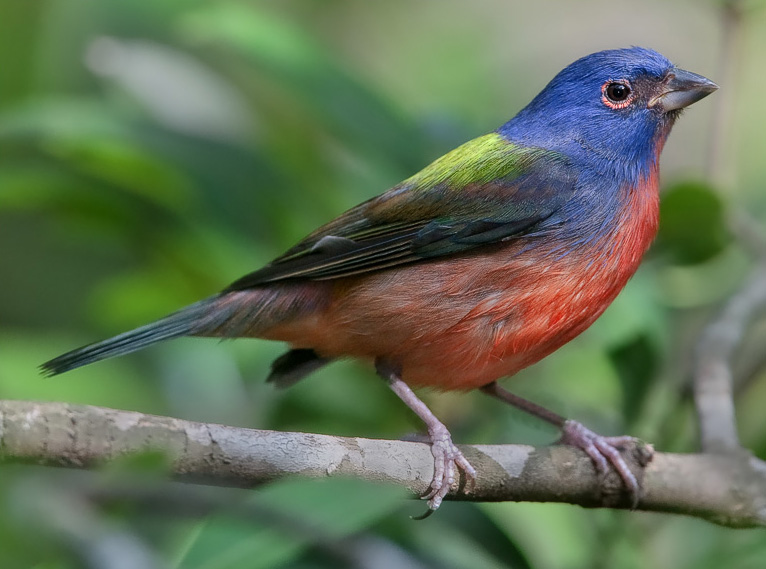
Wikipedia: Painted bunting Source: OTHER
Passerina_ciris-20090208.jpg
![]() The painted bunting (Passerina ciris) is a species of bird in the cardinal family, Cardinalidae, that is native to North America. The bright plumage of the male only comes in the second year of life; in the first year they can only be distinguished from the female by close inspection.
[more]
The painted bunting (Passerina ciris) is a species of bird in the cardinal family, Cardinalidae, that is native to North America. The bright plumage of the male only comes in the second year of life; in the first year they can only be distinguished from the female by close inspection.
[more]
Profile Wikipedia eBird Audubon AllAboutBirds Xeno-Canto
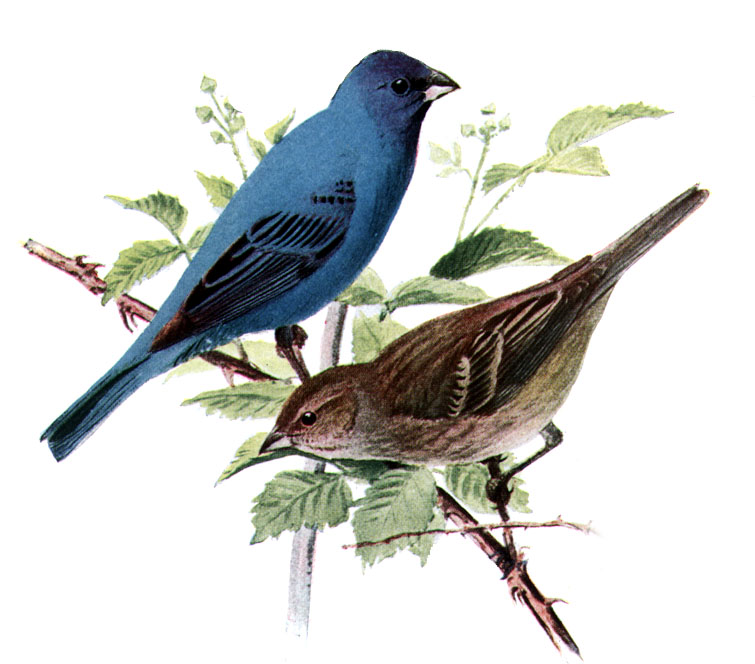
Wikipedia: Indigo bunting Source: OTHER
Passerina_cyaneaAAP086CA.jpg
![]() The indigo bunting (Passerina cyanea) is a small seed-eating bird in the cardinal family, Cardinalidae. It is migratory, ranging from southern Canada to northern Florida during the breeding season, and from southern Florida to northern South America during the winter.[2] It often migrates by night, using the stars to navigate.[3] Its habitat is farmland, brush areas, and open woodland.[4] The indigo bunting is closely related to the lazuli bunting and interbreeds with the species where their ranges overlap.
[more]
The indigo bunting (Passerina cyanea) is a small seed-eating bird in the cardinal family, Cardinalidae. It is migratory, ranging from southern Canada to northern Florida during the breeding season, and from southern Florida to northern South America during the winter.[2] It often migrates by night, using the stars to navigate.[3] Its habitat is farmland, brush areas, and open woodland.[4] The indigo bunting is closely related to the lazuli bunting and interbreeds with the species where their ranges overlap.
[more]

Wikipedia: Blue grosbeak Source: OTHER
1200px-Blue_Grosbeak_by_Dan_Pancamo.jpg
![]() The blue grosbeak (Passerina caerulea), is a medium-sized North American passerine bird in the cardinal family Cardinalidae. It is mainly migratory, wintering in Central America and breeding in northern Mexico and the southern United States. The male is blue with two brown wing bars. The female is mainly brown with scattered blue feathers on the upperparts and two brown wing bars.
[more]
The blue grosbeak (Passerina caerulea), is a medium-sized North American passerine bird in the cardinal family Cardinalidae. It is mainly migratory, wintering in Central America and breeding in northern Mexico and the southern United States. The male is blue with two brown wing bars. The female is mainly brown with scattered blue feathers on the upperparts and two brown wing bars.
[more]
Profile Wikipedia eBird Xeno-Canto

Wikipedia: Orange-breasted bunting Source: OTHER
1200px-Orange_Breasted_Butnin.jpg
Endemic (country/region)
Profile Wikipedia eBird Audubon AllAboutBirds Xeno-Canto
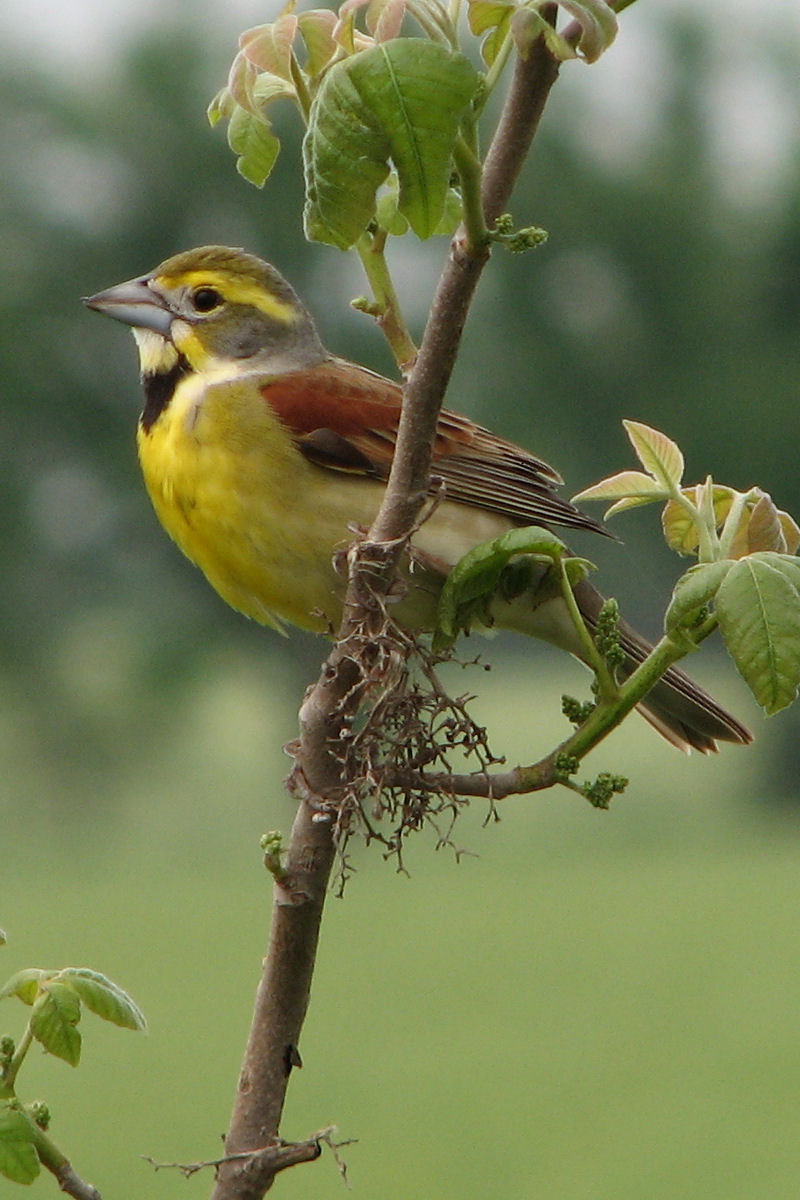
Wikipedia: Dickcissel Source: OTHER
DickcisselA.jpg
General: ![]() Emberiza townsendi
Emberiza townsendi
Emberiza townsendii (lapsus)
Spiza townsendi
Spiza townsendii (lapsus)
(see text)
[more]
Profile Wikipedia eBird A-Z Animals Audubon AllAboutBirds Xeno-Canto
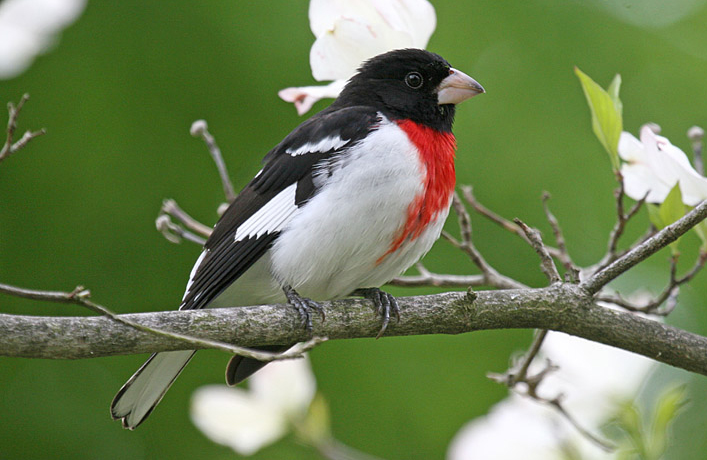
Wikipedia: Rose-breasted grosbeak Source: OTHER
RosebreastedGrosbeak08.jpg
![]() The rose-breasted grosbeak (Pheucticus ludovicianus) is a large, seed-eating grosbeak in the cardinal family (Cardinalidae). It is primarily a foliage gleaner.[2] Males have black heads, wings, backs, and tails, and a bright rose colored patch on their white breast. Males and females exhibit marked sexual dimorphism.
[more]
The rose-breasted grosbeak (Pheucticus ludovicianus) is a large, seed-eating grosbeak in the cardinal family (Cardinalidae). It is primarily a foliage gleaner.[2] Males have black heads, wings, backs, and tails, and a bright rose colored patch on their white breast. Males and females exhibit marked sexual dimorphism.
[more]
Profile Wikipedia eBird Xeno-Canto
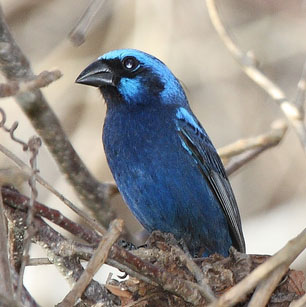
Wikipedia: Blue bunting Source: OTHER
Blue_Bunting%2C_male.jpg
Profile Wikipedia eBird Xeno-Canto

Wikipedia: Black-faced grosbeak Source: OTHER
1200px-Caryothraustes_poliogaster.jpg
General: ![]() The black-faced grosbeak (Caryothraustes poliogaster) is a large seed-eating bird in the cardinal family (Cardinalidae), which is a resident breeding species from south-eastern Mexico to eastern Panama.
[more]
The black-faced grosbeak (Caryothraustes poliogaster) is a large seed-eating bird in the cardinal family (Cardinalidae), which is a resident breeding species from south-eastern Mexico to eastern Panama.
[more]

Wikipedia: Blue-black grosbeak Source: OTHER
1200px-Cyanocompsa_cyanoides.jpg
![]() The blue-black grosbeak (Cyanoloxia cyanoides) is a species of songbird in the family Cardinalidae.
[more]
The blue-black grosbeak (Cyanoloxia cyanoides) is a species of songbird in the family Cardinalidae.
[more]
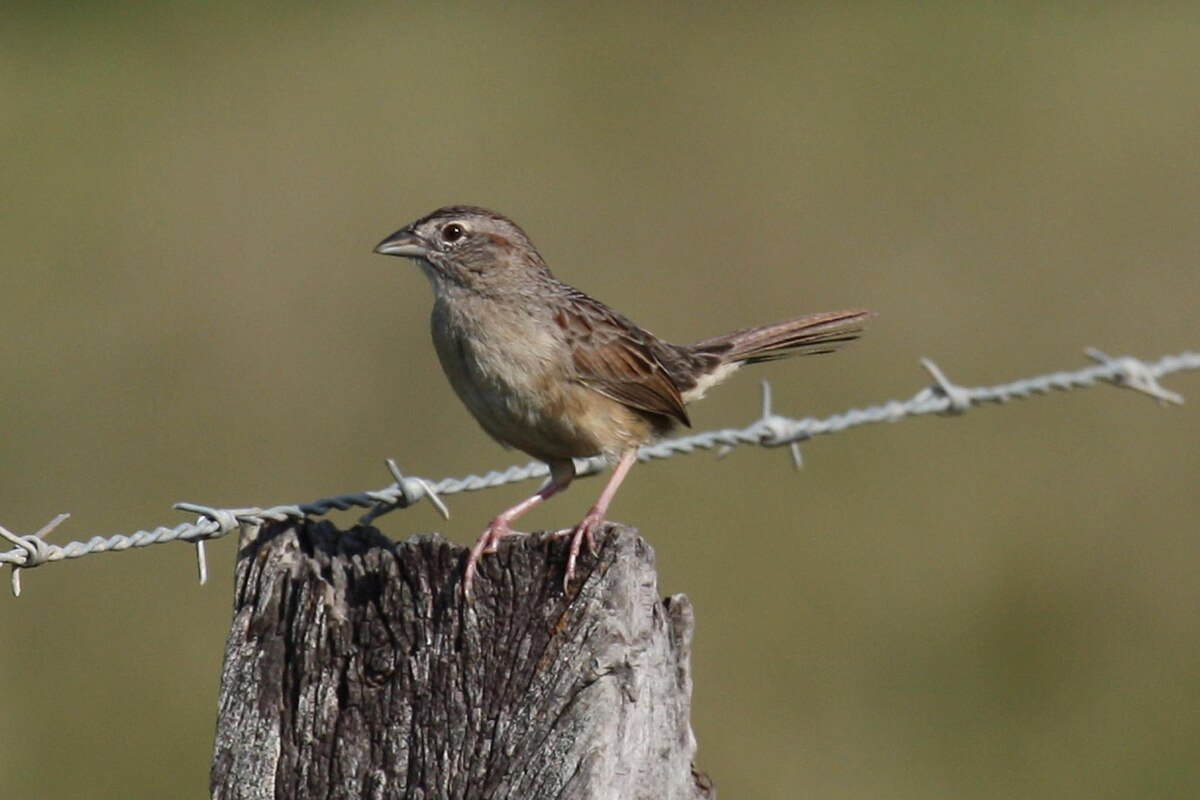
Wikipedia: Botteri's sparrow Source: OTHER
1200px-Aimophila_botterii.jpg
![]() Botteri's sparrow (Peucaea botterii) is a medium-sized sparrow.
[more]
Botteri's sparrow (Peucaea botterii) is a medium-sized sparrow.
[more]
Profile Wikipedia eBird Xeno-Canto
MerlinBirdID says yellow-throated euphonia, Ecotucan. 2023-04-01 07.58.10 Yucatan
First observed in Yucatan on 2023-04-01.
![]() The yellow-throated euphonia (Euphonia hirundinacea) is a species of songbird in the family Fringillidae. It is found in southeastern Mexico and throughout Central America with its range stretching from Belize south to western Panama. It inhabits primarily both humid and dry regions where it prefers the forest edge, open woodland, and shaded plantations. It has two subspecies, the nominate subspecies Euphonia hirundinacea hirundinacea and Euphonia hirundinacea gnatho. This finch is a small bird with pointed wings and a short bill and short tail. Males of this species have dark glossy blue-black upperparts excluding a yellow forecrown, and bright yellow underparts, while females have olive green upperparts and whitish-gray breast and lower parts. It has a shrill song that alternates between high-pitched and moderately pitched and appears to be able to mimic some calls of other birds.
[more]
The yellow-throated euphonia (Euphonia hirundinacea) is a species of songbird in the family Fringillidae. It is found in southeastern Mexico and throughout Central America with its range stretching from Belize south to western Panama. It inhabits primarily both humid and dry regions where it prefers the forest edge, open woodland, and shaded plantations. It has two subspecies, the nominate subspecies Euphonia hirundinacea hirundinacea and Euphonia hirundinacea gnatho. This finch is a small bird with pointed wings and a short bill and short tail. Males of this species have dark glossy blue-black upperparts excluding a yellow forecrown, and bright yellow underparts, while females have olive green upperparts and whitish-gray breast and lower parts. It has a shrill song that alternates between high-pitched and moderately pitched and appears to be able to mimic some calls of other birds.
[more]
Profile Wikipedia eBird Xeno-Canto

Wikipedia: Olive-backed euphonia Source: OTHER
Flickr_-_Rainbirder_-_Olive-backed_Euphonia_%28Euphonia_gouldi%29_male.jpg
![]() The olive-backed euphonia (Euphonia gouldi) is a small passerine bird in the finch family. It is a resident breeder in the Caribbean lowlands and foothills from southern Mexico to western Panama.
[more]
The olive-backed euphonia (Euphonia gouldi) is a small passerine bird in the finch family. It is a resident breeder in the Caribbean lowlands and foothills from southern Mexico to western Panama.
[more]
Profile Wikipedia eBird Xeno-Canto

Wikipedia: Scrub euphonia Source: OTHER
1200px-Euphonia_affinis_godmani.jpg
![]() The scrub euphonia (Euphonia affinis) is a species of bird in the family Fringillidae.
[more]
The scrub euphonia (Euphonia affinis) is a species of bird in the family Fringillidae.
[more]
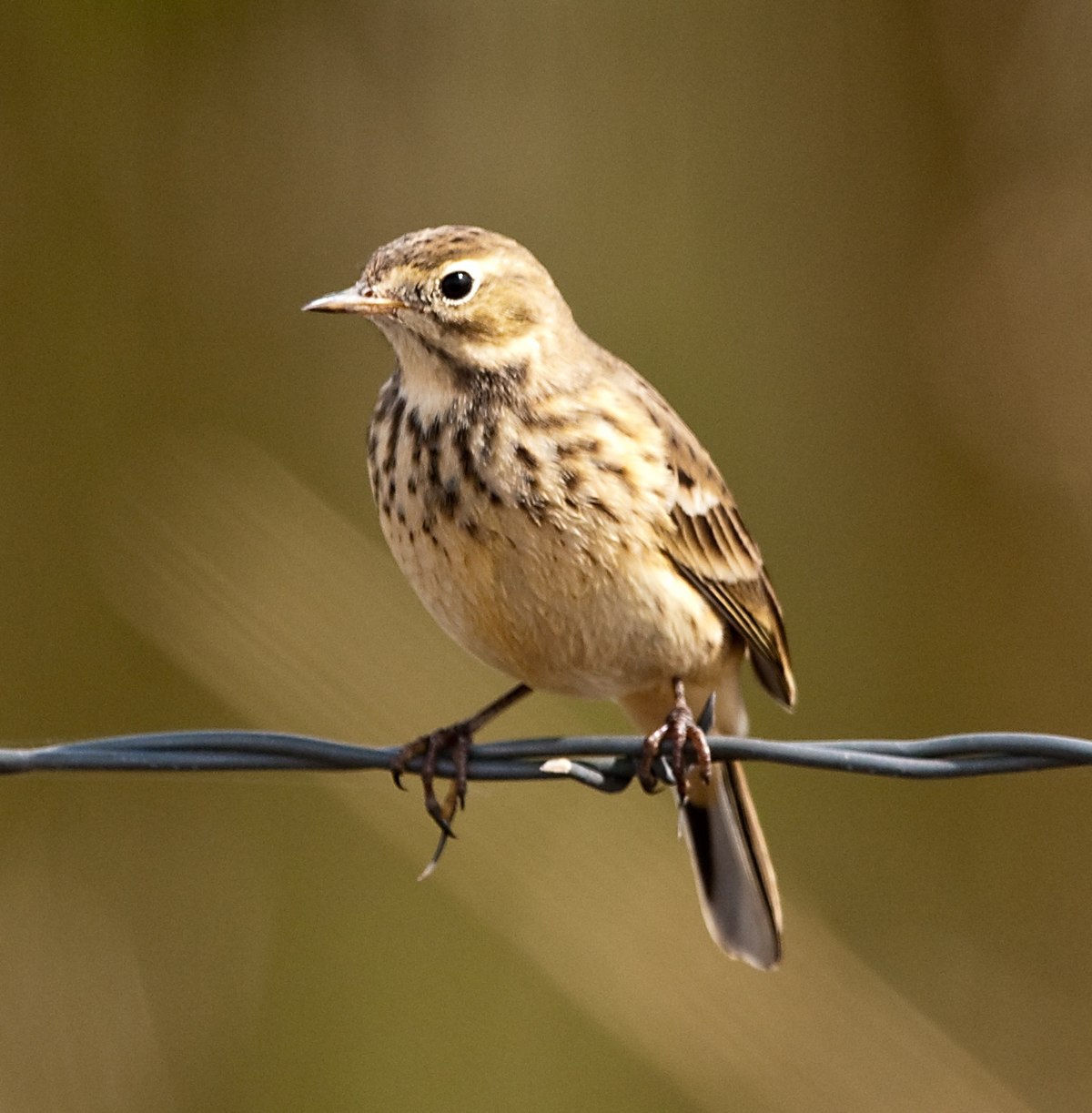
Wikipedia: American pipit Source: OTHER
1200px-Anthus_rubescens_-Harney_County%2C_Oregon%2C_USA-8.jpg
![]() The buff-bellied pipit or American pipit (Anthus rubescens) is a small songbird found on both sides of the northern Pacific. It was first described by Marmaduke Tunstall in his 1771 Ornithologia Britannica.[2] It was formerly classified as a form of the water pipit. It is known as "American pipit" in North America and "buff-bellied pipit" in Eurasia.
[more]
The buff-bellied pipit or American pipit (Anthus rubescens) is a small songbird found on both sides of the northern Pacific. It was first described by Marmaduke Tunstall in his 1771 Ornithologia Britannica.[2] It was formerly classified as a form of the water pipit. It is known as "American pipit" in North America and "buff-bellied pipit" in Eurasia.
[more]
Profile Wikipedia eBird Audubon AllAboutBirds Xeno-Canto NABU
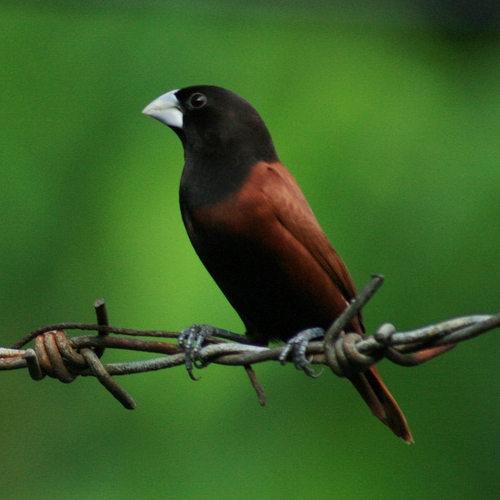
Wikipedia: Chestnut munia Source: OTHER
Lonchura_atricapilla_jagori_-Cebu-8-3c.jpg
This bird appears across the great seas in the following continents:
Europe, North America, Asia, Australia.
introduced
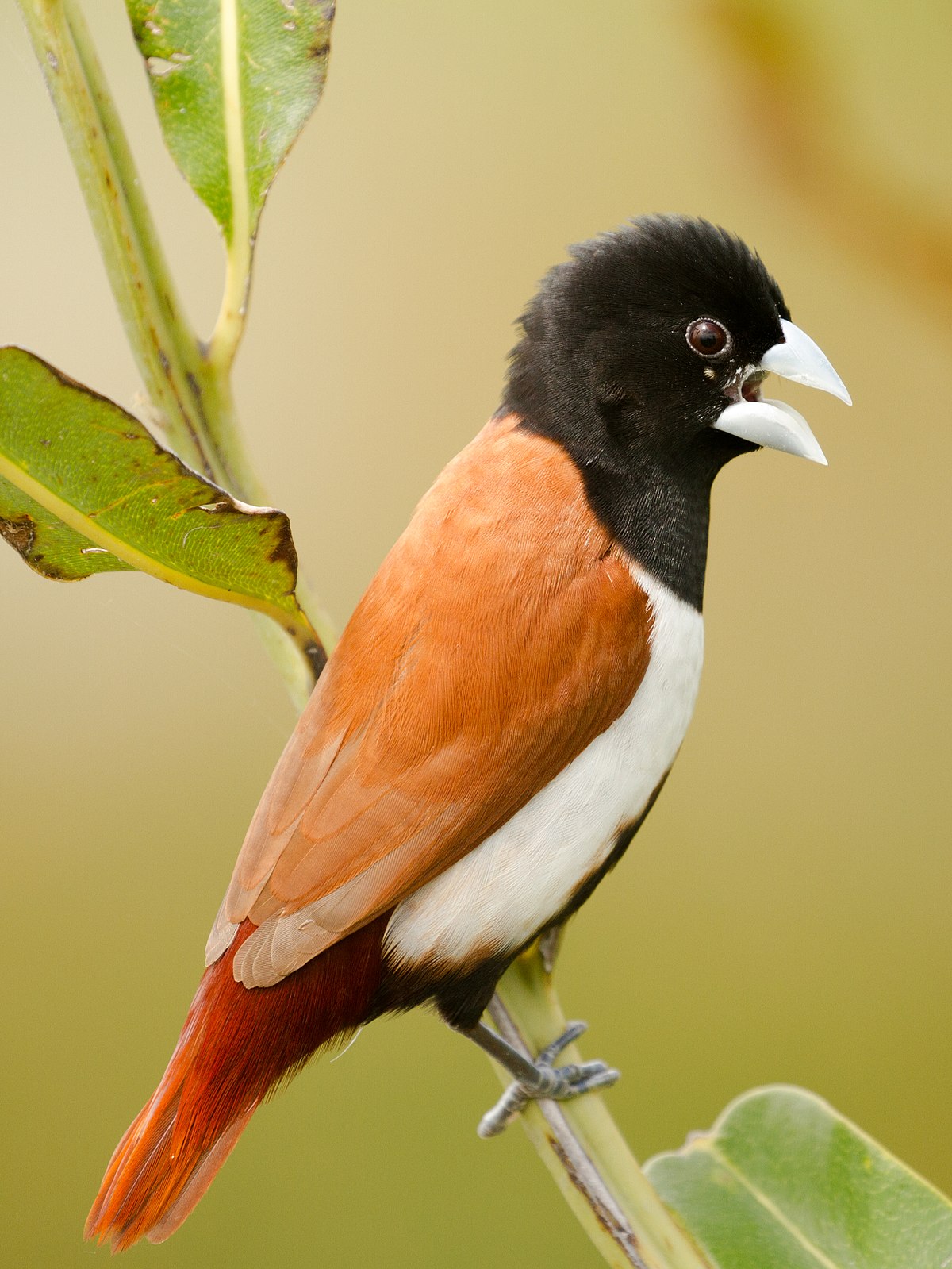
Wikipedia: Tricolored munia Source: OTHER
1200px-Tricoloured_munia_%28cropped%29.jpg
This bird appears across the great seas in the following continents:
Europe, North America, South America, Asia.
General: ![]() The tricoloured munia (Lonchura malacca) is an estrildid finch, native to Bangladesh,[2] India, Sri Lanka, Pakistan, and southern China. The species has also introduced to the Caribbean, in Trinidad, Jamaica, Hispaniola, Puerto Rico, Cuba, and Venezuela. This species, like the chestnut munia has been known as the black-headed munia. Immature birds have pale brown upperparts, lack the dark head found in adults, and have uniform buff underparts that can be confused with immatures of other munias such as the scaly-breasted munia.
[more]
The tricoloured munia (Lonchura malacca) is an estrildid finch, native to Bangladesh,[2] India, Sri Lanka, Pakistan, and southern China. The species has also introduced to the Caribbean, in Trinidad, Jamaica, Hispaniola, Puerto Rico, Cuba, and Venezuela. This species, like the chestnut munia has been known as the black-headed munia. Immature birds have pale brown upperparts, lack the dark head found in adults, and have uniform buff underparts that can be confused with immatures of other munias such as the scaly-breasted munia.
[more]
Red winged blackbird, female. 2022-05-03 10.27.30 Maryland
First observed in Maryland on 2021-06-14.
![]() The red-winged blackbird (Agelaius phoeniceus) is a passerine bird of the family Icteridae found in most of North America and much of Central America. It breeds from Alaska and Newfoundland south to Florida, the Gulf of Mexico, Mexico, and Guatemala, with isolated populations in western El Salvador, northwestern Honduras, and northwestern Costa Rica. It may winter as far north as Pennsylvania and British Columbia, but northern populations are generally migratory, moving south to Mexico and the southern United States. Claims have been made that it is the most abundant living land bird in North America, as bird-counting censuses of wintering red-winged blackbirds sometimes show that loose flocks can number in excess of a million birds per flock and the full number of breeding pairs across North and Central America may exceed 250 million in peak years. It also ranks among the best-studied wild bird species in the world.[2][3][4][5][6] The red-winged blackbird is sexually dimorphic; the male is all black with a red shoulder and yellow wing bar, while the female is a nondescript dark brown. Seeds and insects make up the bulk of the red-winged blackbird's diet.
[more]
The red-winged blackbird (Agelaius phoeniceus) is a passerine bird of the family Icteridae found in most of North America and much of Central America. It breeds from Alaska and Newfoundland south to Florida, the Gulf of Mexico, Mexico, and Guatemala, with isolated populations in western El Salvador, northwestern Honduras, and northwestern Costa Rica. It may winter as far north as Pennsylvania and British Columbia, but northern populations are generally migratory, moving south to Mexico and the southern United States. Claims have been made that it is the most abundant living land bird in North America, as bird-counting censuses of wintering red-winged blackbirds sometimes show that loose flocks can number in excess of a million birds per flock and the full number of breeding pairs across North and Central America may exceed 250 million in peak years. It also ranks among the best-studied wild bird species in the world.[2][3][4][5][6] The red-winged blackbird is sexually dimorphic; the male is all black with a red shoulder and yellow wing bar, while the female is a nondescript dark brown. Seeds and insects make up the bulk of the red-winged blackbird's diet.
[more]
Call:
Automatically generated from Xeno-Canto recording
♫ Source: BirdNet
20220501_101845 birdnet - Red-winged Blackbird - 2022-05-01 10:18:45 - Red-winged Blackbird - Cockeysville.mp3
2022-05-01 10.18.45 Cockeysville (song?)
Profile Wikipedia eBird A-Z Animals Audubon AllAboutBirds Xeno-Canto
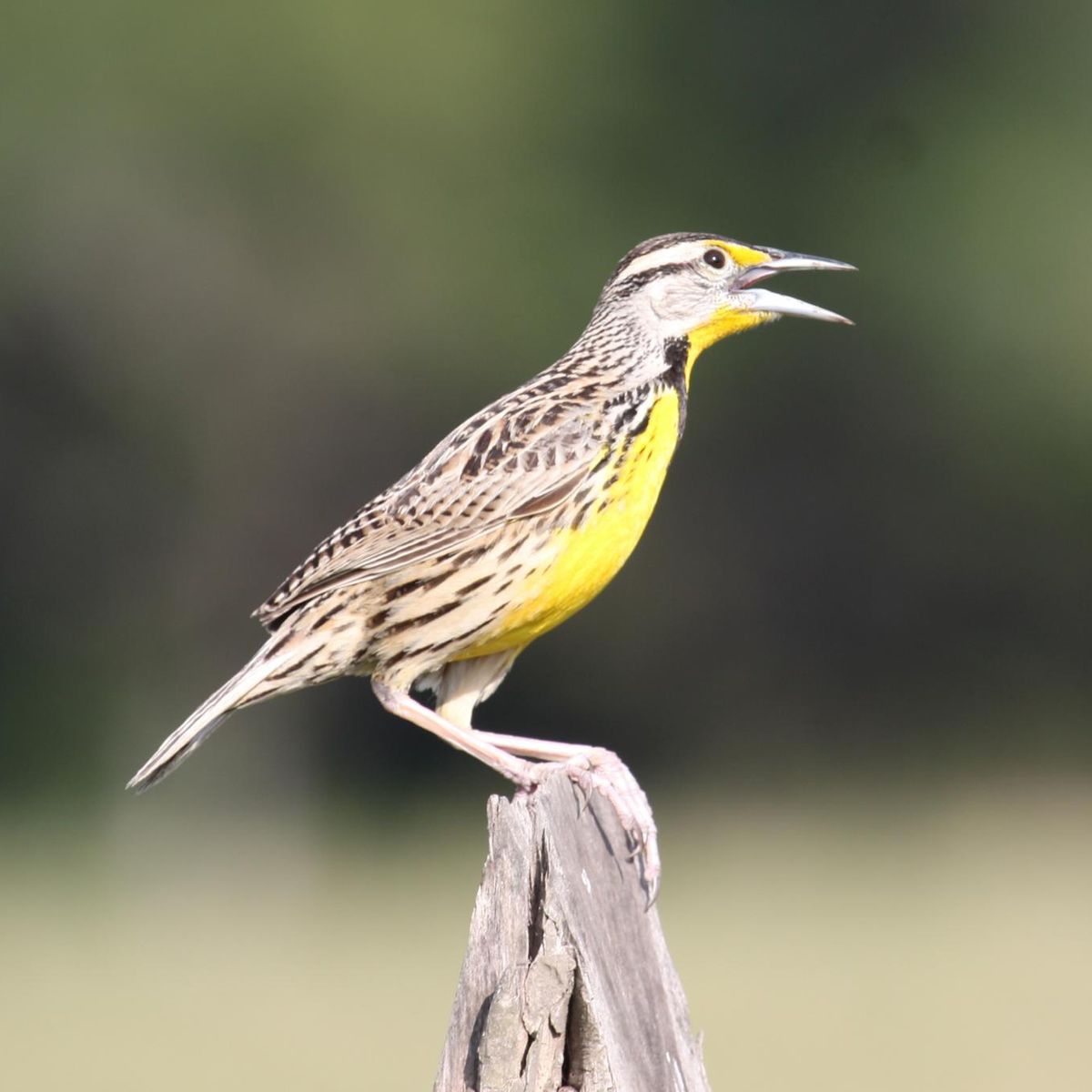
Wikipedia: Eastern meadowlark Source: OTHER
1200px-Sturnella_magna_-Mexico-8.jpg
Mexico
First observed in Panama on 2020-03-02.
![]() The eastern meadowlark (Sturnella magna) is a medium-sized icterid bird, very similar in appearance to the western meadowlark. It occurs from eastern North America to South America, where it is also most widespread in the east.
[more]
The eastern meadowlark (Sturnella magna) is a medium-sized icterid bird, very similar in appearance to the western meadowlark. It occurs from eastern North America to South America, where it is also most widespread in the east.
[more]
Call:
Automatically generated from Xeno-Canto recording
♫ Source: BirdNet
20200302_220235 birdnet 24 - Eastern Meadowlark - 2020-03-02 22:02:35 - Eastern Meadowlark - Bajo Boquete.mp3
2020-03-02 22.02.35 Panama (song?)
Profile Wikipedia eBird Xeno-Canto
Great-tailed grackle. 2018-02-19 16.00.04 Costa Rica
First observed in Costa Rica on 2018-02-12.
![]() The great-tailed grackle or Mexican grackle (Quiscalus mexicanus) is a medium-sized, highly social passerine bird native to North and South America. A member of the family Icteridae, it is one of 10 extant species of grackle and is closely related to the boat-tailed grackle and the extinct slender-billed grackle.[2] In the southern United States, it is sometimes simply referred to as "blackbird" or (erroneously) "crow"[3] due to its glossy black plumage, and similarly it is often called cuervo ("crow") in some parts of Mexico, although it is not a member of the crow genus Corvus, nor even of the family Corvidae.
[more]
The great-tailed grackle or Mexican grackle (Quiscalus mexicanus) is a medium-sized, highly social passerine bird native to North and South America. A member of the family Icteridae, it is one of 10 extant species of grackle and is closely related to the boat-tailed grackle and the extinct slender-billed grackle.[2] In the southern United States, it is sometimes simply referred to as "blackbird" or (erroneously) "crow"[3] due to its glossy black plumage, and similarly it is often called cuervo ("crow") in some parts of Mexico, although it is not a member of the crow genus Corvus, nor even of the family Corvidae.
[more]
Call:
Automatically generated from Xeno-Canto recording
♫ Source: BirdNet
20210318_165218- birdnet 16 - Great-tailed Grackle - 2020-02-25 18:35:12 - birdnet_mobile_5867288364_recording_22.wav.mp3
2021-03-18 16.52.18 Fehraltorf (song?)
MerlinBirdID says yellow-billed cacique and notes pale ivory-yellow bill and staring yellow eyes. 2023-04-02 11.17.28 Yucatan
First observed in Yucatan on 2023-04-02.
![]() The yellow-billed cacique (Amblycercus holosericeus) is a species of cacique in the family Icteridae. It is monotypic within the genus Amblycercus.[2] There is some question as to whether or not it is a true cacique.[3][4]
[more]
The yellow-billed cacique (Amblycercus holosericeus) is a species of cacique in the family Icteridae. It is monotypic within the genus Amblycercus.[2] There is some question as to whether or not it is a true cacique.[3][4]
[more]
Profile Wikipedia eBird Xeno-Canto
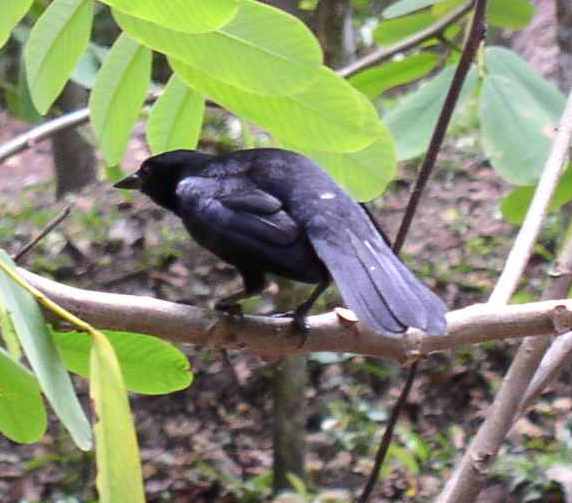
Wikipedia: Melodious blackbird Source: OTHER
Dives_dives_-Belize-4.jpg
Belize
![]() The melodious blackbird (Dives dives) is a New World tropical bird.
[more]
The melodious blackbird (Dives dives) is a New World tropical bird.
[more]
Black-cowled oriole in Manzanillo, Costa Rica. 2020-03-12 09.34.56 Costa Rica
First observed in Costa Rica on 2020-03-12.
![]() The black-cowled oriole (Icterus prosthemelas) is a species of bird in the family Icteridae. It is common and widespread in the Caribbean lowlands and foothills from southern Mexico to western Panama. It lives primarily in humid or semihumid forest, as well as in clearings, along forest edges, in plantations, in semi-open areas with scattered trees and bushes, and in gardens. The adult male is black, with yellow on the belly, shoulder, rump, wing lining, and crissum. The female's plumage varies depending on location. In the south of its range, it is similar to that of the male. In the north, its crown and upperparts are olive-yellow, while its face, throat, upper breast, wings, and tail are black.
[more]
The black-cowled oriole (Icterus prosthemelas) is a species of bird in the family Icteridae. It is common and widespread in the Caribbean lowlands and foothills from southern Mexico to western Panama. It lives primarily in humid or semihumid forest, as well as in clearings, along forest edges, in plantations, in semi-open areas with scattered trees and bushes, and in gardens. The adult male is black, with yellow on the belly, shoulder, rump, wing lining, and crissum. The female's plumage varies depending on location. In the south of its range, it is similar to that of the male. In the north, its crown and upperparts are olive-yellow, while its face, throat, upper breast, wings, and tail are black.
[more]
Baltimore oriole at Cromwell. 2022-04-29 12.40.24 Maryland
First observed in Maryland on 2021-06-18.
![]() The Baltimore oriole (Icterus galbula) is a small icterid blackbird common in eastern North America as a migratory breeding bird. It received its name from the resemblance of the male's colors to those on the coat-of-arms of Lord Baltimore. Observations of interbreeding between the Baltimore oriole and the western Bullock's oriole, Icterus bullockii, led to both being classified as a single species, called the northern oriole, from 1973 to 1995. Research by James Rising, a professor of zoology at the University of Toronto, and others showed that the two birds actually did not interbreed significantly.[2]
[more]
The Baltimore oriole (Icterus galbula) is a small icterid blackbird common in eastern North America as a migratory breeding bird. It received its name from the resemblance of the male's colors to those on the coat-of-arms of Lord Baltimore. Observations of interbreeding between the Baltimore oriole and the western Bullock's oriole, Icterus bullockii, led to both being classified as a single species, called the northern oriole, from 1973 to 1995. Research by James Rising, a professor of zoology at the University of Toronto, and others showed that the two birds actually did not interbreed significantly.[2]
[more]
Profile Wikipedia eBird A-Z Animals Audubon AllAboutBirds Xeno-Canto

Wikipedia: Orchard oriole Source: OTHER
1200px-Orchard_Oriole_by_Dan_Pancamo_1.jpg
![]() The orchard oriole (Icterus spurius) is the smallest species of icterid. The subspecies of the Caribbean coast of Mexico, I. s. fuertesi, is sometimes considered a separate species, the ochre oriole or Fuertes's oriole.
[more]
The orchard oriole (Icterus spurius) is the smallest species of icterid. The subspecies of the Caribbean coast of Mexico, I. s. fuertesi, is sometimes considered a separate species, the ochre oriole or Fuertes's oriole.
[more]
Profile Wikipedia eBird A-Z Animals Audubon AllAboutBirds Xeno-Canto
Another yellow bird, probably a hooded oriole at Uxmal. 2023-04-07 15.44.14 Yucatan
First observed in Yucatan on 2023-04-07.
![]() The hooded oriole (Icterus cucullatus) is a medium-sized New World oriole. The male of this species ranges in color from a bright orange to a paler yellow, with a black back, face, tail and bib, with the wing containing two white bars. The female is more of an olive color with some yellow accents.[2]
[more]
The hooded oriole (Icterus cucullatus) is a medium-sized New World oriole. The male of this species ranges in color from a bright orange to a paler yellow, with a black back, face, tail and bib, with the wing containing two white bars. The female is more of an olive color with some yellow accents.[2]
[more]
Profile Wikipedia eBird Audubon AllAboutBirds Xeno-Canto
Altamira oriole on second bird tour with Erik. 2023-04-16 06.37.22 Yucatan
First observed in Yucatan on 2023-03-31.
![]() The Altamira oriole (Icterus gularis) is a New World oriole. The bird is widespread in subtropical lowlands of the Mexican Gulf Coast and northern Central America, the Pacific coast and inland. They have since spread to southern Texas, but this was not until 1939.[2]
[more]
The Altamira oriole (Icterus gularis) is a New World oriole. The bird is widespread in subtropical lowlands of the Mexican Gulf Coast and northern Central America, the Pacific coast and inland. They have since spread to southern Texas, but this was not until 1939.[2]
[more]
Profile Wikipedia eBird Xeno-Canto
Yellow-tailed oriole. 2023-04-16 08.22.10 Yucatan
First observed in Yucatan on 2023-04-16.
![]() The yellow-tailed oriole (Icterus mesomelas) is a passerine bird in the New World family Icteridae. It breeds from southern Mexico to western Peru and northwestern Venezuela; in Peru it also lives in a river valley corridor.
[more]
The yellow-tailed oriole (Icterus mesomelas) is a passerine bird in the New World family Icteridae. It breeds from southern Mexico to western Peru and northwestern Venezuela; in Peru it also lives in a river valley corridor.
[more]
Profile Wikipedia eBird Xeno-Canto
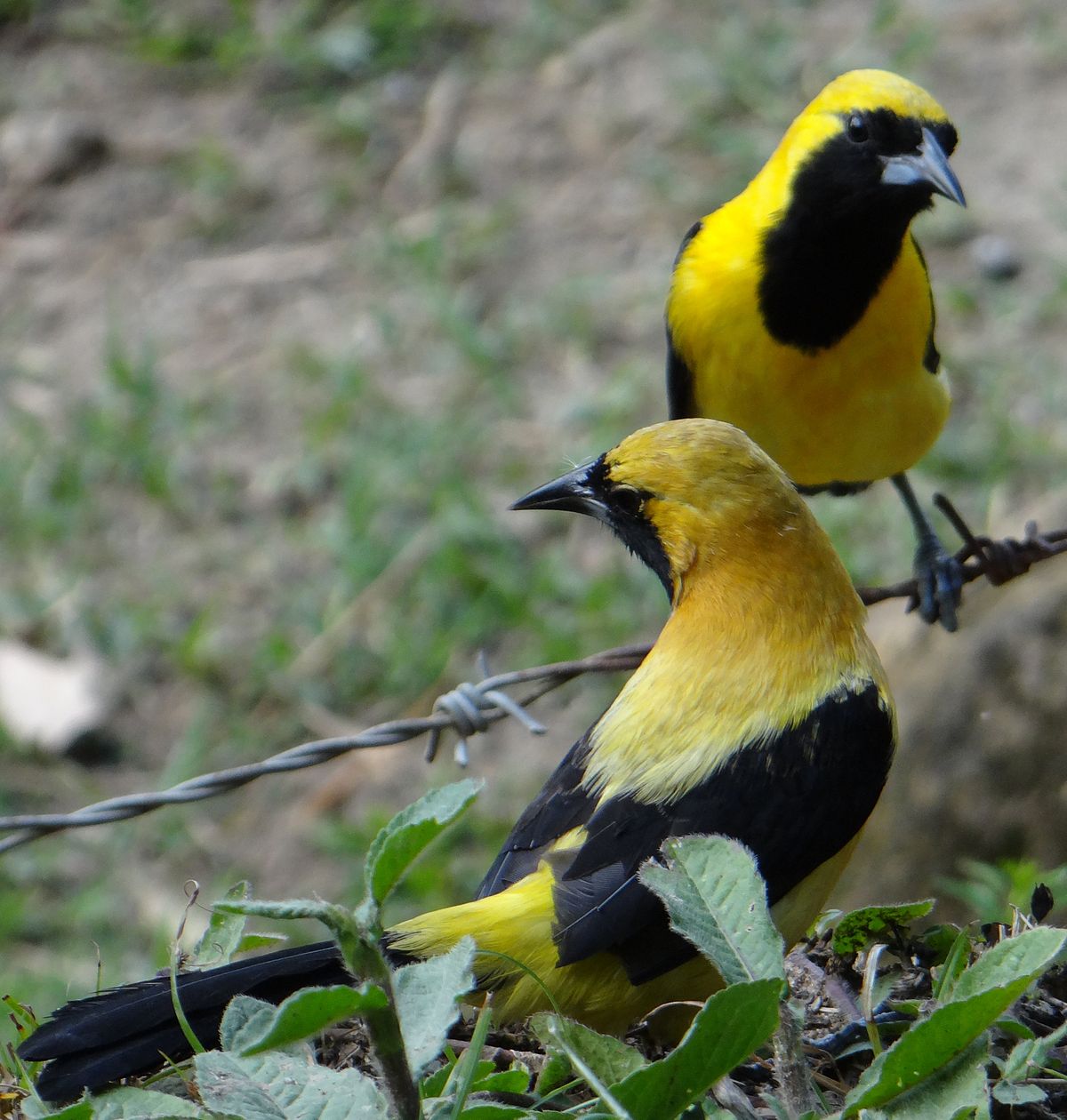
Wikipedia: Yellow-backed oriole Source: OTHER
1200px-Toche_Pareja.jpg
![]() The yellow-backed oriole (Icterus chrysater) is a species of bird in the family Icteridae.
[more]
The yellow-backed oriole (Icterus chrysater) is a species of bird in the family Icteridae.
[more]
Profile Wikipedia eBird Xeno-Canto

Wikipedia: Orange oriole Source: OTHER
1200px-Icterus_auratus_60726713.jpg
Endemic
Profile Wikipedia eBird Audubon AllAboutBirds Xeno-Canto
The red-eyed bronzed cowbird at Chichen Itza. 2023-04-13 11.57.06 Yucatan
First observed in Yucatan on 2023-04-13.
General: ![]()
The bronzed cowbird (once known as the red-eyed cowbird, Molothrus aeneus) is a small icterid.
[more]
Profile Wikipedia eBird Xeno-Canto
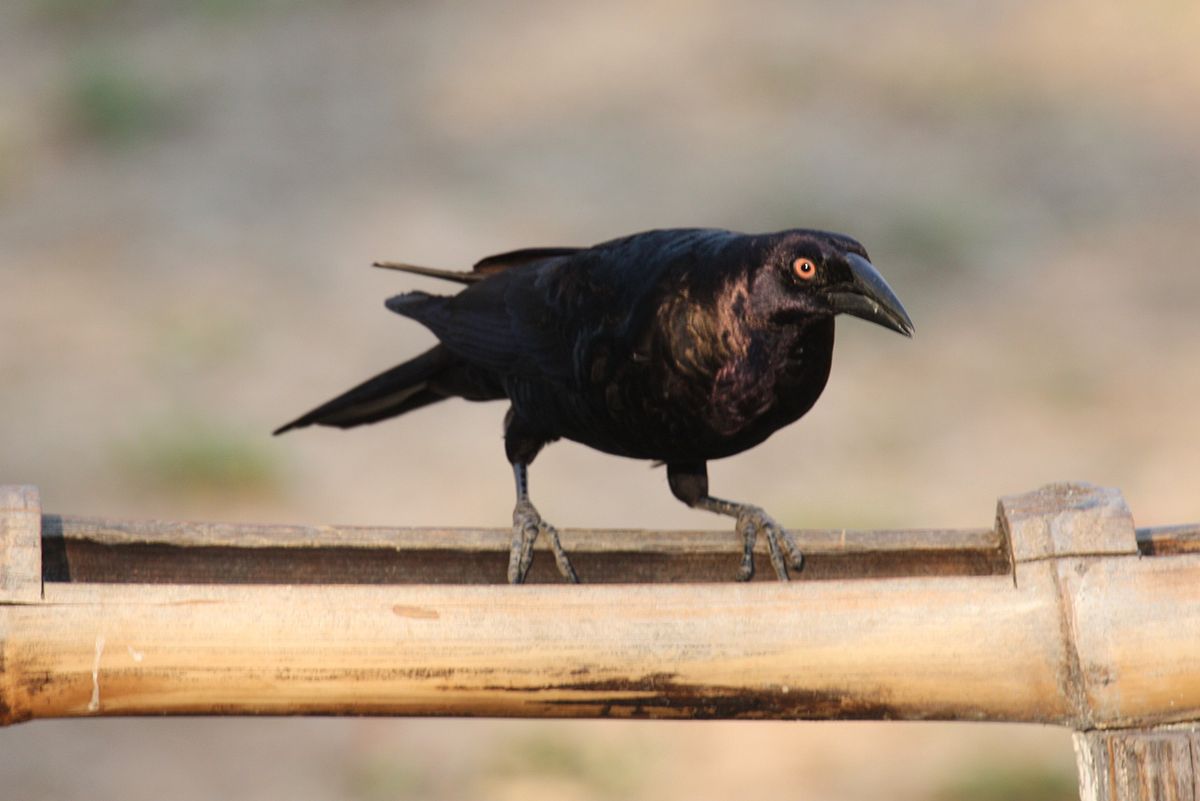
Wikipedia: Giant cowbird Source: OTHER
1200px-Molothrus_oryzivorus.jpg
![]() The giant cowbird (Molothrus oryzivorus) is a large passerine bird in the New World family Icteridae. It breeds from southern Mexico south to northern Argentina, and on Trinidad and Tobago. It may have relatively recently colonised the latter island.
[more]
The giant cowbird (Molothrus oryzivorus) is a large passerine bird in the New World family Icteridae. It breeds from southern Mexico south to northern Argentina, and on Trinidad and Tobago. It may have relatively recently colonised the latter island.
[more]
Montezuma oropendola from below. 2020-03-02 08.20.18 Panama
First observed in Costa Rica on 2018-02-27.
![]() The Montezuma Oropendola (Psarocolius montezuma) is a New World tropical icterid bird. It is a resident breeder in the Caribbean coastal lowlands from southeastern Mexico to central Panama, but is absent from El Salvador and southern Guatemala. It also occurs on the Pacific slope of Nicaragua and Honduras and northwestern and southwestern Costa Rica. It is among the oropendola species sometimes separated in the genus Gymnostinops. The English and scientific names of this species commemorate the Aztec emperor Moctezuma II.
[more]
The Montezuma Oropendola (Psarocolius montezuma) is a New World tropical icterid bird. It is a resident breeder in the Caribbean coastal lowlands from southeastern Mexico to central Panama, but is absent from El Salvador and southern Guatemala. It also occurs on the Pacific slope of Nicaragua and Honduras and northwestern and southwestern Costa Rica. It is among the oropendola species sometimes separated in the genus Gymnostinops. The English and scientific names of this species commemorate the Aztec emperor Moctezuma II.
[more]

Wikipedia: Blue-winged warbler Source: OTHER
Vermivora_cyanoptera_-North_Berwick%2C_Maine%2C_USA-8.jpg
![]() The blue-winged warbler (Vermivora cyanoptera) is a fairly common New World warbler, 11.5 cm (4.5 in) long and weighing 8.5 g (0.30 oz). It breeds in eastern North America in southern Ontario and the eastern United States. Its range is extending northwards, where it is replacing the very closely related golden-winged warbler, Vermivora chrysoptera.
[more]
The blue-winged warbler (Vermivora cyanoptera) is a fairly common New World warbler, 11.5 cm (4.5 in) long and weighing 8.5 g (0.30 oz). It breeds in eastern North America in southern Ontario and the eastern United States. Its range is extending northwards, where it is replacing the very closely related golden-winged warbler, Vermivora chrysoptera.
[more]

Wikipedia: Golden-crowned warbler Source: OTHER
1200px-Flickr_-_Dario_Sanches_-_PULA-PULA_%28Basileuterus_culicivorus%29_%283%29.jpg
![]() The golden-crowned warbler (Basileuterus culicivorus) is a small New World warbler.
[more]
The golden-crowned warbler (Basileuterus culicivorus) is a small New World warbler.
[more]
Profile Wikipedia eBird Audubon AllAboutBirds Xeno-Canto

Wikipedia: Swainson's warbler Source: OTHER
1200px-Limnothlypis_swainsonii_4702971_%28cropped%29.jpg
![]() Swainson's warbler (Limnothlypis swainsonii) is a small species of New World warbler. It is monotypic, the only member of the genus Limnothlypis. Swainson's warbler was named after William Swainson, an English ornithologist.
[more]
Swainson's warbler (Limnothlypis swainsonii) is a small species of New World warbler. It is monotypic, the only member of the genus Limnothlypis. Swainson's warbler was named after William Swainson, an English ornithologist.
[more]

Wikipedia: Kentucky warbler Source: OTHER
Oporornis_formosus_FWS.jpg
![]() The Kentucky warbler (Geothlypis formosa) is a small species of New World warbler. It is a sluggish and heavy warbler with a short tail, preferring to spend most of its time on or near the ground, except when singing.
[more]
The Kentucky warbler (Geothlypis formosa) is a small species of New World warbler. It is a sluggish and heavy warbler with a short tail, preferring to spend most of its time on or near the ground, except when singing.
[more]
MerlinBirdID suggests common yellowthroat - Kohunlich. 2023-04-03 10.51.28 Yucatan
First observed in Yucatan on 2023-04-03.
![]() The common yellowthroat (Geothlypis trichas) is a New World warbler. It is an abundant breeder in North America, ranging from southern Canada to central Mexico. The genus name Geothlypis is from Ancient Greek geo, "ground", and thlupis, an unidentified small bird; thlypis is often used in the scientific names of New World warblers. The specific trichas is also from Greek; trikhas is a kind of thrush, the word being derived from trikhos, "hair".[2]
[more]
The common yellowthroat (Geothlypis trichas) is a New World warbler. It is an abundant breeder in North America, ranging from southern Canada to central Mexico. The genus name Geothlypis is from Ancient Greek geo, "ground", and thlupis, an unidentified small bird; thlypis is often used in the scientific names of New World warblers. The specific trichas is also from Greek; trikhas is a kind of thrush, the word being derived from trikhos, "hair".[2]
[more]
Profile Wikipedia eBird Xeno-Canto

Wikipedia: Gray-crowned yellowthroat Source: OTHER
Grey-crowned_Yellowthroat_-_cropped.jpg
![]() The grey-crowned yellowthroat (Geothlypis poliocephala) is a species of bird in the family Parulidae.
It is found in Belize, Costa Rica, El Salvador, Guatemala, Honduras, Mexico, Nicaragua, Panama, and the United States.
Its natural habitats are subtropical or tropical moist shrubland and heavily degraded former forest.
[more]
The grey-crowned yellowthroat (Geothlypis poliocephala) is a species of bird in the family Parulidae.
It is found in Belize, Costa Rica, El Salvador, Guatemala, Honduras, Mexico, Nicaragua, Panama, and the United States.
Its natural habitats are subtropical or tropical moist shrubland and heavily degraded former forest.
[more]
Profile Wikipedia eBird Audubon AllAboutBirds Xeno-Canto

Wikipedia: Yellow-breasted chat Source: OTHER
Yellow-Breasted-Chat-Oregon.jpg
![]() The yellow-breasted chat (Icteria virens) is a large songbird found in North America, and is the only member of the family Icteriidae. It was once a member of the New World warbler family, but in 2017, the American Ornithological Society moved it to its own family. Its placement is not definitely resolved.
[more]
The yellow-breasted chat (Icteria virens) is a large songbird found in North America, and is the only member of the family Icteriidae. It was once a member of the New World warbler family, but in 2017, the American Ornithological Society moved it to its own family. Its placement is not definitely resolved.
[more]
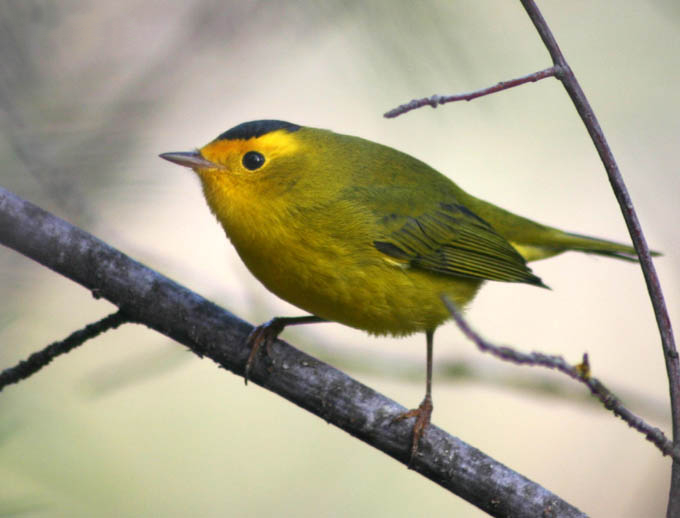
Wikipedia: Wilson's warbler Source: OTHER
Wilsonia_pusilla.jpg
![]() Wilson's warbler (Cardellina pusilla) is a small New World warbler. It is greenish above and yellow below, with rounded wings and a long, slim tail. The male has a black crown patch; depending on the subspecies, that mark is reduced or absent in the female. It breeds across Canada and south through the western United States, and winters from Mexico south through much of Central America. It is a very rare vagrant to western Europe.
[more]
Wilson's warbler (Cardellina pusilla) is a small New World warbler. It is greenish above and yellow below, with rounded wings and a long, slim tail. The male has a black crown patch; depending on the subspecies, that mark is reduced or absent in the female. It breeds across Canada and south through the western United States, and winters from Mexico south through much of Central America. It is a very rare vagrant to western Europe.
[more]
Profile Wikipedia eBird Xeno-Canto

Wikipedia: Gray-throated chat Source: OTHER
1200px-Gray-throated_Chat_%28Granatellus_sallaei%29.jpg

Wikipedia: Worm-eating warbler Source: OTHER
Worm-eating_Warbler.jpg
General: ![]() The worm-eating warbler (Helmitheros vermivorum) is a small New World warbler that breeds in the Eastern United States and migrates to southern Mexico, the Caribbean, and Central America for the winter.
[more]
The worm-eating warbler (Helmitheros vermivorum) is a small New World warbler that breeds in the Eastern United States and migrates to southern Mexico, the Caribbean, and Central America for the winter.
[more]
Black and white warbler, Ecotucan, Bacalar. 2023-03-30 17.30.48 Yucatan
First observed in Yucatan on 2023-03-27.
![]() The black-and-white warbler (Mniotilta varia) is a species of New World warbler, and the only member of its genus, Mniotilta.[2]
It breeds in northern and eastern North America and winters in Florida, Central America, and the West Indies down to Peru. This species is a very rare vagrant to western Europe.[2]
[more]
The black-and-white warbler (Mniotilta varia) is a species of New World warbler, and the only member of its genus, Mniotilta.[2]
It breeds in northern and eastern North America and winters in Florida, Central America, and the West Indies down to Peru. This species is a very rare vagrant to western Europe.[2]
[more]
Profile Wikipedia eBird Audubon AllAboutBirds Xeno-Canto
MerlinBirdID suggest a prothonotary warbler, at botanical garden, Puerto Morelos. 2023-03-27 11.50.22 Yucatan
First observed in Yucatan on 2023-03-27.
![]() The prothonotary warbler (Protonotaria citrea) is a small songbird of the New World warbler family. It is the only member of the genus Protonotaria.[2]
[more]
The prothonotary warbler (Protonotaria citrea) is a small songbird of the New World warbler family. It is the only member of the genus Protonotaria.[2]
[more]

Wikipedia: Ovenbird Source: OTHER
1200px-Ovenbird_RWD2011b.jpg
![]() The ovenbird (Seiurus aurocapilla) is a small songbird of the New World warbler family (Parulidae). This migratory bird breeds in eastern North America and winters in Central America, many Caribbean islands, Florida and northern Venezuela.[2][3]
[more]
The ovenbird (Seiurus aurocapilla) is a small songbird of the New World warbler family (Parulidae). This migratory bird breeds in eastern North America and winters in Central America, many Caribbean islands, Florida and northern Venezuela.[2][3]
[more]

Wikipedia: Black-throated blue warbler Source: OTHER
1200px-Black-throated_Blue_Warbler%2C_Parc_%C3%89coforestier_de_Johnville%2C_Quebec%2C_Canada.jpg
![]() The black-throated blue warbler (Setophaga caerulescens) is a small passerine bird of the New World warbler family. Its breeding ranges are located in the interior of deciduous and mixed coniferous forests in eastern North America. Over the cooler months, it migrates to islands in the Caribbean and Central America. It is very rarely found in western Europe, where it is considered to be a non-indigenous species. The black-throated blue warbler is sexually dimorphic; the adult male has a black face and cheeks, deep blue upperparts and white underparts, while the adult female is olive-brown above and light yellow below.
[more]
The black-throated blue warbler (Setophaga caerulescens) is a small passerine bird of the New World warbler family. Its breeding ranges are located in the interior of deciduous and mixed coniferous forests in eastern North America. Over the cooler months, it migrates to islands in the Caribbean and Central America. It is very rarely found in western Europe, where it is considered to be a non-indigenous species. The black-throated blue warbler is sexually dimorphic; the adult male has a black face and cheeks, deep blue upperparts and white underparts, while the adult female is olive-brown above and light yellow below.
[more]
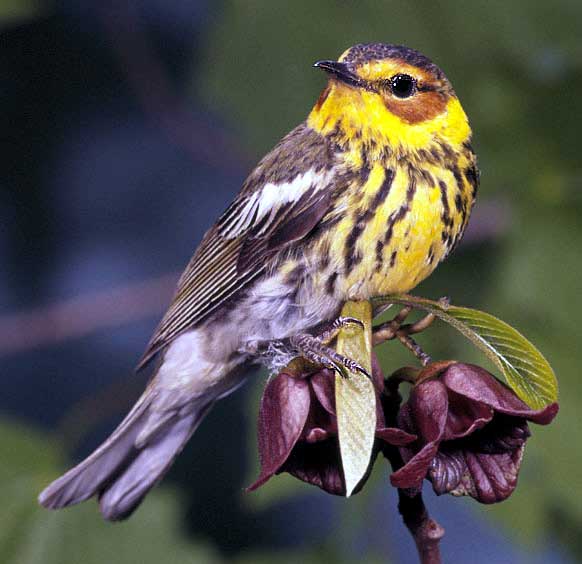
Wikipedia: Cape may warbler Source: OTHER
Dendroica_tigrina_FWS.jpg
![]() The Cape May warbler (Setophaga tigrina) is a species of New World warbler. It breeds in northern North America. Its breeding range spans all but the westernmost parts of southern Canada, the Great Lakes region, and New England. It is migratory, wintering in the West Indies. This species is a very rare vagrant to western Europe, with two records in Britain as of October 2013. The English name refers to Cape May, New Jersey, where George Ord collected the specimen later described by Alexander Wilson. This species was not recorded again in Cape May for another 100 years, although it is now known as an uncommon migrant there.[2]
[more]
The Cape May warbler (Setophaga tigrina) is a species of New World warbler. It breeds in northern North America. Its breeding range spans all but the westernmost parts of southern Canada, the Great Lakes region, and New England. It is migratory, wintering in the West Indies. This species is a very rare vagrant to western Europe, with two records in Britain as of October 2013. The English name refers to Cape May, New Jersey, where George Ord collected the specimen later described by Alexander Wilson. This species was not recorded again in Cape May for another 100 years, although it is now known as an uncommon migrant there.[2]
[more]
Palm warbler by Windham Hill Inn, Vermont. 2023-10-03 10.42.20 New England
First observed in New England on 2023-10-03.
![]() The palm warbler (Setophaga palmarum) is a small songbird of the New World warbler family.
[more]
The palm warbler (Setophaga palmarum) is a small songbird of the New World warbler family.
[more]

Wikipedia: Chestnut-sided warbler Source: OTHER
1200px-Dendroica-pensylvanica-003.jpg
![]() The chestnut-sided warbler (Setophaga pensylvanica) is a New World warbler. They breed in eastern North America and in southern Canada westwards to the Canadian Prairies. They also breed in the Great Lakes region and in the eastern United States.
[more]
The chestnut-sided warbler (Setophaga pensylvanica) is a New World warbler. They breed in eastern North America and in southern Canada westwards to the Canadian Prairies. They also breed in the Great Lakes region and in the eastern United States.
[more]
Yellow warbler, male of one of the mangrove subspecies, feeding off coconuts used just to sell the milk as a refreshing drink. 2023-04-21 07.08.16 Yucatan
First observed in Yucatan on 2023-04-21.
![]() The yellow warbler (Setophaga petechia) is a New World warbler species. Yellow warblers are the most widespread species in the diverse genus Setophaga. The species can be found throughout most of North America and migrates to wintering grounds from southern California to the Amazon region, Bolivia, and Peru.
[more]
The yellow warbler (Setophaga petechia) is a New World warbler species. Yellow warblers are the most widespread species in the diverse genus Setophaga. The species can be found throughout most of North America and migrates to wintering grounds from southern California to the Amazon region, Bolivia, and Peru.
[more]
Profile Wikipedia eBird Audubon AllAboutBirds Xeno-Canto
Possibly a female American redstart at Maya site Becan. 2023-04-03 12.11.18 Yucatan
First observed in Cockeysville on 2022-05-02.
![]() The American redstart (Setophaga ruticilla) is a New World warbler. It is unrelated to the Old World (common) redstart.
[more]
The American redstart (Setophaga ruticilla) is a New World warbler. It is unrelated to the Old World (common) redstart.
[more]
Call:
Automatically generated from Xeno-Canto recording
♫ Source: BirdNet
20220502_085740 birdnet - American Redstart - 2022-05-02 08:57:40 - American Redstart - Cockeysville.mp3
2022-05-02 08.57.40 Cockeysville (song?)

Wikipedia: Hooded warbler Source: OTHER
Wilsonia_citrina_%28Belize%29.jpg
![]() The hooded warbler (Setophaga citrina) is a New World warbler. It breeds in eastern North America and across the eastern United States and into southernmost Canada (Ontario). It is migratory, wintering in Central America and the West Indies. Hooded warblers are very rare vagrants to western Europe.
[more]
The hooded warbler (Setophaga citrina) is a New World warbler. It breeds in eastern North America and across the eastern United States and into southernmost Canada (Ontario). It is migratory, wintering in Central America and the West Indies. Hooded warblers are very rare vagrants to western Europe.
[more]
Call:
Automatically generated from Xeno-Canto recording
♫ Source: BirdNet
20210613_064404 birdnet 1638 - No confident detection, wild guess hooded warbler or yellow backed warbler - No confident detection - Cockeysville.mp3
2021-06-13 06.44.04 Cockeysville (song?)

Wikipedia: Northern parula Source: OTHER
Northernparalua20.jpg
First observed in Cockeysville on 2022-05-01.
![]() The northern parula (Setophaga americana) is a small New World warbler. It breeds in eastern North America from southern Canada to Florida.[2]
[more]
The northern parula (Setophaga americana) is a small New World warbler. It breeds in eastern North America from southern Canada to Florida.[2]
[more]
Call:
Automatically generated from Xeno-Canto recording
♫ Source: BirdNet
20220501_090658 birdnet - Northern Parula - 2022-05-01 09:06:58 - Northern Parula - Cockeysville.mp3
2022-05-01 09.06.58 Cockeysville (song?)

Wikipedia: Magnolia warbler Source: OTHER
Dendroica_magnolia_MN.jpg
![]() The magnolia warbler (Setophaga magnolia) is a member of the wood warbler family Parulidae.
[more]
The magnolia warbler (Setophaga magnolia) is a member of the wood warbler family Parulidae.
[more]

Wikipedia: Bay-breasted warbler Source: OTHER
1200px-Dendroica-castanea-001.jpg
![]() The Bay-breasted Warbler (Setophaga castanea) is a small species of songbird in the New World warbler family, Parulidae. It is one of thirty-four species in the diverse genus Setophaga.[2] Like all songbirds, or passerines, the species is classified in the order Passeriformes.
[more]
The Bay-breasted Warbler (Setophaga castanea) is a small species of songbird in the New World warbler family, Parulidae. It is one of thirty-four species in the diverse genus Setophaga.[2] Like all songbirds, or passerines, the species is classified in the order Passeriformes.
[more]
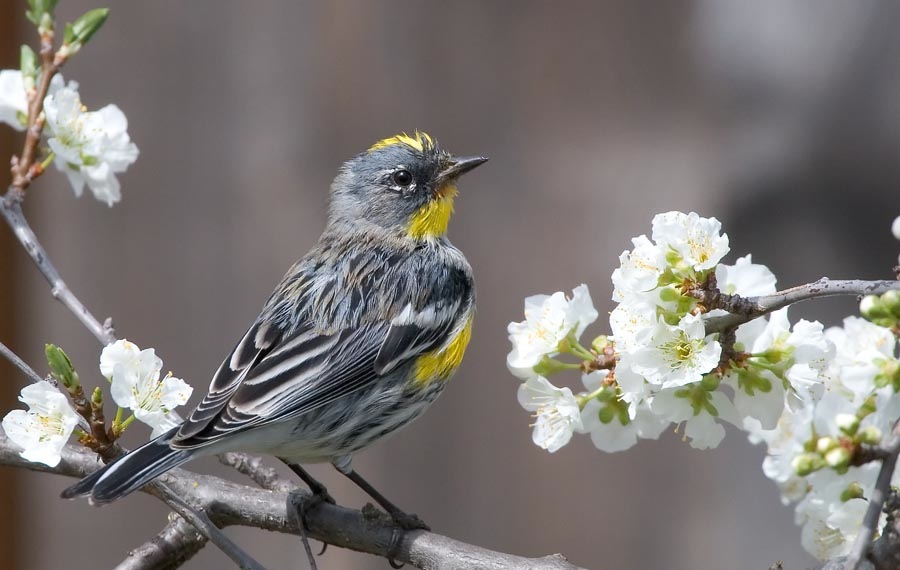
Wikipedia: Yellow-rumped warbler Source: OTHER
Audubon%27s_Warbler_Setophaga_auduboni.jpg
![]() The yellow-rumped warbler (Setophaga coronata) is a regular North American bird species that can be commonly observed all across the continent. Its extensive distribution range connects both the Pacific and Atlantic coasts of the U.S. as well as Canada and Central America, with the population concentrating in the continent's northern parts during the breeding season and migrating southwards to southern North and Central America in Winter. The species generally prefers coniferous forests or mixed coniferous-deciduous forests as its breeding habitat, while during the winter it can be found inhabiting more open areas such as shrublands that offer food resources. The diet of the yellow-rumped warbler is based primarily on insects, though the species does eat fruits such as juniper berries as well, especially in winter.
[more]
The yellow-rumped warbler (Setophaga coronata) is a regular North American bird species that can be commonly observed all across the continent. Its extensive distribution range connects both the Pacific and Atlantic coasts of the U.S. as well as Canada and Central America, with the population concentrating in the continent's northern parts during the breeding season and migrating southwards to southern North and Central America in Winter. The species generally prefers coniferous forests or mixed coniferous-deciduous forests as its breeding habitat, while during the winter it can be found inhabiting more open areas such as shrublands that offer food resources. The diet of the yellow-rumped warbler is based primarily on insects, though the species does eat fruits such as juniper berries as well, especially in winter.
[more]
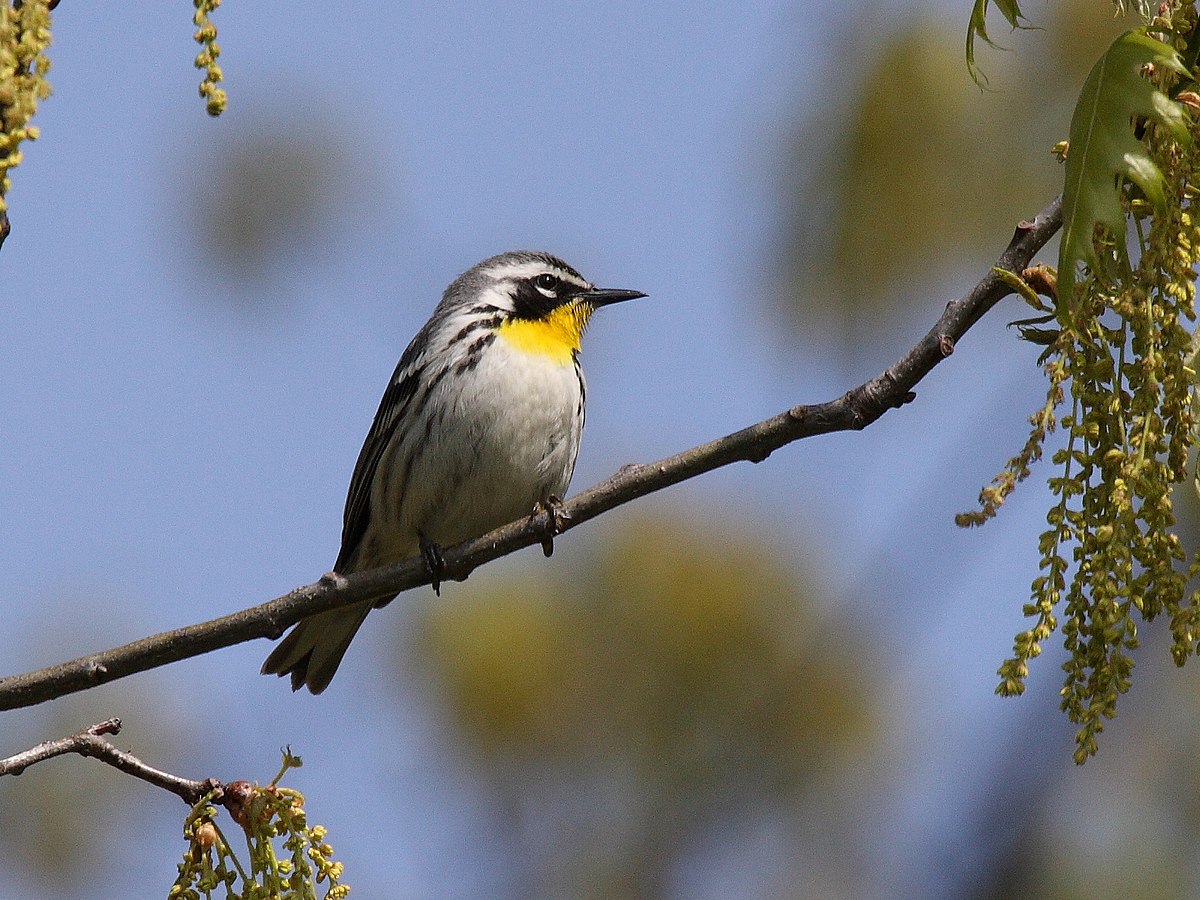
Wikipedia: Yellow-throated warbler Source: OTHER
1200px-Yellow-throated_Warbler_2.jpg
![]() The yellow-throated warbler (Setophaga dominica) is a small migratory songbird species breeding in temperate North America. It belongs to the New World warbler family (Parulidae).[2]
[more]
The yellow-throated warbler (Setophaga dominica) is a small migratory songbird species breeding in temperate North America. It belongs to the New World warbler family (Parulidae).[2]
[more]

Wikipedia: Prairie warbler Source: OTHER
1200px-Prairie_warbler_%28Setophaga_discolor_paludicola%29_male_J.jpg
![]() The prairie warbler (Setophaga discolor) is a small songbird of the New World warbler family.
[more]
The prairie warbler (Setophaga discolor) is a small songbird of the New World warbler family.
[more]

Wikipedia: Black-throated green warbler Source: OTHER
1200px-BlackthroatedGreenWarbler08.jpg
![]() The black-throated green warbler (Setophaga virens) is a small songbird of the New World warbler family.
[more]
The black-throated green warbler (Setophaga virens) is a small songbird of the New World warbler family.
[more]

Wikipedia: Tropical parula Source: OTHER
Parula_pitiayumi_-Piraju%2C_Sao_Paulo%2C_Brazil-8.jpg
![]() The tropical parula (Setophaga pitiayumi) is a small New World warbler. It breeds from southernmost Texas and northwest Mexico (Sonora) south through Central America to northern Argentina, including Trinidad and Tobago. This widespread and common species is not considered threatened by the IUCN.[1]
[more]
The tropical parula (Setophaga pitiayumi) is a small New World warbler. It breeds from southernmost Texas and northwest Mexico (Sonora) south through Central America to northern Argentina, including Trinidad and Tobago. This widespread and common species is not considered threatened by the IUCN.[1]
[more]

Wikipedia: Northern waterthrush Source: OTHER
Northern_Waterthrush%2C_Parkesia_noveboracensis.jpg
![]() The northern waterthrush (Parkesia noveboracensis[2]) is one of the larger New World warblers and one of the Nearctic-Neotropical migratory songbirds.[3] It breeds in the northern part of North America in Canada and the northern United States including Alaska. This bird is migratory, wintering in Central America, the West Indies and Florida, as well as in Venezuela, Colombia, and Ecuador. It is a very rare vagrant to other South American countries and to western Europe.
[more]
The northern waterthrush (Parkesia noveboracensis[2]) is one of the larger New World warblers and one of the Nearctic-Neotropical migratory songbirds.[3] It breeds in the northern part of North America in Canada and the northern United States including Alaska. This bird is migratory, wintering in Central America, the West Indies and Florida, as well as in Venezuela, Colombia, and Ecuador. It is a very rare vagrant to other South American countries and to western Europe.
[more]

Wikipedia: Tennessee warbler Source: OTHER
1200px-Tennessee_Warbler_2.jpg
![]() The Tennessee warbler (Leiothlypis peregrina) is a New World warbler that breeds in eastern North America and winters in southern Central America, the Caribbean, and northern South America. The specific name peregrina is from Latin peregrinus "wanderer".[2]
[more]
The Tennessee warbler (Leiothlypis peregrina) is a New World warbler that breeds in eastern North America and winters in southern Central America, the Caribbean, and northern South America. The specific name peregrina is from Latin peregrinus "wanderer".[2]
[more]

Wikipedia: Virginia's warbler Source: OTHER
1200px-Female_Virgina%27s_Warbler.JPG
![]() Virginia's warbler (Leiothlypis virginiae) is a species of New World warbler.
[more]
Virginia's warbler (Leiothlypis virginiae) is a species of New World warbler.
[more]
Lovely cotinga (Cotinga amabilis)
Profile Wikipedia eBird Xeno-Canto
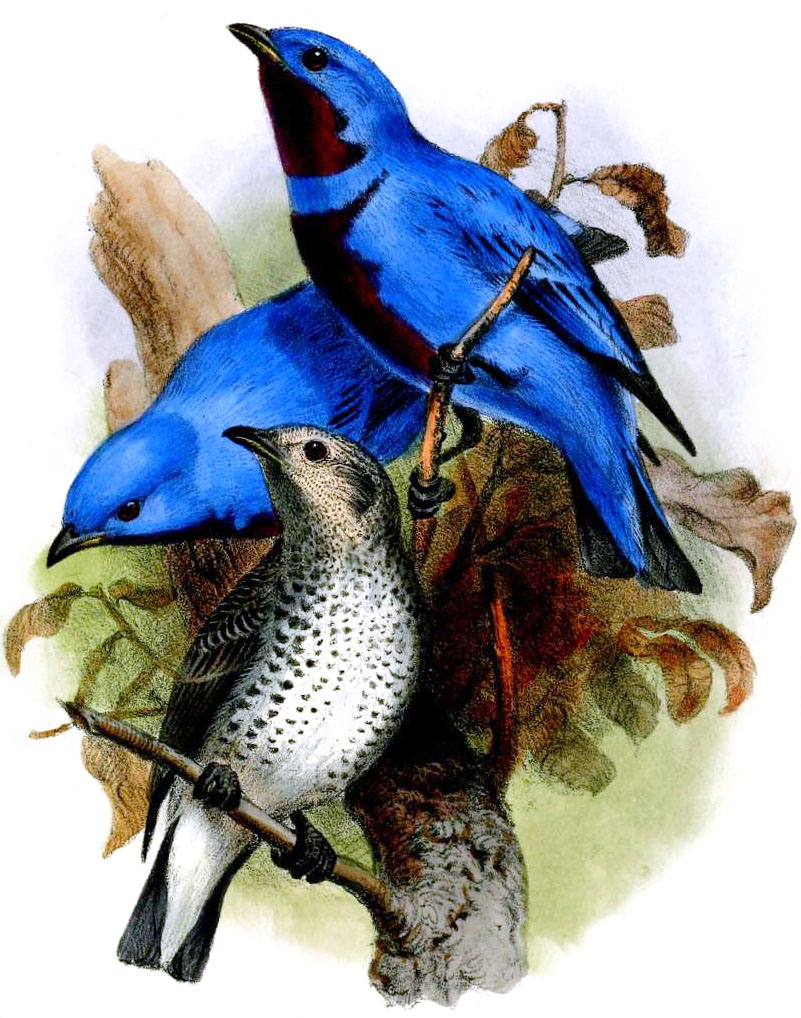
Wikipedia: Lovely cotinga Source: OTHER
Cotinga_amabilisPZS1856P123A.jpg
![]() The lovely cotinga (Cotinga amabilis) is a species of bird in the family Cotingidae. It is found in North and Central America from southern Mexico through Guatemala, Belize, Honduras and Nicaragua to Costa Rica with reports from western Panama. Its natural habitats are tropical moist lowland forests and heavily degraded former forest. The male is a bright turquoise blue while the female is greyish-brown with pale underparts. Because of its total population size and wide range, this species is not yet considered vulnerable.[2]
[more]
The lovely cotinga (Cotinga amabilis) is a species of bird in the family Cotingidae. It is found in North and Central America from southern Mexico through Guatemala, Belize, Honduras and Nicaragua to Costa Rica with reports from western Panama. Its natural habitats are tropical moist lowland forests and heavily degraded former forest. The male is a bright turquoise blue while the female is greyish-brown with pale underparts. Because of its total population size and wide range, this species is not yet considered vulnerable.[2]
[more]
Rufous-breasted spinetail (Synallaxis erythrothorax)
Profile Wikipedia eBird Xeno-Canto

Wikipedia: Rufous-breasted spinetail Source: OTHER
1200px-Synallaxis_erythrothorax_-_Rufous-breasted_Spinetail.jpg
Scaly-throated leaftosser (Sclerurus guatemalensis)
Profile Wikipedia eBird Xeno-Canto
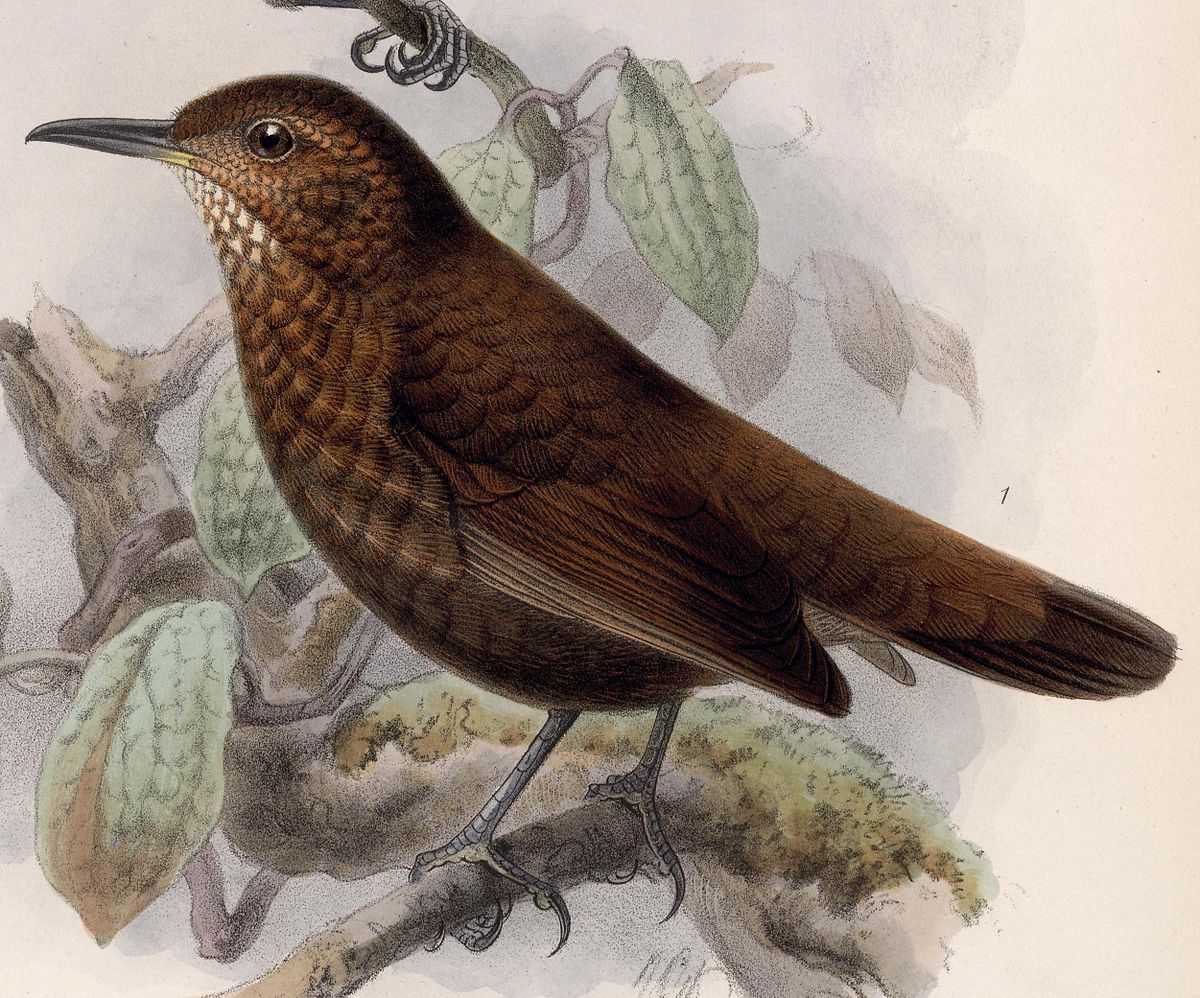
Wikipedia: Scaly-throated leaftosser Source: OTHER
1200px-Sclerurus_guatemalensis_1902.jpg
General: ![]() The scaly-throated leaftosser (Sclerurus guatemalensis) is a species of bird in the family Furnariidae. It is found in Belize, Colombia, Costa Rica, Ecuador, Guatemala, Honduras, Mexico, Nicaragua, and Panama. Its natural habitats are subtropical or tropical moist lowland forest and subtropical or tropical moist montane forest.
[more]
The scaly-throated leaftosser (Sclerurus guatemalensis) is a species of bird in the family Furnariidae. It is found in Belize, Colombia, Costa Rica, Ecuador, Guatemala, Honduras, Mexico, Nicaragua, and Panama. Its natural habitats are subtropical or tropical moist lowland forest and subtropical or tropical moist montane forest.
[more]
Buff-throated foliage-gleaner (Automolus ochrolaemus)

Wikipedia: Buff-throated foliage-gleaner Source: OTHER
Buff-throated_Foliage-gleaner_%28Automolus_ochrolaemus%29_in_Costa_Rica.jpg
![]() The buff-throated foliage-gleaner (Automolus ochrolaemus) is a species of bird in the family Furnariidae.
[more]
The buff-throated foliage-gleaner (Automolus ochrolaemus) is a species of bird in the family Furnariidae.
[more]
Plain xenops (Xenops minutus)
Profile Wikipedia eBird Xeno-Canto

Wikipedia: Plain xenops Source: OTHER
1200px-Xenops_minutus_-_Plain_xenops%3B_Restinga_de_Bertioga_State_Park%2C_S%C3%A3o_Paulo%2C_Brazil.jpg
![]() The plain xenops (Xenops minutus) is a passerine bird which breeds in moist lowland forests in the tropical New World from southern Mexico south to western Ecuador, northeastern Argentina and central Brazil.
[more]
The plain xenops (Xenops minutus) is a passerine bird which breeds in moist lowland forests in the tropical New World from southern Mexico south to western Ecuador, northeastern Argentina and central Brazil.
[more]
Veery / Wilson-Drossel (Catharus fuscescens)
Profile Wikipedia eBird Audubon AllAboutBirds Xeno-Canto

Wikipedia: Veery Source: OTHER
1200px-Catharus_fuscescens_CT.jpg
![]() The veery (Catharus fuscescens) is a small North American thrush species, a member of a group of closely related and similar species in the genus Catharus, also including the gray-cheeked thrush (C. minimus), Bicknell's thrush (C. bicknelli), Swainson's thrush (C. ustulatus), and Hermit thrush (C. guttatus).[2][3] Alternate names for this species include Wilson's thrush (named so after Alexander Wilson[4]) and tawny thrush.[5] Up to six subspecies exist, which are grouped into the eastern Veery (C. fuscescens fuscescens), the western Veery or Willow Thrush (C. fuscescens salicicolus), and the Newfoundland Veery (C. fuscescens fuliginosus).[6]
[more]
The veery (Catharus fuscescens) is a small North American thrush species, a member of a group of closely related and similar species in the genus Catharus, also including the gray-cheeked thrush (C. minimus), Bicknell's thrush (C. bicknelli), Swainson's thrush (C. ustulatus), and Hermit thrush (C. guttatus).[2][3] Alternate names for this species include Wilson's thrush (named so after Alexander Wilson[4]) and tawny thrush.[5] Up to six subspecies exist, which are grouped into the eastern Veery (C. fuscescens fuscescens), the western Veery or Willow Thrush (C. fuscescens salicicolus), and the Newfoundland Veery (C. fuscescens fuliginosus).[6]
[more]
Gray-cheeked thrush / Grauwangendrossel (Catharus minimus)
Profile Wikipedia eBird Audubon AllAboutBirds Xeno-Canto

Wikipedia: Gray-cheeked thrush Source: OTHER
1200px-Graycheekedthrush36.jpg
![]() The grey-cheeked thrush (Catharus minimus) is a medium-sized thrush. This species is 15–17 cm (5.9–6.7 in) in length, and has the white-dark-white underwing pattern characteristic of Catharus thrushes. It is a member of a close-knit group of migrant species together with the veery and Bicknell's thrush;[2] it forms a cryptic species pair with the latter. The grey-cheeked thrush is all but indistinguishable from Bicknell's thrush except by its slightly larger size and different song. The two were formerly considered conspecific.[3] Of all the American spotted thrushes, the grey-cheeked has the most northern breeding range.[4]
[more]
The grey-cheeked thrush (Catharus minimus) is a medium-sized thrush. This species is 15–17 cm (5.9–6.7 in) in length, and has the white-dark-white underwing pattern characteristic of Catharus thrushes. It is a member of a close-knit group of migrant species together with the veery and Bicknell's thrush;[2] it forms a cryptic species pair with the latter. The grey-cheeked thrush is all but indistinguishable from Bicknell's thrush except by its slightly larger size and different song. The two were formerly considered conspecific.[3] Of all the American spotted thrushes, the grey-cheeked has the most northern breeding range.[4]
[more]
Swainson's thrush (Catharus ustulatus)
Profile Wikipedia eBird Audubon AllAboutBirds Xeno-Canto

Wikipedia: Swainson's thrush Source: OTHER
1200px-Catharus_ustulatus_-North_Dakota-8a.jpg
![]() Swainson's thrush (Catharus ustulatus), also called olive-backed thrush and russet-backed thrush, is a medium-sized thrush. It is a member of genus Catharus and is typical of it in terms of its subdued coloration and beautiful, ascending flute-like voice. Swainson's thrush was named after William Swainson, an English ornithologist.
[more]
Swainson's thrush (Catharus ustulatus), also called olive-backed thrush and russet-backed thrush, is a medium-sized thrush. It is a member of genus Catharus and is typical of it in terms of its subdued coloration and beautiful, ascending flute-like voice. Swainson's thrush was named after William Swainson, an English ornithologist.
[more]
American robin / Wanderdrossel (Turdus migratorius)
American Robin intensely building a nest. 2022-04-26 16.58.36 Maryland
First observed in Cockeysville on 2021-06-11.
![]() The American robin (Turdus migratorius) is a migratory songbird of the true thrush genus and Turdidae, the wider thrush family. It is named after the European robin[2] because of its reddish-orange breast, though the two species are not closely related, with the European robin belonging to the Old World flycatcher family. The American robin is widely distributed throughout North America, wintering from southern Canada to central Mexico and along the Pacific Coast. It is the state bird of Connecticut, Michigan, and Wisconsin.[3]
[more]
The American robin (Turdus migratorius) is a migratory songbird of the true thrush genus and Turdidae, the wider thrush family. It is named after the European robin[2] because of its reddish-orange breast, though the two species are not closely related, with the European robin belonging to the Old World flycatcher family. The American robin is widely distributed throughout North America, wintering from southern Canada to central Mexico and along the Pacific Coast. It is the state bird of Connecticut, Michigan, and Wisconsin.[3]
[more]
Call:
Automatically generated from Xeno-Canto recording
♫ Source: BirdNet
20210611_204253 birdnet 1616 - American Robin - 2021-06-11 20:42:53 - American Robin - Cockeysville.mp3
2021-06-11 20.42.53 Cockeysville (song?)
Clay-colored robin (Turdus grayi)
Lava hike clay colored thrush? national bird. 2018-03-01 17.09.44 Costa Rica
First observed in Costa Rica on 2018-03-01.
![]() The clay-colored thrush (Turdus grayi) is a common Middle American bird of the thrush family (Turdidae). It is the national bird of Costa Rica, where it is well known as the yigüirro (Spanish: [ʝi'ɣwiro]). Other common names include clay-colored robin.[1]
[more]
The clay-colored thrush (Turdus grayi) is a common Middle American bird of the thrush family (Turdidae). It is the national bird of Costa Rica, where it is well known as the yigüirro (Spanish: [ʝi'ɣwiro]). Other common names include clay-colored robin.[1]
[more]
Mountain bluebird / Berghüttensänger (Sialia currucoides)
Profile Wikipedia eBird A-Z Animals Audubon AllAboutBirds Xeno-Canto

Wikipedia: Mountain bluebird Source: OTHER
Mountain_Bluebird.jpg
![]() The mountain bluebird (Sialia currucoides) is a small migratory thrush that is found in mountainous districts of western North America. It has a light underbelly and black eyes. Adult males have thin bills and are bright turquoise-blue and somewhat lighter underneath. Adult females have duller blue wings and tail, grey breast, grey crown, throat and back. In fresh fall plumage, the female's throat and breast are tinged with red-orange, brownish near the flank contrasting with white tail underparts. Their call is a thin 'few'; while their song is warbled high 'chur chur'. It is the state bird of Idaho and Nevada. It is an omnivore and it can live 6 to 10 years in the wild. It eats spiders, grasshoppers, flies and other insects, and small fruits. The mountain bluebird is a relative of the eastern and western bluebirds.
[more]
The mountain bluebird (Sialia currucoides) is a small migratory thrush that is found in mountainous districts of western North America. It has a light underbelly and black eyes. Adult males have thin bills and are bright turquoise-blue and somewhat lighter underneath. Adult females have duller blue wings and tail, grey breast, grey crown, throat and back. In fresh fall plumage, the female's throat and breast are tinged with red-orange, brownish near the flank contrasting with white tail underparts. Their call is a thin 'few'; while their song is warbled high 'chur chur'. It is the state bird of Idaho and Nevada. It is an omnivore and it can live 6 to 10 years in the wild. It eats spiders, grasshoppers, flies and other insects, and small fruits. The mountain bluebird is a relative of the eastern and western bluebirds.
[more]
Wood thrush / Walddrossel (Hylocichla mustelina)
Wood thrush, magnificent singer. 2022-05-05 18.37.08 Maryland
First observed in Cockeysville on 2021-06-12.
![]() The wood thrush (Hylocichla mustelina) is a North American passerine bird. It is closely related to other thrushes such as the American robin and is widely distributed across North America, wintering in Central America and southern Mexico. The wood thrush is the official bird of the District of Columbia.[2]
[more]
The wood thrush (Hylocichla mustelina) is a North American passerine bird. It is closely related to other thrushes such as the American robin and is widely distributed across North America, wintering in Central America and southern Mexico. The wood thrush is the official bird of the District of Columbia.[2]
[more]
Call:
Automatically generated from Xeno-Canto recording
♫ Source: BirdNet
20220505_163615 birdnet - Wood Thrush - 2022-05-05 16:36:15 - Wood Thrush - Cockeysville.mp3
2022-05-05 16.36.15 Cockeysville (song?)
Least flycatcher / Gartentyrann (Empidonax minimus)
Profile Wikipedia eBird Audubon AllAboutBirds Xeno-Canto
Least flycatcher on second outing near Rio Lagartos. 2023-04-16 06.39.50 Yucatan
First observed in Yucatan on 2023-04-16.
![]() The least flycatcher (Empidonax minimus), (also called chebec, or chebecker, after the sound it makes), is a small insect-eating bird. It is the smallest Empidonax flycatcher in eastern North America.
[more]
The least flycatcher (Empidonax minimus), (also called chebec, or chebecker, after the sound it makes), is a small insect-eating bird. It is the smallest Empidonax flycatcher in eastern North America.
[more]
Acadian flycatcher / Buchentyrann (Empidonax virescens)
Profile Wikipedia eBird Audubon AllAboutBirds Xeno-Canto
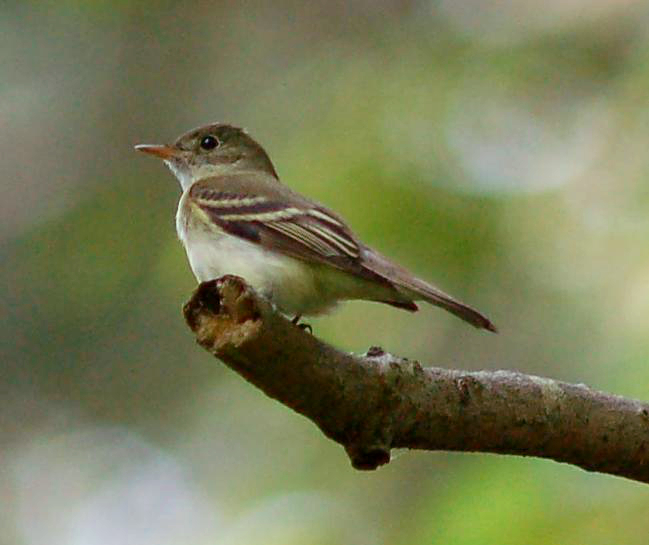
Wikipedia: Acadian flycatcher Source: OTHER
Acadian_Flycatcher.jpg
![]() The Acadian flycatcher (Empidonax virescens) is a small insect-eating bird of the tyrant flycatcher family.
[more]
The Acadian flycatcher (Empidonax virescens) is a small insect-eating bird of the tyrant flycatcher family.
[more]
Alder flycatcher (Empidonax alnorum)
Profile Wikipedia eBird Audubon AllAboutBirds Xeno-Canto

Wikipedia: Alder flycatcher Source: OTHER
1200px-Empidonax_alnorum_CT2.jpg
![]() The alder flycatcher (Empidonax alnorum) is a small insect-eating bird of the tyrant flycatcher family. The genus name Empidonax is from Ancient Greek empis, "gnat", and anax, "master". The specific alnorum is Latin and means "of the alders".[2]
[more]
The alder flycatcher (Empidonax alnorum) is a small insect-eating bird of the tyrant flycatcher family. The genus name Empidonax is from Ancient Greek empis, "gnat", and anax, "master". The specific alnorum is Latin and means "of the alders".[2]
[more]
Yellow-bellied flycatcher (Empidonax flaviventris)
Profile Wikipedia eBird Audubon AllAboutBirds Xeno-Canto

Wikipedia: Yellow-bellied flycatcher Source: OTHER
1200px-Yellow-bellied_Flycatcher_-_Empidonax_flaviventris.jpg
![]() The yellow-bellied flycatcher (Empidonax flaviventris) is a small insect-eating bird of the tyrant flycatcher family.
[more]
The yellow-bellied flycatcher (Empidonax flaviventris) is a small insect-eating bird of the tyrant flycatcher family.
[more]
Willow flycatcher (Empidonax traillii)
Profile Wikipedia eBird A-Z Animals Audubon AllAboutBirds Xeno-Canto

Wikipedia: Willow flycatcher Source: OTHER
Southwestern_Willow_Flycatcher.jpg
![]() The willow flycatcher (Empidonax traillii) is a small insect-eating, neotropical migrant bird of the tyrant flycatcher family. There are four subspecies of the willow flycatcher currently recognized, all of which breed in North America (including three subspecies that breed in California).[2] Empidonax flycatchers are almost impossible to tell apart in the field so biologists use their songs to distinguish between them.[3] The binomial commemorates the Scottish zoologist Thomas Stewart Traill.
[more]
The willow flycatcher (Empidonax traillii) is a small insect-eating, neotropical migrant bird of the tyrant flycatcher family. There are four subspecies of the willow flycatcher currently recognized, all of which breed in North America (including three subspecies that breed in California).[2] Empidonax flycatchers are almost impossible to tell apart in the field so biologists use their songs to distinguish between them.[3] The binomial commemorates the Scottish zoologist Thomas Stewart Traill.
[more]
White-throated flycatcher (Empidonax albigularis)
Profile Wikipedia eBird Xeno-Canto

Wikipedia: White-throated flycatcher Source: OTHER
1200px-Empidonax_albigularis.jpg
![]() The white-throated flycatcher (Empidonax albigularis) is a species of bird in the family Tyrannidae. It is found in Belize, Costa Rica, El Salvador, Guatemala, Honduras, Mexico, Nicaragua, and Panama. Its natural habitats are subtropical or tropical moist shrubland and heavily degraded former forest.
[more]
The white-throated flycatcher (Empidonax albigularis) is a species of bird in the family Tyrannidae. It is found in Belize, Costa Rica, El Salvador, Guatemala, Honduras, Mexico, Nicaragua, and Panama. Its natural habitats are subtropical or tropical moist shrubland and heavily degraded former forest.
[more]
Eastern kingbird / Königstyrann (Tyrannus tyrannus)
Profile Wikipedia eBird A-Z Animals Audubon AllAboutBirds Xeno-Canto
Eastern kingbird. 2022-04-29 12.54.00 Maryland
First observed in Maryland on 2021-06-14.
![]() Lanius tyrannus Linnaeus, 1758
[more]
Lanius tyrannus Linnaeus, 1758
[more]
Tropical kingbird / Trauertyrann (Tyrannus melancholicus)
Profile Wikipedia eBird Audubon AllAboutBirds Xeno-Canto
Tropical kingbird tenative ID by MerlinBirdID, tail markings. 2018-02-16 16.21.26 Costa Rica
First observed in Costa Rica on 2018-02-16.
![]() The tropical kingbird (Tyrannus melancholicus) is a large tyrant flycatcher. This bird breeds from southern Arizona and the lower Rio Grande Valley of Texas in the United States through Central America, South America as far as south as central Argentina and eastern Peru, and on Trinidad and Tobago. Birds from the northernmost and southern breeding areas migrate to warmer parts of the range after breeding.
[more]
The tropical kingbird (Tyrannus melancholicus) is a large tyrant flycatcher. This bird breeds from southern Arizona and the lower Rio Grande Valley of Texas in the United States through Central America, South America as far as south as central Argentina and eastern Peru, and on Trinidad and Tobago. Birds from the northernmost and southern breeding areas migrate to warmer parts of the range after breeding.
[more]
Couch's kingbird (Tyrannus couchii)
Profile Wikipedia eBird Audubon AllAboutBirds Xeno-Canto
Couch's kingbird is a city bird in Campeche. 2023-04-06 16.49.18 Yucatan
First observed in Yucatan on 2023-03-30.
![]() Couch's kingbird (Tyrannus couchii) is a passerine tyrant flycatcher of the kingbird genus. It is found from southern Texas along the Gulf Coast to the Yucatán Peninsula in Mexico, Belize and northern Guatemala. It is also found in the lower stretches of the Rio Grande Valley.[2]
[more]
Couch's kingbird (Tyrannus couchii) is a passerine tyrant flycatcher of the kingbird genus. It is found from southern Texas along the Gulf Coast to the Yucatán Peninsula in Mexico, Belize and northern Guatemala. It is also found in the lower stretches of the Rio Grande Valley.[2]
[more]
Black phoebe / Schwarzkopf-Phoebetyrann (Sayornis nigricans)
Profile Wikipedia eBird Audubon AllAboutBirds Xeno-Canto
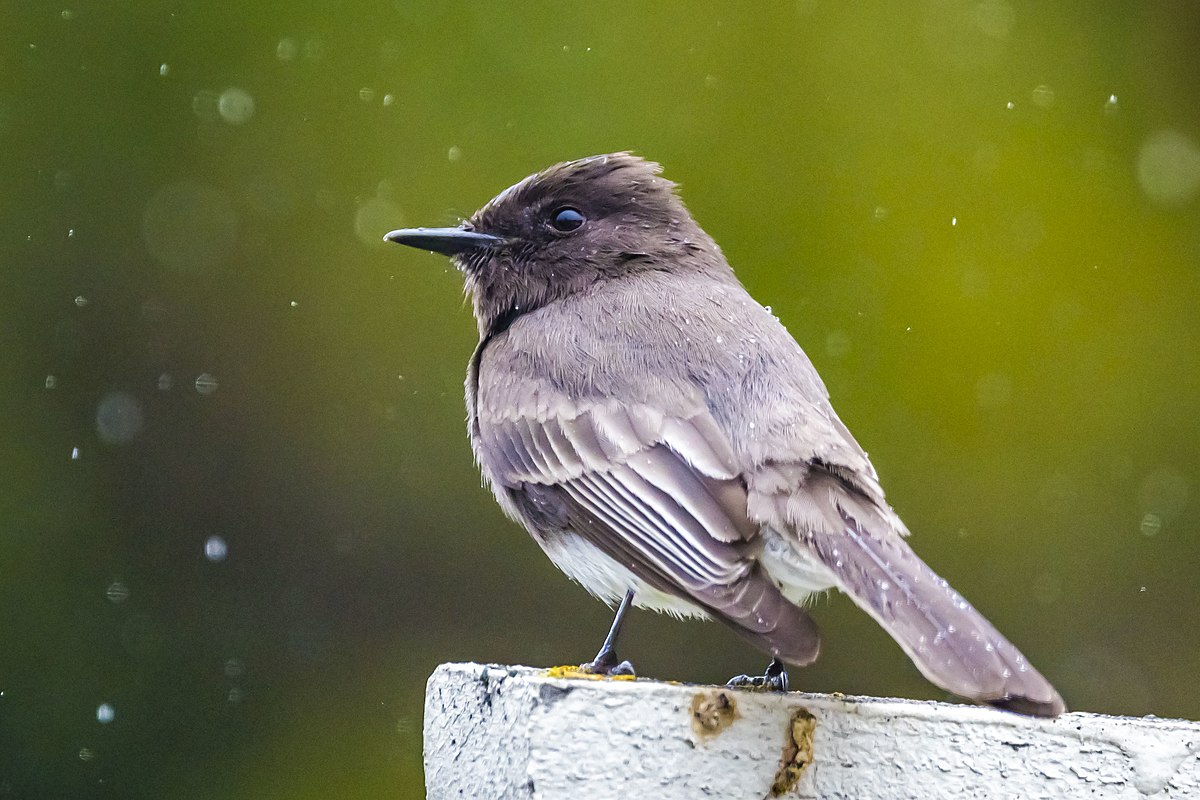
Wikipedia: Black phoebe Source: OTHER
1200px-Black_Phoebe_in_the_Rain.jpg
![]() The black phoebe (Sayornis nigricans) is a passerine bird in the tyrant-flycatcher family. It breeds from southwest Oregon and California south through Central and South America. It occurs year-round throughout most of its range and migrates less than the other birds in its genus, though its northern populations are partially migratory. Six subspecies are commonly recognized, although two are occasionally combined as a separate species, the white-winged phoebe.
[more]
The black phoebe (Sayornis nigricans) is a passerine bird in the tyrant-flycatcher family. It breeds from southwest Oregon and California south through Central and South America. It occurs year-round throughout most of its range and migrates less than the other birds in its genus, though its northern populations are partially migratory. Six subspecies are commonly recognized, although two are occasionally combined as a separate species, the white-winged phoebe.
[more]
Caribbean elaenia (Elaenia martinica)
Profile Wikipedia eBird Audubon AllAboutBirds Xeno-Canto

Wikipedia: Caribbean elaenia Source: OTHER
1200px-Caribbean_Elaenia.jpg
![]() The Caribbean elaenia (Elaenia martinica) is a species of bird in the family Tyrannidae found in the West Indies and parts of Central America. Its natural habitats are tropical and subtropical dry broadleaf forest, subtropical or tropical moist lowland forest, and heavily degraded former forest.
[more]
The Caribbean elaenia (Elaenia martinica) is a species of bird in the family Tyrannidae found in the West Indies and parts of Central America. Its natural habitats are tropical and subtropical dry broadleaf forest, subtropical or tropical moist lowland forest, and heavily degraded former forest.
[more]
Yellow-bellied elaenia (Elaenia flavogaster)
Profile Wikipedia eBird Xeno-Canto

Wikipedia: Yellow-bellied elaenia Source: OTHER
Flickr_-_Dario_Sanches_-_GUARACAVA-DE-BARRIGA-AMARELA_%28Elaenia_flavogaster%29.jpg
![]() The yellow-bellied elaenia (Elaenia flavogaster) is a small bird of the tyrant flycatcher family. It breeds from southern Mexico and the Yucatán Peninsula through Central and South America as far as northern Argentina, and on Trinidad and Tobago.
[more]
The yellow-bellied elaenia (Elaenia flavogaster) is a small bird of the tyrant flycatcher family. It breeds from southern Mexico and the Yucatán Peninsula through Central and South America as far as northern Argentina, and on Trinidad and Tobago.
[more]
Rose-throated becard (Pachyramphus aglaiae)
Profile Wikipedia eBird Audubon AllAboutBirds Xeno-Canto
Xx Rose throated becard. 2023-03-31 09.59.56 Yucatan
First observed in Yucatan on 2023-03-31.
![]() The rose-throated becard (Pachyramphus aglaiae) is a medium-sized member of the family Tityridae. Its genus, Pachyramphus, has traditionally been placed in Cotingidae or Tyrannidae, but evidence strongly suggest it is better placed in Tityridae.[2] This species was named in honour of Aglaé Brelay.[3]
[more]
The rose-throated becard (Pachyramphus aglaiae) is a medium-sized member of the family Tityridae. Its genus, Pachyramphus, has traditionally been placed in Cotingidae or Tyrannidae, but evidence strongly suggest it is better placed in Tityridae.[2] This species was named in honour of Aglaé Brelay.[3]
[more]
Cinnamon becard (Pachyramphus cinnamomeus)
Profile Wikipedia eBird Xeno-Canto

Wikipedia: Cinnamon becard Source: OTHER
Flickr_-_Rainbirder_-_Cinnamon_Becard_%28Pachyramphus_cinnamomeus%29_%281%29_%28cropped%29.jpg
![]() The cinnamon becard (Pachyramphus cinnamomeus) is a passerine bird found in Latin America.
[more]
The cinnamon becard (Pachyramphus cinnamomeus) is a passerine bird found in Latin America.
[more]
Gray-collared becard (Pachyramphus major)
Profile Wikipedia eBird Xeno-Canto

Wikipedia: Gray-collared becard Source: OTHER
1200px-Grey-collared_Becard%2C_La_Concordia%2C_Mexico_%2816372461294%29.jpg
Black-crowned tityra (Tityra inquisitor)
Profile Wikipedia eBird Xeno-Canto

Wikipedia: Black-crowned tityra Source: OTHER
Black-crowned_tityra.jpg
General: ![]() The black-crowned tityra (Tityra inquisitor) is a medium-sized passerine bird. It has traditionally been placed in the cotinga or the tyrant flycatcher family, but evidence strongly suggest it is better placed in Tityridae.
[more]
The black-crowned tityra (Tityra inquisitor) is a medium-sized passerine bird. It has traditionally been placed in the cotinga or the tyrant flycatcher family, but evidence strongly suggest it is better placed in Tityridae.
[more]
Masked tityra (Tityra semifasciata)
Profile Wikipedia eBird Xeno-Canto
Cahal pech resort masked tityra tentative ID by MerlinBirdID. 2018-02-05 17.22.32 Belize
First observed in Belize on 2018-02-05.
![]() The masked tityra (Tityra semifasciata) is a medium-sized passerine bird. It has traditionally been placed in the cotinga or the tyrant flycatcher family, but evidence strongly suggests that it is better placed in Tityridae,[2] where it is now placed by the South American Classification Committee.
[more]
The masked tityra (Tityra semifasciata) is a medium-sized passerine bird. It has traditionally been placed in the cotinga or the tyrant flycatcher family, but evidence strongly suggests that it is better placed in Tityridae,[2] where it is now placed by the South American Classification Committee.
[more]
Ochre-bellied flycatcher (Mionectes oleagineus)

Wikipedia: Ochre-bellied flycatcher Source: OTHER
1200px-Mionectes_oleagineus_2.jpg
![]() The ochre-bellied flycatcher (Mionectes oleagineus) is a small bird of the tyrant flycatcher family. It breeds from southern Mexico through Central America, and South America east of the Andes as far as southern Brazil, and on Trinidad and Tobago.
[more]
The ochre-bellied flycatcher (Mionectes oleagineus) is a small bird of the tyrant flycatcher family. It breeds from southern Mexico through Central America, and South America east of the Andes as far as southern Brazil, and on Trinidad and Tobago.
[more]
Ruddy-tailed flycatcher (Terenotriccus erythrurus)

Wikipedia: Ruddy-tailed flycatcher Source: OTHER
1200px-Terenotriccus_erythrurus_-_Ruddy-tailed_flycatcher%3B_Rio_Branco%2C_Acre%2C_Brazil.jpg
![]() The ruddy-tailed flycatcher (Terenotriccus erythrurus) is a small passerine bird in the family Tityridae. It breeds in lowlands from southeastern Mexico to northern Bolivia, north-central Brazil and the Guianas. This flycatcher ranges east of the Andes cordillera into the entire Amazon Basin of northern Brazil and the Guianas; to the west of the Andes in Colombia and Ecuador into Central America. It is the only member of the genus Terenotriccus, but some authorities place it in genus Myiobius. However, it differs in voice, behaviour, and structure from members of that group.
[more]
The ruddy-tailed flycatcher (Terenotriccus erythrurus) is a small passerine bird in the family Tityridae. It breeds in lowlands from southeastern Mexico to northern Bolivia, north-central Brazil and the Guianas. This flycatcher ranges east of the Andes cordillera into the entire Amazon Basin of northern Brazil and the Guianas; to the west of the Andes in Colombia and Ecuador into Central America. It is the only member of the genus Terenotriccus, but some authorities place it in genus Myiobius. However, it differs in voice, behaviour, and structure from members of that group.
[more]
Eastern wood-pewee (Contopus virens)
Profile Wikipedia eBird Audubon AllAboutBirds Xeno-Canto
Eastern wood pewee, last new bird we discovered - at the parking lot shortly before leaving, Oregon Ridge. 2021-06-19 09.34.10 Maryland
First observed in Maryland on 2021-06-19.
![]() The eastern wood pewee (Contopus virens) is a small tyrant flycatcher from North America. This bird and the western wood pewee (C. sordidulus) were formerly considered to be a single species. The two species are virtually identical in appearance, and can be distinguished most easily by their calls.
[more]
The eastern wood pewee (Contopus virens) is a small tyrant flycatcher from North America. This bird and the western wood pewee (C. sordidulus) were formerly considered to be a single species. The two species are virtually identical in appearance, and can be distinguished most easily by their calls.
[more]
Call:
Automatically generated from Xeno-Canto recording
♫ Source: BirdNet
20220501_084450 birdnet - Eastern Wood-Pewee - 2022-05-01 08:44:50 - Eastern Wood-Pewee - Cockeysville.mp3
2022-05-01 08.44.50 Cockeysville (song?)
Sulphur-rumped flycatcher (Myiobius sulphureipygius)
Profile Wikipedia eBird Xeno-Canto

Wikipedia: Sulphur-rumped flycatcher Source: OTHER
1200px-Myiobius_sulphureipygius_map.svg.png
General: ![]() The sulphur-rumped myiobius or sulphur-rumped flycatcher (Myiobius sulphureipygius) is a species of passerine bird in the family Tityridae. It is found in Belize, Colombia, Costa Rica, Ecuador, Guatemala, Honduras, Mexico, Nicaragua, and Panama. Its natural habitat is subtropical or tropical moist lowland forests.
[more]
The sulphur-rumped myiobius or sulphur-rumped flycatcher (Myiobius sulphureipygius) is a species of passerine bird in the family Tityridae. It is found in Belize, Colombia, Costa Rica, Ecuador, Guatemala, Honduras, Mexico, Nicaragua, and Panama. Its natural habitat is subtropical or tropical moist lowland forests.
[more]
Great crested flycatcher (Myiarchus crinitus)
Profile Wikipedia eBird A-Z Animals Audubon AllAboutBirds Xeno-Canto

Wikipedia: Great crested flycatcher Source: OTHER
Great_Crested_Flycatcher_RWD2.jpg
First observed in 🇨🇭 on 2021-03-18.
![]() The great crested flycatcher (Myiarchus crinitus) is a large insect-eating bird of the tyrant flycatcher family. It is the most widespread member of the genus Myiarchus in North America, and is found over most of the eastern and mid-western portions of the continent.[2] It dwells mostly in the treetops and rarely is found on the ground.[3]
[more]
The great crested flycatcher (Myiarchus crinitus) is a large insect-eating bird of the tyrant flycatcher family. It is the most widespread member of the genus Myiarchus in North America, and is found over most of the eastern and mid-western portions of the continent.[2] It dwells mostly in the treetops and rarely is found on the ground.[3]
[more]
Call:
Automatically generated from Xeno-Canto recording
♫ Source: BirdNet
20210318_165219- birdnet 9 - Great Crested Flycatcher - 2020-02-25 18:26:45 - birdnet_mobile_5867288364_recording_15.wav.mp3
2021-03-18 16.52.19 Fehraltorf (song?)
Brown-crested flycatcher (Myiarchus tyrannulus)
Profile Wikipedia eBird Audubon AllAboutBirds Xeno-Canto
Brown-crested flycatcher in Holbox by a morning walk. 2023-04-21 07.30.58 Yucatan
First observed in Yucatan on 2023-04-07.
![]() The brown-crested flycatcher (Myiarchus tyrannulus) is a passerine bird in the tyrant flycatcher family.
[more]
The brown-crested flycatcher (Myiarchus tyrannulus) is a passerine bird in the tyrant flycatcher family.
[more]
Dusky-capped flycatcher (Myiarchus tuberculifer)
Profile Wikipedia eBird Audubon AllAboutBirds Xeno-Canto

Wikipedia: Dusky-capped flycatcher Source: OTHER
Myiarchus-tuberculifer-001.jpg
![]() The dusky-capped flycatcher (Myiarchus tuberculifer) is a passerine bird in the tyrant flycatcher family. It breeds in forest and other woodland from southern Arizona, as well as the Chisos Mountains, Texas, south to northern Argentina and on Trinidad. It is resident in most of its range, but American breeders retreat to Mexico in winter.
[more]
The dusky-capped flycatcher (Myiarchus tuberculifer) is a passerine bird in the tyrant flycatcher family. It breeds in forest and other woodland from southern Arizona, as well as the Chisos Mountains, Texas, south to northern Argentina and on Trinidad. It is resident in most of its range, but American breeders retreat to Mexico in winter.
[more]
Yucatan flycatcher (Myiarchus yucatanensis)
Profile Wikipedia eBird Xeno-Canto

Wikipedia: Yucatan flycatcher Source: OTHER
1200px-Myiarchus_yucatanensis.jpg
Sepia-capped flycatcher (Leptopogon amaurocephalus)
Profile Wikipedia eBird Xeno-Canto

Wikipedia: Sepia-capped flycatcher Source: OTHER
Leptopogon_amaurocephalus_-Piraju%2C_Sao_Paulo%2C_Brazil-8.jpg
General: ![]() The sepia-capped flycatcher (Leptopogon amaurocephalus) is a species of bird in the family Tyrannidae.
[more]
The sepia-capped flycatcher (Leptopogon amaurocephalus) is a species of bird in the family Tyrannidae.
[more]
Greenish elaenia (Myiopagis viridicata)
Profile Wikipedia eBird Xeno-Canto

Wikipedia: Greenish elaenia Source: OTHER
1200px-Myiopagis_viridicata.jpg
![]() The greenish elaenia (Myiopagis viridicata) is a species of bird in the family Tyrannidae, the tyrant flycatchers.
It is found in Argentina, Belize, Bolivia, Brazil, Colombia, Costa Rica, Ecuador, El Salvador, Guatemala, Guyana, Honduras, Mexico, Nicaragua, Panama, Paraguay, Peru, the United States, and Venezuela.
Its natural habitats are subtropical or tropical dry forests, subtropical or tropical moist lowland forests, and heavily degraded former forest.
[more]
The greenish elaenia (Myiopagis viridicata) is a species of bird in the family Tyrannidae, the tyrant flycatchers.
It is found in Argentina, Belize, Bolivia, Brazil, Colombia, Costa Rica, Ecuador, El Salvador, Guatemala, Guyana, Honduras, Mexico, Nicaragua, Panama, Paraguay, Peru, the United States, and Venezuela.
Its natural habitats are subtropical or tropical dry forests, subtropical or tropical moist lowland forests, and heavily degraded former forest.
[more]
Common tody flycatcher (Todirostrum cinereum)

Wikipedia: Common tody flycatcher Source: OTHER
Common_Tody-Flycatcher.jpg
![]() The common tody-flycatcher or black-fronted tody-flycatcher (Todirostrum cinereum) is a very small passerine bird in the tyrant flycatcher family. It breeds from southern Mexico to northwestern Peru, eastern Bolivia and southern, eastern and northeast Brazil.
[more]
The common tody-flycatcher or black-fronted tody-flycatcher (Todirostrum cinereum) is a very small passerine bird in the tyrant flycatcher family. It breeds from southern Mexico to northwestern Peru, eastern Bolivia and southern, eastern and northeast Brazil.
[more]
Rufous mourner (Rhytipterna holerythra)
Profile Wikipedia eBird Xeno-Canto
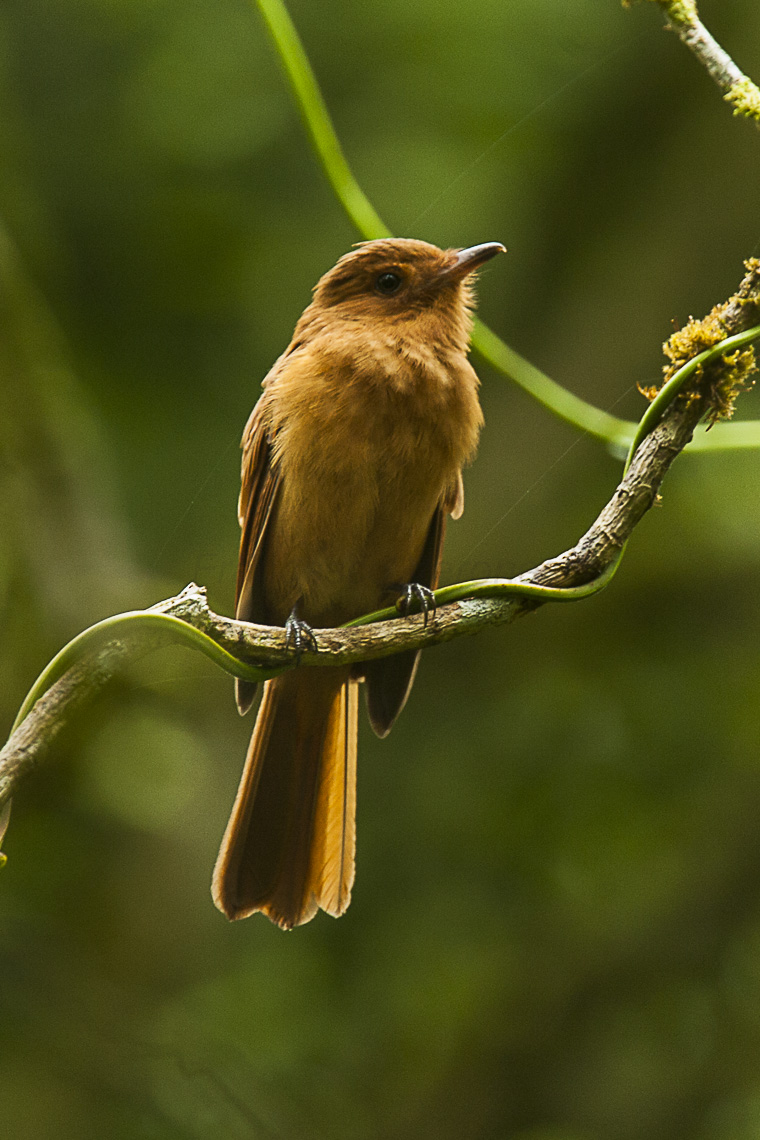
Wikipedia: Rufous mourner Source: OTHER
Rufous_Mourner_-_Panama_H8O0032.jpg
![]() The rufous mourner (Rhytipterna holerythra) is a small passerine bird in the tyrant flycatcher family. It breeds from southwestern Mexico to northwestern Ecuador. It was formerly believed to be a cotinga, but well-supported anatomical evidence has shown it to be related to tyrant flycatchers of the genera Myiarchus, Sirystes and Casiornis.[2]
[more]
The rufous mourner (Rhytipterna holerythra) is a small passerine bird in the tyrant flycatcher family. It breeds from southwestern Mexico to northwestern Ecuador. It was formerly believed to be a cotinga, but well-supported anatomical evidence has shown it to be related to tyrant flycatchers of the genera Myiarchus, Sirystes and Casiornis.[2]
[more]
Northern bentbill (Oncostoma cinereigulare)
Profile Wikipedia eBird Xeno-Canto

Wikipedia: Northern bentbill Source: OTHER
1200px-Northern_Bentbill_%28Oncostoma_cinereigulare%29_%285771914809%29.jpg
![]() The northern bentbill (Oncostoma cinereigulare) is a species of bird in the family Tyrannidae. It is found in Belize, Colombia, Costa Rica, El Salvador, Guatemala, Honduras, Mexico, Nicaragua, and Panama. Its natural habitats are subtropical or tropical dry forest, subtropical or tropical moist lowland forest, and heavily degraded former forest.
[more]
The northern bentbill (Oncostoma cinereigulare) is a species of bird in the family Tyrannidae. It is found in Belize, Colombia, Costa Rica, El Salvador, Guatemala, Honduras, Mexico, Nicaragua, and Panama. Its natural habitats are subtropical or tropical dry forest, subtropical or tropical moist lowland forest, and heavily degraded former forest.
[more]
Royal flycatcher (Onychorhynchus coronatus)
Profile Wikipedia eBird Xeno-Canto

Wikipedia: Royal flycatcher Source: OTHER
Onychorhynchus_coronatus_-_Amazonian_Royal_Flycatcher.JPG
![]() The royal flycatchers are a genus, Onychorhynchus, of passerine birds in the family Tityridae[1][2] according to the IOC. Other taxonomic authorities including the AOU, Clements, and the IUCN, include it in Onychorhynchidae. Depending on authority, it includes a single widespread,[1] or four more localized species.[2] The specific epithet of the type species, coronatus, and the common name of all the species in this genus, royal flycatcher, refer to the striking, colourful crest,[3] which is seen displayed very rarely,[3] except after mating, while preening, in courtship as well as being handled.[3]
[more]
The royal flycatchers are a genus, Onychorhynchus, of passerine birds in the family Tityridae[1][2] according to the IOC. Other taxonomic authorities including the AOU, Clements, and the IUCN, include it in Onychorhynchidae. Depending on authority, it includes a single widespread,[1] or four more localized species.[2] The specific epithet of the type species, coronatus, and the common name of all the species in this genus, royal flycatcher, refer to the striking, colourful crest,[3] which is seen displayed very rarely,[3] except after mating, while preening, in courtship as well as being handled.[3]
[more]
Stub-tailed spadebill (Platyrinchus cancrominus)
Profile Wikipedia eBird Xeno-Canto
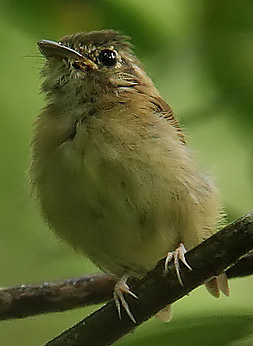
Wikipedia: Stub-tailed spadebill Source: OTHER
Flickr_-_Rainbirder_-_Stub-tailed_Spadebill_%28Platyrinchus_cancrominus%29_%281%29.jpg
![]() The stub-tailed spadebill (Platyrinchus cancrominus) is a passerine bird in the Tyrannidae family. It is commonly found in tropical dry rainforests or tropical moist lowlands throughout Central America.[2] First scientifically described in 1860, it was originally thought to be the same as Platyrinchus mystaceus but was later reclassified as a sympatric species. The stub-tailed spadebill may grow up to 9.5 cm (3.74 in) long and may weigh up to 12 g (0.42 oz). It has a white throat, yellow breast, and brown mantle and wings. The stub-tailed spadebill is most easily recognizable due to its stubby tail, broad bill, and its distinctive bird song. Some morphological differences like its greatly reduced crown differentiate it from other related species.
[more]
The stub-tailed spadebill (Platyrinchus cancrominus) is a passerine bird in the Tyrannidae family. It is commonly found in tropical dry rainforests or tropical moist lowlands throughout Central America.[2] First scientifically described in 1860, it was originally thought to be the same as Platyrinchus mystaceus but was later reclassified as a sympatric species. The stub-tailed spadebill may grow up to 9.5 cm (3.74 in) long and may weigh up to 12 g (0.42 oz). It has a white throat, yellow breast, and brown mantle and wings. The stub-tailed spadebill is most easily recognizable due to its stubby tail, broad bill, and its distinctive bird song. Some morphological differences like its greatly reduced crown differentiate it from other related species.
[more]
Yellow-olive flycatcher (Tolmomyias sulphurescens)
Profile Wikipedia eBird Xeno-Canto

Wikipedia: Yellow-olive flycatcher Source: OTHER
Tolmomyias_sulphurescens_-Parque_Estadual_da_Cantareira%2C_Sao_Paulo%2C_Brazil-8.jpg
![]() The yellow-olive flatbill or yellow-olive flycatcher (Tolmomyias sulphurescens) is a species of bird in the family Tyrannidae. It is found in tropical and subtopical forest and woodland in Central and South America, but over its range there are significant variations in plumage, iris-colour and voice, leading to speculations that more than one species is involved. Its plumage is overall greenish-yellow, the lores are whitish, the crown is often greyish and some subspecies have a dusky patch on the auriculars. The flat bill is black above and pale pinkish or greyish below; similar to the yellow-margined flatbill, but unlike the grey-crowned flatbill.
[more]
The yellow-olive flatbill or yellow-olive flycatcher (Tolmomyias sulphurescens) is a species of bird in the family Tyrannidae. It is found in tropical and subtopical forest and woodland in Central and South America, but over its range there are significant variations in plumage, iris-colour and voice, leading to speculations that more than one species is involved. Its plumage is overall greenish-yellow, the lores are whitish, the crown is often greyish and some subspecies have a dusky patch on the auriculars. The flat bill is black above and pale pinkish or greyish below; similar to the yellow-margined flatbill, but unlike the grey-crowned flatbill.
[more]
Slate-headed tody-flycatcher (Poecilotriccus sylvia)
Profile Wikipedia eBird Xeno-Canto

Wikipedia: Slate-headed tody-flycatcher Source: OTHER
Slaty-headed_Tody-Flycatcher_%28Poecilotriccus_sylvia%29_%288079753320%29.jpg
![]() The slaty-headed tody-flycatcher (Poecilotriccus sylvia) is a species of bird in the family Tyrannidae, and one of twelve in the genus Poecilotriccus.
[more]
The slaty-headed tody-flycatcher (Poecilotriccus sylvia) is a species of bird in the family Tyrannidae, and one of twelve in the genus Poecilotriccus.
[more]
Eye-ringed flatbill (Rhynchocyclus brevirostris)
Profile Wikipedia eBird Xeno-Canto

Wikipedia: Eye-ringed flatbill Source: OTHER
166_6794eyeringedflatbill.jpg
![]() The eye-ringed flatbill (Rhynchocyclus brevirostris) is a species of bird in the family Tyrannidae. It is found in Belize, Colombia, Costa Rica, El Salvador, Guatemala, Honduras, Mexico, Nicaragua, and Panama, with a slight incursion into Colombia at the south end of its range. Its natural habitats are subtropical or tropical moist lowland forests and subtropical or tropical moist montane forests.
[more]
The eye-ringed flatbill (Rhynchocyclus brevirostris) is a species of bird in the family Tyrannidae. It is found in Belize, Colombia, Costa Rica, El Salvador, Guatemala, Honduras, Mexico, Nicaragua, and Panama, with a slight incursion into Colombia at the south end of its range. Its natural habitats are subtropical or tropical moist lowland forests and subtropical or tropical moist montane forests.
[more]
Streaked flycatcher / Südlicher Fleckenmaskentyrann (Myiodynastes maculatus)
Profile Wikipedia eBird Xeno-Canto
Streaked flycatcher. 2020-02-20 14.53.44 Panama
First observed in Panama on 2020-02-20.
We saw this at Los Lagartos Restaurant on the grounds of Gamboa Rainforest Resort in Panama.
General: ![]() The streaked flycatcher (Myiodynastes maculatus) is a passerine bird in the tyrant flycatcher family.
[more]
The streaked flycatcher (Myiodynastes maculatus) is a passerine bird in the tyrant flycatcher family.
[more]
Sulphur-bellied flycatcher (Myiodynastes luteiventris)
Profile Wikipedia eBird Audubon AllAboutBirds Xeno-Canto
Sulphur-bellied flycatcher, Ecotucan. 2023-04-01 09.30.12 Yucatan
First observed in Yucatan on 2023-04-01.
![]() The sulphur-bellied flycatcher (Myiodynastes luteiventris) is a large tyrant flycatcher. This bird breeds from southeasternmost Arizona of the United States (the Madrean sky islands region of Arizona, southwestern New Mexico, and northern Sonora, Mexico) to Costa Rica. They are short distance migrants, spending winters in the eastern Andean foothills of Colombia, Ecuador, Peru, Bolivia, and Brazil, and are passage migrants over the southern portions of Central America.
[more]
The sulphur-bellied flycatcher (Myiodynastes luteiventris) is a large tyrant flycatcher. This bird breeds from southeasternmost Arizona of the United States (the Madrean sky islands region of Arizona, southwestern New Mexico, and northern Sonora, Mexico) to Costa Rica. They are short distance migrants, spending winters in the eastern Andean foothills of Colombia, Ecuador, Peru, Bolivia, and Brazil, and are passage migrants over the southern portions of Central America.
[more]
Great kiskadee / Schwefelmaskentyrann (Pitangus sulphuratus)
Profile Wikipedia eBird A-Z Animals Audubon AllAboutBirds Xeno-Canto
Great kiskadee bird eating fruit. 2018-02-26 10.28.58 Costa Rica
First observed in Costa Rica on 2018-02-26.
![]() The great kiskadee (Pitangus sulphuratus), called bem-te-vi in Brazil, is a passerine bird in the tyrant flycatcher family Tyrannidae. It is the only member of the genus Pitangus.
[more]
The great kiskadee (Pitangus sulphuratus), called bem-te-vi in Brazil, is a passerine bird in the tyrant flycatcher family Tyrannidae. It is the only member of the genus Pitangus.
[more]
Northern beardless-tyrannulet (Camptostoma imberbe)
Profile Wikipedia eBird Audubon AllAboutBirds Xeno-Canto

Wikipedia: Northern beardless-tyrannulet Source: OTHER
1200px-Northern_Beardless-Tyrannulet_%2818560065092%29.jpg
![]() The northern beardless tyrannulet (Camptostoma imberbe) is a small passerine bird in the tyrant flycatcher family. It breeds from southeasternmost Arizona and Texas of the United States through Mexico and Central America to northwestern Costa Rica.
[more]
The northern beardless tyrannulet (Camptostoma imberbe) is a small passerine bird in the tyrant flycatcher family. It breeds from southeasternmost Arizona and Texas of the United States through Mexico and Central America to northwestern Costa Rica.
[more]
Yellow-bellied tyrannulet (Ornithion semiflavum)
Profile Wikipedia eBird Xeno-Canto

Wikipedia: Yellow-bellied tyrannulet Source: OTHER
1200px-Ornithion_semiflavum_1902.jpg
![]() The yellow-bellied tyrannulet (Ornithion semiflavum) is a species of bird in the family Tyrannidae. It is found in Belize, Costa Rica, Guatemala, Honduras, Mexico, and Nicaragua. Its natural habitats are subtropical or tropical moist lowland forest and heavily degraded former forest.
[more]
The yellow-bellied tyrannulet (Ornithion semiflavum) is a species of bird in the family Tyrannidae. It is found in Belize, Costa Rica, Guatemala, Honduras, Mexico, and Nicaragua. Its natural habitats are subtropical or tropical moist lowland forest and heavily degraded former forest.
[more]
Bright-rumped attila (Attila spadiceus)
Profile Wikipedia eBird Xeno-Canto

Wikipedia: Bright-rumped attila Source: OTHER
1200px-Attila_spadiceus.jpg
![]() The bright-rumped attila or polymorphic attila (Attila spadiceus) is a small passerine bird in the tyrant flycatcher family (Tyrannidae). It breeds from northwestern Mexico to western Ecuador, Bolivia and southeastern Brazil, and on Trinidad.
[more]
The bright-rumped attila or polymorphic attila (Attila spadiceus) is a small passerine bird in the tyrant flycatcher family (Tyrannidae). It breeds from northwestern Mexico to western Ecuador, Bolivia and southeastern Brazil, and on Trinidad.
[more]
Piratic flycatcher (Legatus leucophaius)
Profile Wikipedia eBird Xeno-Canto
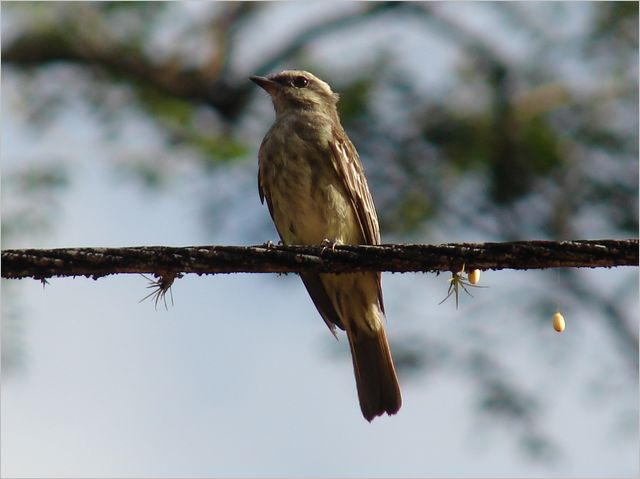
Wikipedia: Piratic flycatcher Source: OTHER
Piratic_flycatcher.jpg
![]() The piratic flycatcher (Legatus leucophaius) is a passerine bird, the only member of the genus Legatus. It is a resident breeder from southern Mexico and Trinidad south to Bolivia and Argentina. At least some birds from Central America and Trinidad are migratory, and this species also visits Tobago.
[more]
The piratic flycatcher (Legatus leucophaius) is a passerine bird, the only member of the genus Legatus. It is a resident breeder from southern Mexico and Trinidad south to Bolivia and Argentina. At least some birds from Central America and Trinidad are migratory, and this species also visits Tobago.
[more]
Boat-billed flycatcher (Megarynchus pitangua)
Profile Wikipedia eBird Xeno-Canto
Boat billed flycatcher has a much bigger beak than other yellow birds, photo at Ecotucan. 2023-03-31 08.05.34 Yucatan
First observed in Yucatan on 2023-03-31.
![]() The boat-billed flycatcher (Megarynchus pitangua) is a passerine bird. It is a large tyrant flycatcher, the only member of the monotypic genus Megarynchus.
[more]
The boat-billed flycatcher (Megarynchus pitangua) is a passerine bird. It is a large tyrant flycatcher, the only member of the monotypic genus Megarynchus.
[more]
Social flycatcher (Myiozetetes similis)
Profile Wikipedia eBird Xeno-Canto
MerlinBirdID suggests social flycatcher at botanical garden, Puerto Morelos 2. 2023-03-27 11.50.34 Yucatan
First observed in Yucatan on 2023-03-27.
![]() The social flycatcher (Myiozetetes similis) is a passerine bird from the Americas, a member of the large tyrant flycatcher family (Tyrannidae).
[more]
The social flycatcher (Myiozetetes similis) is a passerine bird from the Americas, a member of the large tyrant flycatcher family (Tyrannidae).
[more]
Cozumel thrasher / Cozumelspottdrossel (Toxostoma guttatum)
Profile Wikipedia eBird Xeno-Canto

Wikipedia: Cozumel thrasher Source: OTHER
1200px-Naturalis_Biodiversity_Center_-_RMNH.AVES.128765_2_-_Toxostoma_guttatum_%28Ridgway%2C_1885%29_-_Mimidae_-_bird_skin_specimen.jpeg
Endemic
Northern mockingbird / Gartenspottdrossel (Mimus polyglottos)
Northern mockingbird with its very long legs and tails, Cherrywood Court. 2021-06-17 05.53.30 Maryland
First observed in Maryland on 2021-06-17.
General: ![]() The northern mockingbird (Mimus polyglottos) is a mockingbird commonly found in North America. This bird is mainly a permanent resident, but northern birds may move south during harsh weather. This species has rarely been observed in Europe. This species was first described by Carl Linnaeus in his 1758 10th edition of Systema Naturae as Turdus polyglottos. The northern mockingbird is known for its mimicking ability, as reflected by the meaning of its scientific name, "many-tongued thrush". The northern mockingbird has gray to brown upper feathers and a paler belly. Its tail and wings have white patches which are visible in flight.[2]
[more]
The northern mockingbird (Mimus polyglottos) is a mockingbird commonly found in North America. This bird is mainly a permanent resident, but northern birds may move south during harsh weather. This species has rarely been observed in Europe. This species was first described by Carl Linnaeus in his 1758 10th edition of Systema Naturae as Turdus polyglottos. The northern mockingbird is known for its mimicking ability, as reflected by the meaning of its scientific name, "many-tongued thrush". The northern mockingbird has gray to brown upper feathers and a paler belly. Its tail and wings have white patches which are visible in flight.[2]
[more]
Call:
Automatically generated from Xeno-Canto recording
♫ Probably northern mockingbird at Silversage Court, Hunt Valley. 2021-06-20 08.51.26 Maryland (song?)
Tropical mockingbird (Mimus gilvus)
Profile Wikipedia eBird Xeno-Canto
Tropical mockingbird in Puerto Morelos. 2023-03-26 16.27.30 Yucatan
First observed in Yucatan on 2023-03-26.
![]() The tropical mockingbird (Mimus gilvus) is a resident breeding bird from southern Mexico south to northern Brazil, and in the Lesser Antilles and other Caribbean islands. The birds in Panama and Trinidad may have been introduced. The northern mockingbird (M. polyglottos) is its closest living relative, but the critically endangered Socorro mockingbird (M. graysoni) is also much closer to these two than previously believed .[2]
[more]
The tropical mockingbird (Mimus gilvus) is a resident breeding bird from southern Mexico south to northern Brazil, and in the Lesser Antilles and other Caribbean islands. The birds in Panama and Trinidad may have been introduced. The northern mockingbird (M. polyglottos) is its closest living relative, but the critically endangered Socorro mockingbird (M. graysoni) is also much closer to these two than previously believed .[2]
[more]
Grey catbird / Katzendrossel (Dumetella carolinensis)
Gray catbird. 2022-04-30 09.51.08 Maryland
First observed in Cockeysville on 2021-06-11.
![]() The gray catbird (Dumetella carolinensis), also spelled grey catbird, is a medium-sized North American and Central American perching bird of the mimid family. It is the only member of the "catbird" genus Dumetella. Like the black catbird (Melanoptila glabrirostris), it is among the basal lineages of the Mimidae, probably a closer relative of the Caribbean thrasher and trembler assemblage than of the mockingbirds and Toxostoma thrashers.[2][3] In some areas it is known as the slate-colored mockingbird.[4]
[more]
The gray catbird (Dumetella carolinensis), also spelled grey catbird, is a medium-sized North American and Central American perching bird of the mimid family. It is the only member of the "catbird" genus Dumetella. Like the black catbird (Melanoptila glabrirostris), it is among the basal lineages of the Mimidae, probably a closer relative of the Caribbean thrasher and trembler assemblage than of the mockingbirds and Toxostoma thrashers.[2][3] In some areas it is known as the slate-colored mockingbird.[4]
[more]
Song:
Automatically generated from Xeno-Canto recording
Song attributes:
Frequency:
♫ Gray catbird weird song, Cherrywood Court. 2021-06-16 07.38.03 Cherrywood (song)
Call:
Automatically generated from Xeno-Canto recording
♫ Source: BirdNet
20220503_083848 birdnet - Gray Catbird - 2022-05-03 08:38:48 - Gray Catbird - Cockeysville.mp3
2022-05-03 08.38.48 Cockeysville (song?)
Black catbird (Melanoptila glabrirostris)
Profile Wikipedia eBird Xeno-Canto
Wikipedia: Black catbird Source: OTHER
Melanoptila_glabrirostris_on_Ambergris_Caye_20120125_by_sbachman725.JPG
Profile Wikipedia eBird A-Z Animals Audubon AllAboutBirds Xeno-Canto
House wren. 2022-05-05 08.41.48 Maryland
First observed in Cherrywood on 2021-06-17.
General: ![]() The house wren (Troglodytes aedon) is a very small songbird of the wren family, Troglodytidae. It occurs from Canada to southernmost South America, and is thus the most widely distributed native bird in the Americas.[2] It occurs in most suburban areas in its range and it is the single most common wren. Its taxonomy is highly complex and some subspecies groups are often considered separate species.
[more]
The house wren (Troglodytes aedon) is a very small songbird of the wren family, Troglodytidae. It occurs from Canada to southernmost South America, and is thus the most widely distributed native bird in the Americas.[2] It occurs in most suburban areas in its range and it is the single most common wren. Its taxonomy is highly complex and some subspecies groups are often considered separate species.
[more]
Call:
Automatically generated from Xeno-Canto recording
♫ Source: BirdNet
20220503_103153 birdnet - House Wren - 2022-05-03 10:31:53 - House Wren - Cockeysville.mp3
2022-05-03 10.31.53 Cockeysville (song?)
Profile Wikipedia eBird Xeno-Canto

Wikipedia: Band-backed wren Source: OTHER
1200px-Campylorhynchus_zonatus.jpg
![]() The band-backed wren (Campylorhynchus zonatus) is a small songbird of the wren family.
[more]
The band-backed wren (Campylorhynchus zonatus) is a small songbird of the wren family.
[more]
Profile Wikipedia eBird Xeno-Canto

Wikipedia: Yucatan wren Source: OTHER
1200px-Matraca_yucateca_cropped.jpg
Endemic
Profile Wikipedia eBird Audubon AllAboutBirds Xeno-Canto
Carolina wren, Cromwell Valley Park. 2021-06-18 10.15.06 Maryland
First observed in Cockeysville on 2021-06-13.
General: ![]() The Carolina wren (Thryothorus ludovicianus) is a common species of wren that is a resident in the eastern half of the United States of America, the extreme south of Ontario, Canada, and the extreme northeast of Mexico. Severe winters restrict the northern limits of their range while favorable weather conditions lead to a northward extension of their breeding range. Their preferred habitat is in dense cover in forest, farm edges and suburban areas. This wren is the state bird of South Carolina.
[more]
The Carolina wren (Thryothorus ludovicianus) is a common species of wren that is a resident in the eastern half of the United States of America, the extreme south of Ontario, Canada, and the extreme northeast of Mexico. Severe winters restrict the northern limits of their range while favorable weather conditions lead to a northward extension of their breeding range. Their preferred habitat is in dense cover in forest, farm edges and suburban areas. This wren is the state bird of South Carolina.
[more]
Call:
Automatically generated from Xeno-Canto recording
♫ Carolina wren sings Figaro. ![]() Source: Zoom H6 2022-04-29 08.33.28 Maryland (song?)
Source: Zoom H6 2022-04-29 08.33.28 Maryland (song?)
Profile Wikipedia eBird Xeno-Canto

Wikipedia: White-breasted wood-wren Source: OTHER
1200px-Henicorhina_leucosticta_%28Cucarachero_pechiblanco%29_-_Juvenil_%2814037225664%29.jpg
![]() The white-breasted wood wren (Henicorhina leucosticta) is a small songbird of the wren family. It is a resident breeding species from central Mexico to northeastern Peru and Suriname.
[more]
The white-breasted wood wren (Henicorhina leucosticta) is a small songbird of the wren family. It is a resident breeding species from central Mexico to northeastern Peru and Suriname.
[more]
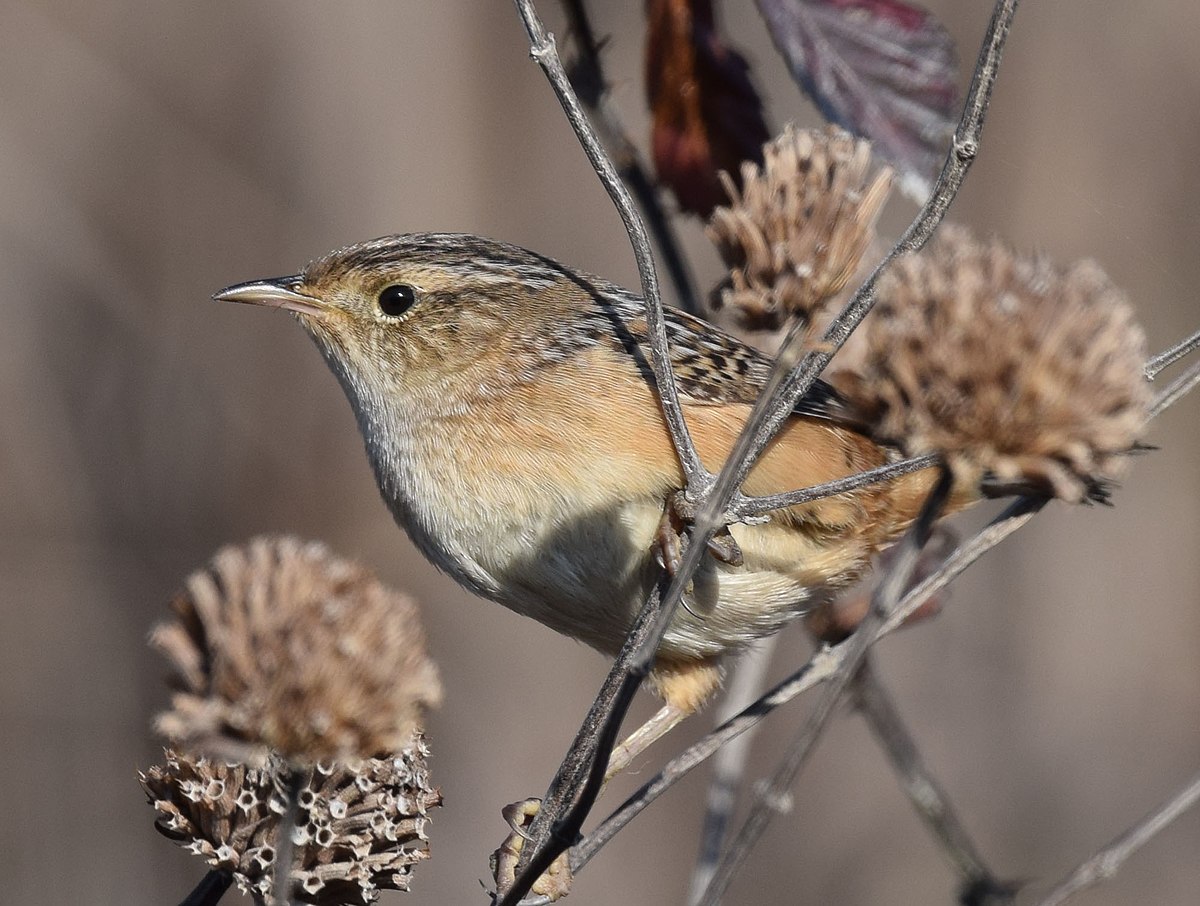
Wikipedia: Sedge wren Source: OTHER
1200px-Sedge_Wren_%2831204304001%29.jpg
![]() The sedge wren (Cistothorus stellaris) is a small and secretive passerine bird in the family Troglodytidae. It is widely distributed in North America. It is often found in wet grasslands and meadows where it nests in the tall grasses and sedges and feeds on insects. The sedge wren was formerly considered as conspecific with the non-migratory grass wren of central and South America.
[more]
The sedge wren (Cistothorus stellaris) is a small and secretive passerine bird in the family Troglodytidae. It is widely distributed in North America. It is often found in wet grasslands and meadows where it nests in the tall grasses and sedges and feeds on insects. The sedge wren was formerly considered as conspecific with the non-migratory grass wren of central and South America.
[more]
Profile Wikipedia eBird Xeno-Canto

Wikipedia: White-bellied wren Source: OTHER
1200px-White-bellied_Wren_%28Uropsila_leucogastra%29_%287223082950%29.jpg
General: ![]() Der Fleckenbrust-Zaunkönig (Pheugopedius maculipectus) ist eine Vogelart aus der Familie der Zaunkönige (Troglodytidae), die in Mexiko, Belize, Guatemala, El Salvador, Honduras, Nicaragua und Costa Rica verbreitet ist. Der Bestand wird von der IUCN als nicht gefährdet (Least Concern) eingeschätzt.
[more]
Der Fleckenbrust-Zaunkönig (Pheugopedius maculipectus) ist eine Vogelart aus der Familie der Zaunkönige (Troglodytidae), die in Mexiko, Belize, Guatemala, El Salvador, Honduras, Nicaragua und Costa Rica verbreitet ist. Der Bestand wird von der IUCN als nicht gefährdet (Least Concern) eingeschätzt.
[more]
Profile Wikipedia eBird Audubon AllAboutBirds Xeno-Canto
Blue-gray gnatcatcher. 2023-04-16 09.34.24 Yucatan
First observed in Maryland on 2022-04-29.
![]() The blue-gray gnatcatcher or blue-grey gnatcatcher (Polioptila caerulea) is a very small songbird native to North America.
[more]
The blue-gray gnatcatcher or blue-grey gnatcatcher (Polioptila caerulea) is a very small songbird native to North America.
[more]
Call:
Automatically generated from Xeno-Canto recording
♫ Source: BirdNet
20220429_112508 birdnet - Blue-gray Gnatcatcher - 2022-04-29 11:25:08 - Blue-gray Gnatcatcher - Baltimore.mp3
2022-04-29 11.25.08 Maryland (song?)
Profile Wikipedia eBird Xeno-Canto

Wikipedia: Yucatan gnatcatcher Source: OTHER
1200px-Polioptila_albiventris_58963803.jpg
Endemic

Wikipedia: White-browed gnatcatcher Source: OTHER
1200px-Naturalis_Biodiversity_Center_-_RMNH.AVES.139408_1_-_Polioptila_plumbea_bilineata_%28Bonaparte%2C_1851%29_-_Sylviidae_-_bird_skin_specimen.jpeg
Ivory-billed woodcreeper (Xiphorhynchus flavigaster)
Profile Wikipedia eBird Xeno-Canto

Wikipedia: Ivory-billed woodcreeper Source: OTHER
1200px-Ivory-Billed_Woodcreeper.jpg
General: ![]() The ivory-billed woodcreeper (Xiphorhynchus flavigaster) is a species of bird of the order of Passerformes, which are perching birds. It is in the family Furnariidae (ovenbirds) and the subfamily Dendrocolaptinae (woodcreepers).
[more]
The ivory-billed woodcreeper (Xiphorhynchus flavigaster) is a species of bird of the order of Passerformes, which are perching birds. It is in the family Furnariidae (ovenbirds) and the subfamily Dendrocolaptinae (woodcreepers).
[more]
Streak-headed woodcreeper (Lepidocolaptes souleyetii)
Profile Wikipedia eBird Xeno-Canto
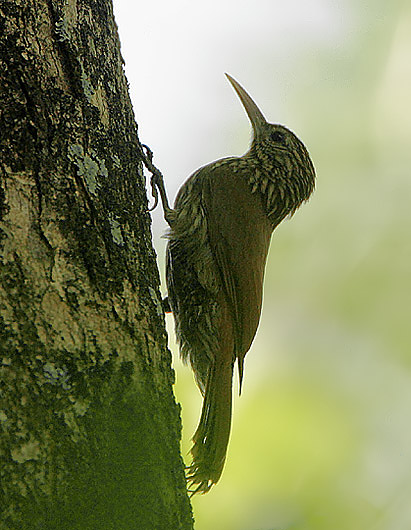
Wikipedia: Streak-headed woodcreeper Source: OTHER
Flickr_-_Rainbirder_-_Streak-headed_Woodcreeper_%28Lepidocolaptes_souleyetii%29.jpg
![]() The streak-headed woodcreeper (Lepidocolaptes souleyetii) is a passerine bird which breeds in the tropical New World from southern Mexico to northwestern Peru, northern Brazil and Guyana, and also on Trinidad.
[more]
The streak-headed woodcreeper (Lepidocolaptes souleyetii) is a passerine bird which breeds in the tropical New World from southern Mexico to northwestern Peru, northern Brazil and Guyana, and also on Trinidad.
[more]
Olivaceous woodcreeper (Sittasomus griseicapillus)
Profile Wikipedia eBird Xeno-Canto

Wikipedia: Olivaceous woodcreeper Source: OTHER
Sittasomus_griseicapillus_Olivaceous_Woodcreeper.jpg
![]() The olivaceous woodcreeper (Sittasomus griseicapillus) is a passerine bird of the tropical Americas. It belongs to the true woodcreepers (tribe Dendrocolaptini) of the ovenbird family (Furnariidae).
[more]
The olivaceous woodcreeper (Sittasomus griseicapillus) is a passerine bird of the tropical Americas. It belongs to the true woodcreepers (tribe Dendrocolaptini) of the ovenbird family (Furnariidae).
[more]
Northern barred-woodcreeper (Dendrocolaptes sanctithomae)
Profile Wikipedia eBird Xeno-Canto

Wikipedia: Northern barred-woodcreeper Source: OTHER
Flickr_-_Rainbirder_-_Northern_Barred_Woodcreeper_%28Dendrocolaptes_sanctithomae%29.jpg
![]() The northern barred woodcreeper (Dendrocolaptes sanctithomae) is a species of bird in the subfamily Dendrocolaptinae. It was formerly included as a subspecies of the Amazonian barred woodcreeper (D. certhia).
[more]
The northern barred woodcreeper (Dendrocolaptes sanctithomae) is a species of bird in the subfamily Dendrocolaptinae. It was formerly included as a subspecies of the Amazonian barred woodcreeper (D. certhia).
[more]
Ruddy woodcreeper (Dendrocincla homochroa)
Profile Wikipedia eBird Xeno-Canto

Wikipedia: Ruddy woodcreeper Source: OTHER
1200px-Dendrocincla_homochroa_imported_from_iNaturalist_19_May_2019.jpg
![]() The ruddy woodcreeper (Dendrocincla homochroa), is a passerine bird which breeds in the tropical New World from southern Mexico to northern Colombia and extreme northern Venezuela.
[more]
The ruddy woodcreeper (Dendrocincla homochroa), is a passerine bird which breeds in the tropical New World from southern Mexico to northern Colombia and extreme northern Venezuela.
[more]
Tawny-winged woodcreeper (Dendrocincla anabatina)
Profile Wikipedia eBird Xeno-Canto

Wikipedia: Tawny-winged woodcreeper Source: OTHER
Tawny-winged_Woodcreeper_-_Los_Cusingos_-_Costa_Rica_MG_7534_%2826669716916%29.jpg
![]() The tawny-winged woodcreeper (Dendrocincla anabatina) is a species of bird in the subfamily Dendrocolaptinae, the New World woodcreepers. It is found in Belize, Costa Rica, Guatemala, Honduras, Mexico, Nicaragua, and Panama. Its natural habitat is subtropical or tropical moist lowland forests.
[more]
The tawny-winged woodcreeper (Dendrocincla anabatina) is a species of bird in the subfamily Dendrocolaptinae, the New World woodcreepers. It is found in Belize, Costa Rica, Guatemala, Honduras, Mexico, Nicaragua, and Panama. Its natural habitat is subtropical or tropical moist lowland forests.
[more]
Black-faced antthrush (Formicarius analis)
Profile Wikipedia eBird Xeno-Canto

Wikipedia: Black-faced antthrush Source: OTHER
Black-faced_Antthrush_-_Rio_Tigre_-_Costa_Rica_%2826631229751%29.jpg
![]() The black-faced antthrush (Formicarius analis), is a species of passerine bird in the family Formicariidae.
[more]
The black-faced antthrush (Formicarius analis), is a species of passerine bird in the family Formicariidae.
[more]
Mayan antthrush (Formicarius moniliger)
Profile Wikipedia eBird Xeno-Canto

Wikipedia: Mayan antthrush Source: OTHER
1200px-Naturalis_Biodiversity_Center_-_RMNH.AVES.120521_-_Formicarius_analis_moniliger_Sclater%2C_1856_-_Formicariidae_-_bird_skin_specimen.jpeg
Dusky antbird (Cercomacroides tyrannina)

Wikipedia: Dusky antbird Source: OTHER
Cercomacra_tyrannina_%28female%29_-NW_Ecuador-8.jpg
General: ![]() The dusky antbird or tyrannine antbird (Cercomacroides tyrannina) is a passerine bird in the antbird family. It is a resident breeder in tropical Central and South America from southeastern Mexico southwards to western Ecuador, and Amazonian Brazil.
[more]
The dusky antbird or tyrannine antbird (Cercomacroides tyrannina) is a passerine bird in the antbird family. It is a resident breeder in tropical Central and South America from southeastern Mexico southwards to western Ecuador, and Amazonian Brazil.
[more]
Barred antshrike / Binden-Ameisenwürger (Thamnophilus doliatus)
Profile Wikipedia eBird Xeno-Canto

Wikipedia: Barred antshrike Source: OTHER
1200px-Thamnophilus_doliatus_-Goias%2C_Brazil-8.jpg
![]() The barred antshrike (Thamnophilus doliatus) is a passerine bird in the antbird family. It is found in the Neotropics from Tamaulipas, Mexico, through Central America, Trinidad and Tobago, and a large part of South America east of the Andes as far south as northern Argentina, Bolivia and Paraguay. There is one accepted record from southern Texas.[2] It is found in a wide range of wooded habitats (even gardens and parks) in both humid and arid regions. Throughout a large part of its range, it is among the most common antbirds.
[more]
The barred antshrike (Thamnophilus doliatus) is a passerine bird in the antbird family. It is found in the Neotropics from Tamaulipas, Mexico, through Central America, Trinidad and Tobago, and a large part of South America east of the Andes as far south as northern Argentina, Bolivia and Paraguay. There is one accepted record from southern Texas.[2] It is found in a wide range of wooded habitats (even gardens and parks) in both humid and arid regions. Throughout a large part of its range, it is among the most common antbirds.
[more]
Russet antshrike (Thamnistes anabatinus)
Profile Wikipedia eBird Xeno-Canto
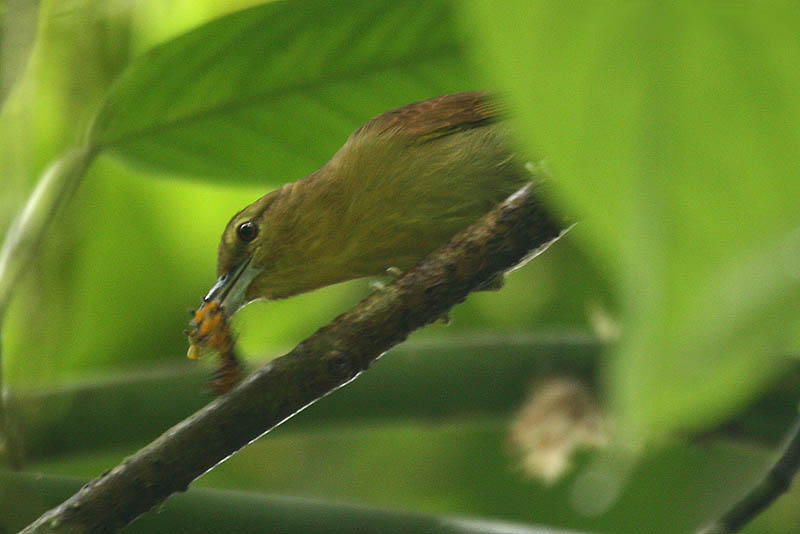
Wikipedia: Russet antshrike Source: OTHER
Thamnistes_anabatinus_-NW_Ecuador-6.jpg
![]() The russet antshrike (Thamnistes anabatinus) is a passerine bird in the antbird family.
[more]
The russet antshrike (Thamnistes anabatinus) is a passerine bird in the antbird family.
[more]
Plain antvireo (Dysithamnus mentalis)
Profile Wikipedia eBird Xeno-Canto

Wikipedia: Plain antvireo Source: OTHER
1200px-Dysithamnus_mentalis_-_Plain_Antvireo_%28male%29.JPG
![]() The plain antvireo (Dysithamnus mentalis) is a passerine bird species in the antbird family (Thamnophilidae). It is a resident breeder in tropical Central and South America.
[more]
The plain antvireo (Dysithamnus mentalis) is a passerine bird species in the antbird family (Thamnophilidae). It is a resident breeder in tropical Central and South America.
[more]
Dot-winged antwren (Microrhopias quixensis)
Profile Wikipedia eBird Xeno-Canto
Wikipedia: Dot-winged antwren Source: OTHER
Microrhopias_quixensis_-_Dot-winged_Antwren_%28male%29.JPG
![]() The dot-winged antwren (Microrhopias quixensis) is a passerine bird in the antbird family. In the past it was sometimes known as the velvety antwren, and some of its more distinctive subspecies have their own infrequently used English names. It is a resident in tropical Central and South America from southeastern Mexico south to western Ecuador, northern Bolivia, central Brazil and the Guianas. It is the only member of the genus Microrhopias.
[more]
The dot-winged antwren (Microrhopias quixensis) is a passerine bird in the antbird family. In the past it was sometimes known as the velvety antwren, and some of its more distinctive subspecies have their own infrequently used English names. It is a resident in tropical Central and South America from southeastern Mexico south to western Ecuador, northern Bolivia, central Brazil and the Guianas. It is the only member of the genus Microrhopias.
[more]
Northern schiffornis (Schiffornis veraepacis)
Profile Wikipedia eBird Xeno-Canto

Wikipedia: Northern schiffornis Source: OTHER
1200px-Schiffornis_veraepacis_%2815150857585%29.jpg
![]() The northern schiffornis (Schiffornis veraepacis), is a species of Neotropical bird.
[more]
The northern schiffornis (Schiffornis veraepacis), is a species of Neotropical bird.
[more]
White-collared manakin (Manacus candei)
Profile Wikipedia eBird Xeno-Canto

Wikipedia: White-collared manakin Source: OTHER
Manacus_candei_-La_Selva_Biological_Station%2C_Costa_Rica_-male-8.jpg
![]() The white-collared manakin (Manacus candei) is a passerine bird in the manakin family. It is a resident breeder in the tropical New World from southeastern Mexico to Costa Rica and the extreme west of Panama. It typically inhabits thickets at the edges of moist forest, tall secondary growth and old cacao plantations. It is a small, plump bird about 11 centimetres (4.3 in) long. Males have a black crown, mid-back band, wings and tail, an olive-green rump and yellow belly. Females and juveniles are olive-green with yellow bellies and resemble female orange-collared manakins. At breeding time, males are involved in lekking behaviour on the forest floor during which they puff out their neck feathers. This is a fairly common species with a wide range, and the International Union for Conservation of Nature has rated its conservation status as being of "least concern".
[more]
The white-collared manakin (Manacus candei) is a passerine bird in the manakin family. It is a resident breeder in the tropical New World from southeastern Mexico to Costa Rica and the extreme west of Panama. It typically inhabits thickets at the edges of moist forest, tall secondary growth and old cacao plantations. It is a small, plump bird about 11 centimetres (4.3 in) long. Males have a black crown, mid-back band, wings and tail, an olive-green rump and yellow belly. Females and juveniles are olive-green with yellow bellies and resemble female orange-collared manakins. At breeding time, males are involved in lekking behaviour on the forest floor during which they puff out their neck feathers. This is a fairly common species with a wide range, and the International Union for Conservation of Nature has rated its conservation status as being of "least concern".
[more]
Red-capped manakin (Ceratopipra mentalis)
Profile Wikipedia eBird Xeno-Canto

Wikipedia: Red-capped manakin Source: OTHER
Red-capped-manakin.png
![]() The red-capped manakin (Ceratopipra mentalis) is a species of bird in the family Pipridae.
It is found in Belize, Colombia, Costa Rica, Ecuador, Guatemala, Honduras, Mexico, Nicaragua, Peru and Panama.
Its natural habitat is subtropical or tropical moist lowland forest.
[more]
The red-capped manakin (Ceratopipra mentalis) is a species of bird in the family Pipridae.
It is found in Belize, Colombia, Costa Rica, Ecuador, Guatemala, Honduras, Mexico, Nicaragua, Peru and Panama.
Its natural habitat is subtropical or tropical moist lowland forest.
[more]
Cedar waxwing (Bombycilla cedrorum)
Profile Wikipedia eBird A-Z Animals Audubon AllAboutBirds Xeno-Canto

Wikipedia: Cedar waxwing Source: OTHER
Cedar_Waxwing_-_Bombycilla_cedrorum%2C_George_Washington%27s_Birthplace_National_Monument%2C_Colonial_Beach%2C_Virginia_%2839997434862%29.jpg
![]() The cedar waxwing (Bombycilla cedrorum) is a member of the family Bombycillidae or waxwing family of passerine birds. It is a medium-sized, mostly brown, gray, and yellow. This bird is named for its wax-like wing tips. It is a native of North and Central America, breeding in open wooded areas in southern Canada and wintering in the southern half of the United States, Central America, and the far northwest of South America. Its diet includes cedar cones, fruit, and insects.[2] The cedar waxwing is not endangered.
[more]
The cedar waxwing (Bombycilla cedrorum) is a member of the family Bombycillidae or waxwing family of passerine birds. It is a medium-sized, mostly brown, gray, and yellow. This bird is named for its wax-like wing tips. It is a native of North and Central America, breeding in open wooded areas in southern Canada and wintering in the southern half of the United States, Central America, and the far northwest of South America. Its diet includes cedar cones, fruit, and insects.[2] The cedar waxwing is not endangered.
[more]
Profile Wikipedia eBird Audubon AllAboutBirds Xeno-Canto
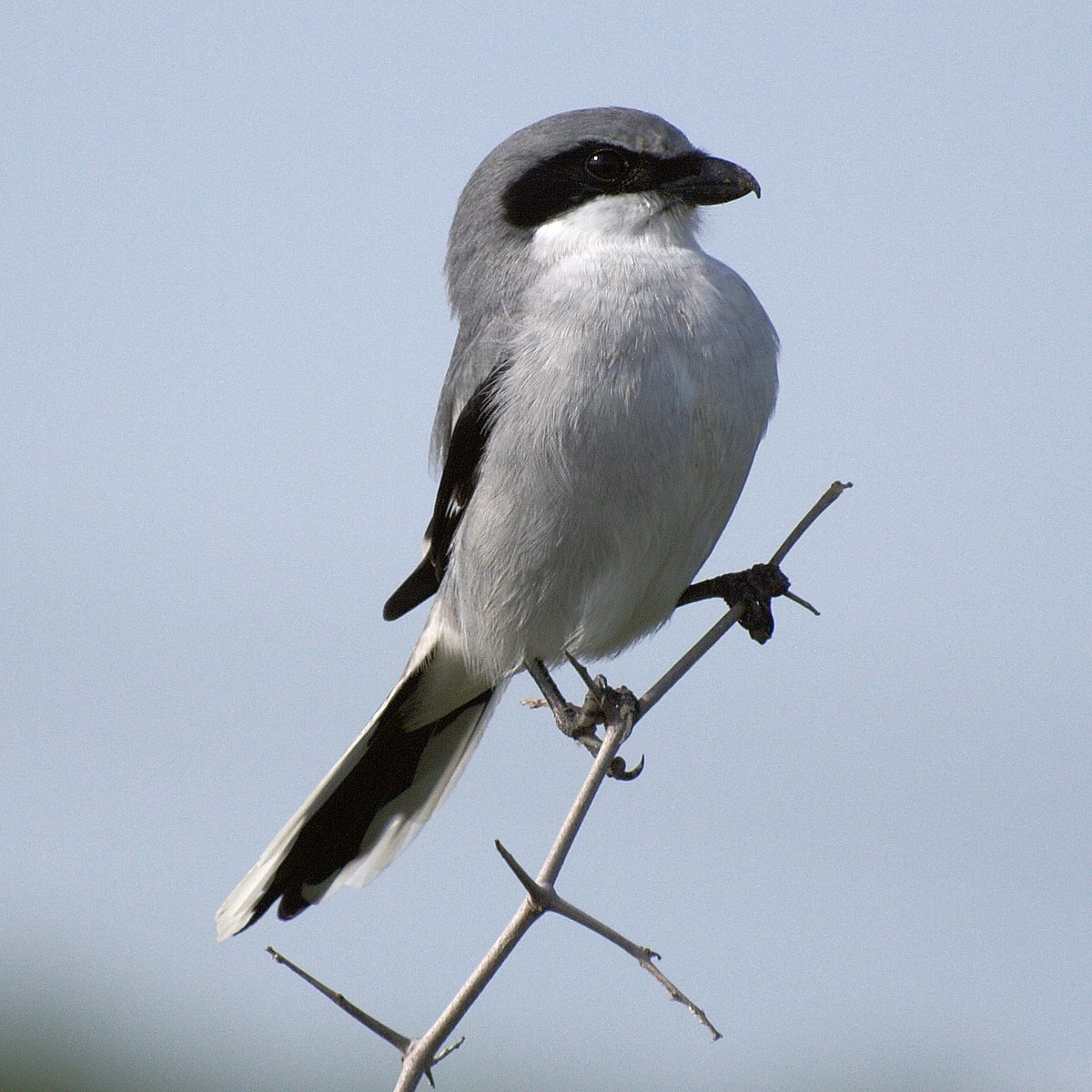
Wikipedia: Loggerhead shrike Source: OTHER
1200px-Lanius_ludovicianus_-Texas_-USA-8-4c.jpg
![]() The loggerhead shrike (Lanius ludovicianus) is a passerine bird in the family Laniidae. It is one of two members of the shrike family endemic to North America; the related northern shrike (L. borealis) occurs north of its range. It is nicknamed the butcherbird after its carnivorous tendencies, as it consumes prey such as amphibians, insects, lizards, small mammals and small birds, and some prey end up displayed and stored at a site, for example in a tree.[2] Due to its small size and weak talons, this predatory bird relies on impaling its prey upon thorns or barbed wire for facilitated consumption.[3] The numbers of loggerhead shrike have significantly decreased in recent years, especially in Midwestern, New England and Mid-Atlantic areas.[4]
[more]
The loggerhead shrike (Lanius ludovicianus) is a passerine bird in the family Laniidae. It is one of two members of the shrike family endemic to North America; the related northern shrike (L. borealis) occurs north of its range. It is nicknamed the butcherbird after its carnivorous tendencies, as it consumes prey such as amphibians, insects, lizards, small mammals and small birds, and some prey end up displayed and stored at a site, for example in a tree.[2] Due to its small size and weak talons, this predatory bird relies on impaling its prey upon thorns or barbed wire for facilitated consumption.[3] The numbers of loggerhead shrike have significantly decreased in recent years, especially in Midwestern, New England and Mid-Atlantic areas.[4]
[more]

Wikipedia: Green jay Source: OTHER
Cyanocorax_luxuosus_calling.jpg
![]() The green jay (Cyanocorax luxuosus) is a species of the New World jays, and is found in Central America. Adults are about 27 cm (11 in) long and variable in colour across their range; they usually have blue and black heads, green wings and mantle, bluish-green tails, black bills, yellow or brown eye rings, and dark legs. The basic diet consists of arthropods, vertebrates, seeds, and fruit. The nest is usually built in a thorny bush; the female incubates the clutch of three to five eggs. This is a common species of jay with a wide range and the International Union for Conservation of Nature has rated its conservation status as being of "least concern".
[more]
The green jay (Cyanocorax luxuosus) is a species of the New World jays, and is found in Central America. Adults are about 27 cm (11 in) long and variable in colour across their range; they usually have blue and black heads, green wings and mantle, bluish-green tails, black bills, yellow or brown eye rings, and dark legs. The basic diet consists of arthropods, vertebrates, seeds, and fruit. The nest is usually built in a thorny bush; the female incubates the clutch of three to five eggs. This is a common species of jay with a wide range and the International Union for Conservation of Nature has rated its conservation status as being of "least concern".
[more]
Arenal feeder 2 brown jays. 2018-02-27 13.24.36 Costa Rica
First observed in Costa Rica on 2018-02-27.
![]() The brown jay (Psilorhinus morio) is a large American jay which has the habitus of a magpie, but is slightly smaller and with a shorter tail, though the bill is larger.
[more]
The brown jay (Psilorhinus morio) is a large American jay which has the habitus of a magpie, but is slightly smaller and with a shorter tail, though the bill is larger.
[more]
Profile Wikipedia eBird Xeno-Canto
Yucatan jay at Casa San Diego in Tulum. 2023-03-29 16.38.32 Yucatan
First observed in Yucatan on 2023-03-29.
Endemic
Profile Wikipedia eBird Xeno-Canto
Rufous-browed peppershrike in garden at Izamal. 2023-04-12 07.19.10 Yucatan
First observed in Yucatan on 2023-04-12.
General: ![]() The rufous-browed peppershrike (Cyclarhis gujanensis) is a passerine bird in the vireo family. It is widespread and often common in woodland, forest edge, and cultivation with some tall trees from Mexico and Trinidad south to Argentina and Uruguay.
[more]
The rufous-browed peppershrike (Cyclarhis gujanensis) is a passerine bird in the vireo family. It is widespread and often common in woodland, forest edge, and cultivation with some tall trees from Mexico and Trinidad south to Argentina and Uruguay.
[more]
Profile Wikipedia eBird Audubon AllAboutBirds Xeno-Canto

Wikipedia: Yellow-throated vireo Source: OTHER
1200px-Vireo-flavifrons-001.jpg
![]() The yellow-throated vireo (Vireo flavifrons) is a small American songbird.
[more]
The yellow-throated vireo (Vireo flavifrons) is a small American songbird.
[more]
Profile Wikipedia eBird Audubon AllAboutBirds Xeno-Canto

Wikipedia: Warbling vireo Source: OTHER
WarblingVireo08.jpg
![]() The warbling vireo (Vireo gilvus) is a small North American songbird.
[more]
The warbling vireo (Vireo gilvus) is a small North American songbird.
[more]
Profile Wikipedia eBird Audubon AllAboutBirds Xeno-Canto

Wikipedia: Red-eyed vireo Source: OTHER
1200px-Vireo_olivaceus_-Madison_-Wisconsin_-USA-8.jpg
First observed in Cockeysville on 2021-06-13.
![]() The red-eyed vireo (Vireo olivaceus) is a small American songbird. It is somewhat warbler-like but not closely related to the New World warblers (Parulidae). Common across its vast range, this species is not considered threatened by the IUCN.
[more]
The red-eyed vireo (Vireo olivaceus) is a small American songbird. It is somewhat warbler-like but not closely related to the New World warblers (Parulidae). Common across its vast range, this species is not considered threatened by the IUCN.
[more]
Song:
Automatically generated from Xeno-Canto recording
Song attributes:
Frequency:
♫ Source: BirdNet
20210615_182200 birdnet 1658 - Red-eyed Vireo, two-part song - Red-eyed Vireo - Cockeysville.mp3
2021-06-15 18.22.00 Cockeysville (song)
Call:
Automatically generated from Xeno-Canto recording
♫ Supposedly red eyed vireo at ncr trail, did not see. 2021-06-15 12.23.30 Maryland (song?)

Wikipedia: Philadelphia vireo Source: OTHER
Vireo_philadelphicus.jpg
![]() The Philadelphia vireo (Vireo philadelphicus) is a small North American songbird in the vireo family (Vireonidae). "Vireo" is a Latin word referring to a green migratory bird, perhaps the female golden oriole, possibly the European greenfinch. The specific philadelphicus is for the city of Philadelphia.[2][3]
[more]
The Philadelphia vireo (Vireo philadelphicus) is a small North American songbird in the vireo family (Vireonidae). "Vireo" is a Latin word referring to a green migratory bird, perhaps the female golden oriole, possibly the European greenfinch. The specific philadelphicus is for the city of Philadelphia.[2][3]
[more]
Profile Wikipedia eBird Audubon AllAboutBirds Xeno-Canto
White-eyed vireo. 2022-05-01 09.22.26 Maryland
First observed in Cockeysville on 2022-05-01.
![]() The white-eyed vireo (Vireo griseus) is a small songbird. It breeds in the southeastern United States from New Jersey west to northern Missouri and south to Texas and Florida, and also in eastern Mexico, northern Central America, Cuba and the Bahamas.
[more]
The white-eyed vireo (Vireo griseus) is a small songbird. It breeds in the southeastern United States from New Jersey west to northern Missouri and south to Texas and Florida, and also in eastern Mexico, northern Central America, Cuba and the Bahamas.
[more]
Call:
Automatically generated from Xeno-Canto recording
♫ Source: BirdNet
20220501_092806 birdnet - White-eyed Vireo - 2022-05-01 09:28:06 - White-eyed Vireo - Cockeysville.mp3
2022-05-01 09.28.06 Cockeysville (song?)

Wikipedia: Bell's vireo Source: OTHER
1200px-Bell%27s_Vireo.jpg
![]() Bell's vireo (Vireo bellii)[2] is a songbird that migrates between a breeding range in North America and a winter range in the Neotropics. It is dull olive-gray above and whitish below. It has a faint white eye ring and faint wing bars.
[more]
Bell's vireo (Vireo bellii)[2] is a songbird that migrates between a breeding range in North America and a winter range in the Neotropics. It is dull olive-gray above and whitish below. It has a faint white eye ring and faint wing bars.
[more]
Profile Wikipedia eBird Audubon AllAboutBirds Xeno-Canto
MerlinBirdID says yellow-green vireo, one of the many yellow birds, Ecotucan, Bacalar. 2023-03-31 07.37.58 Yucatan
First observed in Yucatan on 2023-03-31.
![]() The yellow-green vireo (Vireo flavoviridis) is a small American passerine bird. It is migratory breeding from Mexico to Panama and wintering in the northern and eastern Andes and the western Amazon Basin.
[more]
The yellow-green vireo (Vireo flavoviridis) is a small American passerine bird. It is migratory breeding from Mexico to Panama and wintering in the northern and eastern Andes and the western Amazon Basin.
[more]
Profile Wikipedia eBird Xeno-Canto

Wikipedia: Mangrove vireo Source: OTHER
1200px-Vireo_pallens.jpg
![]() The mangrove vireo (Vireo pallens) is a species of bird in the family Vireonidae.
[more]
The mangrove vireo (Vireo pallens) is a species of bird in the family Vireonidae.
[more]
Profile Wikipedia eBird Xeno-Canto

Wikipedia: Cozumel vireo Source: OTHER
1200px-Naturalis_Biodiversity_Center_-_RMNH.AVES.148605_1_-_Vireo_bairdi_Ridgway%2C_1885_-_Vireonidae_-_bird_skin_specimen.jpeg
Endemic (country/region)

Wikipedia: Yucatan vireo Source: OTHER
1200px-Yucatan_Vireo_%286842666740%29.jpg

Wikipedia: Green shrike-vireo Source: OTHER
1200px-Vireolanius_pulchellus_-Panama-8a.jpg
Panama
General: ![]() The green shrike-vireo (Vireolanius pulchellus) is a species of bird in the family Vireonidae. It is found in Belize, Colombia, Costa Rica, El Salvador, Guatemala, Honduras, Mexico, Nicaragua, and Panama. Its natural habitat is subtropical or tropical moist lowland forests.
[more]
The green shrike-vireo (Vireolanius pulchellus) is a species of bird in the family Vireonidae. It is found in Belize, Colombia, Costa Rica, El Salvador, Guatemala, Honduras, Mexico, Nicaragua, and Panama. Its natural habitat is subtropical or tropical moist lowland forests.
[more]

Wikipedia: Tawny-crowned greenlet Source: OTHER
1200px-Hylophilus_ochraceiceps_-NBII_Image_Gallery-a00166.jpg
![]() The tawny-crowned greenlet (Tunchiornis ochraceiceps) is a species of bird in the family Vireonidae. It is found in Belize, Bolivia, Brazil, Colombia, Costa Rica, Ecuador, French Guiana, Guatemala, Guyana, Honduras, Mexico, Nicaragua, Panama, Peru, Suriname, and Venezuela. Its natural habitat is subtropical or tropical moist lowland forest. It is monotypic in the genus Tunchiornis.
[more]
The tawny-crowned greenlet (Tunchiornis ochraceiceps) is a species of bird in the family Vireonidae. It is found in Belize, Bolivia, Brazil, Colombia, Costa Rica, Ecuador, French Guiana, Guatemala, Guyana, Honduras, Mexico, Nicaragua, Panama, Peru, Suriname, and Venezuela. Its natural habitat is subtropical or tropical moist lowland forest. It is monotypic in the genus Tunchiornis.
[more]
Crimson-collared tanager / Flammentangare (Ramphocelus sanguinolentus)
Profile Wikipedia eBird Xeno-Canto
Crimson collared tanager. 2018-02-26 10.49.32 Costa Rica
First observed in Costa Rica on 2018-02-26.
![]() The crimson-collared tanager (Ramphocelus sanguinolentus) is a rather small Middle American songbird. It was first described by the French naturalist René-Primevère Lesson in 1831, its specific epithet from the Latin adjective sanguinolentus, "bloodied", referring to its red plumage.
[more]
The crimson-collared tanager (Ramphocelus sanguinolentus) is a rather small Middle American songbird. It was first described by the French naturalist René-Primevère Lesson in 1831, its specific epithet from the Latin adjective sanguinolentus, "bloodied", referring to its red plumage.
[more]
Summer tanager (Piranga rubra)
Profile Wikipedia eBird A-Z Animals Audubon AllAboutBirds Xeno-Canto
Arenal feeder summer tanager tenatative ID. 2018-02-27 12.58.26 Costa Rica
First observed in Costa Rica on 2018-02-27.
![]() The summer tanager (Piranga rubra) is a medium-sized American songbird. Formerly placed in the tanager family (Thraupidae), it and other members of its genus are now classified in the cardinal family (Cardinalidae).[2] The species's plumage and vocalizations are similar to other members of the cardinal family.
[more]
The summer tanager (Piranga rubra) is a medium-sized American songbird. Formerly placed in the tanager family (Thraupidae), it and other members of its genus are now classified in the cardinal family (Cardinalidae).[2] The species's plumage and vocalizations are similar to other members of the cardinal family.
[more]
Scarlet tanager (Piranga olivacea)
Profile Wikipedia eBird Audubon AllAboutBirds Xeno-Canto
Scarlet tanager. 2022-05-07 17.51.00 Maryland
First observed in Maryland on 2022-05-07.
![]() The scarlet tanager (Piranga olivacea) is a medium-sized American songbird. Until recently, it was placed in the tanager family (Thraupidae), but it and other members of its genus are now classified as belonging to the cardinal family (Cardinalidae).[2] The species' plumage and vocalizations are similar to other members of the cardinal family, although the Piranga species lacks the thick conical bill (well suited to seed and insect eating) that many cardinals possess. The species resides in thick deciduous woodlands and suburbs.
[more]
The scarlet tanager (Piranga olivacea) is a medium-sized American songbird. Until recently, it was placed in the tanager family (Thraupidae), but it and other members of its genus are now classified as belonging to the cardinal family (Cardinalidae).[2] The species' plumage and vocalizations are similar to other members of the cardinal family, although the Piranga species lacks the thick conical bill (well suited to seed and insect eating) that many cardinals possess. The species resides in thick deciduous woodlands and suburbs.
[more]
Flame-colored tanager (Piranga bidentata)
Profile Wikipedia eBird Audubon AllAboutBirds Xeno-Canto

Wikipedia: Flame-colored tanager Source: OTHER
1200px-Flame-colored_Tanager_2.jpg
![]() The flame-colored tanager (Piranga bidentata), formerly known as the stripe-backed tanager, is a medium-sized American songbird. Formerly placed in the tanager family Thraupidae, other members of its genus and it are now classified in the cardinal family Cardinalidae.[2][3] The species's plumage and vocalizations are similar to other members of the cardinal family.
[more]
The flame-colored tanager (Piranga bidentata), formerly known as the stripe-backed tanager, is a medium-sized American songbird. Formerly placed in the tanager family Thraupidae, other members of its genus and it are now classified in the cardinal family Cardinalidae.[2][3] The species's plumage and vocalizations are similar to other members of the cardinal family.
[more]
Rose-throated tanager (Piranga roseogularis)
Profile Wikipedia eBird Xeno-Canto

Wikipedia: Rose-throated tanager Source: OTHER
1200px-Piranga_roseogularis_64951842.jpg
Endemic
Green honeycreeper (Chlorophanes spiza)
Profile Wikipedia eBird Xeno-Canto

Wikipedia: Green honeycreeper Source: OTHER
1200px-Green_honey_creeper_%28Chlorophanes_spiza_spiza%29_male.jpg
General: ![]() The green honeycreeper (Chlorophanes spiza) is a small bird in the tanager family. It is found in the tropical New World from southern Mexico south to Brazil, and on Trinidad. It is the only member of the genus Chlorophanes.
[more]
The green honeycreeper (Chlorophanes spiza) is a small bird in the tanager family. It is found in the tropical New World from southern Mexico south to Brazil, and on Trinidad. It is the only member of the genus Chlorophanes.
[more]
Gray-headed tanager (Eucometis penicillata)
Profile Wikipedia eBird Xeno-Canto

Wikipedia: Gray-headed tanager Source: OTHER
1200px-Eucometis_penicillata_-Manizales%2C_Caldas%2C_Colombia-8.jpg
![]() The grey-headed tanager (Eucometis penicillata) is a widely distributed species of small Neotropical bird in the tanager family Thraupidae. It is the only member of the genus Eucometis.
[more]
The grey-headed tanager (Eucometis penicillata) is a widely distributed species of small Neotropical bird in the tanager family Thraupidae. It is the only member of the genus Eucometis.
[more]
Red-crowned ant-tanager (Habia rubica)
Profile Wikipedia eBird Xeno-Canto

Wikipedia: Red-crowned ant-tanager Source: OTHER
1200px-Habia_rubica_-_Red-crowned_Ant-Tanager_%28male%29.JPG
![]() The red-crowned ant tanager (Habia rubica) is a medium-sized passerine bird from tropical America. The genus Habia was long placed with the tanagers (Thraupidae), but it is actually closer to the cardinals (Cardinalidae). Consequently, it can be argued that referring to the members of this genus as ant-tanagers is misleading, but no other common name has gained usage.
[more]
The red-crowned ant tanager (Habia rubica) is a medium-sized passerine bird from tropical America. The genus Habia was long placed with the tanagers (Thraupidae), but it is actually closer to the cardinals (Cardinalidae). Consequently, it can be argued that referring to the members of this genus as ant-tanagers is misleading, but no other common name has gained usage.
[more]
Red-throated ant-tanager (Habia fuscicauda)
Profile Wikipedia eBird Xeno-Canto
Red throated ant tanager maybe. 2020-02-19 07.46.46 Panama
First observed in Panama on 2020-02-19.
![]() The red-throated ant tanager (Habia fuscicauda) is a medium-sized passerine bird. This species is a resident breeder on the Caribbean slopes from southeastern Mexico to eastern Panama. It was usually considered an aberrant kind of tanager and placed in the Thraupidae, but is actually closer to the cardinals (Cardinalidae). Consequently, it can be argued that referring to the members of this genus as ant tanagers is misleading, but no other common name has gained usage.
[more]
The red-throated ant tanager (Habia fuscicauda) is a medium-sized passerine bird. This species is a resident breeder on the Caribbean slopes from southeastern Mexico to eastern Panama. It was usually considered an aberrant kind of tanager and placed in the Thraupidae, but is actually closer to the cardinals (Cardinalidae). Consequently, it can be argued that referring to the members of this genus as ant tanagers is misleading, but no other common name has gained usage.
[more]
Black-throated shrike-tanager (Lanio aurantius)
Profile Wikipedia eBird Xeno-Canto

Wikipedia: Black-throated shrike-tanager Source: OTHER
1200px-Black-throated_Shrike-Tanager%2C_Lanio_aurantius_%28cropped%29.jpg
Western spindalis (Spindalis zena)
Profile Wikipedia eBird Audubon AllAboutBirds Xeno-Canto

Wikipedia: Western spindalis Source: OTHER
1200px-Western_spindalis_%28Spindalis_zena_pretrei%29_male.JPG
General: ![]() The western spindalis (Spindalis zena) is a songbird species. It was formerly considered conspecific with the other three species of spindalis, with the common name stripe-headed tanager.
[more]
The western spindalis (Spindalis zena) is a songbird species. It was formerly considered conspecific with the other three species of spindalis, with the common name stripe-headed tanager.
[more]
Bananaquit (Coereba flaveola)
Profile Wikipedia eBird Xeno-Canto
Possibly a bananaquit at the botanical garden, Puerto Morelos. 2023-03-27 11.43.00 Yucatan
First observed in Yucatan on 2023-03-27.
![]() The bananaquit (Coereba flaveola) is a species of passerine bird in the tanager family Thraupidae. Before the development of molecular genetics in the 21st century, its relationship to other species was uncertain and it was either placed with the buntings and New World sparrows in the family Emberizidae, with New World warblers in the family Parulidae or in its own monotypic family Coerebidae. This small, active nectarivore is found in warmer parts of the Americas, and is generally common.
[more]
The bananaquit (Coereba flaveola) is a species of passerine bird in the tanager family Thraupidae. Before the development of molecular genetics in the 21st century, its relationship to other species was uncertain and it was either placed with the buntings and New World sparrows in the family Emberizidae, with New World warblers in the family Parulidae or in its own monotypic family Coerebidae. This small, active nectarivore is found in warmer parts of the Americas, and is generally common.
[more]
Yellow-faced grassquit (Tiaris olivaceus)
MerlinBirdID says yellow-faced grassquit. 2023-04-01 09.25.10 Yucatan
First observed in Yucatan on 2023-04-01.
![]() The yellow-faced grassquit (Tiaris olivaceus) is a passerine bird in the tanager family Thraupidae and is the only member of the genus Tiaris. It is native to the Central America, South America, and the Caribbean.
[more]
The yellow-faced grassquit (Tiaris olivaceus) is a passerine bird in the tanager family Thraupidae and is the only member of the genus Tiaris. It is native to the Central America, South America, and the Caribbean.
[more]
Morelet's seedeater (Sporophila morelleti)
Profile Wikipedia eBird Audubon AllAboutBirds Xeno-Canto

Wikipedia: Morelet's seedeater Source: OTHER
Sporophila_torqueola.jpg
![]() Morelet's seedeater (Sporophila morelleti) is a passerine bird in the typical seedeater genus Sporophila.
[more]
Morelet's seedeater (Sporophila morelleti) is a passerine bird in the typical seedeater genus Sporophila.
[more]
Thick-billed seed-finch (Sporophila funerea)
Profile Wikipedia eBird Xeno-Canto

Wikipedia: Thick-billed seed-finch Source: OTHER
Thick-billed_Seed-Finch_-_Sarapiqui_-_Costa_Rica_MG_0887_%2826405624880%29.jpg
![]() The thick-billed seed finch (Sporophila funerea) is a species of bird in the family Thraupidae, but was until recently placed in Emberizidae. It is found widely in shrubby and grassy areas from southern Mexico, through Central America, to the Chocó in Colombia and Ecuador. It is replaced by the closely related chestnut-bellied seed finch in South America east of the Andes, as well as the valleys of Cauca and Magdalena in Colombia. The two have often been considered conspecific as the lesser seed-finch (Oryzoborus angolensis).
[more]
The thick-billed seed finch (Sporophila funerea) is a species of bird in the family Thraupidae, but was until recently placed in Emberizidae. It is found widely in shrubby and grassy areas from southern Mexico, through Central America, to the Chocó in Colombia and Ecuador. It is replaced by the closely related chestnut-bellied seed finch in South America east of the Andes, as well as the valleys of Cauca and Magdalena in Colombia. The two have often been considered conspecific as the lesser seed-finch (Oryzoborus angolensis).
[more]
Variable seedeater (Sporophila corvina)
Profile Wikipedia eBird Xeno-Canto

Wikipedia: Variable seedeater Source: OTHER
Sporophila-corvina-002.jpg
![]() The variable seedeater (Sporophila corvina) is a passerine bird which breeds from southern Mexico through Central America to the Chocó of northwestern South America. The taxonomy is confusing, and it was formerly considered a subspecies of Sporophila americana (see Taxonomy). Even within the variable seedeater as presently defined, there are great variations in plumage.
[more]
The variable seedeater (Sporophila corvina) is a passerine bird which breeds from southern Mexico through Central America to the Chocó of northwestern South America. The taxonomy is confusing, and it was formerly considered a subspecies of Sporophila americana (see Taxonomy). Even within the variable seedeater as presently defined, there are great variations in plumage.
[more]
Blue-black grassquit (Volatinia jacarina)

Wikipedia: Blue-black grassquit Source: OTHER
Tiziu.jpg
![]() Tanagra jacarina Linnaeus, 1766
[more]
Tanagra jacarina Linnaeus, 1766
[more]
Grassland yellow-finch (Sicalis luteola)
Profile Wikipedia eBird Xeno-Canto

Wikipedia: Grassland yellow-finch Source: OTHER
1200px-Sicalis_luteola.jpg
![]() The grassland yellow finch (Sicalis luteola) is a small passerine bird. Despite its name, it is not a finch, but is a seedeater. These were formerly united with the buntings and American sparrows in the Emberizidae, but are now known to be tanagers.
[more]
The grassland yellow finch (Sicalis luteola) is a small passerine bird. Despite its name, it is not a finch, but is a seedeater. These were formerly united with the buntings and American sparrows in the Emberizidae, but are now known to be tanagers.
[more]

Wikipedia: Grayish saltator Source: OTHER
1200px-Grausaltator_.jpg
![]() The greyish saltator (Saltator coerulescens) is a passerine bird in the tanager family Thraupidae that is widespread in the tropical Americas. In El Salvador, it is well known as dichosofui after the "elaborate" version of its call, which sounds like a drawn-out ¡dichoso fui!, Spanish for "I was happy!"
[more]
The greyish saltator (Saltator coerulescens) is a passerine bird in the tanager family Thraupidae that is widespread in the tropical Americas. In El Salvador, it is well known as dichosofui after the "elaborate" version of its call, which sounds like a drawn-out ¡dichoso fui!, Spanish for "I was happy!"
[more]
Profile Wikipedia eBird Xeno-Canto
Black-headed saltator. 2023-04-17 13.29.26 Yucatan
First observed in Yucatan on 2023-04-01.
![]() The black-headed saltator (Saltator atriceps) is a seed-eating bird in the tanager family Thraupidae. It breeds from central Mexico to eastern Panama.
[more]
The black-headed saltator (Saltator atriceps) is a seed-eating bird in the tanager family Thraupidae. It breeds from central Mexico to eastern Panama.
[more]
Profile Wikipedia eBird Xeno-Canto

Wikipedia: Buff-throated saltator Source: OTHER
1200px-Buff-throated_Saltator.jpg
![]() The buff-throated saltator (Saltator maximus) is a seed-eating bird in the tanager family Thraupidae. It breeds from southeastern Mexico to western Ecuador and northeastern Brazil.
[more]
The buff-throated saltator (Saltator maximus) is a seed-eating bird in the tanager family Thraupidae. It breeds from southeastern Mexico to western Ecuador and northeastern Brazil.
[more]
Profile Wikipedia eBird Xeno-Canto
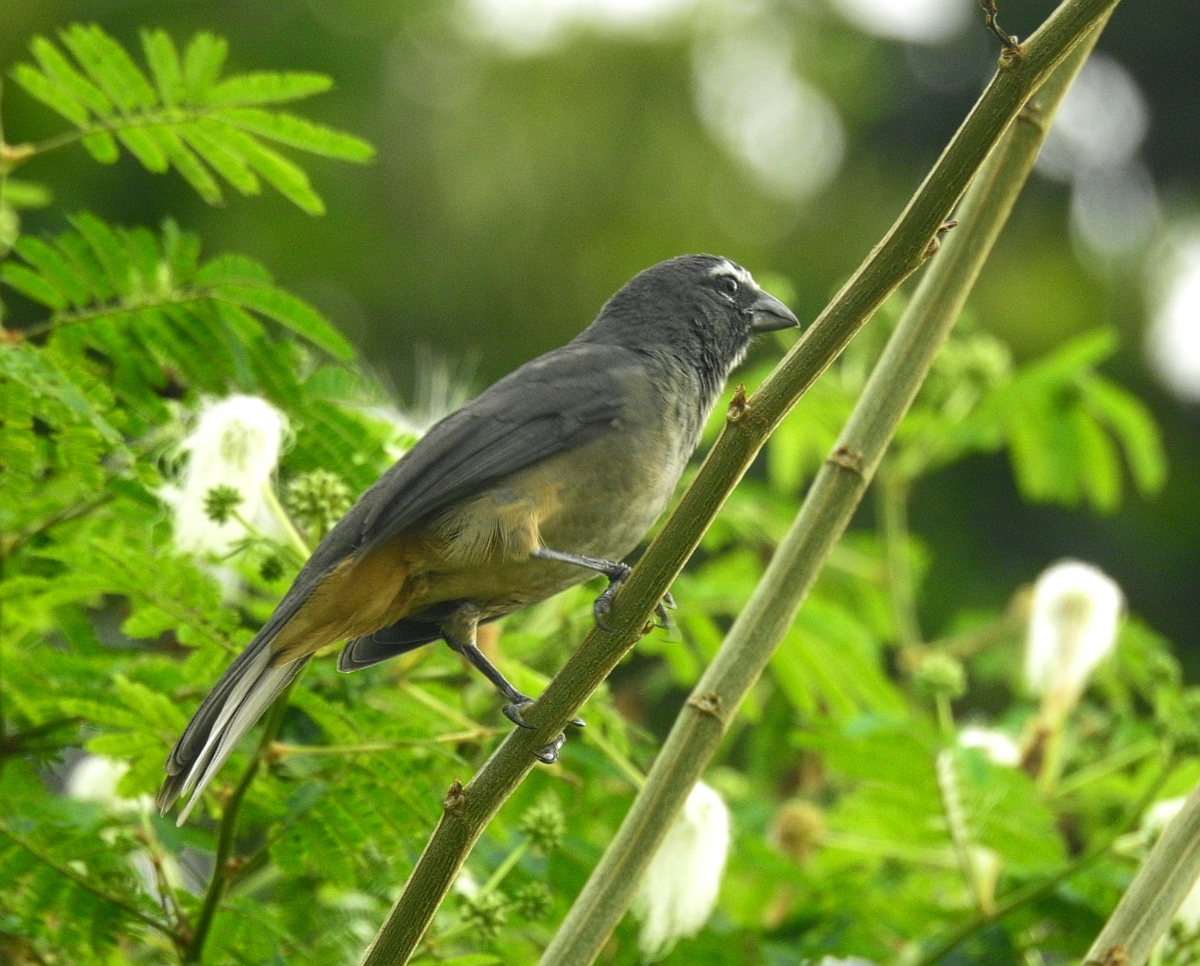
Wikipedia: Cinnamon-bellied saltator Source: OTHER
Costa_Rica_DSCN5726-new_%2831129668435%29.jpg
Blue gray tanager. 2020-02-18 09.21.16 Panama
First observed in Costa Rica on 2018-02-27.
We saw this on the grounds of Gamboa Rainforest Resort.
General: ![]() The blue-gray tanager (Thraupis episcopus) is a medium-sized South American songbird of the tanager family, Thraupidae. Its range is from Mexico south to northeast Bolivia and northern Brazil, all of the Amazon Basin, except the very south. It has been introduced to Lima (Peru). On Trinidad and Tobago, this bird is called blue jean.
[more]
The blue-gray tanager (Thraupis episcopus) is a medium-sized South American songbird of the tanager family, Thraupidae. Its range is from Mexico south to northeast Bolivia and northern Brazil, all of the Amazon Basin, except the very south. It has been introduced to Lima (Peru). On Trinidad and Tobago, this bird is called blue jean.
[more]
Zoom one golden-hooded tanager on telephone wire. 2020-02-18 10.52.28
First observed in Costa Rica on 2018-02-27.
We saw this on a nature tour on the grounds of Gamboa Rainforest Resort. I noted it as a honeycreeper, which it is not - not sure if my mistake or the guide's.
General: ![]() The golden-hooded tanager (Stilpnia larvata) is a medium-sized passerine bird. This tanager is a resident breeder from southern Mexico south to western Ecuador.
[more]
The golden-hooded tanager (Stilpnia larvata) is a medium-sized passerine bird. This tanager is a resident breeder from southern Mexico south to western Ecuador.
[more]
Wikipedia: Yellow-winged tanager Source: OTHER
Yellow_Winged_Tanager.JPG
![]() The yellow-winged tanager (Thraupis abbas) is a neotropical member of the tanager family. It is of average size for a tanager, about 18 centimetres (7 inches long). It is distinguished by the yellow patches on its dusky green wings, marking an otherwise dark bluish and gray body. It has a pale lavender tone on its throat and breast. The juvenile lacks this color, but has an olive-green head and upper back.
[more]
The yellow-winged tanager (Thraupis abbas) is a neotropical member of the tanager family. It is of average size for a tanager, about 18 centimetres (7 inches long). It is distinguished by the yellow patches on its dusky green wings, marking an otherwise dark bluish and gray body. It has a pale lavender tone on its throat and breast. The juvenile lacks this color, but has an olive-green head and upper back.
[more]
Swamp sparrow (Melospiza georgiana)
Profile Wikipedia eBird Audubon AllAboutBirds Xeno-Canto

Wikipedia: Swamp sparrow Source: OTHER
1200px-Melospiza_georgiana_MN1.jpg
![]() The swamp sparrow (Melospiza georgiana) is a medium-sized New World sparrow related to the song sparrow.
[more]
The swamp sparrow (Melospiza georgiana) is a medium-sized New World sparrow related to the song sparrow.
[more]
Lincoln's sparrow / Lincoln-Ammer (Melospiza lincolnii)
Profile Wikipedia eBird Audubon AllAboutBirds Xeno-Canto

Wikipedia: Lincoln's sparrow Source: OTHER
1200px-Lincoln%27s_Sparrow_at_bird_feeder.jpg
![]() Lincoln's sparrow (Melospiza lincolnii) is a small sparrow native to North America. It is a less common passerine bird that often stays hidden under thick ground cover, but can be distinguished by its sweet, wrenlike song. Lincoln's sparrow is one of three species in the genus Melospiza which also includes the song sparrow (M. melodia) and the swamp sparrow (M. georgiana). It lives in well-covered brushy habitats, often near water. This bird is poorly documented because of its secretive nature and breeding habits solely in boreal regions.[2]
[more]
Lincoln's sparrow (Melospiza lincolnii) is a small sparrow native to North America. It is a less common passerine bird that often stays hidden under thick ground cover, but can be distinguished by its sweet, wrenlike song. Lincoln's sparrow is one of three species in the genus Melospiza which also includes the song sparrow (M. melodia) and the swamp sparrow (M. georgiana). It lives in well-covered brushy habitats, often near water. This bird is poorly documented because of its secretive nature and breeding habits solely in boreal regions.[2]
[more]
Grasshopper sparrow / Heuschreckenammer (Ammodramus savannarum)
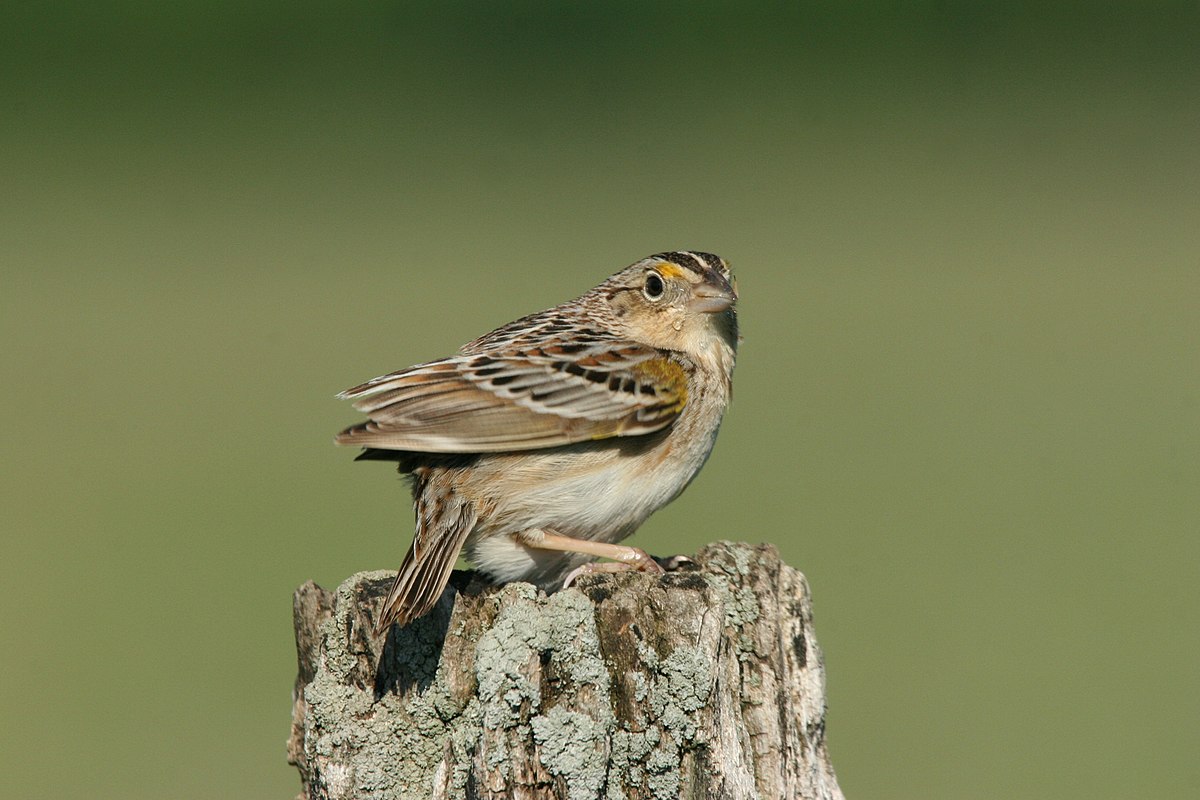
Wikipedia: Grasshopper sparrow Source: OTHER
1200px-Grasshopper_Sparrow.jpg
![]() The grasshopper sparrow (Ammodramus savannarum) is a small New World sparrow. The genus Ammodramus contains nine species that inhabit grasslands and prairies.
[more]
The grasshopper sparrow (Ammodramus savannarum) is a small New World sparrow. The genus Ammodramus contains nine species that inhabit grasslands and prairies.
[more]
Olive sparrow (Arremonops rufivirgatus)
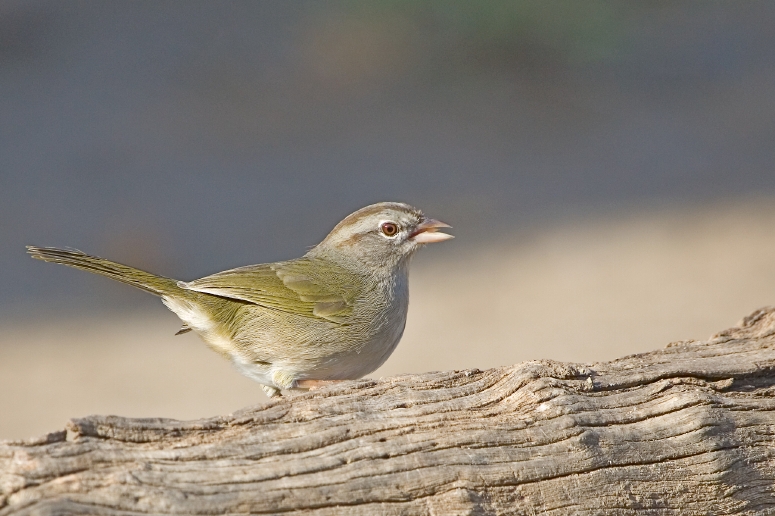
Wikipedia: Olive sparrow Source: OTHER
Arremonops_rufivirgatus.jpg
![]() The olive sparrow (Arremonops rufivirgatus) is a species of American sparrow in the family Passerellidae. (Other names include green finch and Texas sparrow.) Its range includes Belize, Costa Rica, Guatemala, Honduras, Mexico, Nicaragua and southern Texas (including the counties of Val Verde, Atascosa, and Nueces).
[more]
The olive sparrow (Arremonops rufivirgatus) is a species of American sparrow in the family Passerellidae. (Other names include green finch and Texas sparrow.) Its range includes Belize, Costa Rica, Guatemala, Honduras, Mexico, Nicaragua and southern Texas (including the counties of Val Verde, Atascosa, and Nueces).
[more]
Green-backed sparrow (Arremonops chloronotus)

Wikipedia: Green-backed sparrow Source: OTHER
1200px-Arremonops_chloronotus.jpg
Lark sparrow (Chondestes grammacus)
Profile Wikipedia eBird Audubon AllAboutBirds Xeno-Canto

Wikipedia: Lark sparrow Source: OTHER
LarkSparrow.jpg
General: ![]() The lark sparrow (Chondestes grammacus) is a fairly large New World sparrow. It is the only member of the genus Chondestes.
[more]
The lark sparrow (Chondestes grammacus) is a fairly large New World sparrow. It is the only member of the genus Chondestes.
[more]
Savannah sparrow (Passerculus sandwichensis)

Wikipedia: Savannah sparrow Source: OTHER
1200px-Passerculus_sandwichensis_crop.jpg
![]() The Savannah sparrow (Passerculus sandwichensis) is a small New World sparrow. It was the only member of the genus Passerculus and is typically the only widely accepted member. Comparison of mtDNA NADH dehydrogenase subunit 2 and 3 sequences indicates that the Ipswich sparrow, formerly usually considered a valid species (as Passerculus princeps), is a well-marked subspecies of the Savannah sparrow, whereas the southwestern large-billed sparrow should be recognized as a distinct species (Passerculus rostratus).[2]
[more]
The Savannah sparrow (Passerculus sandwichensis) is a small New World sparrow. It was the only member of the genus Passerculus and is typically the only widely accepted member. Comparison of mtDNA NADH dehydrogenase subunit 2 and 3 sequences indicates that the Ipswich sparrow, formerly usually considered a valid species (as Passerculus princeps), is a well-marked subspecies of the Savannah sparrow, whereas the southwestern large-billed sparrow should be recognized as a distinct species (Passerculus rostratus).[2]
[more]
![]() Die Heermannmöwe (Larus heermanni) ist eine Vogelart innerhalb der Möwen (Larinae). Die mittelgroße Möwe brütet in wenigen Kolonien vor allem auf Inseln im Golf von Kalifornien. Die Bestände der monotypischen Art sind zurzeit stabil, auf Grund der wenigen und gefährdet erscheinenden Brutkolonien ist sie jedoch von der IUCN als NT (= Near Threatened, „Vorwarnliste“) eingestuft.[1] Benannt wurde die Art nach dem nordamerikanischen Arzt und Naturforscher Adolphus Lewis Heermann.
[more]
Die Heermannmöwe (Larus heermanni) ist eine Vogelart innerhalb der Möwen (Larinae). Die mittelgroße Möwe brütet in wenigen Kolonien vor allem auf Inseln im Golf von Kalifornien. Die Bestände der monotypischen Art sind zurzeit stabil, auf Grund der wenigen und gefährdet erscheinenden Brutkolonien ist sie jedoch von der IUCN als NT (= Near Threatened, „Vorwarnliste“) eingestuft.[1] Benannt wurde die Art nach dem nordamerikanischen Arzt und Naturforscher Adolphus Lewis Heermann.
[more]
Gull-billed tern / Lachseeschwalbe (Gelochelidon nilotica)
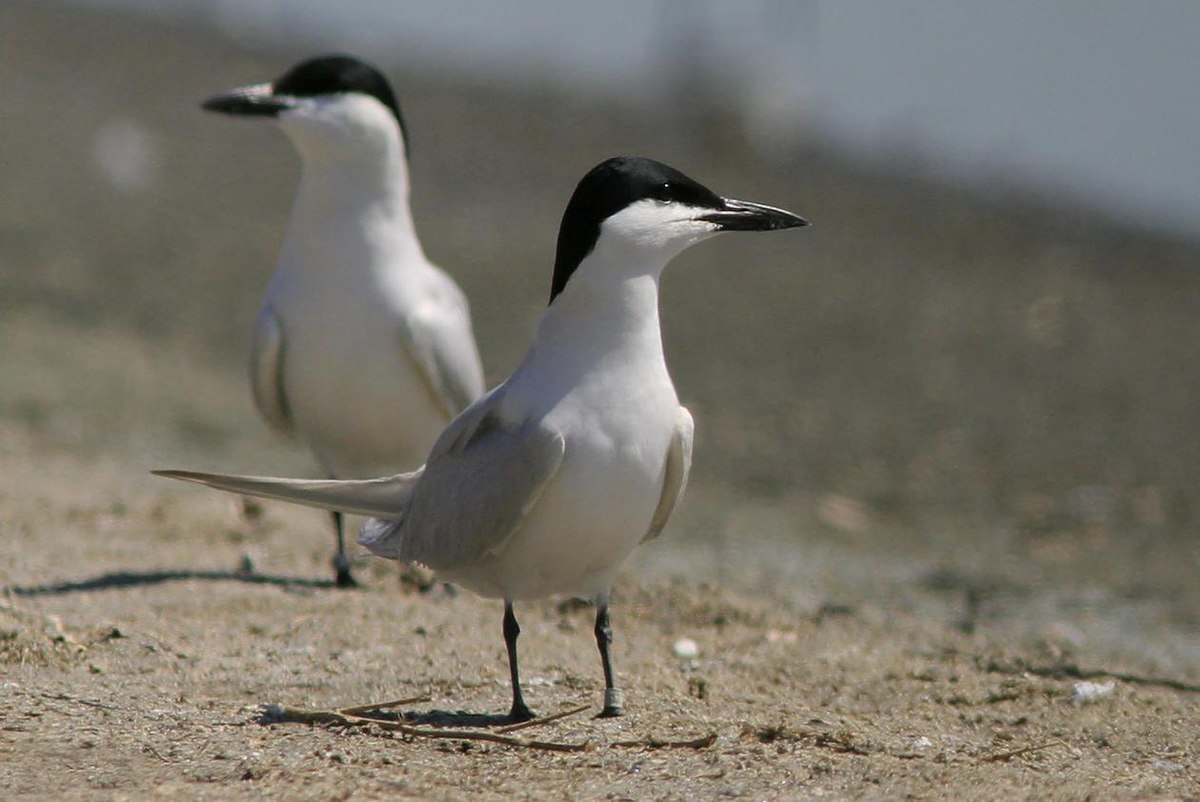
Wikipedia: Gull-billed tern Source: OTHER
1200px-Gelochelidon_nilotica_vanrossemi.jpg
This bird appears across the great seas in the following continents:
Europe, North America, South America, Africa, Asia.
![]() The gull-billed tern (Gelochelidon nilotica), formerly Sterna nilotica,[2] is a tern in the family Laridae. The genus name is from Ancient Greek gelao, "to laugh", and khelidon, "swallow". The specific niloticus is from Latin and means of the Nile.[3] The Australian gull-billed tern was previously considered a subspecies.
[more]
The gull-billed tern (Gelochelidon nilotica), formerly Sterna nilotica,[2] is a tern in the family Laridae. The genus name is from Ancient Greek gelao, "to laugh", and khelidon, "swallow". The specific niloticus is from Latin and means of the Nile.[3] The Australian gull-billed tern was previously considered a subspecies.
[more]
Black skimmer / Schwarzmantel-Scherenschnabel (Rynchops niger)
Profile Wikipedia eBird Xeno-Canto
Black skimmers near Las Coloradas. 2023-04-15 10.11.18 Yucatan
First observed in Yucatan on 2023-04-15.
This bird appears across the great seas in the following continents:
North America, South America, Africa.
![]() The black skimmer (Rynchops niger) is a tern-like seabird, one of three very similar birds species in the skimmer genus Rynchops in the gull family Laridae. It breeds in North and South America. Northern populations winter in the warmer waters of the Caribbean and the tropical and subtropical Pacific coasts, but the South American races make only shorter movements in response to annual floods which extend their feeding areas in the river shallows.
[more]
The black skimmer (Rynchops niger) is a tern-like seabird, one of three very similar birds species in the skimmer genus Rynchops in the gull family Laridae. It breeds in North and South America. Northern populations winter in the warmer waters of the Caribbean and the tropical and subtropical Pacific coasts, but the South American races make only shorter movements in response to annual floods which extend their feeding areas in the river shallows.
[more]
Black tern / Trauerseeschwalbe (Chlidonias niger)
Profile Wikipedia eBird Vogelwarte BirdLife ZH ornitho.ch Audubon AllAboutBirds Xeno-Canto BirdID NABU

Wikipedia: Black tern Source: OTHER
1200px-%C4%8Cor%C3%ADk_%C4%8Dierny_%28Chlidonias_niger%29_a_%284644831482%29.jpg
This bird appears across the great seas in the following continents:
Europe, North America, South America, Africa.
![]() The black tern (Chlidonias niger) is a small tern generally found in or near inland water in Europe, Western Asia and North America. As its name suggests, it has predominantly dark plumage. In some lights it can appear blue in the breeding season, hence the old English name "blue darr".[2] The genus name is from Ancient Greek khelidonios, "swallow-like", from khelidon, "swallow": another old English name for the black tern is "carr (i.e. lake) swallow".[3] The species name is from Latin niger "shining black".[4]
[more]
The black tern (Chlidonias niger) is a small tern generally found in or near inland water in Europe, Western Asia and North America. As its name suggests, it has predominantly dark plumage. In some lights it can appear blue in the breeding season, hence the old English name "blue darr".[2] The genus name is from Ancient Greek khelidonios, "swallow-like", from khelidon, "swallow": another old English name for the black tern is "carr (i.e. lake) swallow".[3] The species name is from Latin niger "shining black".[4]
[more]
Vocalization: ![]() Moderately vocal. [Link]
Moderately vocal. [Link]
Calls: ![]() Flight call a more or less clear "kleck, or a disyllabic "klee-ake" with accented first syllable. Sometimes slightly rolling "klirr-eke", but never as much as in White-winged Tern. Also a slightly harsher "kreek", but not as raspy as in Whiskered Tern. [Link]
Flight call a more or less clear "kleck, or a disyllabic "klee-ake" with accented first syllable. Sometimes slightly rolling "klirr-eke", but never as much as in White-winged Tern. Also a slightly harsher "kreek", but not as raspy as in Whiskered Tern. [Link]
Physical details: length=22-24 cm,
wingspan=64-68 cm,
weight=60-86 g
Habitats:
River and lake
Brown noddy / Noddi (Anous stolidus)

Wikipedia: Brown noddy Source: OTHER
1200px-Common_Noddy_1_-_Michaelmas.jpg
This bird appears across the great seas in the following continents:
North America, South America, Africa, Asia.
General: ![]() The brown noddy or common noddy (Anous stolidus) is a seabird in the family Laridae. The largest of the noddies, it can be told from the closely related black noddy by its larger size and plumage, which is dark brown rather than black. The brown noddy is a tropical seabird with a worldwide distribution, ranging from Hawaii to the Tuamotu Archipelago and Australia in the Pacific Ocean, from the Red Sea to the Seychelles and Australia in the Indian Ocean and in the Caribbean to Tristan da Cunha in the Atlantic Ocean. The brown noddy is colonial, usually nesting on elevated situations on cliffs or in short trees or shrubs. It only occasionally nests on the ground. A single egg is laid by the female of a pair each breeding season. In India the brown noddy is protected in the PM Sayeed Marine Birds Conservation Reserve.[2]
[more]
The brown noddy or common noddy (Anous stolidus) is a seabird in the family Laridae. The largest of the noddies, it can be told from the closely related black noddy by its larger size and plumage, which is dark brown rather than black. The brown noddy is a tropical seabird with a worldwide distribution, ranging from Hawaii to the Tuamotu Archipelago and Australia in the Pacific Ocean, from the Red Sea to the Seychelles and Australia in the Indian Ocean and in the Caribbean to Tristan da Cunha in the Atlantic Ocean. The brown noddy is colonial, usually nesting on elevated situations on cliffs or in short trees or shrubs. It only occasionally nests on the ground. A single egg is laid by the female of a pair each breeding season. In India the brown noddy is protected in the PM Sayeed Marine Birds Conservation Reserve.[2]
[more]
Laughing gull / Aztekenmöwe (Leucophaeus atricilla)
Our gang - laughing gull, double-crested cormorants, brown pelicans - at Las Coloradas, Rio Lagartos. 2023-04-15 09.11.04 Yucatan
First observed in Yucatan on 2023-03-26.
This bird appears across the great seas in the following continents:
North America, South America, Australia.
vagrant
Caspian tern / Raubseeschwalbe (Hydroprogne caspia)

Wikipedia: Caspian tern Source: OTHER
1200px-Sterna-caspia-010.jpg
This bird appears across the great seas in the following continents:
Europe, North America, South America, Africa, Asia.
General: ![]() The Caspian tern (Hydroprogne caspia)[2] is a species of tern, with a subcosmopolitan but scattered distribution. Despite its extensive range, it is monotypic of its genus, and has no accepted subspecies.[3] The genus name is from Ancient Greek hudros, "water", and Latin progne, "swallow". The specific caspia is from Latin and, like the English name, refers to the Caspian Sea.[4]
[more]
The Caspian tern (Hydroprogne caspia)[2] is a species of tern, with a subcosmopolitan but scattered distribution. Despite its extensive range, it is monotypic of its genus, and has no accepted subspecies.[3] The genus name is from Ancient Greek hudros, "water", and Latin progne, "swallow". The specific caspia is from Latin and, like the English name, refers to the Caspian Sea.[4]
[more]
Calls: ![]() Easily recognized by its very harsh calls. Sometimes likened to the sound of a plate of steel being dragged across a concrete floor. Similar in harshness to Grey Heron, but more drawn, with an accented middle; "Kraaeeet", or with a double syllable start "ka-ha-kraaaeet". Immature birds begs with a penetrating, sharp whistle. [Link]
Easily recognized by its very harsh calls. Sometimes likened to the sound of a plate of steel being dragged across a concrete floor. Similar in harshness to Grey Heron, but more drawn, with an accented middle; "Kraaeeet", or with a double syllable start "ka-ha-kraaaeet". Immature birds begs with a penetrating, sharp whistle. [Link]
Physical details: length=47-54 cm,
wingspan=130-145 cm,
weight=500-750 g
Habitats:
River and lake
Sooty tern / Rußseeschwalbe (Onychoprion fuscatus)

Wikipedia: Sooty tern Source: OTHER
1200px-Sterna_fuscata.JPG
This bird appears across the great seas in the following continents:
North America, South America, Africa.
General: ![]() The sooty tern (Onychoprion fuscatus) is a seabird in the family Laridae. It is a bird of the tropical oceans which sleeps on the wing, returning to land only to breed on islands throughout the equatorial zone.
[more]
The sooty tern (Onychoprion fuscatus) is a seabird in the family Laridae. It is a bird of the tropical oceans which sleeps on the wing, returning to land only to breed on islands throughout the equatorial zone.
[more]
Bridled tern / Zügelseeschwalbe (Onychoprion anaethetus)
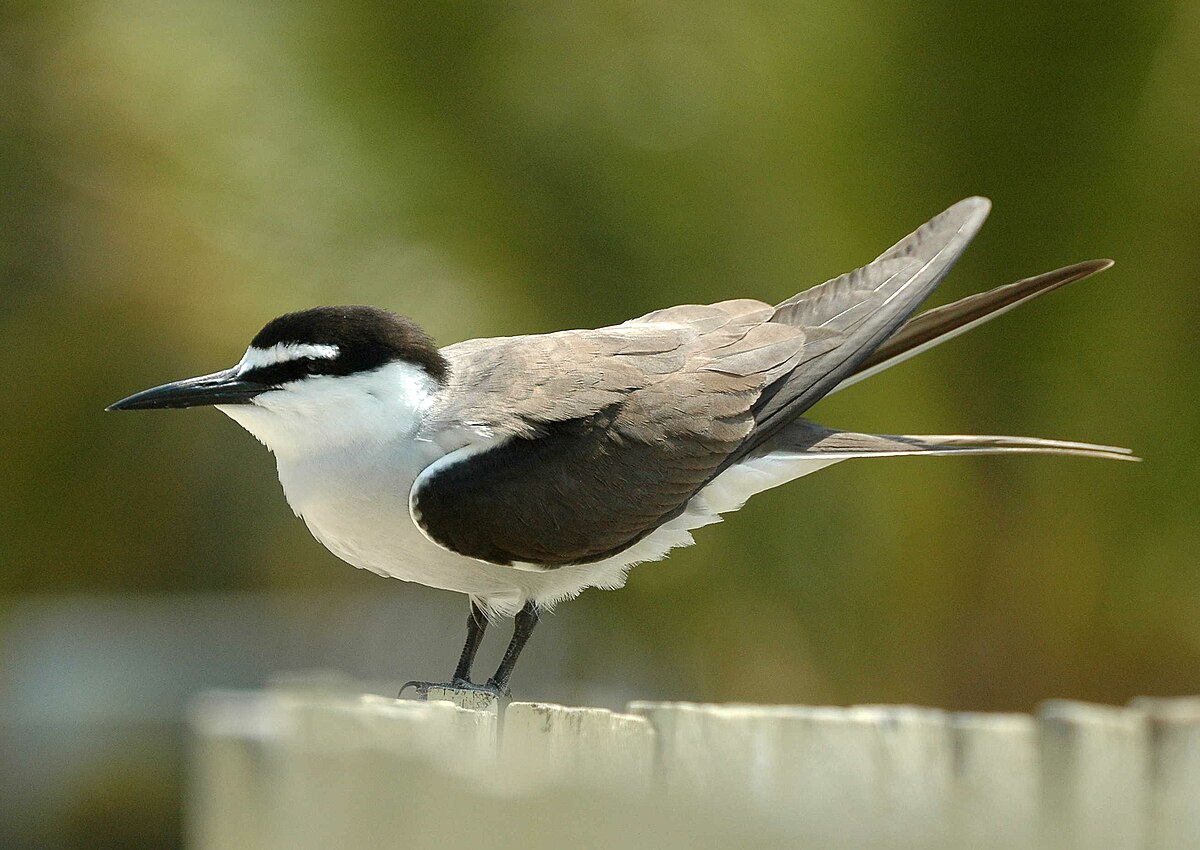
Wikipedia: Bridled tern Source: OTHER
1200px-Bridled_Tern_LEI_Nov06.JPG
This bird appears across the great seas in the following continents:
North America, South America, Africa, Asia.
![]() The bridled tern (Onychoprion anaethetus)[2] is a seabird of the family Laridae. It is a bird of the tropical oceans. The scientific name is from Ancient Greek. The genus comes from onux meaning "claw" or "nail", and prion, meaning "saw". The specific anaethetus means "senseless, stupid".[3]
[more]
The bridled tern (Onychoprion anaethetus)[2] is a seabird of the family Laridae. It is a bird of the tropical oceans. The scientific name is from Ancient Greek. The genus comes from onux meaning "claw" or "nail", and prion, meaning "saw". The specific anaethetus means "senseless, stupid".[3]
[more]
Least tern / Amerikanische Zwergseeschwalbe (Sternula antillarum)

Wikipedia: Least tern Source: OTHER
1200px-Least_Tern_%28Sternula_antillarum%29_RWD1.jpg
![]() The least tern (Sternula antillarum) is a species of tern that breeds in North America and locally in northern South America. It is closely related to, and was formerly often considered conspecific with, the little tern of the Old World. Other close relatives include the yellow-billed tern and Peruvian tern, both from South America.
[more]
The least tern (Sternula antillarum) is a species of tern that breeds in North America and locally in northern South America. It is closely related to, and was formerly often considered conspecific with, the little tern of the Old World. Other close relatives include the yellow-billed tern and Peruvian tern, both from South America.
[more]
Elegant tern (Thalasseus elegans)

Wikipedia: Elegant tern Source: OTHER
1200px-Elegant_Tern_Bolsa_Chica.jpg
This bird appears across the great seas in the following continents:
North America, South America, Africa.
![]() The elegant tern (Thalasseus elegans) is a tern in the family Laridae. It breeds on the Pacific coasts of the southern United States and Mexico and winters south to Peru, Ecuador and Chile.
[more]
The elegant tern (Thalasseus elegans) is a tern in the family Laridae. It breeds on the Pacific coasts of the southern United States and Mexico and winters south to Peru, Ecuador and Chile.
[more]
Sandwich tern / Brandseeschwalbe (Thalasseus sandvicensis)
Sandwich tern in flight with distinct yellow tipped bill. 2023-09-27 12.28.34 Florida
First observed in Costa Rica on 2018-03-11.
This bird appears across the great seas in the following continents:
Europe, North America, South America, Africa.
![]() The Sandwich tern (Thalasseus sandvicensis)[2] is a tern in the family Laridae. It is very closely related to the lesser crested tern (T. bengalensis), Chinese crested tern (T. bernsteini), Cabot's tern (T. acuflavidus), and elegant tern (T. elegans) and has been known to interbreed with the lesser crested. It breeds in the Palearctic from Europe to the Caspian Sea wintering to South Africa, India and Sri Lanka.
[more]
The Sandwich tern (Thalasseus sandvicensis)[2] is a tern in the family Laridae. It is very closely related to the lesser crested tern (T. bengalensis), Chinese crested tern (T. bernsteini), Cabot's tern (T. acuflavidus), and elegant tern (T. elegans) and has been known to interbreed with the lesser crested. It breeds in the Palearctic from Europe to the Caspian Sea wintering to South Africa, India and Sri Lanka.
[more]
Calls: ![]() Contact call a sharp and grating "keeree-eek". Often compared to the pressing of amalgam into a tooth. [Link]
Contact call a sharp and grating "keeree-eek". Often compared to the pressing of amalgam into a tooth. [Link]
Physical details: length=36-41 cm,
wingspan=95-105 cm,
weight=215-275 g
Habitats:
River and lake
Royal tern (Thalasseus maximus)

Wikipedia: Royal tern Source: OTHER
1200px-Royal_Tern.jpg
This bird appears across the great seas in the following continents:
Europe, North America, South America, Africa.
General: ![]() The royal tern (Thalasseus maximus) is a tern in the family Laridae.
[more]
The royal tern (Thalasseus maximus) is a tern in the family Laridae.
[more]
Semipalmated plover / Amerika-Sandregenpfeifer (Charadrius semipalmatus)
Profile Wikipedia eBird Audubon AllAboutBirds Xeno-Canto NABU

Wikipedia: Semipalmated plover Source: OTHER
Semipalmated_Plover.jpg
This bird appears across the great seas in the following continents:
Europe, North America, South America, Australia.
vagrant
Piping plover (Charadrius melodus)
Profile Wikipedia eBird Audubon AllAboutBirds Xeno-Canto

Wikipedia: Piping plover Source: OTHER
1200px-Charadrius-melodus-004_edit.jpg
General: ![]() The piping plover (Charadrius melodus) is a small sand-colored, sparrow-sized shorebird that nests and feeds along coastal sand and gravel beaches in North America. The adult has yellow-orange-red legs, a black band across the forehead from eye to eye, and a black stripe running along the breast line. This chest band is usually thicker in males during the breeding season, and it is the only reliable way to tell the sexes apart. The bird is difficult to see when it is standing still, as it blends well with open, sandy beach habitats. It typically runs in short spurts and stops.
[more]
The piping plover (Charadrius melodus) is a small sand-colored, sparrow-sized shorebird that nests and feeds along coastal sand and gravel beaches in North America. The adult has yellow-orange-red legs, a black band across the forehead from eye to eye, and a black stripe running along the breast line. This chest band is usually thicker in males during the breeding season, and it is the only reliable way to tell the sexes apart. The bird is difficult to see when it is standing still, as it blends well with open, sandy beach habitats. It typically runs in short spurts and stops.
[more]
Snowy plover (Charadrius nivosus)
Profile Wikipedia eBird Audubon AllAboutBirds Xeno-Canto

Wikipedia: Snowy plover Source: OTHER
1200px-Snowy_Plover_srgb.jpg
![]() The snowy plover (Charadrius nivosus) is a small wader in the plover bird family, typically about 5-7" in length.[2] It breeds in Ecuador, Peru, Chile, the southern and western United States and the Caribbean. Long considered to be a subspecies of the Kentish plover, it is now known to be a distinct species.
[more]
The snowy plover (Charadrius nivosus) is a small wader in the plover bird family, typically about 5-7" in length.[2] It breeds in Ecuador, Peru, Chile, the southern and western United States and the Caribbean. Long considered to be a subspecies of the Kentish plover, it is now known to be a distinct species.
[more]
Killdeer / Keilschwanz-Regenpfeifer (Charadrius vociferus)

Wikipedia: Killdeer Source: OTHER
Killdeer.jpg
![]() The killdeer (Charadrius vociferus) is a large plover found in the Americas. It was described and given its current scientific name in 1758 by Carl Linnaeus in the 10th edition of his Systema Naturae. There are three subspecies. The killdeer's common name comes from its often-heard call. Its upperparts are mostly brown with rufous fringes, the head has patches of white and black, and there are two black breast bands. The belly and the rest of the breast are white. The nominate (or originally described) subspecies breeds from southeastern Alaska and southern Canada to Mexico. It is seen year-round in the southern half of its breeding range; the subspecies C. v. ternominatus is probably resident in the West Indies and C. v. peruvianus inhabits Peru and areas of the surrounding countries throughout the year. North American breeders winter from their resident range south to Central America, the West Indies, and the northernmost portions of South America.
[more]
The killdeer (Charadrius vociferus) is a large plover found in the Americas. It was described and given its current scientific name in 1758 by Carl Linnaeus in the 10th edition of his Systema Naturae. There are three subspecies. The killdeer's common name comes from its often-heard call. Its upperparts are mostly brown with rufous fringes, the head has patches of white and black, and there are two black breast bands. The belly and the rest of the breast are white. The nominate (or originally described) subspecies breeds from southeastern Alaska and southern Canada to Mexico. It is seen year-round in the southern half of its breeding range; the subspecies C. v. ternominatus is probably resident in the West Indies and C. v. peruvianus inhabits Peru and areas of the surrounding countries throughout the year. North American breeders winter from their resident range south to Central America, the West Indies, and the northernmost portions of South America.
[more]
Wilson's plover (Charadrius wilsonia)
Profile Wikipedia eBird Audubon AllAboutBirds Xeno-Canto

Wikipedia: Wilson's plover Source: OTHER
1200px-Wilson%27s_Plover_male_RWD2.jpg
![]() Wilson's plover (Charadrius wilsonia) is a small bird of the family Charadriidae.
[more]
Wilson's plover (Charadrius wilsonia) is a small bird of the family Charadriidae.
[more]
Collared plover (Charadrius collaris)
Profile Wikipedia eBird Xeno-Canto

Wikipedia: Collared plover Source: OTHER
1200px-Charadrius_collaris.jpg
![]() The collared plover (Charadrius collaris) is a small shorebird in the plover family, Charadriidae. It lives along coasts and riverbanks of the tropical to temperate Americas, from central Mexico south to Chile and Argentina.
[more]
The collared plover (Charadrius collaris) is a small shorebird in the plover family, Charadriidae. It lives along coasts and riverbanks of the tropical to temperate Americas, from central Mexico south to Chile and Argentina.
[more]
American golden-plover (Pluvialis dominica)
Profile Wikipedia eBird Audubon AllAboutBirds Xeno-Canto
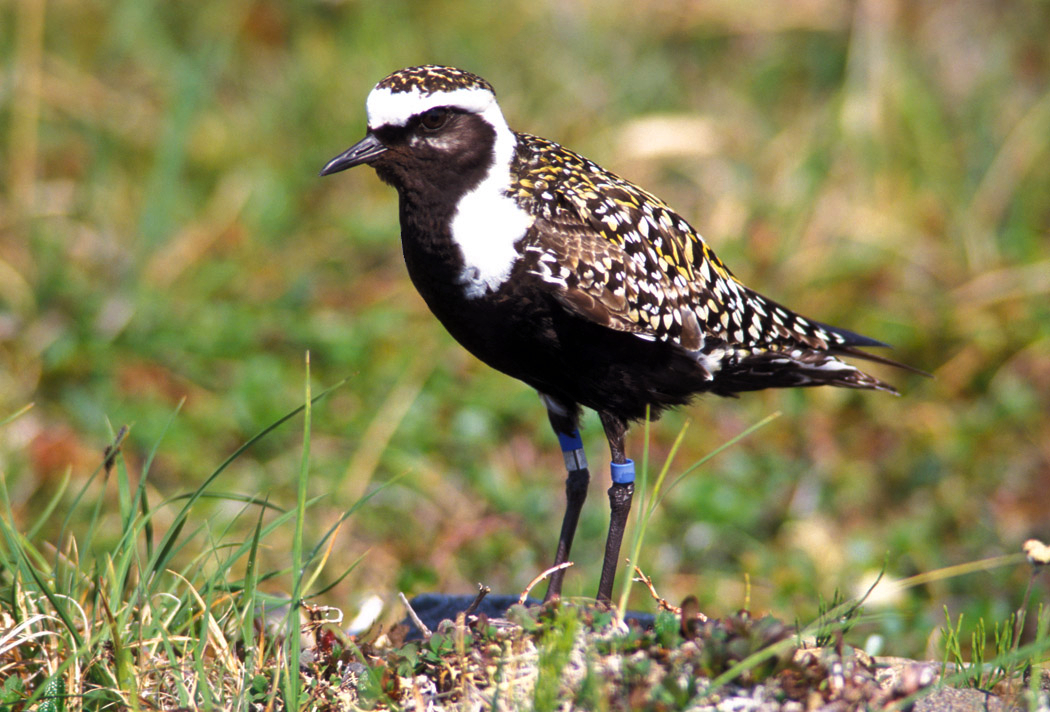
Wikipedia: American golden-plover Source: OTHER
Pluvialis_dominica1.jpg
This bird appears across the great seas in the following continents:
North America, South America, Africa.
![]() The American golden plover (Pluvialis dominica), or American golden-plover is a medium-sized plover. The genus name is Latin and means relating to rain, from pluvia, "rain". It was believed that golden plovers flocked when rain was imminent. The species name dominica refers to Santo Domingo, now Hispaniola, in the West Indies.[2]
[more]
The American golden plover (Pluvialis dominica), or American golden-plover is a medium-sized plover. The genus name is Latin and means relating to rain, from pluvia, "rain". It was believed that golden plovers flocked when rain was imminent. The species name dominica refers to Santo Domingo, now Hispaniola, in the West Indies.[2]
[more]
Black-bellied plover / Kiebitzregenpfeifer (Pluvialis squatarola)
Black-bellied plover eggs. 2016-09-25 16.51.00 Botswana
First observed in Botswana on 2016-09-25.
This bird appears across the great seas in the following continents:
Europe, North America, South America, Africa, Asia.
![]() The grey plover or black-bellied plover (Pluvialis squatarola) is a medium-sized plover breeding in Arctic regions. It is a long-distance migrant, with a nearly worldwide coastal distribution when not breeding.[2] The genus name is Latin and means relating to rain, from pluvia, "rain". It was believed that golden plovers flocked when rain was imminent. The species name squatarola is a Latinised version of Sgatarola, a Venetian name for some kind of plover.[3]
[more]
The grey plover or black-bellied plover (Pluvialis squatarola) is a medium-sized plover breeding in Arctic regions. It is a long-distance migrant, with a nearly worldwide coastal distribution when not breeding.[2] The genus name is Latin and means relating to rain, from pluvia, "rain". It was believed that golden plovers flocked when rain was imminent. The species name squatarola is a Latinised version of Sgatarola, a Venetian name for some kind of plover.[3]
[more]
Calls: ![]() Contact call diagnostic. A plaintive, drawn and trisyllabic (but continuous) "kleeooowee". Pitch falls on second syllable and rises on last. [Link]
Contact call diagnostic. A plaintive, drawn and trisyllabic (but continuous) "kleeooowee". Pitch falls on second syllable and rises on last. [Link]
Physical details: length=27-30 cm,
wingspan=71-83 cm,
weight=190-280 g
Habitats:
Wetland
Red knot / Knutt (Calidris canutus)
Profile Wikipedia eBird Vogelwarte BirdLife ZH ornitho.ch Audubon AllAboutBirds Xeno-Canto BirdID NABU
Red knots, according to MerlinBirdID - underway to somewhere better at Las Coloradas. 2023-04-15 09.34.08 Yucatan
First observed in Yucatan on 2023-04-15.
This bird appears across the great seas in the following continents:
Europe, North America, South America, Africa, Asia.
General: ![]() The red knot (Calidris canutus) (just knot in English-speaking Europe) is a medium-sized shorebird which breeds in tundra and the Arctic Cordillera in the far north of Canada, Europe, and Russia. It is a large member of the Calidris sandpipers, second only to the great knot.[2] Six subspecies are recognised.
[more]
The red knot (Calidris canutus) (just knot in English-speaking Europe) is a medium-sized shorebird which breeds in tundra and the Arctic Cordillera in the far north of Canada, Europe, and Russia. It is a large member of the Calidris sandpipers, second only to the great knot.[2] Six subspecies are recognised.
[more]
Song: ![]() Song an undulating, nasal mewing "poooor-mee", or "po-hor-mee". [Link]
Song an undulating, nasal mewing "poooor-mee", or "po-hor-mee". [Link]
Calls: ![]() Most commonly heard migratory call, a short "kut" or "knot". Sometimes given in stuttering series. [Link]
Most commonly heard migratory call, a short "kut" or "knot". Sometimes given in stuttering series. [Link]
Physical details: length=23-25 cm,
wingspan=57-61 cm,
weight=110-160 g
Habitats:
Wetland
Sanderling / Sanderling (Calidris alba)
Profile Wikipedia eBird Vogelwarte BirdLife ZH ornitho.ch Audubon AllAboutBirds Xeno-Canto BirdID NABU
Sanderling. 2023-09-27 12.12.20 Florida
First observed in Yucatan on 2023-03-27.
This bird appears across the great seas in the following continents:
Europe, North America, South America, Africa, Asia.
General: ![]() The sanderling (Calidris alba) is a small wading bird. The name derives from Old English sand-yrðling, "sand-ploughman".[2] The genus name is from Ancient Greek kalidris or skalidris, a term used by Aristotle for some grey-coloured waterside birds. The specific alba is Latin for "white".[3]
[more]
The sanderling (Calidris alba) is a small wading bird. The name derives from Old English sand-yrðling, "sand-ploughman".[2] The genus name is from Ancient Greek kalidris or skalidris, a term used by Aristotle for some grey-coloured waterside birds. The specific alba is Latin for "white".[3]
[more]
Calls: ![]() Call not very diagnostic; a short and soft "pleet" or "keek". [Link]
Call not very diagnostic; a short and soft "pleet" or "keek". [Link]
Physical details: length=20-21 cm,
wingspan=40-45 cm,
weight=44-70 g
Habitats:
Wetland
Dunlin / Alpenstrandläufer (Calidris alpina)
Profile Wikipedia eBird Vogelwarte BirdLife ZH ornitho.ch Audubon AllAboutBirds Xeno-Canto BirdID NABU
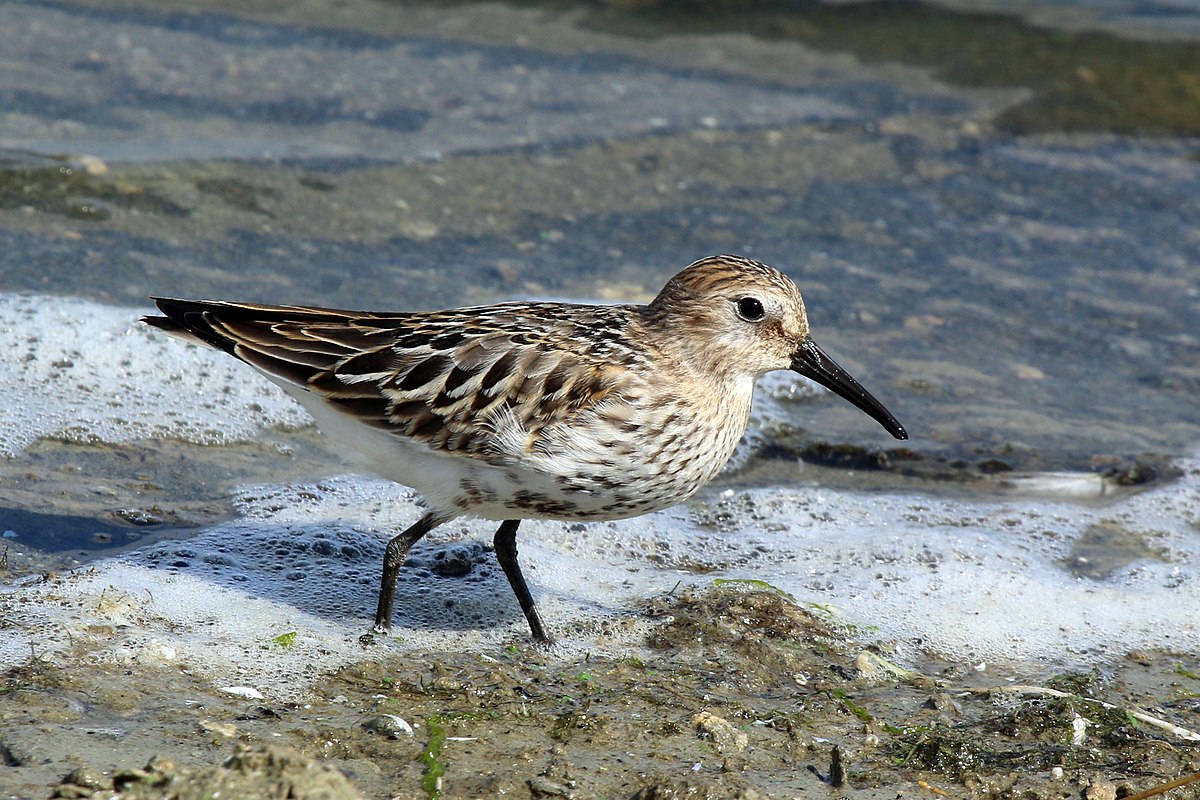
Wikipedia: Dunlin Source: OTHER
1200px-Dunlin_%28Calidris_alpina%29_juvenile.jpg
This bird appears across the great seas in the following continents:
Europe, North America, South America, Africa.
General: ![]() The dunlin (Calidris alpina) is a small wader, sometimes separated with the other "stints" in Erolia. The English name is a dialect form of "dunling", first recorded in 1531–2. It derives from dun, "dull brown", with the suffix -ling, meaning a person or thing with the given quality.[2] The genus name is from Ancient Greek kalidris or skalidris, a term used by Aristotle for some grey-coloured waterside birds. The specific alpina is from Latin and means "of high mountains", in this case referring to the Alps.[3]
[more]
The dunlin (Calidris alpina) is a small wader, sometimes separated with the other "stints" in Erolia. The English name is a dialect form of "dunling", first recorded in 1531–2. It derives from dun, "dull brown", with the suffix -ling, meaning a person or thing with the given quality.[2] The genus name is from Ancient Greek kalidris or skalidris, a term used by Aristotle for some grey-coloured waterside birds. The specific alpina is from Latin and means "of high mountains", in this case referring to the Alps.[3]
[more]
Song: ![]() Song: A drawn out, nasal "tweeet", and ringing variations on the contact call in decrescendo. Low chattering heard from feeding birds. [Link]
Song: A drawn out, nasal "tweeet", and ringing variations on the contact call in decrescendo. Low chattering heard from feeding birds. [Link]
Calls: ![]() Contact call a diagnostic, very nasal "trrreeet" . Given throughout the year and in many situations, including when being flushed. [Link]
Contact call a diagnostic, very nasal "trrreeet" . Given throughout the year and in many situations, including when being flushed. [Link]
Physical details: length=16-20 cm,
wingspan=38-43 cm,
weight=35-60 g
Habitats:
Wetland
Pectoral sandpiper / Graubrust-Strandläufer (Calidris melanotos)
Profile Wikipedia eBird Audubon AllAboutBirds Xeno-Canto

Wikipedia: Pectoral sandpiper Source: OTHER
1200px-Pectoral_Sandpiper3.jpg
This bird appears across the great seas in the following continents:
North America, South America, Africa.
General: ![]() The pectoral sandpiper (Calidris melanotos) is a small, migratory wader that breeds in North America and Asia, wintering in South America and Oceania. It eats small invertebrates. Its nest, a hole scraped in the ground and with a thick lining, is deep enough to protect its four eggs from the cool breezes of its breeding grounds. The pectoral sandpiper is 21 cm (8.3 in) long, with a wingspan of 46 cm (18 in).
[more]
The pectoral sandpiper (Calidris melanotos) is a small, migratory wader that breeds in North America and Asia, wintering in South America and Oceania. It eats small invertebrates. Its nest, a hole scraped in the ground and with a thick lining, is deep enough to protect its four eggs from the cool breezes of its breeding grounds. The pectoral sandpiper is 21 cm (8.3 in) long, with a wingspan of 46 cm (18 in).
[more]
Stilt sandpiper (Calidris himantopus)

Wikipedia: Stilt sandpiper Source: OTHER
Calidris_himantopus.jpg
This bird appears across the great seas in the following continents:
North America, South America, Australia.
vagrant
Western sandpiper / Bergstrandläufer (Calidris mauri)
Profile Wikipedia eBird Audubon AllAboutBirds Xeno-Canto

Wikipedia: Western sandpiper Source: OTHER
Western_Sandpiper.jpg
General: ![]() The western sandpiper (Calidris mauri) is a small shorebird. The genus name is from Ancient Greek kalidris or skalidris, a term used by Aristotle for some grey-coloured waterside birds. The specific mauri commemorates Italian botanist Ernesto Mauri (1791–1836).[2]
[more]
The western sandpiper (Calidris mauri) is a small shorebird. The genus name is from Ancient Greek kalidris or skalidris, a term used by Aristotle for some grey-coloured waterside birds. The specific mauri commemorates Italian botanist Ernesto Mauri (1791–1836).[2]
[more]
Semipalmated sandpiper / Sandstrandläufer (Calidris pusilla)
Dark-rimmed wings of these beautiful birds, probably semipalmated sandpiper, show up in flight. 2023-04-20 16.29.32 Yucatan
First observed in Yucatan on 2023-04-20.
![]() The semipalmated sandpiper (Calidris pusilla) is a very small shorebird. The genus name is from Ancient Greek kalidris or skalidris, a term used by Aristotle for some grey-coloured waterside birds. The specific pusilla is Latin for "very small".[2]
[more]
The semipalmated sandpiper (Calidris pusilla) is a very small shorebird. The genus name is from Ancient Greek kalidris or skalidris, a term used by Aristotle for some grey-coloured waterside birds. The specific pusilla is Latin for "very small".[2]
[more]
Least sandpiper / Wiesenstrandläufer (Calidris minutilla)
Profile Wikipedia eBird Audubon AllAboutBirds Xeno-Canto
Least sandpiper has wandered off the sea into the city in Campeche. 2023-04-06 16.53.02 Yucatan
First observed in Yucatan on 2023-04-06.
![]() The least sandpiper (Calidris minutilla) is the smallest shorebird. The genus name is from Ancient Greek kalidris or skalidris, a term used by Aristotle for some grey-colored waterside birds. The specific minutilla is Medieval Latin for "very small".[2]
[more]
The least sandpiper (Calidris minutilla) is the smallest shorebird. The genus name is from Ancient Greek kalidris or skalidris, a term used by Aristotle for some grey-colored waterside birds. The specific minutilla is Medieval Latin for "very small".[2]
[more]
Whimbrel / Regenbrachvogel (Numenius phaeopus)
Regenbrachvogel oder Grosser Brachvogel - dunkle Schwanzfedern ein moegliches Zeichen. 2022-06-23 16.53.34 La Sauge
First observed in Canary Islands on 2022-03-19.
This bird appears across the great seas in the following continents:
Europe, North America, South America, Africa, Asia.
![]() Der Regenbrachvogel (Numenius phaeopus) ist mit einer Spannweite um die 80 cm viel kleiner als der Große Brachvogel, auch der Schnabel ist kürzer und der Oberkopf ist hell und dunkel gestreift. Der Ruf dieser Vogelart ähnelt einem hellen Trillern.
[more]
Der Regenbrachvogel (Numenius phaeopus) ist mit einer Spannweite um die 80 cm viel kleiner als der Große Brachvogel, auch der Schnabel ist kürzer und der Oberkopf ist hell und dunkel gestreift. Der Ruf dieser Vogelart ähnelt einem hellen Trillern.
[more]
Song: ![]() Song starts similar to Curlew with long wailing notes "kluuueee", which then accelerates to a continuous, vibrating single note. Lacks the cyclic phrase ending of Curlew. [Link]
Song starts similar to Curlew with long wailing notes "kluuueee", which then accelerates to a continuous, vibrating single note. Lacks the cyclic phrase ending of Curlew. [Link]
Physical details: length=40-42 cm,
wingspan=76-89 cm,
weight=300-660 g
Habitats:
Wetland
Long-billed curlew (Numenius americanus)
Profile Wikipedia eBird Audubon AllAboutBirds Xeno-Canto

Wikipedia: Long-billed curlew Source: OTHER
1200px-Long-billed_curlew_at_Drakes_Beach%2C_Point_Reyes.jpg
General: ![]() The long-billed curlew (Numenius americanus) is a large North American shorebird of the family Scolopacidae. This species was also called "sicklebird"[2] and the "candlestick bird". The species breeds in central and western North America, migrating southward and coastward for the winter.
[more]
The long-billed curlew (Numenius americanus) is a large North American shorebird of the family Scolopacidae. This species was also called "sicklebird"[2] and the "candlestick bird". The species breeds in central and western North America, migrating southward and coastward for the winter.
[more]
Ruddy turnstone / Steinwälzer (Arenaria interpres)
Ruddy turnstone near Las Coloradas. 2023-04-15 10.06.32 Yucatan
First observed in Canary Islands on 2022-03-19.
This bird appears across the great seas in the following continents:
Europe, North America, South America, Africa, Asia.
![]() The ruddy turnstone (Arenaria interpres) is a small wading bird, one of two species of turnstone in the genus Arenaria. The scientific name is from Latin. The genus name arenaria derives from arenarius, "inhabiting sand, from arena, "sand". The specific interpres means "messenger"; when visiting Gotland in 1741, Linnaeus thought that the Swedish word Tolk "interpreter" applied to this species, but in the local dialect the word means "legs" and is used for the redshank.[2]
[more]
The ruddy turnstone (Arenaria interpres) is a small wading bird, one of two species of turnstone in the genus Arenaria. The scientific name is from Latin. The genus name arenaria derives from arenarius, "inhabiting sand, from arena, "sand". The specific interpres means "messenger"; when visiting Gotland in 1741, Linnaeus thought that the Swedish word Tolk "interpreter" applied to this species, but in the local dialect the word means "legs" and is used for the redshank.[2]
[more]
Song: ![]() Alarm call/song more "wader-like", a staccato "kuvi-kuvi-vit-vit-vitua". [Link]
Alarm call/song more "wader-like", a staccato "kuvi-kuvi-vit-vit-vitua". [Link]
Calls: ![]() Characteristic call: An explosive, hard, resonant and short "koi" or "kott" with a peculiar timbre, usually given in rapid or accelerating series. [Link]
Characteristic call: An explosive, hard, resonant and short "koi" or "kott" with a peculiar timbre, usually given in rapid or accelerating series. [Link]
Physical details: length=22-24 cm,
wingspan=50-57 cm,
weight=85-150 g
Habitats:
Wetland
Wilson's snipe / Wilsonbekassine (Gallinago delicata)
Profile Wikipedia eBird Audubon AllAboutBirds Xeno-Canto

Wikipedia: Wilson's snipe Source: OTHER
1200px-Gallinago-delicata-002-cropped.jpg
General: ![]() Wilson's snipe (Gallinago delicata) is a small, stocky shorebird.[2] The genus name gallinago is New Latin for a woodcock or snipe from Latin gallina, "hen" and the suffix -ago, "resembling". The specific delicata is Latin for "dainty".[3]
[more]
Wilson's snipe (Gallinago delicata) is a small, stocky shorebird.[2] The genus name gallinago is New Latin for a woodcock or snipe from Latin gallina, "hen" and the suffix -ago, "resembling". The specific delicata is Latin for "dainty".[3]
[more]
Shortbilled dowitcher / Kleiner Schlammläufer (Limnodromus griseus)
You can see why it's called Las Colarados here - I believe Erik said short-billed dowitchers. 2023-04-15 09.33.38 Yucatan
First observed in Yucatan on 2023-04-15.
This bird appears across the great seas in the following continents:
North America, South America, Australia.
vagrant
Marbled godwit / Amerikanische Pfuhlschnepfe (Limosa fedoa)
Profile Wikipedia eBird Audubon AllAboutBirds Xeno-Canto
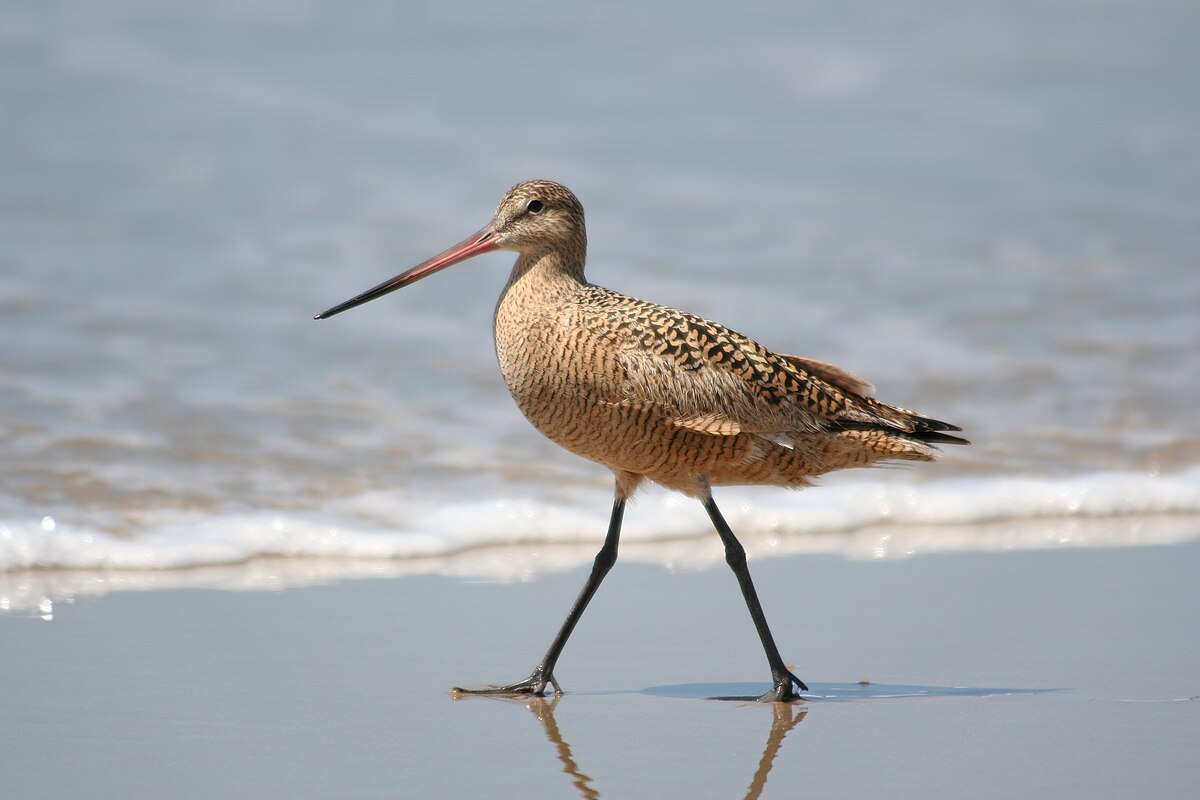
Wikipedia: Marbled godwit Source: OTHER
1200px-MarbledGodwit.jpg
General: ![]() The marbled godwit (Limosa fedoa) is a large shorebird. On average, it is the largest of the 4 species of godwit.
[more]
The marbled godwit (Limosa fedoa) is a large shorebird. On average, it is the largest of the 4 species of godwit.
[more]
Lesser yellowlegs / Kleiner Gelbschenkel (Tringa flavipes)
Profile Wikipedia eBird Audubon AllAboutBirds Xeno-Canto

Wikipedia: Lesser yellowlegs Source: OTHER
1200px-Lesser_Yellowlegs.jpg
This bird appears across the great seas in the following continents:
North America, South America, Africa.
![]() The lesser yellowlegs (Tringa flavipes) is a medium-sized shorebird. The genus name Tringa is the New Latin name given to the green sandpiper by Aldrovandus in 1599 based on Ancient Greek trungas, a thrush-sized, white-rumped, tail-bobbing wading bird mentioned by Aristotle. The specific flavipes is from Latin flavus, "yellow", and pes, "foot".[2]
[more]
The lesser yellowlegs (Tringa flavipes) is a medium-sized shorebird. The genus name Tringa is the New Latin name given to the green sandpiper by Aldrovandus in 1599 based on Ancient Greek trungas, a thrush-sized, white-rumped, tail-bobbing wading bird mentioned by Aristotle. The specific flavipes is from Latin flavus, "yellow", and pes, "foot".[2]
[more]
Solitary sandpiper / Einsamer Wasserläufer (Tringa solitaria)
Profile Wikipedia eBird Audubon AllAboutBirds Xeno-Canto

Wikipedia: Solitary sandpiper Source: OTHER
Solitarysandpiper.jpg
![]() The solitary sandpiper (Tringa solitaria) is a small shorebird. The genus name Tringa is the New Latin name given to the green sandpiper by Aldrovandus in 1599 based on Ancient Greek trungas, a thrush-sized, white-rumped, tail-bobbing wading bird mentioned by Aristotle. The specific solitaria is Latin for "solitary" from solus, "alone".[2]
[more]
The solitary sandpiper (Tringa solitaria) is a small shorebird. The genus name Tringa is the New Latin name given to the green sandpiper by Aldrovandus in 1599 based on Ancient Greek trungas, a thrush-sized, white-rumped, tail-bobbing wading bird mentioned by Aristotle. The specific solitaria is Latin for "solitary" from solus, "alone".[2]
[more]
Willet / Schlammtreter (Tringa semipalmata)
MerlinBirdID says willet, near St Petersburg. 2023-09-27 12.03.34 Florida
First observed in Yucatan on 2023-04-15.
![]() The willet (Tringa semipalmata), formerly in the monotypic genus Catoptrophorus as Catoptrophorus semipalmatus,[2][3] is a large shorebird in the family Scolopacidae. It is a relatively large and robust sandpiper, and is the largest of the species called "shanks" in the genus Tringa. Its closest relative is the lesser yellowlegs, a much smaller bird with a very different appearance apart from the fine, clear, and dense pattern of the neck, which both species show in breeding plumage. It breeds in North America and the West Indies and winters in southern North America, Central America, the West Indies and South America.
[more]
The willet (Tringa semipalmata), formerly in the monotypic genus Catoptrophorus as Catoptrophorus semipalmatus,[2][3] is a large shorebird in the family Scolopacidae. It is a relatively large and robust sandpiper, and is the largest of the species called "shanks" in the genus Tringa. Its closest relative is the lesser yellowlegs, a much smaller bird with a very different appearance apart from the fine, clear, and dense pattern of the neck, which both species show in breeding plumage. It breeds in North America and the West Indies and winters in southern North America, Central America, the West Indies and South America.
[more]
Greater yellowlegs (Tringa melanoleuca)
Profile Wikipedia eBird Audubon AllAboutBirds Xeno-Canto
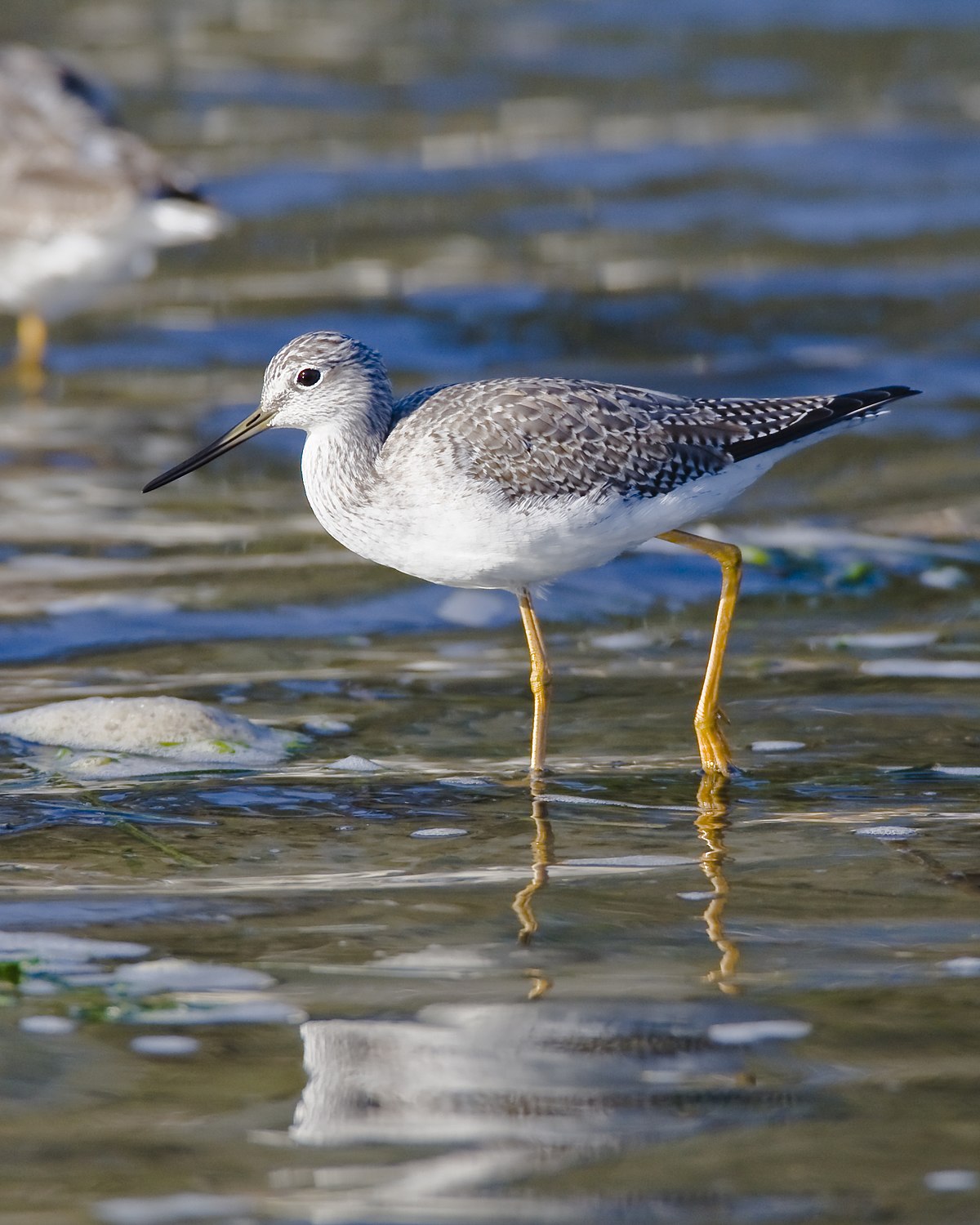
Wikipedia: Greater yellowlegs Source: OTHER
1200px-Greater_Yellowlegs2.jpg
![]() Totanus melanoleucus
[more]
Totanus melanoleucus
[more]
Spotted sandpiper / Drosseluferläufer (Actitis macularius)
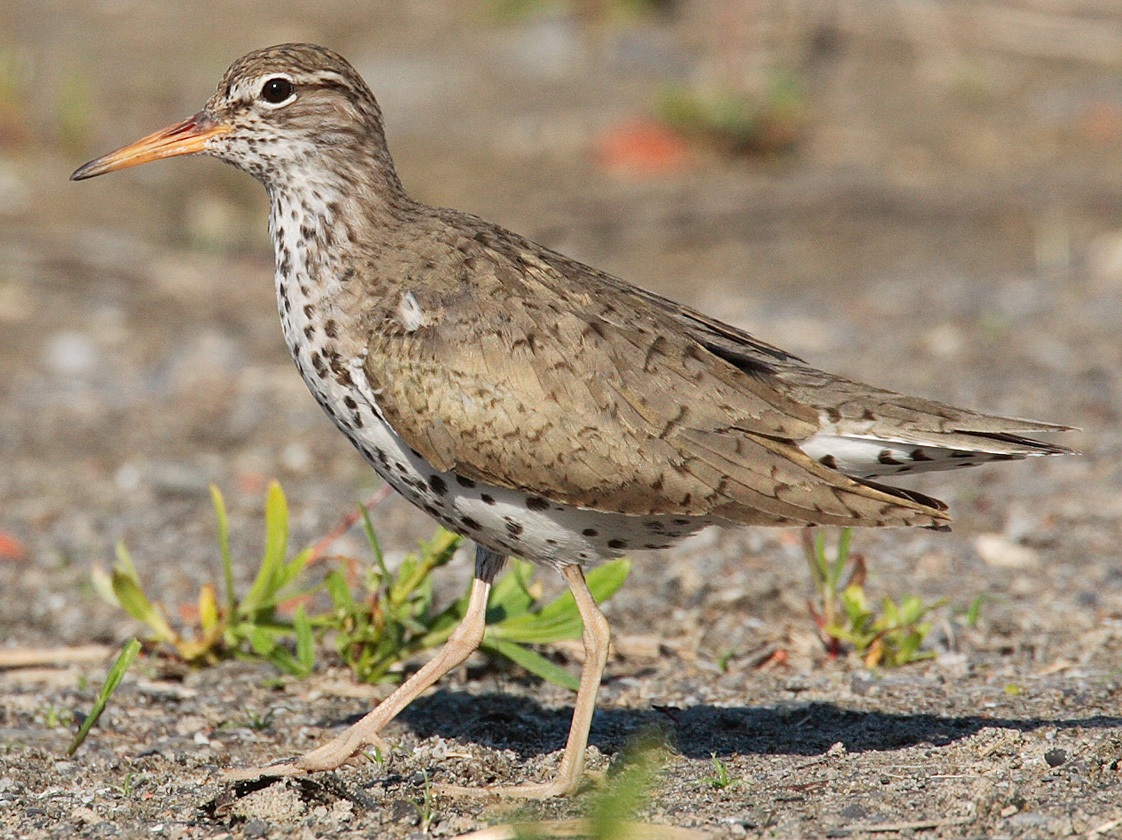
Wikipedia: Spotted sandpiper Source: OTHER
Actitis-macularia-005.jpg
![]() The spotted sandpiper (Actitis macularius) is a small shorebird. The genus name Actitis is from Ancient Greek aktites, "coast-dweller", derived from akte, "coast", and macularius is Latin from macula, "spot".[2]
[more]
The spotted sandpiper (Actitis macularius) is a small shorebird. The genus name Actitis is from Ancient Greek aktites, "coast-dweller", derived from akte, "coast", and macularius is Latin from macula, "spot".[2]
[more]
Wilson's phalarope / Wilson-Wassertreter (Phalaropus tricolor)
Profile Wikipedia eBird Audubon AllAboutBirds Xeno-Canto
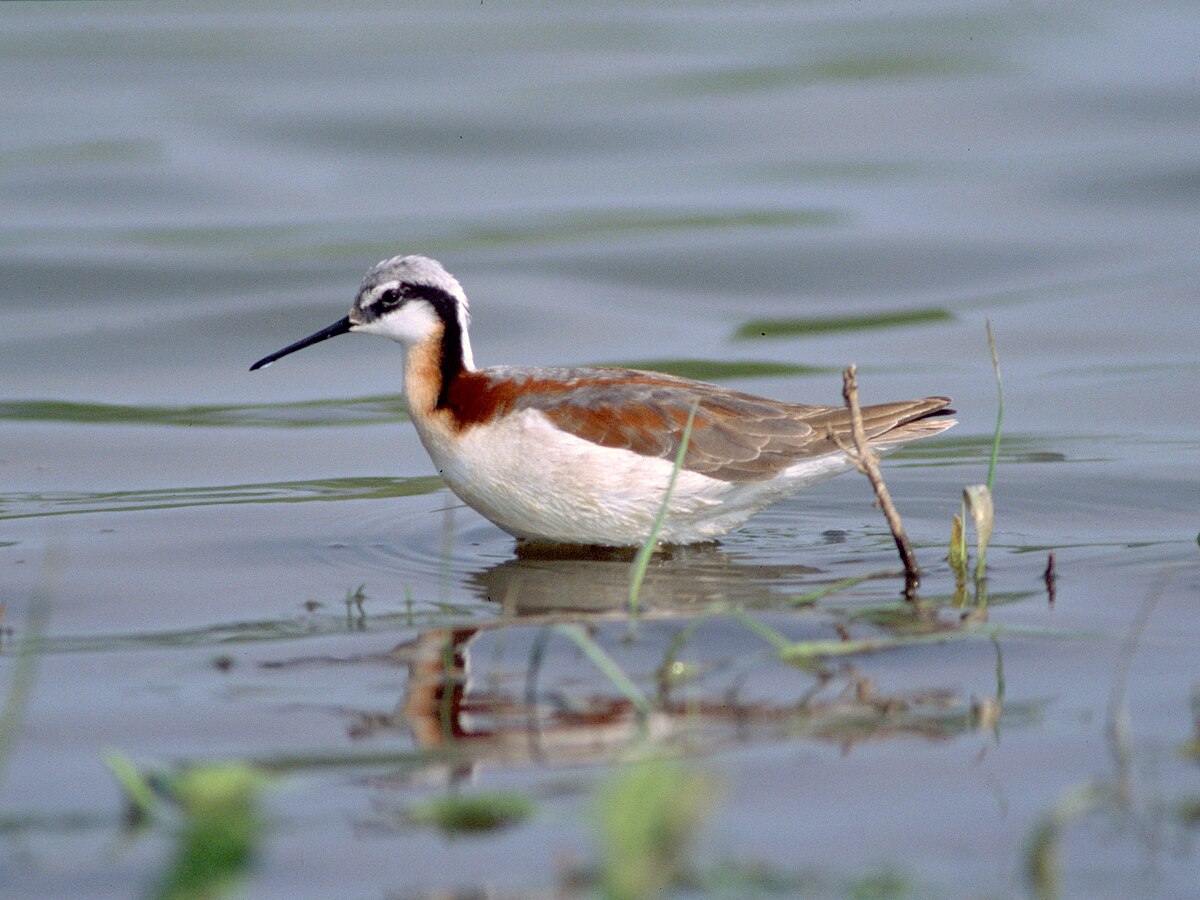
Wikipedia: Wilson's phalarope Source: OTHER
1200px-Phalaropus_tricolor_-_breeding_female.jpg
This bird appears across the great seas in the following continents:
North America, South America, Africa.
![]() Wilson's phalarope (Phalaropus tricolor) is a small wader. This bird, the largest of the phalaropes, breeds in the prairies of North America in western Canada and the western United States. It is migratory, wintering in inland salt lakes near the Andes in Argentina.[2] They are passage migrants through Central America around March/April and again during September/October.[3] The species is a rare vagrant to western Europe.
[more]
Wilson's phalarope (Phalaropus tricolor) is a small wader. This bird, the largest of the phalaropes, breeds in the prairies of North America in western Canada and the western United States. It is migratory, wintering in inland salt lakes near the Andes in Argentina.[2] They are passage migrants through Central America around March/April and again during September/October.[3] The species is a rare vagrant to western Europe.
[more]
Red-necked phalarope / Odinshühnchen (Phalaropus lobatus)
Profile Wikipedia eBird Audubon AllAboutBirds Xeno-Canto NABU
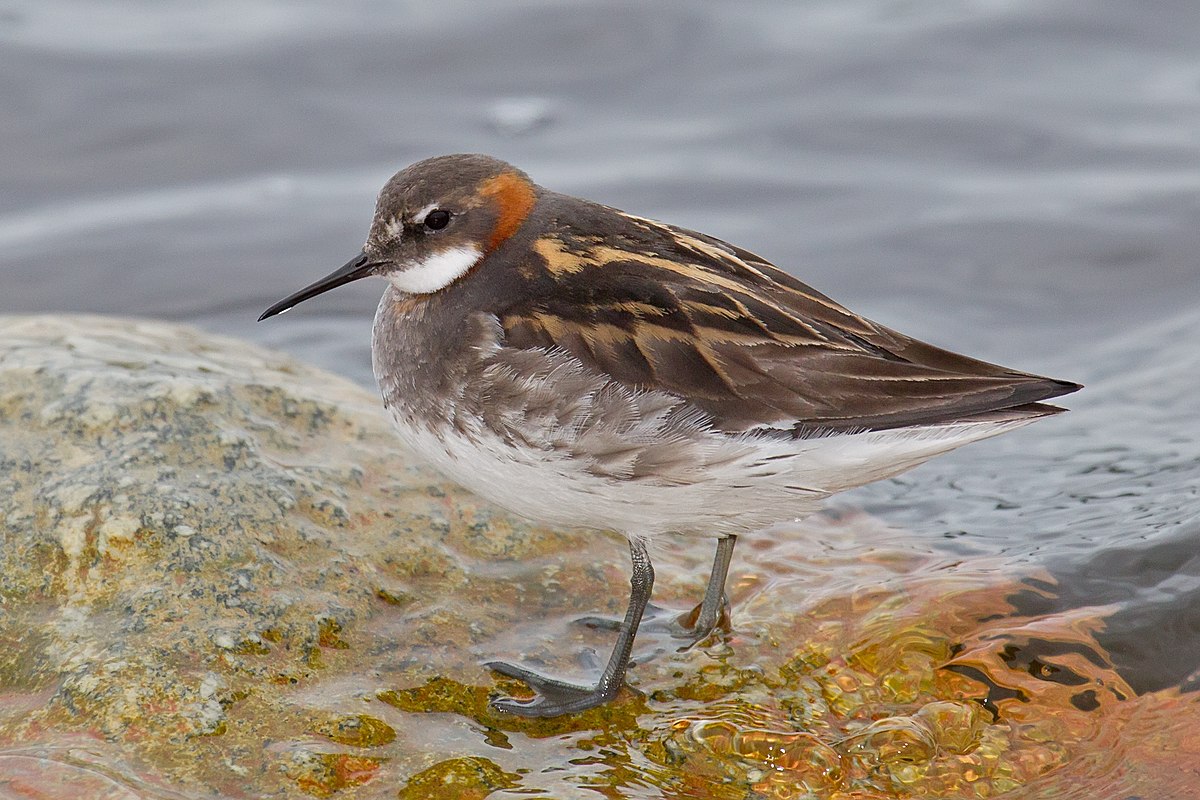
Wikipedia: Red-necked phalarope Source: OTHER
1200px-Red-necked_Phalarope.jpg
This bird appears across the great seas in the following continents:
Europe, North America, South America, Africa, Asia.
![]() The red-necked phalarope (Phalaropus lobatus), also known as the northern phalarope and hyperborean phalarope,[2] is a small wader. This phalarope breeds in the Arctic regions of North America and Eurasia. It is migratory, and, unusually for a wader, winters at sea on tropical oceans.
[more]
The red-necked phalarope (Phalaropus lobatus), also known as the northern phalarope and hyperborean phalarope,[2] is a small wader. This phalarope breeds in the Arctic regions of North America and Eurasia. It is migratory, and, unusually for a wader, winters at sea on tropical oceans.
[more]
Upland sandpiper / Prärieläufer (Bartramia longicauda)
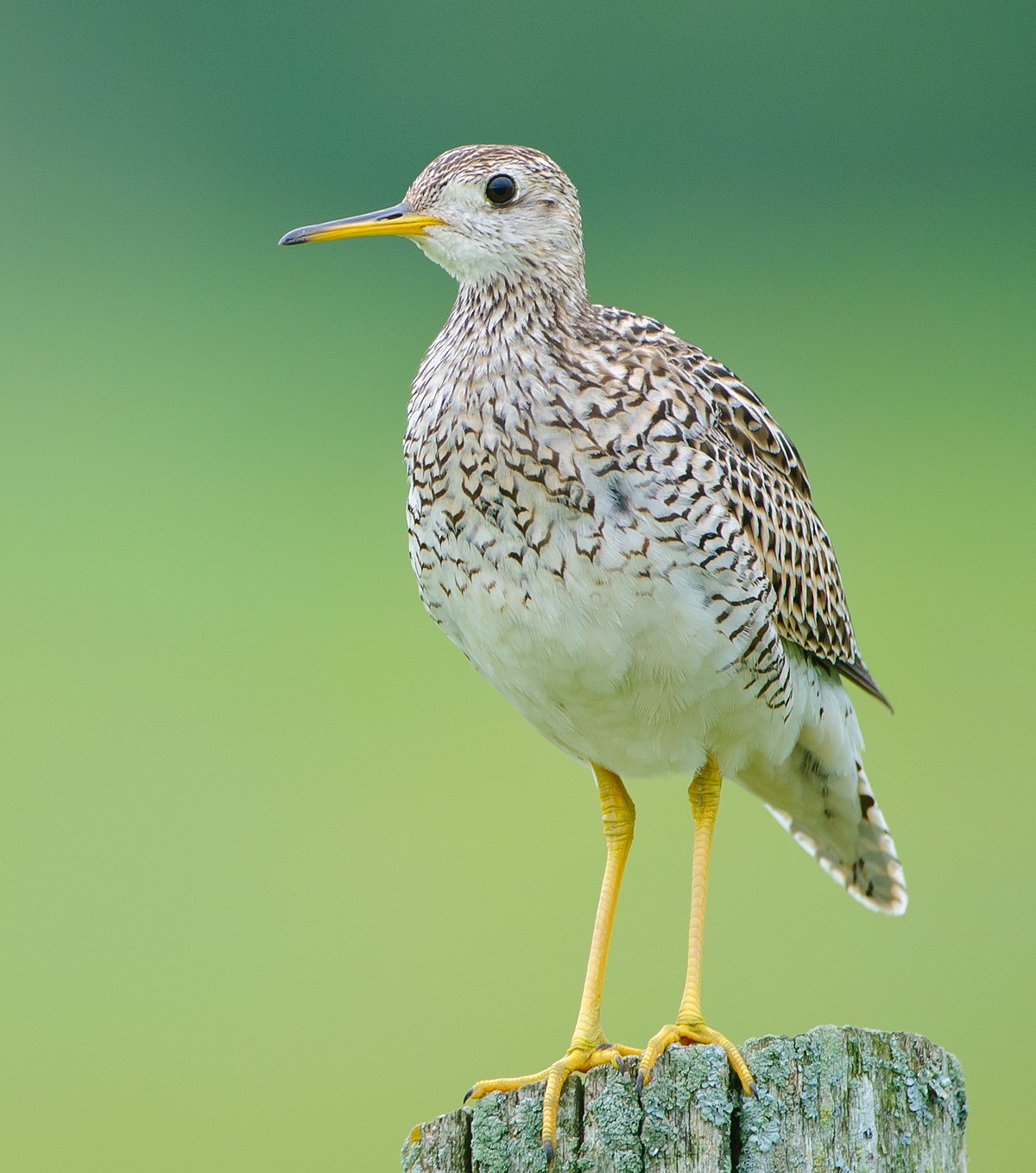
Wikipedia: Upland sandpiper Source: OTHER
1200px-UplandSandpiperOntarioCropped.jpg
This bird appears across the great seas in the following continents:
North America, South America, Australia.
vagrant
Common tern / Flussseeschwalbe (Sterna hirundo)
Profile Wikipedia eBird Vogelwarte BirdLife ZH ornitho.ch bird-song.ch Audubon AllAboutBirds Xeno-Canto BirdID NABU
First observed in 🇨🇭 on 2020-04-27.
This bird appears across the great seas in the following continents:
Europe, North America, South America, Africa, Asia.
Seasonal Behavior: ![]() Die Flussseeschwalbe (Sterna hirundo) ist eine Vogelart aus der Familie der Seeschwalben (Sternidae).
Sie ist in Mitteleuropa ein verbreiteter, aber nicht sehr häufiger Brut- und Sommervogel.
Während der Zugzeiten können im mitteleuropäischen Raum außerdem viele Durchzügler beobachtet werden. [Link]
Die Flussseeschwalbe (Sterna hirundo) ist eine Vogelart aus der Familie der Seeschwalben (Sternidae).
Sie ist in Mitteleuropa ein verbreiteter, aber nicht sehr häufiger Brut- und Sommervogel.
Während der Zugzeiten können im mitteleuropäischen Raum außerdem viele Durchzügler beobachtet werden. [Link]
Vocalization: ![]() Similar to Arctic Tern but deeper. [Link]
Similar to Arctic Tern but deeper. [Link]
Calls: ![]() Lacks latter's high pitched "tip-tip-tip" call, and the drawn out "kree-aaahh" call falls more distinctly in pitch. [Link]
Lacks latter's high pitched "tip-tip-tip" call, and the drawn out "kree-aaahh" call falls more distinctly in pitch. [Link]
Physical details: length=31-35 cm,
wingspan=77-98 cm,
weight=110-150 g
Habitats:
River and lake
Call:
Automatically generated from Xeno-Canto recording
♫ Source: BirdNet
20200427_140813 birdnet 430 - Common tern.mp3
2020-04-27 14.08.13 Luppmen (song?)
Forster's tern (Sterna forsteri)
Profile Wikipedia eBird Audubon AllAboutBirds Xeno-Canto

Wikipedia: Forster's tern Source: OTHER
1200px-Forster%27s_Tern.jpg
General: ![]() Forster's tern (Sterna forsteri) is a tern in the family Laridae. The genus name Sterna is derived from Old English "stearn", "tern",[2] and forsteri commemorates the naturalist Johann Reinhold Forster.[3]
[more]
Forster's tern (Sterna forsteri) is a tern in the family Laridae. The genus name Sterna is derived from Old English "stearn", "tern",[2] and forsteri commemorates the naturalist Johann Reinhold Forster.[3]
[more]
American oystercatcher / Braunmantel-Austernfischer (Haematopus palliatus)
Profile Wikipedia eBird Audubon AllAboutBirds Xeno-Canto

Wikipedia: American oystercatcher Source: OTHER
1200px-American_oystercatchers_at_Fort_Tilden_%2860747%29.jpg
![]() The American oystercatcher (Haematopus palliatus), occasionally called the American pied oystercatcher, is a member of family Haematopodidae. Originally called the "sea pie", it was renamed in 1731 when naturalist Mark Catesby observed the bird eating oysters.[2] The current population of American oystercatchers is estimated to be 43,000.[2] There are estimated to be 1,500 breeding pairs along the Atlantic and Gulf Coasts of the US.[3] The bird is marked by its black and white body and a long, thick orange beak.
[more]
The American oystercatcher (Haematopus palliatus), occasionally called the American pied oystercatcher, is a member of family Haematopodidae. Originally called the "sea pie", it was renamed in 1731 when naturalist Mark Catesby observed the bird eating oysters.[2] The current population of American oystercatchers is estimated to be 43,000.[2] There are estimated to be 1,500 breeding pairs along the Atlantic and Gulf Coasts of the US.[3] The bird is marked by its black and white body and a long, thick orange beak.
[more]
Pomarine jaeger / Spatelraubmöwe (Stercorarius pomarinus)
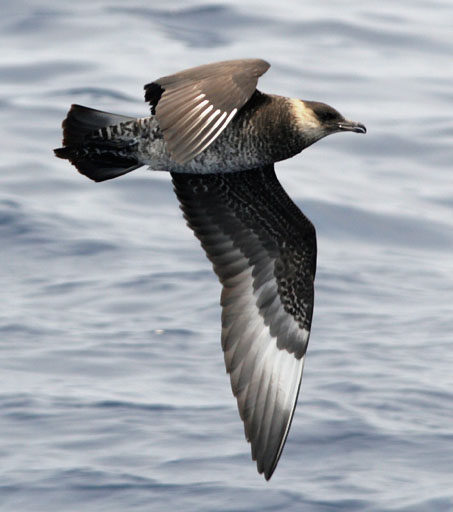
Wikipedia: Pomarine jaeger Source: OTHER
Stercorarius_pomarinusPCCA20070623-3985B.jpg
This bird appears across the great seas in the following continents:
Europe, North America, South America, Africa, Asia.
![]() The pomarine jaeger (Stercorarius pomarinus), pomarine skua, or pomatorhine skua,[2] is a seabird in the skua family Stercorariidae. It is a migrant, wintering at sea in the tropical oceans.
[more]
The pomarine jaeger (Stercorarius pomarinus), pomarine skua, or pomatorhine skua,[2] is a seabird in the skua family Stercorariidae. It is a migrant, wintering at sea in the tropical oceans.
[more]
Calls: ![]() Short "kea" or "ke", and various mewing calls, usually deeper pitched than Arctic Skua. Also a characteristic, laughing and vibrating "kayayayayaya", heard mostly on breeding ground. [Link]
Short "kea" or "ke", and various mewing calls, usually deeper pitched than Arctic Skua. Also a characteristic, laughing and vibrating "kayayayayaya", heard mostly on breeding ground. [Link]
Physical details: length=46-51 cm,
wingspan=125-138 cm,
weight=600-900 g
Parasitic jaeger / Schmarotzerraubmöwe (Stercorarius parasiticus)
Our guide raises his arm, which results in the Arctic Skua keeping a safe distance. 2015-06-10 15.13.04 Iceland
First observed in Iceland on 2015-06-10.
This bird appears across the great seas in the following continents:
Europe, North America, South America, Africa, Asia.
General: ![]() The parasitic jaeger (Stercorarius parasiticus), also known as the Arctic skua, Arctic jaeger or parasitic skua, is a seabird in the skua family Stercorariidae. The word "jaeger" is derived from the German word Jäger, meaning "hunter".[2] The English "skua" comes from the Faroese name skúgvur [ˈskɪkvʊər] for the great skua, with the island of Skúvoy known for its colony of that bird. The general Faroese term for skuas is kjógvi [ˈtʃɛkvə].[3] The genus name Stercorarius is Latin and means "of dung"; the food disgorged by other birds when pursued by skuas was once thought to be excrement. The specific parasiticus is from Latin and means "parasitic".[4]
[more]
The parasitic jaeger (Stercorarius parasiticus), also known as the Arctic skua, Arctic jaeger or parasitic skua, is a seabird in the skua family Stercorariidae. The word "jaeger" is derived from the German word Jäger, meaning "hunter".[2] The English "skua" comes from the Faroese name skúgvur [ˈskɪkvʊər] for the great skua, with the island of Skúvoy known for its colony of that bird. The general Faroese term for skuas is kjógvi [ˈtʃɛkvə].[3] The genus name Stercorarius is Latin and means "of dung"; the food disgorged by other birds when pursued by skuas was once thought to be excrement. The specific parasiticus is from Latin and means "parasitic".[4]
[more]
Vocalization: ![]() Mostly heard at breeding ground. [Link]
Mostly heard at breeding ground. [Link]
Calls: ![]() Most characteristic call is a mewing, kittiwake-like "aeeeee-ah". First syllable drawn-out and rising in pitch, and followed by a deeper conclusive second syllable "ah". Lacks the introductory double accent of Kittiwakes ("kitti-wake"). [Link]
Most characteristic call is a mewing, kittiwake-like "aeeeee-ah". First syllable drawn-out and rising in pitch, and followed by a deeper conclusive second syllable "ah". Lacks the introductory double accent of Kittiwakes ("kitti-wake"). [Link]
Physical details: length=41-46 cm,
wingspan=110-125 cm,
weight=330-570 g
Northern jacana / Gelbstirn-Blatthühnchen (Jacana spinosa)
Profile Wikipedia eBird A-Z Animals Xeno-Canto

Wikipedia: Northern jacana Source: OTHER
Jacana_spinosa_-Palo_Verde_National_Park%2C_Costa_Rica-8.jpg
General: ![]() The northern jacana or northern jaçana (Jacana spinosa) is a wader which is a resident breeder from coastal Mexico to western Panama, and on Cuba, Jamaica and Hispaniola in the Caribbean. It sometimes breeds in Texas, United States, and has also been recorded on several occasions as a vagrant in Arizona. The jacanas are a group of wetland birds, which are identifiable by their huge feet and claws, which enable them to walk on floating vegetation in the shallow lakes that are their preferred habitat. In Jamaica, this bird is also known as the 'Jesus bird', as it appears to walk on water.[2] Jacana is Linnæus' scientific Latin spelling of the Brazilian Portuguese jaçanã, pronounced [ʒasaˈnɐ̃], from the Tupi name of the bird. See jacana for pronunciations.
[more]
The northern jacana or northern jaçana (Jacana spinosa) is a wader which is a resident breeder from coastal Mexico to western Panama, and on Cuba, Jamaica and Hispaniola in the Caribbean. It sometimes breeds in Texas, United States, and has also been recorded on several occasions as a vagrant in Arizona. The jacanas are a group of wetland birds, which are identifiable by their huge feet and claws, which enable them to walk on floating vegetation in the shallow lakes that are their preferred habitat. In Jamaica, this bird is also known as the 'Jesus bird', as it appears to walk on water.[2] Jacana is Linnæus' scientific Latin spelling of the Brazilian Portuguese jaçanã, pronounced [ʒasaˈnɐ̃], from the Tupi name of the bird. See jacana for pronunciations.
[more]
Family Burhinidae (Triele, Haematopodidae – Austernfischer und Recurvirostridae – Säbelschnäblerverwandte):
Double-striped thick-knee (Burhinus bistriatus)

Wikipedia: Double-striped thick-knee Source: OTHER
Flickr_-_Rainbirder_-_Double-striped_Thick-Knee_%28Burhinus_bistriatus%29%2C_crop.jpg
![]() The double-striped thick-knee (Burhinus bistriatus) is a stone-curlew, a group of waders in the family Burhinidae. The vernacular name refers to the prominent joints in the long greenish-grey legs, and bistriatus to the two stripes of the head pattern.
[more]
The double-striped thick-knee (Burhinus bistriatus) is a stone-curlew, a group of waders in the family Burhinidae. The vernacular name refers to the prominent joints in the long greenish-grey legs, and bistriatus to the two stripes of the head pattern.
[more]
American avocet / Amerikanischer Säbelschnäbler (Recurvirostra americana)
Profile Wikipedia eBird Audubon AllAboutBirds Xeno-Canto

Wikipedia: American avocet Source: OTHER
1200px-American_Avocet1.jpg
![]() The American avocet (Recurvirostra americana) is a large wader in the avocet and stilt family, Recurvirostridae. It spends much of its time foraging in shallow water or on mud flats, often sweeping its bill from side to side in water as it seeks its crustacean and insect prey.[2]
[more]
The American avocet (Recurvirostra americana) is a large wader in the avocet and stilt family, Recurvirostridae. It spends much of its time foraging in shallow water or on mud flats, often sweeping its bill from side to side in water as it seeks its crustacean and insect prey.[2]
[more]
Black-necked stilt / Amerikanischer Stelzenläufer (Himantopus mexicanus)
Profile Wikipedia eBird Audubon AllAboutBirds Xeno-Canto
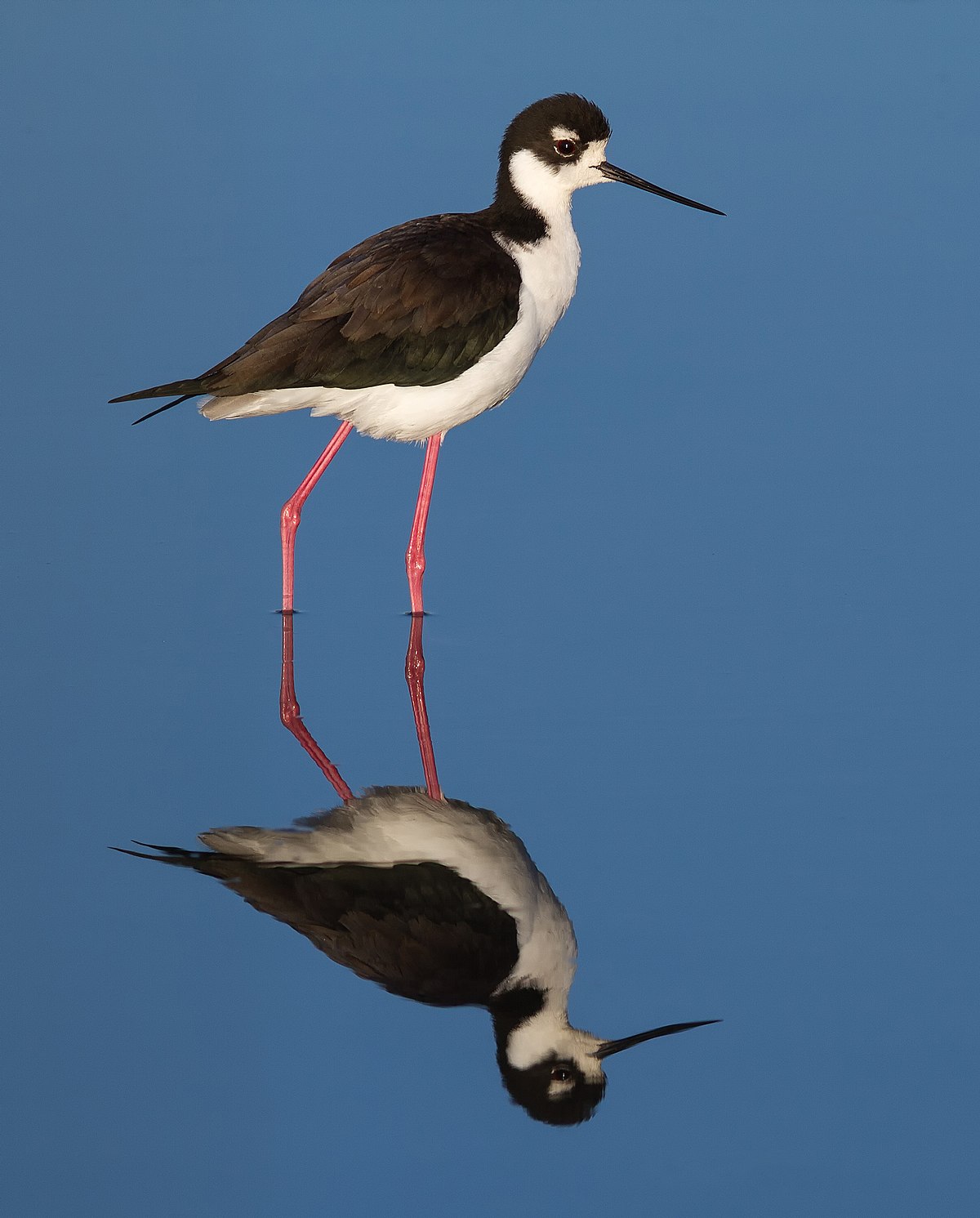
Wikipedia: Black-necked stilt Source: OTHER
1200px-Black-necked_Stilt_%28Himantopus_mexicanus%29%2C_Corte_Madera.jpg
![]() The black-necked stilt (Himantopus mexicanus) is a locally abundant shorebird of American wetlands and coastlines. It is found from the coastal areas of California through much of the interior western United States and along the Gulf of Mexico as far east as Florida, then south through Central America and the Caribbean to Ecuador and the Galápagos Islands. The northernmost populations, particularly those from inland, are migratory, wintering from the extreme south of the United States to southern Mexico, rarely as far south as Costa Rica; on the Baja California peninsula it is only found regularly in winter.[2]
[more]
The black-necked stilt (Himantopus mexicanus) is a locally abundant shorebird of American wetlands and coastlines. It is found from the coastal areas of California through much of the interior western United States and along the Gulf of Mexico as far east as Florida, then south through Central America and the Caribbean to Ecuador and the Galápagos Islands. The northernmost populations, particularly those from inland, are migratory, wintering from the extreme south of the United States to southern Mexico, rarely as far south as Costa Rica; on the Baja California peninsula it is only found regularly in winter.[2]
[more]
American coot (Fulica americana)
Profile Wikipedia eBird Audubon AllAboutBirds Xeno-Canto
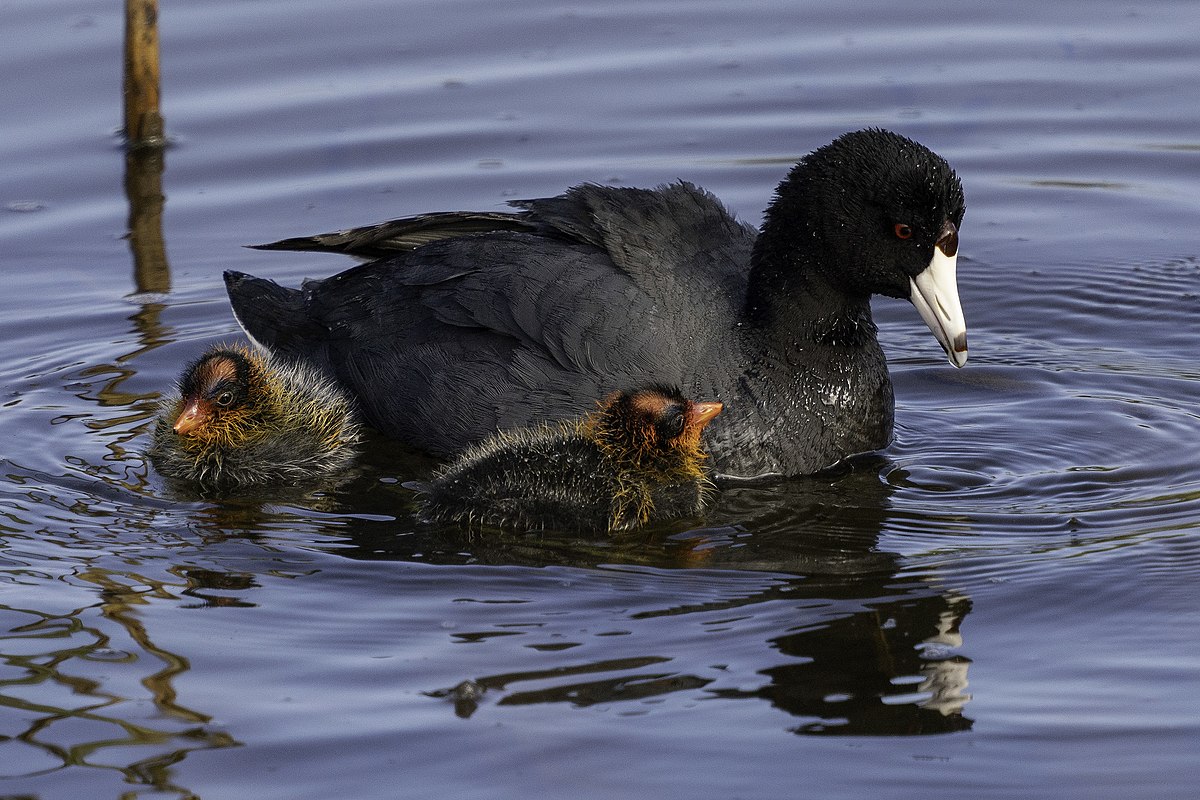
Wikipedia: American coot Source: OTHER
1200px-American-coot-casey-klebba.jpg
![]() The American coot (Fulica americana), also known as a mud hen or pouldeau, is a bird of the family Rallidae. Though commonly mistaken for ducks, American coots are only distantly related to ducks, belonging to a separate order. Unlike the webbed feet of ducks, coots have broad, lobed scales on their lower legs and toes that fold back with each step in order to facilitate walking on dry land.[2] Coots live near water, typically inhabiting wetlands and open water bodies in North America. Groups of coots are called covers[3] or rafts.[citation needed] The oldest known coot lived to be 22 years old.[2]
[more]
The American coot (Fulica americana), also known as a mud hen or pouldeau, is a bird of the family Rallidae. Though commonly mistaken for ducks, American coots are only distantly related to ducks, belonging to a separate order. Unlike the webbed feet of ducks, coots have broad, lobed scales on their lower legs and toes that fold back with each step in order to facilitate walking on dry land.[2] Coots live near water, typically inhabiting wetlands and open water bodies in North America. Groups of coots are called covers[3] or rafts.[citation needed] The oldest known coot lived to be 22 years old.[2]
[more]
Clapper rail (Rallus crepitans)
Profile Wikipedia eBird Audubon AllAboutBirds Xeno-Canto
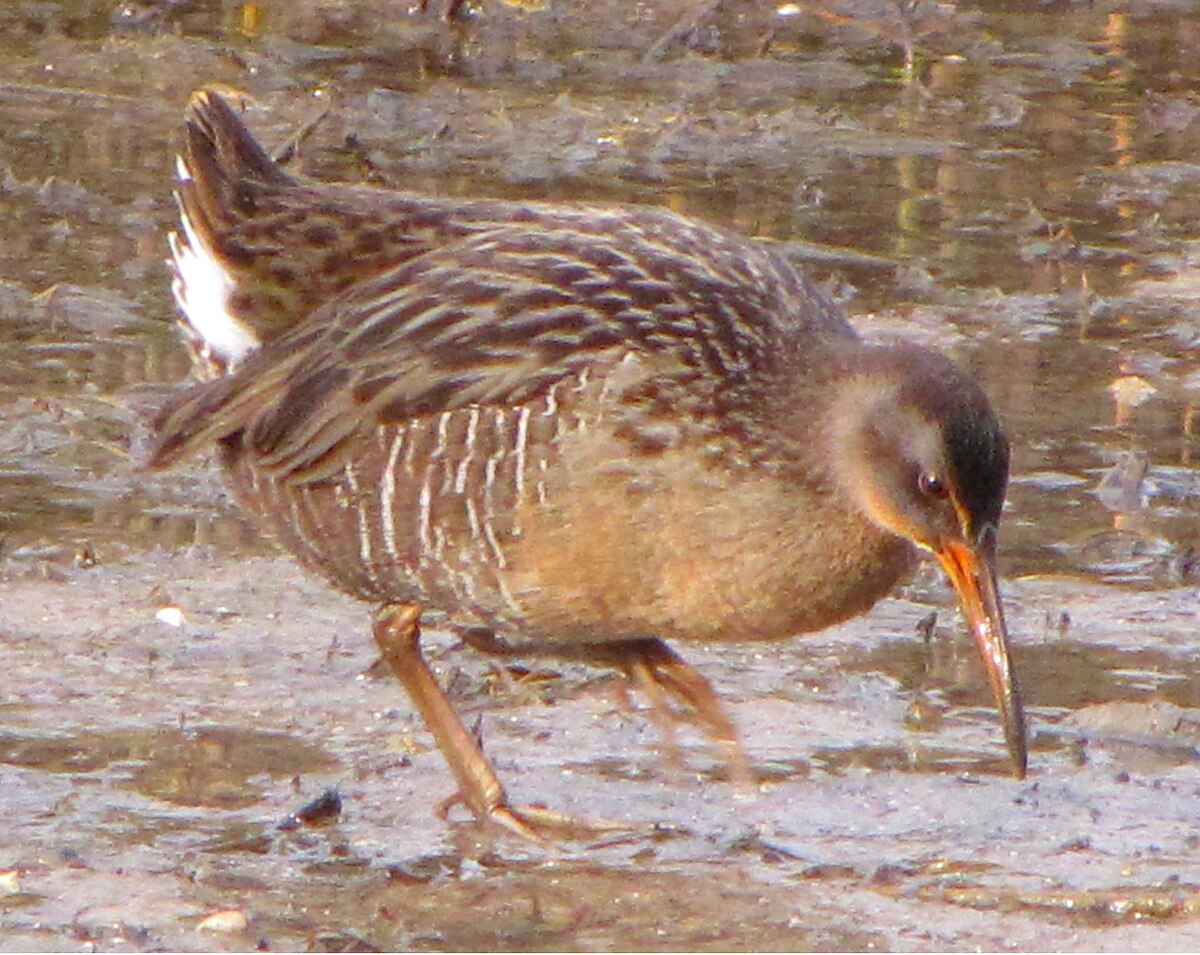
Wikipedia: Clapper rail Source: OTHER
1200px-Rallus_crepitans.jpg
![]() The clapper rail (Rallus crepitans) is a member of the rail family, Rallidae. The taxonomy for this species is confusing and still being determined. The Ridgway's rail (formerly the California clapper rail) and the mangrove rail have been recently split. Furthermore, some taxonomists consider that the King rail and Aztec rail should be considered within this group, as those birds look similar and the birds are known to interbreed where they share territories.
[more]
The clapper rail (Rallus crepitans) is a member of the rail family, Rallidae. The taxonomy for this species is confusing and still being determined. The Ridgway's rail (formerly the California clapper rail) and the mangrove rail have been recently split. Furthermore, some taxonomists consider that the King rail and Aztec rail should be considered within this group, as those birds look similar and the birds are known to interbreed where they share territories.
[more]
Common gallinule (Gallinula galeata)
Profile Wikipedia eBird Audubon AllAboutBirds Xeno-Canto
Common gallinule, juvenile, Florida. 2023-09-23 20.46.10 Florida
First observed in Florida on 2023-09-23.
![]() The common gallinule (Gallinula galeata) is a bird in the family Rallidae. It was split from the common moorhen by the American Ornithologists' Union in July 2011.[3] It lives around well-vegetated marshes, ponds, canals, and other wetlands in the Americas. The species is not found in the polar regions or many tropical rainforests. Elsewhere, the common gallinule is likely the most commonly seen rail species in much of North America, except for the American coot in some regions.
[more]
The common gallinule (Gallinula galeata) is a bird in the family Rallidae. It was split from the common moorhen by the American Ornithologists' Union in July 2011.[3] It lives around well-vegetated marshes, ponds, canals, and other wetlands in the Americas. The species is not found in the polar regions or many tropical rainforests. Elsewhere, the common gallinule is likely the most commonly seen rail species in much of North America, except for the American coot in some regions.
[more]
Ruddy crake (Laterallus ruber)
Profile Wikipedia eBird Xeno-Canto

Wikipedia: Ruddy crake Source: OTHER
1200px-Laterallus_ruber_30940135.jpg
![]() The ruddy crake (Laterallus ruber) is a bird in the rail family, Rallidae. Other names the Ruddy Crake is known by are “Red Rail”, “Rudy Rail” and “Red Crake”.[2]
[more]
The ruddy crake (Laterallus ruber) is a bird in the rail family, Rallidae. Other names the Ruddy Crake is known by are “Red Rail”, “Rudy Rail” and “Red Crake”.[2]
[more]
Purple gallinule / Zwergsultanshuhn (Porphyrio martinica)
This bird appears across the great seas in the following continents:
North America, South America, Africa.
![]() Das Zwergsultanshuhn (Porphyrio martinicus, Syn.: Porphyrula martinica) ist ein vor allem in Amerika heimischer Rallenvogel.
[more]
Das Zwergsultanshuhn (Porphyrio martinicus, Syn.: Porphyrula martinica) ist ein vor allem in Amerika heimischer Rallenvogel.
[more]
Sora / Carolinasumpfhuhn (Porzana carolina)
Profile Wikipedia eBird Audubon AllAboutBirds Xeno-Canto
![]() Sora or SORA may refer to:
[more]
Sora or SORA may refer to:
[more]
Russet-naped wood-rail (Aramides albiventris)
Profile Wikipedia eBird Xeno-Canto

Wikipedia: Russet-naped wood-rail Source: OTHER
1200px-Aramides_albiventris_plumbeicollis.jpg
![]() The russet-naped wood rail or rufous-naped wood rail[1][2] (Aramides albiventris) is a species of bird in the family Rallidae. It lives primarily in forests and mangroves of Central America.
[more]
The russet-naped wood rail or rufous-naped wood rail[1][2] (Aramides albiventris) is a species of bird in the family Rallidae. It lives primarily in forests and mangroves of Central America.
[more]
Rufous-necked wood-rail (Aramides axillaris)
Profile Wikipedia eBird Xeno-Canto

Wikipedia: Rufous-necked wood-rail Source: OTHER
1200px-Rufous-necked_Wood_Rail.jpg
![]() The rufous-necked wood rail (Aramides axillaris) is a species of bird in the family Rallidae.
It is found in Belize, Colombia, Costa Rica, Ecuador, El Salvador, French Guiana, Guyana, Honduras, Mexico, Nicaragua, Panama, Peru, Suriname, Trinidad and Tobago, and Venezuela.
Its natural habitats are subtropical or tropical dry forest, subtropical or tropical moist lowland forest, and subtropical or tropical mangrove forest.
[more]
The rufous-necked wood rail (Aramides axillaris) is a species of bird in the family Rallidae.
It is found in Belize, Colombia, Costa Rica, Ecuador, El Salvador, French Guiana, Guyana, Honduras, Mexico, Nicaragua, Panama, Peru, Suriname, Trinidad and Tobago, and Venezuela.
Its natural habitats are subtropical or tropical dry forest, subtropical or tropical moist lowland forest, and subtropical or tropical mangrove forest.
[more]
Spotted rail (Pardirallus maculatus)
Profile Wikipedia eBird Xeno-Canto

Wikipedia: Spotted rail Source: OTHER
1200px-Spotted_Rail.jpg
![]() The spotted rail (Pardirallus maculatus) is a species of bird in the family Rallidae.
It is found in Argentina, Belize, Bolivia, Brazil, Cayman Islands, Chile, Colombia, Costa Rica, Cuba, the Dominican Republic, Ecuador, El Salvador, French Guiana, Guyana, Jamaica, Mexico, Panama, Paraguay, Peru, Suriname, Trinidad and Tobago, Uruguay, Venezuela, and possibly Honduras.
The spotted rail is found in marshland and swamps.
[more]
The spotted rail (Pardirallus maculatus) is a species of bird in the family Rallidae.
It is found in Argentina, Belize, Bolivia, Brazil, Cayman Islands, Chile, Colombia, Costa Rica, Cuba, the Dominican Republic, Ecuador, El Salvador, French Guiana, Guyana, Jamaica, Mexico, Panama, Paraguay, Peru, Suriname, Trinidad and Tobago, Uruguay, Venezuela, and possibly Honduras.
The spotted rail is found in marshland and swamps.
[more]
Uniform crake (Amaurolimnas concolor)

Wikipedia: Uniform crake Source: OTHER
1200px-Amaurolimnas_concolor_-_Uniform_crake%3B_Dourado%2C_S%C3%A3o_Paulo%2C_Brazil.jpg
![]() The uniform crake (Amaurolimnas concolor) is a species of bird in the family Rallidae, the only member of the genus Amaurolimnas.
[more]
The uniform crake (Amaurolimnas concolor) is a species of bird in the family Rallidae, the only member of the genus Amaurolimnas.
[more]
Limpkin / Rallenkranich (Aramus guarauna)

Wikipedia: Limpkin Source: OTHER
1200px-Limpkin%2C_Florida_05.jpg
![]() The limpkin (Aramus guarauna), also called carrao, courlan, and crying bird, is a large wading bird related to rails and cranes, and the only extant species in the genus Aramus and the family Aramidae. It is found mostly in wetlands in warm parts of the Americas, from Florida to northern Argentina. It feeds on molluscs, with the diet dominated by apple snails of the genus Pomacea. Its name derives from its seeming limp when it walks.[2]
[more]
The limpkin (Aramus guarauna), also called carrao, courlan, and crying bird, is a large wading bird related to rails and cranes, and the only extant species in the genus Aramus and the family Aramidae. It is found mostly in wetlands in warm parts of the Americas, from Florida to northern Argentina. It feeds on molluscs, with the diet dominated by apple snails of the genus Pomacea. Its name derives from its seeming limp when it walks.[2]
[more]
Sungrebe / Zwergbinsenralle (Heliornis fulica)
Profile Wikipedia eBird Xeno-Canto
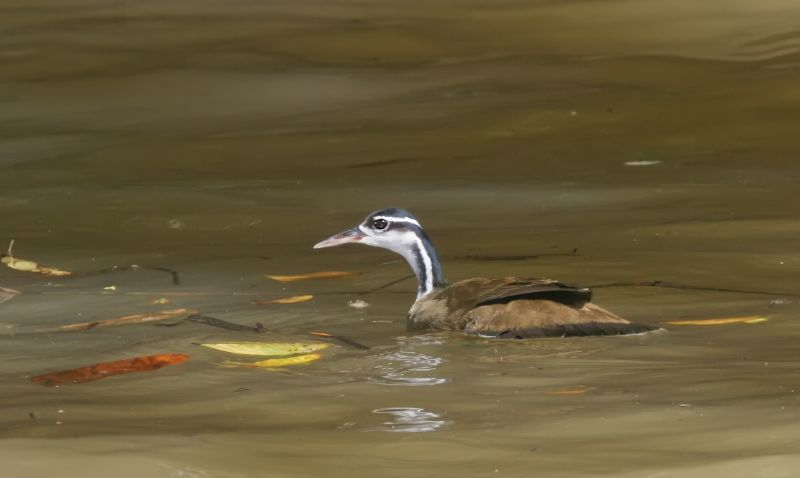
Wikipedia: Sungrebe Source: OTHER
Sungrebe.jpg
![]() The sungrebe (Heliornis fulica) is a small aquatic gruiforme found in the tropical and subtropical Americas from northeastern Mexico to central Ecuador and southern Brazil.[2]
[more]
The sungrebe (Heliornis fulica) is a small aquatic gruiforme found in the tropical and subtropical Americas from northeastern Mexico to central Ecuador and southern Brazil.[2]
[more]
Roadside hawk. 2020-02-19 10.02.22 Panama
First observed in Guatemala on 2018-02-07.
We saw this on the Pipeline Road near Gamboa, Panama - see tiger heron for more on that.
General: ![]() The roadside hawk (Rupornis magnirostris) is a relatively small bird of prey found in America. This vocal species is often the most common raptor in its range. It has many subspecies and is now usually placed in the monotypic genus Rupornis instead of Buteo.[2]
[more]
The roadside hawk (Rupornis magnirostris) is a relatively small bird of prey found in America. This vocal species is often the most common raptor in its range. It has many subspecies and is now usually placed in the monotypic genus Rupornis instead of Buteo.[2]
[more]
Profile Wikipedia eBird Audubon AllAboutBirds Xeno-Canto

Wikipedia: Short-tailed hawk Source: OTHER
Buteo_brachyurus_-Manduri%2C_Sao_Paulo%2C_Brazil_-flying-8.jpg
![]() The short-tailed hawk (Buteo brachyurus) is an American bird of prey in the family Accipitridae, which also includes the eagles and Old World vultures. As a member of the genus Buteo, it is not a true hawk and thus also referred to as a "buteo" or (outside North America) "buzzard". The white-throated hawk (B. albigula) is a close relative and was formerly included in the species B. brachyurus.
[more]
The short-tailed hawk (Buteo brachyurus) is an American bird of prey in the family Accipitridae, which also includes the eagles and Old World vultures. As a member of the genus Buteo, it is not a true hawk and thus also referred to as a "buteo" or (outside North America) "buzzard". The white-throated hawk (B. albigula) is a close relative and was formerly included in the species B. brachyurus.
[more]
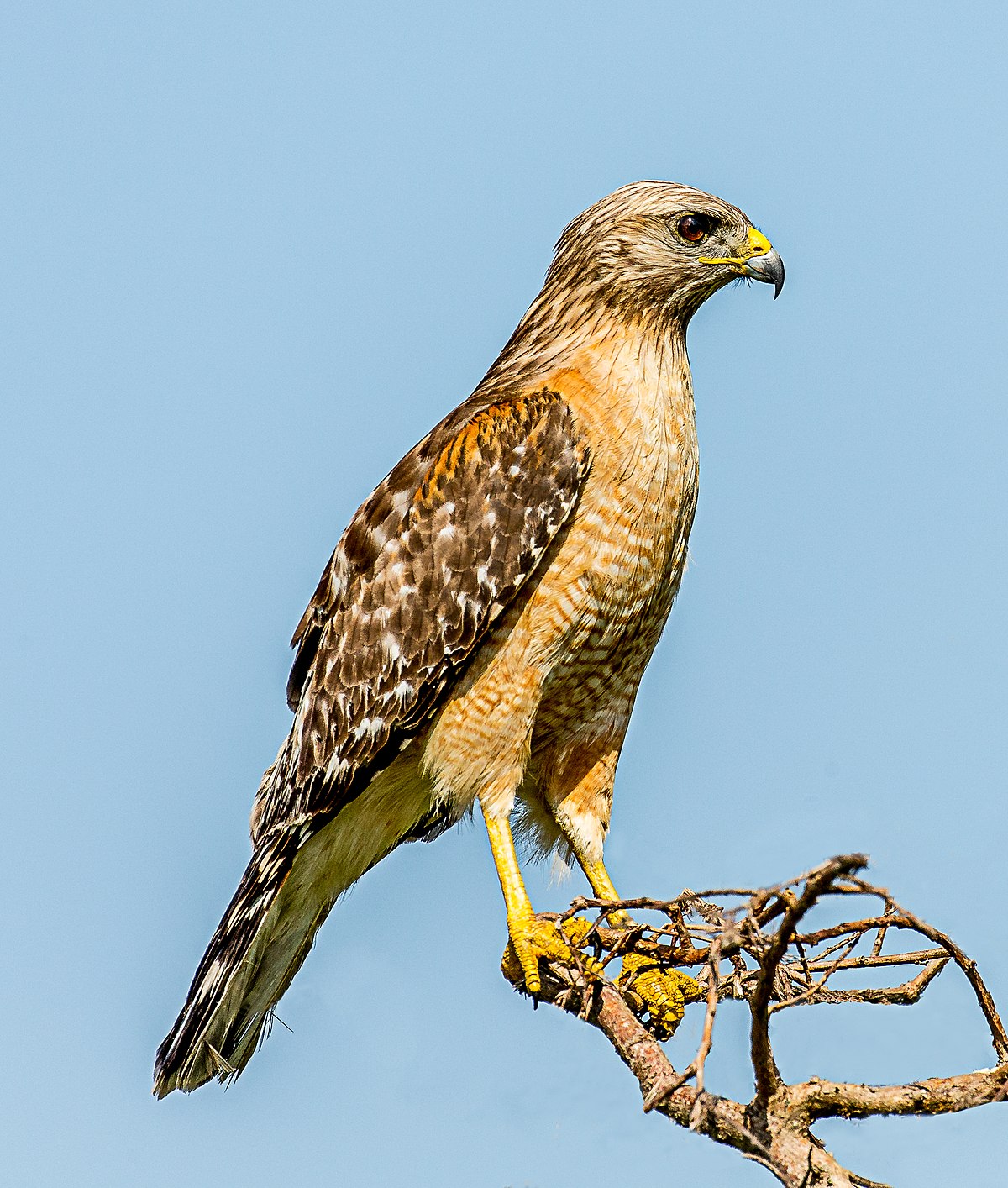
Wikipedia: Red-shouldered hawk Source: OTHER
1200px-Red-shouldered_Hawk_%28Buteo_lineatus%29_-_Blue_Cypress_Lake%2C_Florida.jpg
![]() The red-shouldered hawk (Buteo lineatus) is a medium-sized hawk. Its breeding range spans eastern North America and along the coast of California and northern to northeastern-central Mexico. It is a permanent resident throughout most of its range, though northern birds do migrate, mostly to central Mexico. The main conservation threat to the widespread species is deforestation.
[more]
The red-shouldered hawk (Buteo lineatus) is a medium-sized hawk. Its breeding range spans eastern North America and along the coast of California and northern to northeastern-central Mexico. It is a permanent resident throughout most of its range, though northern birds do migrate, mostly to central Mexico. The main conservation threat to the widespread species is deforestation.
[more]
Red-tailed hawk at Cromwell. 2022-04-29 12.30.10 Maryland
First observed in Maryland on 2022-04-29.
![]() The red-tailed hawk (Buteo jamaicensis) is a bird of prey that breeds throughout most of North America, from the interior of Alaska and northern Canada to as far south as Panama and the West Indies. It is one of the most common members within the genus of Buteo in North America or worldwide.[2] The red-tailed hawk is one of three species colloquially known in the United States as the "chickenhawk", though it rarely preys on standard-sized chickens.[3] The bird is sometimes also referred to as the red-tail for short, when the meaning is clear in context. Red-tailed hawks can acclimate to all the biomes within their range, occurring on the edges of non-ideal habitats such as dense forests and sandy deserts.[4] The red-tailed hawk occupies a wide range of habitats and altitudes including deserts, grasslands, coniferous and deciduous forests, agricultural fields and urban areas. Its latitudinal limits fall around the tree line in the Arctic and the species is absent from the high Arctic. It is legally protected in Canada, Mexico, and the United States by the Migratory Bird Treaty Act.
[more]
The red-tailed hawk (Buteo jamaicensis) is a bird of prey that breeds throughout most of North America, from the interior of Alaska and northern Canada to as far south as Panama and the West Indies. It is one of the most common members within the genus of Buteo in North America or worldwide.[2] The red-tailed hawk is one of three species colloquially known in the United States as the "chickenhawk", though it rarely preys on standard-sized chickens.[3] The bird is sometimes also referred to as the red-tail for short, when the meaning is clear in context. Red-tailed hawks can acclimate to all the biomes within their range, occurring on the edges of non-ideal habitats such as dense forests and sandy deserts.[4] The red-tailed hawk occupies a wide range of habitats and altitudes including deserts, grasslands, coniferous and deciduous forests, agricultural fields and urban areas. Its latitudinal limits fall around the tree line in the Arctic and the species is absent from the high Arctic. It is legally protected in Canada, Mexico, and the United States by the Migratory Bird Treaty Act.
[more]
Profile Wikipedia eBird Audubon AllAboutBirds Xeno-Canto

Wikipedia: Zone-tailed hawk Source: OTHER
1200px-229_-_ZONE-TAILED_HAWK_%284-11-2015%29_blue_haven_road%2C_patagonia%2C_santa_cruz_co%2C_az_-02_%2816906279787%29.jpg
![]() The zone-tailed hawk (Buteo albonotatus) is a medium-sized hawk of warm, dry parts of the Americas. It is somewhat similar in plumage and flight style to a common scavenger, the turkey vulture, and may benefit from being able to blend into groups of vultures. It feeds on small terrestrial tetrapods of all kinds.
[more]
The zone-tailed hawk (Buteo albonotatus) is a medium-sized hawk of warm, dry parts of the Americas. It is somewhat similar in plumage and flight style to a common scavenger, the turkey vulture, and may benefit from being able to blend into groups of vultures. It feeds on small terrestrial tetrapods of all kinds.
[more]
Profile Wikipedia eBird Audubon AllAboutBirds Xeno-Canto

Wikipedia: Gray hawk Source: OTHER
Buteo_plagiatus_Belize.jpg
![]() The gray hawk (Buteo plagiatus) or Mexican goshawk[2] is a smallish raptor found in open country and forest edges. It is sometimes placed in the genus Asturina as Asturina plagiata. The species was split by the American Ornithological Society (AOU) from the gray-lined hawk. The gray hawk is found from Costa Rica north into the southwestern United States.
[more]
The gray hawk (Buteo plagiatus) or Mexican goshawk[2] is a smallish raptor found in open country and forest edges. It is sometimes placed in the genus Asturina as Asturina plagiata. The species was split by the American Ornithological Society (AOU) from the gray-lined hawk. The gray hawk is found from Costa Rica north into the southwestern United States.
[more]
Coopers hawk. 2022-05-07 14.20.04 Maryland
First observed in Maryland on 2022-05-07.
![]() Cooper's hawk (Accipiter cooperii) is a medium-sized hawk native to the North American continent and found from southern Canada to Mexico.[2] This species is a member of the genus Accipiter, sometimes referred to as true hawks, which are famously agile, relatively small hawks common to wooded habitats around the world and also the most diverse of all diurnal raptor genera.[2] As in many birds of prey, the male is smaller than the female.[3] The birds found east of the Mississippi River tend to be larger on average than the birds found to the west.[4] It is easily confused with the smaller but similar Sharp-shinned hawk.
[more]
Cooper's hawk (Accipiter cooperii) is a medium-sized hawk native to the North American continent and found from southern Canada to Mexico.[2] This species is a member of the genus Accipiter, sometimes referred to as true hawks, which are famously agile, relatively small hawks common to wooded habitats around the world and also the most diverse of all diurnal raptor genera.[2] As in many birds of prey, the male is smaller than the female.[3] The birds found east of the Mississippi River tend to be larger on average than the birds found to the west.[4] It is easily confused with the smaller but similar Sharp-shinned hawk.
[more]
Profile Wikipedia eBird A-Z Animals Audubon AllAboutBirds Xeno-Canto

Wikipedia: Sharp-shinned hawk Source: OTHER
1200px-Accipiter_striatus%2C_Canet_Road%2C_San_Luis_Obispo_1.jpg
![]() A. s. chionogaster
A. s. chionogaster
A. s. erythronemius
A. s. fringilloides
A. s. madrensis
A. s. perobscurus
A. s. striatus
A. s. suttoni
A. s. velox
A. s. venator
A. s. ventralis
[more]

Wikipedia: Bicolored hawk Source: OTHER
1200px-Bicoloured_Hawk_%28Accipiter_bicolor%29_with_prey.jpg
![]() The bicolored hawk (Accipiter bicolor) is a species of bird of prey in the family Accipitridae. It is found in forest, woodland, second growth, plantations, and wooded savanna in southeastern Mexico, Central America, and northern and central South America (as far south as northern Argentina).[3] Though generally uncommon, it is the most common species of Accipiter in most of its range, but it does not occur at altitudes above 2,700 metres (8,900 ft) such as the highest parts of the Andes.[4]
[more]
The bicolored hawk (Accipiter bicolor) is a species of bird of prey in the family Accipitridae. It is found in forest, woodland, second growth, plantations, and wooded savanna in southeastern Mexico, Central America, and northern and central South America (as far south as northern Argentina).[3] Though generally uncommon, it is the most common species of Accipiter in most of its range, but it does not occur at altitudes above 2,700 metres (8,900 ft) such as the highest parts of the Andes.[4]
[more]
Profile Wikipedia eBird Audubon AllAboutBirds Xeno-Canto

Wikipedia: Snail kite Source: OTHER
1200px-Schneckenweih-Snail-Kite.JPG
![]() The snail kite (Rostrhamus sociabilis) is a bird of prey within the family Accipitridae, which also includes the eagles, hawks, and Old World vultures. Its relative, the slender-billed kite, is now again placed in Helicolestes, making the genus Rostrhamus monotypic. Usually, it is placed in the milvine kites, but the validity of that group is under investigation.
[more]
The snail kite (Rostrhamus sociabilis) is a bird of prey within the family Accipitridae, which also includes the eagles, hawks, and Old World vultures. Its relative, the slender-billed kite, is now again placed in Helicolestes, making the genus Rostrhamus monotypic. Usually, it is placed in the milvine kites, but the validity of that group is under investigation.
[more]
Profile Wikipedia eBird Audubon AllAboutBirds Xeno-Canto

Wikipedia: Swallow-tailed kite Source: OTHER
1200px-Swallow-tailed_Kite_%2834163638494%29.jpg
![]() The swallow-tailed kite (Elanoides forficatus) is a pernine raptor which breeds from the southeastern United States to eastern Peru and northern Argentina. It is the only species in the genus Elanoides. Most North and Central American breeders winter in South America where the species is resident year round.
[more]
The swallow-tailed kite (Elanoides forficatus) is a pernine raptor which breeds from the southeastern United States to eastern Peru and northern Argentina. It is the only species in the genus Elanoides. Most North and Central American breeders winter in South America where the species is resident year round.
[more]
Profile Wikipedia eBird Xeno-Canto
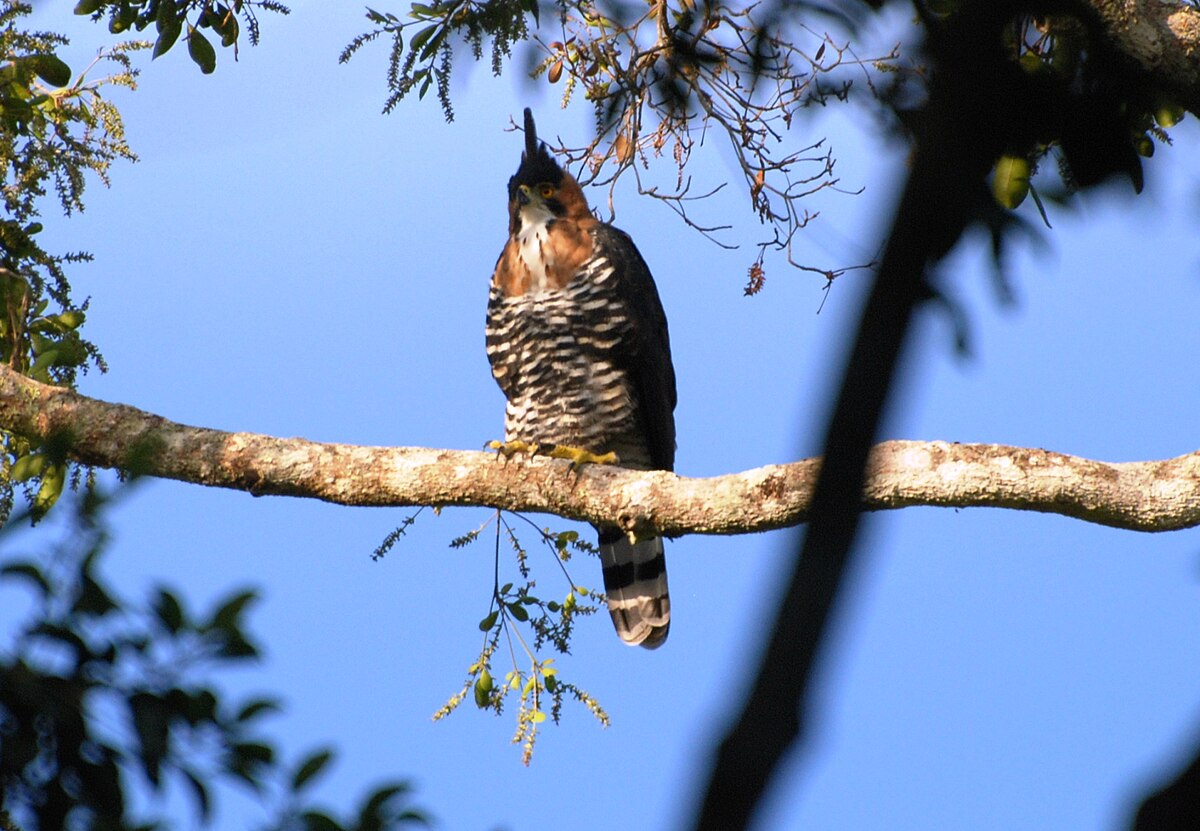
Wikipedia: Ornate hawk-eagle Source: OTHER
1200px-Calakmul_Adler.JPG
![]() The ornate hawk-eagle (Spizaetus ornatus) is a fairly large bird of prey from the tropical Americas. Formerly, some authorities referred to this species as the crested hawk-eagle, a name that may cause some confusion as it is more commonly used for an Asian eagle species.[3] Like all eagles, it is in the family Accipitridae. This species has a feathered tarsus that marks it as a member of the Aquilinae or booted eagle subfamily.[4] This species is notable for the vivid colors and bold markings of adults, which differ considerably from the far more whitish plumage of the juvenile bird.[5] The ornate hawk-eagle ranges from central Mexico south through much of Central America and in a somewhat spotty but broad overall range into South America, including in the west apart from the Andes and broadly on the Atlantic side especially Brazil down to as far as Southeast Brazil and northern Argentina.[1][6] This species is found largely in primary forests with tall trees, although can be found in many forest types.[6] The ornate hawk-eagle female lays almost always a single egg and the species has a fairly prolonged breeding cycle like many tropical raptors, especially due to a lengthy post-fledging stage on which juveniles are dependent on their parents.[7] It is a diversified and exceptionally powerful predator which takes a range of prey, usually various medium-to-large-sized birds and small-to-medium-sized mammals as well as occasional reptiles.[8] Like many forest-dependent raptors, especially those in the tropical and subtropical regions, this species is likely under the pressing threat of deforestation. The decline of forest habitat in this species range, especially the Amazon rainforest, led the IUCN to uplist the ornate hawk-eagle as Near Threatened in 2016.[1]
[more]
The ornate hawk-eagle (Spizaetus ornatus) is a fairly large bird of prey from the tropical Americas. Formerly, some authorities referred to this species as the crested hawk-eagle, a name that may cause some confusion as it is more commonly used for an Asian eagle species.[3] Like all eagles, it is in the family Accipitridae. This species has a feathered tarsus that marks it as a member of the Aquilinae or booted eagle subfamily.[4] This species is notable for the vivid colors and bold markings of adults, which differ considerably from the far more whitish plumage of the juvenile bird.[5] The ornate hawk-eagle ranges from central Mexico south through much of Central America and in a somewhat spotty but broad overall range into South America, including in the west apart from the Andes and broadly on the Atlantic side especially Brazil down to as far as Southeast Brazil and northern Argentina.[1][6] This species is found largely in primary forests with tall trees, although can be found in many forest types.[6] The ornate hawk-eagle female lays almost always a single egg and the species has a fairly prolonged breeding cycle like many tropical raptors, especially due to a lengthy post-fledging stage on which juveniles are dependent on their parents.[7] It is a diversified and exceptionally powerful predator which takes a range of prey, usually various medium-to-large-sized birds and small-to-medium-sized mammals as well as occasional reptiles.[8] Like many forest-dependent raptors, especially those in the tropical and subtropical regions, this species is likely under the pressing threat of deforestation. The decline of forest habitat in this species range, especially the Amazon rainforest, led the IUCN to uplist the ornate hawk-eagle as Near Threatened in 2016.[1]
[more]
Profile Wikipedia eBird Xeno-Canto

Wikipedia: Black hawk-eagle Source: OTHER
1200px-Gavi%C3%A3o-pega-macaco_%28Spizaetus_tyrannus%29.jpg
![]() The black hawk-eagle (Spizaetus tyrannus), also known as the tyrant hawk-eagle,[3] is a species of eagle found from central Mexico through Central America[4] into Colombia, eastern Peru, the south of Brazil, and as far as northern Argentina.[5] There are two known subspecies, S.t. tyrannus, which is found in Southeastern Brazil and Northeastern Argentina, and the slightly smaller S. t. serus, which can be found elsewhere throughout the species' range.[6] Its preferred habitats include humid and moist forests close to rivers, and several types of woodland.[7] It is uncommon to fairly common throughout most of its range. Its closest relative is the ornate hawk-eagle, which is similar in size, appearance and behavior but lives at lower elevations.
[more]
The black hawk-eagle (Spizaetus tyrannus), also known as the tyrant hawk-eagle,[3] is a species of eagle found from central Mexico through Central America[4] into Colombia, eastern Peru, the south of Brazil, and as far as northern Argentina.[5] There are two known subspecies, S.t. tyrannus, which is found in Southeastern Brazil and Northeastern Argentina, and the slightly smaller S. t. serus, which can be found elsewhere throughout the species' range.[6] Its preferred habitats include humid and moist forests close to rivers, and several types of woodland.[7] It is uncommon to fairly common throughout most of its range. Its closest relative is the ornate hawk-eagle, which is similar in size, appearance and behavior but lives at lower elevations.
[more]
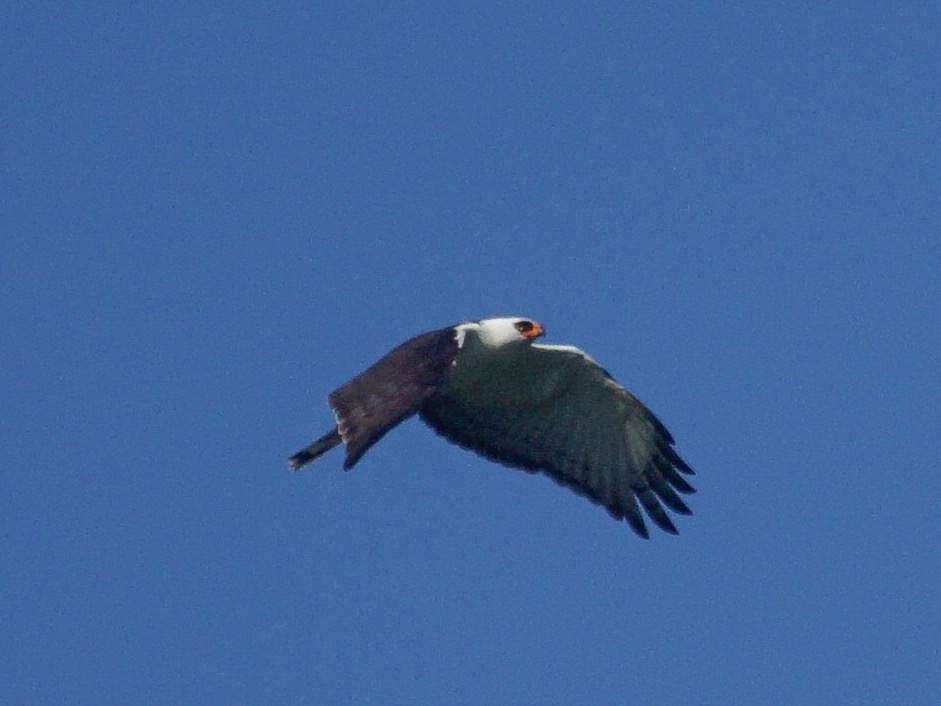
Wikipedia: Black-and-white hawk-eagle Source: OTHER
Black-and-white_Hawk-Eagle.jpg
![]() The black-and-white hawk-eagle (Spizaetus melanoleucus, formerly Spizastur melanoleucus) is a bird of prey species in the eagle and hawk family (Accipitridae). It is found throughout a large part of tropical America, from southern Mexico to northern Argentina.[2]
[more]
The black-and-white hawk-eagle (Spizaetus melanoleucus, formerly Spizastur melanoleucus) is a bird of prey species in the eagle and hawk family (Accipitridae). It is found throughout a large part of tropical America, from southern Mexico to northern Argentina.[2]
[more]
MerlinBirdID suggests common black hawk, flamingo tour near Rio Lagartos. 2023-04-15 08.40.26 Yucatan
First observed in Yucatan on 2023-04-15.
![]() The common black hawk (Buteogallus anthracinus) is a bird of prey in the family Accipitridae, which also includes the eagles, hawks, and Old World vultures. It formerly included the Cuban black-hawk (Buteogallus gundlachii) as a subspecies. The mangrove black hawk, traditionally considered a distinct species, is now generally considered a subspecies, B. a. subtilis, of the common black-hawk.[3]
[more]
The common black hawk (Buteogallus anthracinus) is a bird of prey in the family Accipitridae, which also includes the eagles, hawks, and Old World vultures. It formerly included the Cuban black-hawk (Buteogallus gundlachii) as a subspecies. The mangrove black hawk, traditionally considered a distinct species, is now generally considered a subspecies, B. a. subtilis, of the common black-hawk.[3]
[more]

Wikipedia: Great black-hawk Source: OTHER
1200px-Buteogallus_urubitinga_NBII.jpg
![]() The great black hawk (Buteogallus urubitinga) is a bird of prey in the family Accipitridae, which also includes the eagles, hawks, and Old World vultures.
[more]
The great black hawk (Buteogallus urubitinga) is a bird of prey in the family Accipitridae, which also includes the eagles, hawks, and Old World vultures.
[more]

Wikipedia: Black-collared hawk Source: OTHER
1200px-Black-collared_hawk_%28Busarellus_nigricollis%29_adult.jpg
![]() The black-collared hawk (Busarellus nigricollis) is a species of bird of prey in the family Accipitridae. It is monotypic within the genus Busarellus.[3] It has a widespread range of presence, from western Mexico to Uruguay. Its natural habitats are subtropical or tropical moist lowland forests, subtropical or tropical swamps, and swamps.[1]
[more]
The black-collared hawk (Busarellus nigricollis) is a species of bird of prey in the family Accipitridae. It is monotypic within the genus Busarellus.[3] It has a widespread range of presence, from western Mexico to Uruguay. Its natural habitats are subtropical or tropical moist lowland forests, subtropical or tropical swamps, and swamps.[1]
[more]
Profile Wikipedia eBird Audubon AllAboutBirds Xeno-Canto

Wikipedia: White-tailed kite Source: OTHER
1200px-Elanus_leucurus_3.jpg
![]() The white-tailed kite (Elanus leucurus) is a small raptor found in western North America and parts of South America.
[more]
The white-tailed kite (Elanus leucurus) is a small raptor found in western North America and parts of South America.
[more]
Profile Wikipedia eBird Audubon AllAboutBirds Xeno-Canto

Wikipedia: Hook-billed kite Source: OTHER
1200px-Chondrohierax_uncinatus_76608753.jpg
![]() The hook-billed kite (Chondrohierax uncinatus), is a bird of prey in the family Accipitridae, which also includes many other diurnal raptors such as kites, eagles, and harriers. It occurs in the Americas, including the Rio Grande Valley of Texas in the United States, Mexico, the Caribbean, Central America, and tropical South America.
[more]
The hook-billed kite (Chondrohierax uncinatus), is a bird of prey in the family Accipitridae, which also includes many other diurnal raptors such as kites, eagles, and harriers. It occurs in the Americas, including the Rio Grande Valley of Texas in the United States, Mexico, the Caribbean, Central America, and tropical South America.
[more]
Profile Wikipedia eBird Xeno-Canto
Wikipedia: Gray-headed kite Source: OTHER
Leptodon_cayannensis_-_Gray-headed_kite.JPG
![]() The gray-headed kite (Leptodon cayanensis) is a raptor found in open woodland and swamp forests. It shares the genus Leptodon with the extremely rare white-collared kite. It breeds from eastern Mexico and Trinidad south to Peru, Bolivia, Brazil and northern Argentina.
[more]
The gray-headed kite (Leptodon cayanensis) is a raptor found in open woodland and swamp forests. It shares the genus Leptodon with the extremely rare white-collared kite. It breeds from eastern Mexico and Trinidad south to Peru, Bolivia, Brazil and northern Argentina.
[more]
Profile Wikipedia eBird Xeno-Canto

Wikipedia: Plumbeous kite Source: OTHER
1200px-Ictinia_plumbea_-Mato_Grosso_do_Sul%2C_Brazil-8.jpg
![]() The plumbeous kite (Ictinia plumbea) is a bird of prey in the family Accipitridae.
[more]
The plumbeous kite (Ictinia plumbea) is a bird of prey in the family Accipitridae.
[more]
Profile Wikipedia eBird Xeno-Canto

Wikipedia: Crane hawk Source: OTHER
Crane_hawk_%28Geranospiza_caerulescens%29.jpg
![]() The crane hawk (Geranospiza caerulescens) is a species of bird of prey in the family Accipitridae. It is monotypic within the genus Geranospiza.[2]
[more]
The crane hawk (Geranospiza caerulescens) is a species of bird of prey in the family Accipitridae. It is monotypic within the genus Geranospiza.[2]
[more]
Profile Wikipedia eBird Xeno-Canto
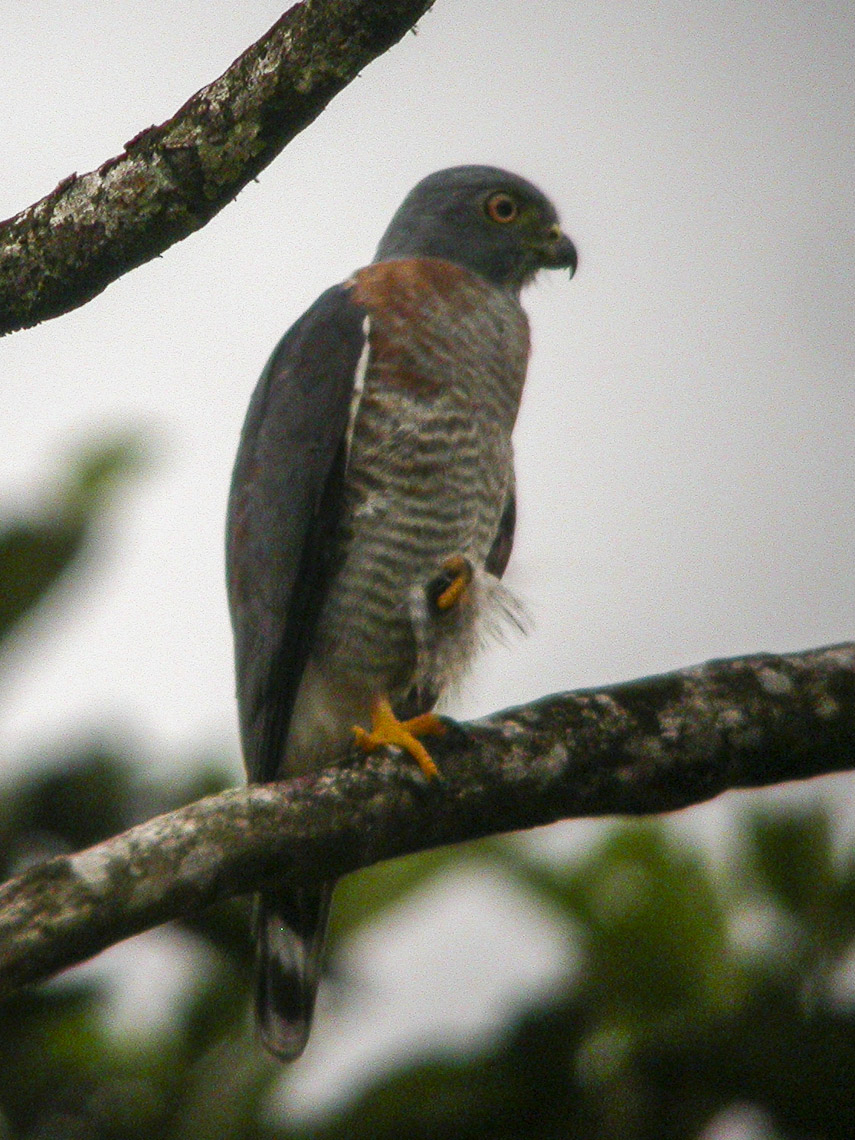
Wikipedia: Double-toothed kite Source: OTHER
Double-tooth_Kite_-_Choco_-_Ecuador.jpg
![]() The double-toothed kite (Harpagus bidentatus) is a species of bird of prey in the family Accipitridae. It is found in Belize, Bolivia, Brazil, Colombia, Costa Rica, Ecuador, El Salvador, French Guiana, Guatemala, Guyana, Honduras, Mexico, Nicaragua, Panama, Peru, Suriname, Trinidad and Tobago, and Venezuela.[1]
[more]
The double-toothed kite (Harpagus bidentatus) is a species of bird of prey in the family Accipitridae. It is found in Belize, Bolivia, Brazil, Colombia, Costa Rica, Ecuador, El Salvador, French Guiana, Guatemala, Guyana, Honduras, Mexico, Nicaragua, Panama, Peru, Suriname, Trinidad and Tobago, and Venezuela.[1]
[more]
Turkey vulture / Truthahngeier (Cathartes aura)
Turkey vulture. 2022-04-29 11.39.28 Maryland
First observed in Costa Rica on 2018-02-28.
![]() The turkey vulture (Cathartes aura), also known in some North American regions as the turkey buzzard (or just buzzard), and in some areas of the Caribbean as the John crow or carrion crow,[2] is the most widespread of the New World vultures.[3] One of three species in the genus Cathartes of the family Cathartidae, the turkey vulture ranges from southern Canada to the southernmost tip of South America. It inhabits a variety of open and semi-open areas, including subtropical forests, shrublands, pastures, and deserts.[1]
[more]
The turkey vulture (Cathartes aura), also known in some North American regions as the turkey buzzard (or just buzzard), and in some areas of the Caribbean as the John crow or carrion crow,[2] is the most widespread of the New World vultures.[3] One of three species in the genus Cathartes of the family Cathartidae, the turkey vulture ranges from southern Canada to the southernmost tip of South America. It inhabits a variety of open and semi-open areas, including subtropical forests, shrublands, pastures, and deserts.[1]
[more]
Lesser yellow-headed vulture / Kleiner Gelbkopfgeier (Cathartes burrovianus)
Profile Wikipedia eBird Xeno-Canto
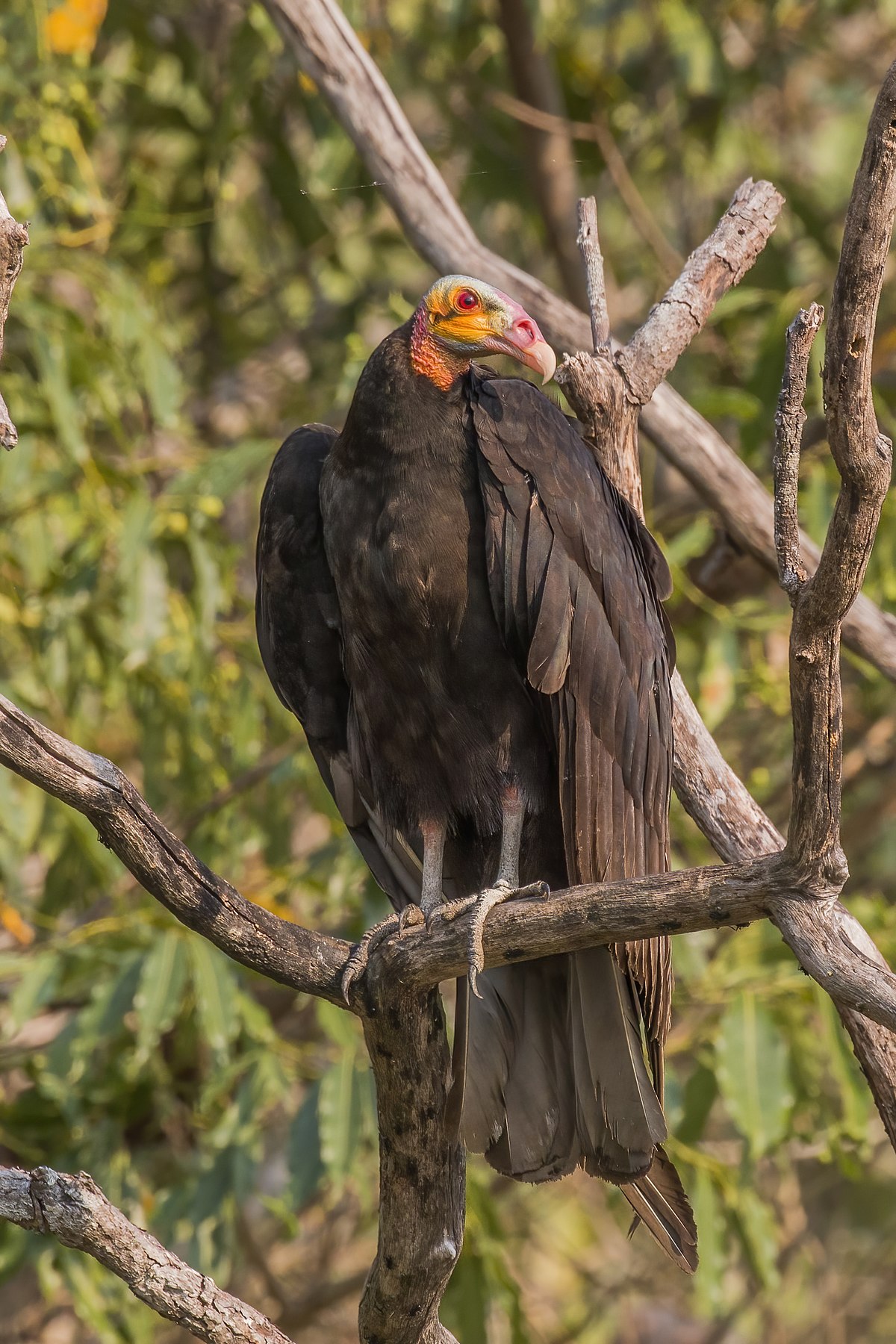
Wikipedia: Lesser yellow-headed vulture Source: OTHER
1200px-Lesser_yellow-headed_vulture_%28Cathartes_burrovianus%29.JPG
![]() The lesser yellow-headed vulture (Cathartes burrovianus) also known as the savannah vulture,[2] is a species of bird in the New World vulture family Cathartidae. It was considered to be the same species as the greater yellow-headed vulture until they were split in 1964.[3] It is found in Mexico, Central America, and South America in seasonally wet or flooded lowland grassland, swamps, and heavily degraded former forest. It is a large bird, with a wingspan of 150–165 cm (59–65 in). The body plumage is black, and the head and neck, which are featherless, are pale orange with red or blue areas. It lacks a syrinx, so therefore its vocalizations are limited to grunts or low hisses.
[more]
The lesser yellow-headed vulture (Cathartes burrovianus) also known as the savannah vulture,[2] is a species of bird in the New World vulture family Cathartidae. It was considered to be the same species as the greater yellow-headed vulture until they were split in 1964.[3] It is found in Mexico, Central America, and South America in seasonally wet or flooded lowland grassland, swamps, and heavily degraded former forest. It is a large bird, with a wingspan of 150–165 cm (59–65 in). The body plumage is black, and the head and neck, which are featherless, are pale orange with red or blue areas. It lacks a syrinx, so therefore its vocalizations are limited to grunts or low hisses.
[more]
Black vulture / Rabengeier (Coragyps atratus)
Black vulture at cenote xxx. 2023-04-14 13.13.52 Yucatan
First observed in Yucatan on 2023-04-14.
![]() The black vulture (Coragyps atratus), also known as the American black vulture, is a bird in the New World vulture family whose range extends from the northeastern United States to Peru, Central Chile and Uruguay in South America. Although a common and widespread species, it has a somewhat more restricted distribution than its compatriot, the turkey vulture, which breeds well into Canada and south to Tierra del Fuego. It is the only extant member of the genus Coragyps, which is in the family Cathartidae. Despite the similar name and appearance, this species is unrelated to the Eurasian black vulture, an Old World vulture in the family Accipitridae (which includes eagles, hawks, kites, and harriers). It inhabits relatively open areas which provide scattered forests or shrublands. With a wingspan of 1.5 m (4.9 ft), the black vulture is a large bird though relatively small for a vulture. It has black plumage, a featherless, grayish-black head and neck, and a short, hooked beak.
[more]
The black vulture (Coragyps atratus), also known as the American black vulture, is a bird in the New World vulture family whose range extends from the northeastern United States to Peru, Central Chile and Uruguay in South America. Although a common and widespread species, it has a somewhat more restricted distribution than its compatriot, the turkey vulture, which breeds well into Canada and south to Tierra del Fuego. It is the only extant member of the genus Coragyps, which is in the family Cathartidae. Despite the similar name and appearance, this species is unrelated to the Eurasian black vulture, an Old World vulture in the family Accipitridae (which includes eagles, hawks, kites, and harriers). It inhabits relatively open areas which provide scattered forests or shrublands. With a wingspan of 1.5 m (4.9 ft), the black vulture is a large bird though relatively small for a vulture. It has black plumage, a featherless, grayish-black head and neck, and a short, hooked beak.
[more]
King vulture / Königsgeier (Sarcoramphus papa)

Wikipedia: King vulture Source: OTHER
1200px-Sarcoramphus_papa_-National_Zoo_-Washington_-USA-8a.jpg
![]() The king vulture (Sarcoramphus papa) is a large bird found in Central and South America. It is a member of the New World vulture family Cathartidae. This vulture lives predominantly in tropical lowland forests stretching from southern Mexico to northern Argentina. It is the only surviving member of the genus Sarcoramphus, although fossil members are known.
[more]
The king vulture (Sarcoramphus papa) is a large bird found in Central and South America. It is a member of the New World vulture family Cathartidae. This vulture lives predominantly in tropical lowland forests stretching from southern Mexico to northern Argentina. It is the only surviving member of the genus Sarcoramphus, although fossil members are known.
[more]
Osprey / Fischadler (Pandion haliaetus)
Osprey in flight. 2023-09-27 12.22.08 Florida
First observed in Yucatan on 2023-04-21.
This bird appears across the great seas in the following continents:
Europe, North America, South America, Africa, Asia.
![]() Falco haliaetus Linnaeus, 1758
[more]
Falco haliaetus Linnaeus, 1758
[more]
Calls: ![]() Calls with sequences of short, soft and clear whistling notes. Often in series with rising pitch, then ending with a few lower pitched notes. [Link]
Calls with sequences of short, soft and clear whistling notes. Often in series with rising pitch, then ending with a few lower pitched notes. [Link]
Physical details: length=55-58 cm,
wingspan=145-170 cm,
weight=1120-2050 g
Habitats:
Agricultural
Call:
Automatically generated from Xeno-Canto recording
♫ 2023-10-12 15 55 surprising sound of an osprey. 2023-10-12 15.55.00 New England (song?)
Profile Wikipedia eBird Xeno-Canto
La tarde great tinamou tenative ID by MerlinBirdID. 2018-03-09 12.58.40 Costa Rica
First observed in Costa Rica on 2018-03-09.
General: ![]() The great tinamou (Tinamus major) is a species of tinamou ground bird native to Central and South America. There are several subspecies, mostly differentiated by their coloration.
[more]
The great tinamou (Tinamus major) is a species of tinamou ground bird native to Central and South America. There are several subspecies, mostly differentiated by their coloration.
[more]
Profile Wikipedia eBird Xeno-Canto

Wikipedia: Thicket tinamou Source: OTHER
1200px-CrypturusSallceiSmit.jpg
![]() The thicket tinamou or rufescent tinamou (Crypturellus cinnamomeus) is a type of tinamou commonly found in moist forests in subtropical and tropical central Mexico.[4]
[more]
The thicket tinamou or rufescent tinamou (Crypturellus cinnamomeus) is a type of tinamou commonly found in moist forests in subtropical and tropical central Mexico.[4]
[more]
Profile Wikipedia eBird Xeno-Canto

Wikipedia: Little tinamou Source: OTHER
Crypturellus_soui.jpg
![]() The little tinamou (Crypturellus soui) is a species of tinamou. It is found in Central and South America.[4]
[more]
The little tinamou (Crypturellus soui) is a species of tinamou. It is found in Central and South America.[4]
[more]
Profile Wikipedia eBird Audubon AllAboutBirds Xeno-Canto

Wikipedia: Wood stork Source: OTHER
1200px-Wood_stork_%28Mycteria_americana%29_and_Yacare_caiman.jpg
![]() The wood stork (Mycteria americana) is a large American wading bird in the family Ciconiidae (storks). It was formerly called the "wood ibis", though it is not an ibis. It is found in subtropical and tropical habitats in the Americas, including the Caribbean. In South America, it is resident, but in North America, it may disperse as far as Florida. Originally described by Carl Linnaeus in 1758, this stork likely evolved in tropical regions. The head and neck are bare of feathers, and dark grey in colour.[2] The plumage is mostly white, with the exception of the tail and some of the wing feathers, which are black with a greenish-purplish sheen. The juvenile differs from the adult, with the former having a feathered head and a yellow bill, compared to the black adult bill. There is little sexual dimorphism.
[more]
The wood stork (Mycteria americana) is a large American wading bird in the family Ciconiidae (storks). It was formerly called the "wood ibis", though it is not an ibis. It is found in subtropical and tropical habitats in the Americas, including the Caribbean. In South America, it is resident, but in North America, it may disperse as far as Florida. Originally described by Carl Linnaeus in 1758, this stork likely evolved in tropical regions. The head and neck are bare of feathers, and dark grey in colour.[2] The plumage is mostly white, with the exception of the tail and some of the wing feathers, which are black with a greenish-purplish sheen. The juvenile differs from the adult, with the former having a feathered head and a yellow bill, compared to the black adult bill. There is little sexual dimorphism.
[more]

Wikipedia: Jabiru stork Source: OTHER
1200px-Jabiru_%28Jabiru_mycteria%29_2.JPG
![]() The jabiru (/ˌdʒæbɪˈruː/ or /ˈdʒæbɪruː/; Latin: Jabiru mycteria) is a large stork found in the Americas from Mexico to Argentina, except west of the Andes. It sometimes wanders into the United States, usually in Texas, but has been reported as far north as Mississippi. It is most common in the Pantanal region of Brazil and the Eastern Chaco region of Paraguay. It is the only member of the genus Jabiru. The name comes from a Tupi–Guaraní language and means "swollen neck".
[more]
The jabiru (/ˌdʒæbɪˈruː/ or /ˈdʒæbɪruː/; Latin: Jabiru mycteria) is a large stork found in the Americas from Mexico to Argentina, except west of the Andes. It sometimes wanders into the United States, usually in Texas, but has been reported as far north as Mississippi. It is most common in the Pantanal region of Brazil and the Eastern Chaco region of Paraguay. It is the only member of the genus Jabiru. The name comes from a Tupi–Guaraní language and means "swollen neck".
[more]
Rock doves aka common pigeons on the move. 2023-06-19 07.39.10 Bolle di Magadino
First observed in 🇨🇭 on 2023-06-19.
This bird appears across the great seas in the following continents:
Europe, North America, South America, Africa, Asia.
![]() The rock dove, rock pigeon, or common pigeon (/ˈpɪdʒ.ən/ also /ˈpɪdʒ.ɪn/; Columba livia) is a member of the bird family Columbidae (doves and pigeons).[3]:624 In common usage, this bird is often simply referred to as the "pigeon".
[more]
The rock dove, rock pigeon, or common pigeon (/ˈpɪdʒ.ən/ also /ˈpɪdʒ.ɪn/; Columba livia) is a member of the bird family Columbidae (doves and pigeons).[3]:624 In common usage, this bird is often simply referred to as the "pigeon".
[more]
Vocalization: ![]() Not loud. [Link]
Not loud. [Link]
Song: ![]() Song a two-syllable, but continuous cooing. First a rolling ascending "orrrrrr" immediately followed by a short descending "oohh". Wings produce a quite audible whistling sound. [Link]
Song a two-syllable, but continuous cooing. First a rolling ascending "orrrrrr" immediately followed by a short descending "oohh". Wings produce a quite audible whistling sound. [Link]
Physical details: length=31-34 cm,
wingspan=63-70 cm,
weight=230-370 g
Habitats:
Settlement
Didn't recognize this collared dove ...so I annotated it with the characteristics I should have recognized 2021-02-01 13.14.42 Luppmen
First observed in 🇨🇭 on 2020-05-21.
This bird appears across the great seas in the following continents:
Europe, North America (introduced), Africa, Asia (introduced).
General: ![]() The Eurasian collared dove (Streptopelia decaocto) is a dove species native to Europe and Asia; it was introduced to Japan, North America and islands in the Caribbean. Because of its vast global range and increasing population trend, it has been listed as Least Concern on the IUCN Red List since 2014.[1]
[more]
The Eurasian collared dove (Streptopelia decaocto) is a dove species native to Europe and Asia; it was introduced to Japan, North America and islands in the Caribbean. Because of its vast global range and increasing population trend, it has been listed as Least Concern on the IUCN Red List since 2014.[1]
[more]
Song: ![]() Gu-guh-gu, klingt wie „ Gross-mue-ti“ Dazu auch „chräi“ oder „chwii“
[Link]
Gu-guh-gu, klingt wie „ Gross-mue-ti“ Dazu auch „chräi“ oder „chwii“
[Link]
![]() Song a characteristic, rhythmic cooing, consisting of three syllables with emphasis on the second. The third lower pitched than the rest. Can be rendered as "su-do-ku" (or "deca-oc-to", latin name derived from song). [Link]
Song a characteristic, rhythmic cooing, consisting of three syllables with emphasis on the second. The third lower pitched than the rest. Can be rendered as "su-do-ku" (or "deca-oc-to", latin name derived from song). [Link]
Calls: ![]() Excitement-call a nasal "wrrraa". [Link]
Excitement-call a nasal "wrrraa". [Link]
Physical details: length=31-33 cm,
wingspan=47-55 cm,
weight=170-240 g
Habitats:
Settlement
Call:
Automatically generated from Xeno-Canto recording
♫ Türkentaube. 2020-05-21 07.45.50 Luppmen (song?)
Profile Wikipedia eBird Audubon AllAboutBirds Xeno-Canto
White-winged dove - note the blue ring around the red eye. 2023-04-21 16.19.40 Yucatan
First observed in Yucatan on 2023-04-07.
General: ![]() The white-winged dove (Zenaida asiatica) is a dove whose native range extends from the Southwestern United States through Mexico, Central America, and the Caribbean. They are large for doves, and can be distinguished from similar doves by the distinctive white edge on their wings. They have a blue eyering, and red eyes. The plumage is brownish-gray to gray. Juveniles are duller in color, and have brown eyes. The call is likened to English phrase "who cooks for you". There are three subspecies. It was first described by George Edwards in 1743, and given its binomial name by Linnaeus in 1756. It was moved into the genus Zenaida in 1838.
[more]
The white-winged dove (Zenaida asiatica) is a dove whose native range extends from the Southwestern United States through Mexico, Central America, and the Caribbean. They are large for doves, and can be distinguished from similar doves by the distinctive white edge on their wings. They have a blue eyering, and red eyes. The plumage is brownish-gray to gray. Juveniles are duller in color, and have brown eyes. The call is likened to English phrase "who cooks for you". There are three subspecies. It was first described by George Edwards in 1743, and given its binomial name by Linnaeus in 1756. It was moved into the genus Zenaida in 1838.
[more]
Profile Wikipedia eBird A-Z Animals Audubon AllAboutBirds Xeno-Canto
Mourning dove. 2022-05-08 09.50.44 Maryland
First observed in Cockeysville on 2021-06-15.
![]() The mourning dove (Zenaida macroura) is a member of the dove family, Columbidae. The bird is also known as the American mourning dove, the rain dove, and colloquially as the turtle dove, and was once known as the Carolina pigeon and Carolina turtledove.[2] It is one of the most abundant and widespread of all North American birds. It is also a leading gamebird, with more than 20 million birds (up to 70 million in some years) shot annually in the U.S., both for sport and for meat. Its ability to sustain its population under such pressure is due to its prolific breeding; in warm areas, one pair may raise up to six broods of two young each in a single year. The wings make an unusual whistling sound upon take-off and landing, a form of sonation. The bird is a strong flier, capable of speeds up to 88 km/h (55 mph).[3] It is the national bird of the British Virgin Islands.
[more]
The mourning dove (Zenaida macroura) is a member of the dove family, Columbidae. The bird is also known as the American mourning dove, the rain dove, and colloquially as the turtle dove, and was once known as the Carolina pigeon and Carolina turtledove.[2] It is one of the most abundant and widespread of all North American birds. It is also a leading gamebird, with more than 20 million birds (up to 70 million in some years) shot annually in the U.S., both for sport and for meat. Its ability to sustain its population under such pressure is due to its prolific breeding; in warm areas, one pair may raise up to six broods of two young each in a single year. The wings make an unusual whistling sound upon take-off and landing, a form of sonation. The bird is a strong flier, capable of speeds up to 88 km/h (55 mph).[3] It is the national bird of the British Virgin Islands.
[more]
Call:
Automatically generated from Xeno-Canto recording
♫ Source: BirdNet
20210615_185824 birdnet 1663 - Mourning Dove, at the trail - Mourning Dove - Cockeysville.mp3
2021-06-15 18.58.24 Cockeysville (song?)
Profile Wikipedia eBird Xeno-Canto

Wikipedia: Zenaida dove Source: OTHER
1200px-Zenaida_dove_%28Zenaida_aurita%29_male.JPG

Wikipedia: Common ground-dove Source: OTHER
Columbina_passerina_-near_Salton_Sea%2C_California%2C_USA-8.jpg
General: ![]() The common ground dove (Columbina passerina) is a small bird that inhabits the southern United States, parts of Central America, the Caribbean and northern South America. It is considered to be the smallest dove that inhabits the United States. As its name suggests, the bird spends the majority of its time on the ground walking but still has the ability to fly.
[more]
The common ground dove (Columbina passerina) is a small bird that inhabits the southern United States, parts of Central America, the Caribbean and northern South America. It is considered to be the smallest dove that inhabits the United States. As its name suggests, the bird spends the majority of its time on the ground walking but still has the ability to fly.
[more]
La tarde ruddy ground dove tentative ID. 2018-03-11 09.38.10 Costa Rica
First observed in Costa Rica on 2018-03-11.
![]() The ruddy ground dove (Columbina talpacoti) is a small New World tropical dove. It is a resident breeder from Mexico south to Peru, Brazil and Paraguay, and northern Argentina, and on Trinidad and Tobago. Individual birds can sometimes be seen in the southwestern USA, from southern Texas to southernmost California, primarily during winter.
[more]
The ruddy ground dove (Columbina talpacoti) is a small New World tropical dove. It is a resident breeder from Mexico south to Peru, Brazil and Paraguay, and northern Argentina, and on Trinidad and Tobago. Individual birds can sometimes be seen in the southwestern USA, from southern Texas to southernmost California, primarily during winter.
[more]

Wikipedia: Inca dove Source: OTHER
IncaDove.jpg
![]() The Inca dove or Mexican dove (Columbina inca) is a small New World dove. The species was first described by French surgeon and naturalist René Lesson in 1847. It reaches a length of 16.5–23 cm (6.5–9.1 in) and weighs 30–58 g (1.1–2.0 oz).[2] The Inca dove has an average wingspan of 28.5 cm and a max wingspan of 32 cm.[3] It is a slender species, with a gray-brown body covered in feathers that resemble a scaled pattern. The tail is long and square and edged with white feathers that may flare out in flight. The underwings are reddish, like other ground doves, and upon takeoff, the wings produce a distinctive, quiet rattling noise.
[more]
The Inca dove or Mexican dove (Columbina inca) is a small New World dove. The species was first described by French surgeon and naturalist René Lesson in 1847. It reaches a length of 16.5–23 cm (6.5–9.1 in) and weighs 30–58 g (1.1–2.0 oz).[2] The Inca dove has an average wingspan of 28.5 cm and a max wingspan of 32 cm.[3] It is a slender species, with a gray-brown body covered in feathers that resemble a scaled pattern. The tail is long and square and edged with white feathers that may flare out in flight. The underwings are reddish, like other ground doves, and upon takeoff, the wings produce a distinctive, quiet rattling noise.
[more]

Wikipedia: Plain-breasted ground-dove Source: OTHER
1200px-Plain-breasted_Ground_Dove_%28Columbina_minuta%29%2C_Belize_%287264650850%29.jpg
![]() The plain-breasted ground dove (Columbina minuta) is a species of bird in the family Columbidae. It lacks the scaled appearance to the feathers of the similar and typically more abundant common ground dove.
[more]
The plain-breasted ground dove (Columbina minuta) is a species of bird in the family Columbidae. It lacks the scaled appearance to the feathers of the similar and typically more abundant common ground dove.
[more]

Wikipedia: Blue ground-dove Source: OTHER
1200px-Blue_Ground-dove_2496236152.jpg
![]() The blue ground dove (Claravis pretiosa) is a small New World tropical dove. It is a resident breeder from southeastern Mexico to northwestern Peru and northern Argentina, and on Trinidad in the Caribbean.
[more]
The blue ground dove (Claravis pretiosa) is a small New World tropical dove. It is a resident breeder from southeastern Mexico to northwestern Peru and northern Argentina, and on Trinidad in the Caribbean.
[more]
Profile Wikipedia eBird Xeno-Canto

Wikipedia: Ruddy quail-dove Source: OTHER
1200px-Geotrygon_montana_Parc_des_Mamelles_Guadeloupe_2010-04-04.jpg
![]() The ruddy quail-dove (Geotrygon montana) is a species of bird in the dove and pigeon family Columbidae. It breeds throughout the West Indies, Central America, and tropical South America. It has appeared as a vagrant in Florida and southern Texas. It lays two buff-colored eggs on a flimsy platform built on a shrub. Some nests are built on the ground.
[more]
The ruddy quail-dove (Geotrygon montana) is a species of bird in the dove and pigeon family Columbidae. It breeds throughout the West Indies, Central America, and tropical South America. It has appeared as a vagrant in Florida and southern Texas. It lays two buff-colored eggs on a flimsy platform built on a shrub. Some nests are built on the ground.
[more]
Profile Wikipedia eBird Audubon AllAboutBirds Xeno-Canto
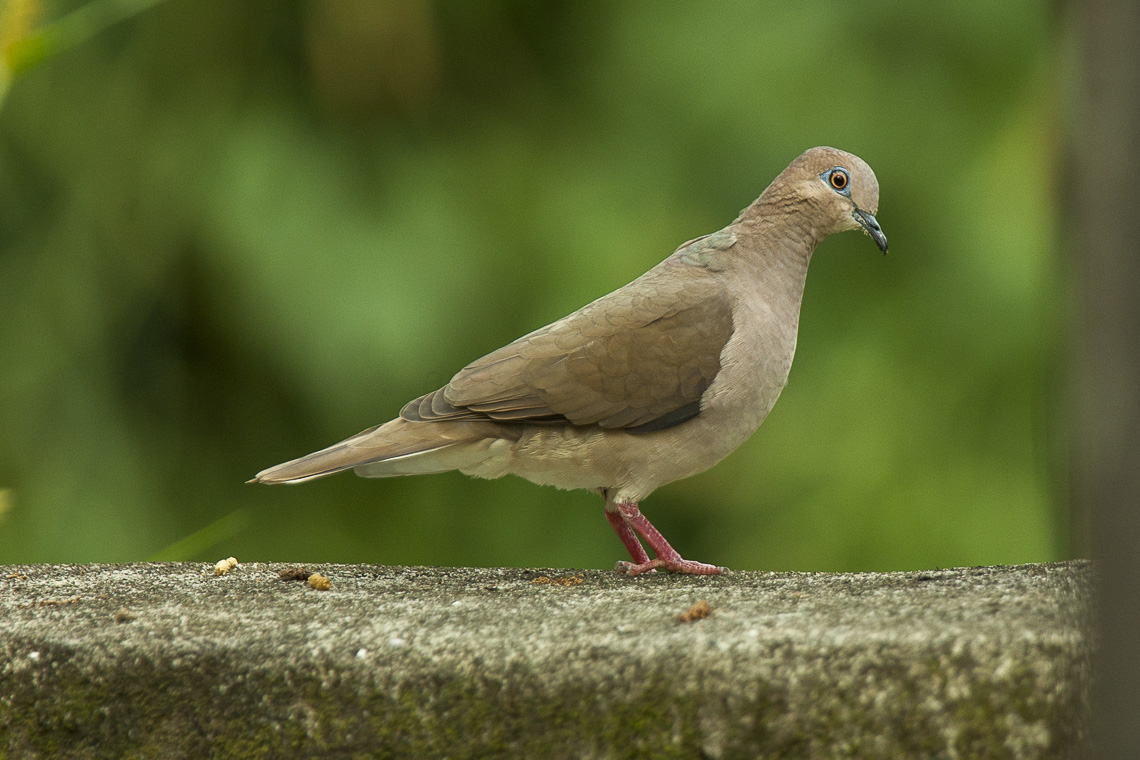
Wikipedia: White-tipped dove Source: OTHER
White-tipped_Dove_-_Panama_H8O8470.jpg
![]() The white-tipped dove (Leptotila verreauxi) is a large New World tropical dove. Its scientific name commemorates the French naturalists Jules and Edouard Verreaux.
[more]
The white-tipped dove (Leptotila verreauxi) is a large New World tropical dove. Its scientific name commemorates the French naturalists Jules and Edouard Verreaux.
[more]

Wikipedia: White-crowned pigeon Source: OTHER
1200px-White-crowned_Pigeon_%28Patagioenas_leucocephala%29.jpg
General: ![]() The white-crowned pigeon (Patagioenas leucocephala) is a fruit and seed-eating species of bird in the dove and pigeon family Columbidae. It is found primarily in the Caribbean.
[more]
The white-crowned pigeon (Patagioenas leucocephala) is a fruit and seed-eating species of bird in the dove and pigeon family Columbidae. It is found primarily in the Caribbean.
[more]
MerlinBirdID says red-billed pigeon but I'm not convinced, reference pictures are not so light-colored. 2023-04-04 07.18.48 Yucatan
First observed in Yucatan on 2023-04-04.
![]() The red-billed pigeon (Patagioenas flavirostris)[2] is a relatively large, girth-y pigeon which breeds from southern Texas, United States, and northwestern Mexico south to Costa Rica. It belongs to a clade of Patagioenas which generally lack iridescent display plumage, except some vestiges in the pale-vented pigeon.
[more]
The red-billed pigeon (Patagioenas flavirostris)[2] is a relatively large, girth-y pigeon which breeds from southern Texas, United States, and northwestern Mexico south to Costa Rica. It belongs to a clade of Patagioenas which generally lack iridescent display plumage, except some vestiges in the pale-vented pigeon.
[more]
Profile Wikipedia eBird Xeno-Canto
MerlinBirdID says pale-vented pigeon. 2023-04-03 16.37.04 Yucatan
First observed in Yucatan on 2023-04-03.
![]() The pale-vented pigeon (Patagioenas cayennensis) is a large pigeon (family Columbidae) found in the tropical Americas. Formerly often placed in Columba, it actually belongs to a clade of the older New World genus Patagioenas. With its relatives it represents an evolutionary radiation extending through most of the warm-temperate to tropical Americas. Grey-hued birds, even their males generally lack iridescent display plumage, although the present species has some coppery gloss on the nape.[2]
[more]
The pale-vented pigeon (Patagioenas cayennensis) is a large pigeon (family Columbidae) found in the tropical Americas. Formerly often placed in Columba, it actually belongs to a clade of the older New World genus Patagioenas. With its relatives it represents an evolutionary radiation extending through most of the warm-temperate to tropical Americas. Grey-hued birds, even their males generally lack iridescent display plumage, although the present species has some coppery gloss on the nape.[2]
[more]

Wikipedia: Scaled pigeon Source: OTHER
Patagioenas_speciosa_-Zooparque_Itatiba%2C_Sao_Paulo_State%2C_Brazil_-adult-8a.jpg
![]() The scaled pigeon (Patagioenas speciosa)[2] is a large New World tropical dove. It is a resident breeder from southern Mexico south to western Ecuador, southern Brazil, northern Argentina, and Trinidad.
[more]
The scaled pigeon (Patagioenas speciosa)[2] is a large New World tropical dove. It is a resident breeder from southern Mexico south to western Ecuador, southern Brazil, northern Argentina, and Trinidad.
[more]
Profile Wikipedia eBird Xeno-Canto

Wikipedia: Short-billed pigeon Source: OTHER
1200px-Patagioenas_nigrirostris.jpg
![]() The short-billed pigeon (Patagioenas nigrirostris)[2] is a largish pigeon which breeds from southern Mexico south to northwestern Colombia. It is a member of a clade of Patagioenas that contains the smaller and rather plain species with characteristic calls[2] that constitute the subgenus Oenoenas.[3]
[more]
The short-billed pigeon (Patagioenas nigrirostris)[2] is a largish pigeon which breeds from southern Mexico south to northwestern Colombia. It is a member of a clade of Patagioenas that contains the smaller and rather plain species with characteristic calls[2] that constitute the subgenus Oenoenas.[3]
[more]

Wikipedia: Green kingfisher Source: OTHER
1200px-Green_kingfisher_%28Chloroceryle_americana_americana%29_male.jpg
![]() The green kingfisher (Chloroceryle americana) is a resident breeding bird which occurs from southern Texas in the United States south through Central and South America to central Argentina.
[more]
The green kingfisher (Chloroceryle americana) is a resident breeding bird which occurs from southern Texas in the United States south through Central and South America to central Argentina.
[more]
Profile Wikipedia eBird Xeno-Canto

Wikipedia: American pygmy kingfisher Source: OTHER
1200px-Chloroceryle-aenea-001.jpg
![]() The American pygmy kingfisher (Chloroceryle aenea) is a resident breeding kingfisher which occurs in the American tropics from southern Mexico south through Central America to western Ecuador, and then around the northern Andes cordillera in the east to central Bolivia and central Brazil. The species occupies the entire Amazon basin and the Tocantins River drainage adjacent in Pará state Brazil. It also occurs on Trinidad.
[more]
The American pygmy kingfisher (Chloroceryle aenea) is a resident breeding kingfisher which occurs in the American tropics from southern Mexico south through Central America to western Ecuador, and then around the northern Andes cordillera in the east to central Bolivia and central Brazil. The species occupies the entire Amazon basin and the Tocantins River drainage adjacent in Pará state Brazil. It also occurs on Trinidad.
[more]
Profile Wikipedia eBird Xeno-Canto

Wikipedia: Amazon kingfisher Source: OTHER
1200px-Amazon_Kingfisher.jpg
![]() The Amazon kingfisher (Chloroceryle amazona) is a resident breeding kingfisher in the lowlands of the American tropics from southern Mexico south through Central America to northern Argentina.
[more]
The Amazon kingfisher (Chloroceryle amazona) is a resident breeding kingfisher in the lowlands of the American tropics from southern Mexico south through Central America to northern Argentina.
[more]

Wikipedia: Belted kingfisher Source: OTHER
1200px-Belted_Kingfisher.jpg
![]() The belted kingfisher (Megaceryle alcyon) is a large, conspicuous water kingfisher. It is depicted on the 1986 series Canadian $5 note. All kingfishers were formerly placed in one family, Alcedinidae, but recent research suggests that this should be divided into three subfamilies.
[more]
The belted kingfisher (Megaceryle alcyon) is a large, conspicuous water kingfisher. It is depicted on the 1986 series Canadian $5 note. All kingfishers were formerly placed in one family, Alcedinidae, but recent research suggests that this should be divided into three subfamilies.
[more]

Wikipedia: Ringed kingfisher Source: OTHER
1200px-MARTIM-PESCADOR-GRANDE_%28Megaceryle_torquata%29.jpg
![]() The ringed kingfisher (Megaceryle torquata) is a large, conspicuous and noisy kingfisher bird commonly found along the lower Rio Grande valley in southeasternmost Texas in the United States through Central America to Tierra del Fuego in South America.[4]
[more]
The ringed kingfisher (Megaceryle torquata) is a large, conspicuous and noisy kingfisher bird commonly found along the lower Rio Grande valley in southeasternmost Texas in the United States through Central America to Tierra del Fuego in South America.[4]
[more]
Profile Wikipedia eBird Xeno-Canto
Curi cancha Lessons motmot in tree. 2018-02-18 13.52.46 Costa Rica
First observed in Costa Rica on 2018-02-18.
![]() Lesson's motmot (Momotus lessonii) or the blue-diademed motmot, is a colorful near-passerine bird found in forests and woodlands of southern Mexico to western Panama. This species and the blue-capped motmot, whooping motmot, Trinidad motmot, Amazonian motmot, and Andean motmot were all considered conspecific.
[more]
Lesson's motmot (Momotus lessonii) or the blue-diademed motmot, is a colorful near-passerine bird found in forests and woodlands of southern Mexico to western Panama. This species and the blue-capped motmot, whooping motmot, Trinidad motmot, Amazonian motmot, and Andean motmot were all considered conspecific.
[more]
Profile Wikipedia eBird Xeno-Canto

Wikipedia: Blue-capped motmot Source: OTHER
Momotus_momotaAQBIP08CA.jpg
Endemic (country/region)
Profile Wikipedia eBird Xeno-Canto
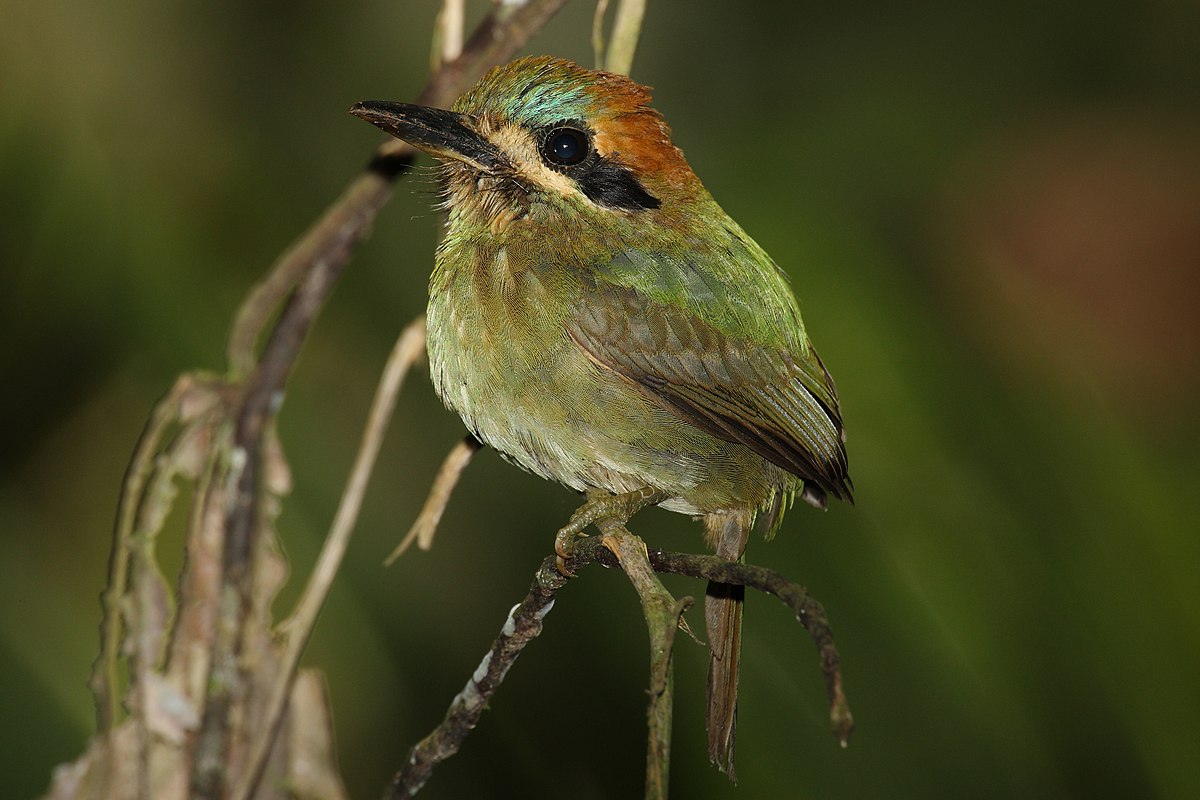
Wikipedia: Tody motmot Source: OTHER
1200px-Hylomanes-momotula-001.jpg
General: ![]() The tody motmot (Hylomanes momotula) is a species of bird in the family Momotidae. It is monotypic within the genus Hylomanes.[2]
It is found in Belize, Colombia, Costa Rica, El Salvador, Guatemala, Honduras, Mexico, Nicaragua, and Panama.
Its natural habitats are subtropical or tropical moist lowland forest and subtropical or tropical moist montane forest.
[more]
The tody motmot (Hylomanes momotula) is a species of bird in the family Momotidae. It is monotypic within the genus Hylomanes.[2]
It is found in Belize, Colombia, Costa Rica, El Salvador, Guatemala, Honduras, Mexico, Nicaragua, and Panama.
Its natural habitats are subtropical or tropical moist lowland forest and subtropical or tropical moist montane forest.
[more]
Profile Wikipedia eBird Xeno-Canto

Wikipedia: Turquoise-browed motmot Source: OTHER
1200px-Turquoise-browed_Motmot_%2816423222357%29.jpg
![]() The turquoise-browed motmot (Eumomota superciliosa) also known as Torogoz, is a colourful, medium-sized bird of the motmot family, Momotidae. It inhabits Central America from south-east Mexico (mostly the Yucatán Peninsula), to Costa Rica, where it is common and not considered threatened. It lives in fairly open habitats such as forest edge, gallery forest and scrubland. It is more conspicuous than other motmots, often perching in the open on wires and fences. From these perches it scans for prey, such as insects and small reptiles. White eggs (3–6) are laid in a long tunnel nest in an earth bank or sometimes in a quarry or fresh-water well. Its name originates from the turquoise color of its brow. It is the national bird of both El Salvador and Nicaragua, where it is known as "Torogoz" and "Guardabarranco" respectively.[2][3]
[more]
The turquoise-browed motmot (Eumomota superciliosa) also known as Torogoz, is a colourful, medium-sized bird of the motmot family, Momotidae. It inhabits Central America from south-east Mexico (mostly the Yucatán Peninsula), to Costa Rica, where it is common and not considered threatened. It lives in fairly open habitats such as forest edge, gallery forest and scrubland. It is more conspicuous than other motmots, often perching in the open on wires and fences. From these perches it scans for prey, such as insects and small reptiles. White eggs (3–6) are laid in a long tunnel nest in an earth bank or sometimes in a quarry or fresh-water well. Its name originates from the turquoise color of its brow. It is the national bird of both El Salvador and Nicaragua, where it is known as "Torogoz" and "Guardabarranco" respectively.[2][3]
[more]
Profile Wikipedia eBird Audubon AllAboutBirds Xeno-Canto
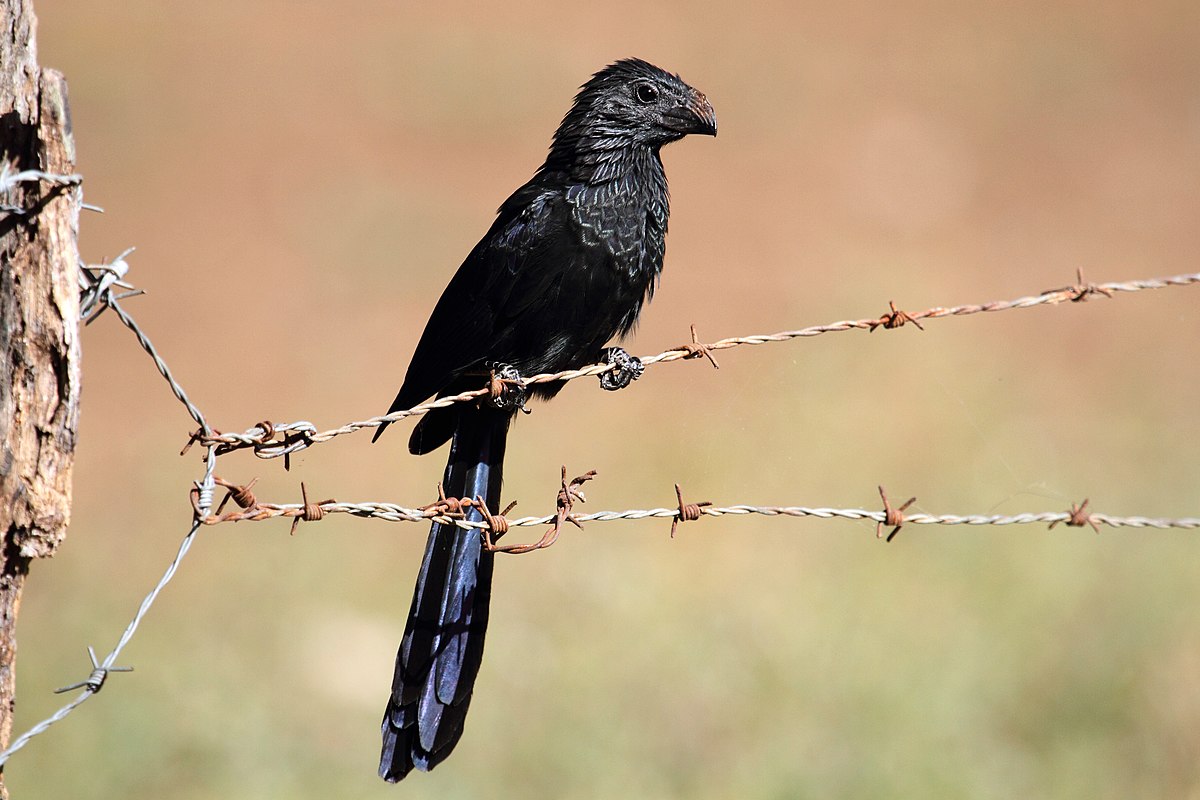
Wikipedia: Groove-billed ani Source: OTHER
1200px-Crotophaga_sulcirostris_CR_bis.JPG
![]() The groove-billed ani (Crotophaga sulcirostris) is a tropical bird in the cuckoo family with a long tail and a large, curved beak. It is a resident species throughout most of its range, from southern Texas, central Mexico and The Bahamas, through Central America, to northern Colombia and Venezuela, and coastal Ecuador and Peru. It only retreats from the northern limits of its range in Texas and northern Mexico during winter.
[more]
The groove-billed ani (Crotophaga sulcirostris) is a tropical bird in the cuckoo family with a long tail and a large, curved beak. It is a resident species throughout most of its range, from southern Texas, central Mexico and The Bahamas, through Central America, to northern Colombia and Venezuela, and coastal Ecuador and Peru. It only retreats from the northern limits of its range in Texas and northern Mexico during winter.
[more]
Profile Wikipedia eBird Audubon AllAboutBirds Xeno-Canto
Smooth-billed ani. 2023-04-16 06.25.20 Yucatan
First observed in Yucatan on 2023-04-16.
![]() The smooth-billed ani (Crotophaga ani) is a large near passerine bird in the cuckoo family. It is a resident breeding species from southern Florida, the Caribbean, parts of Central America, south to western Ecuador, Brazil, northern Argentina and southern Chile.[2] It was introduced to Galápagos around the 1960s and is potentially impacting native and endemic species across the archipelago.[3]
[more]
The smooth-billed ani (Crotophaga ani) is a large near passerine bird in the cuckoo family. It is a resident breeding species from southern Florida, the Caribbean, parts of Central America, south to western Ecuador, Brazil, northern Argentina and southern Chile.[2] It was introduced to Galápagos around the 1960s and is potentially impacting native and endemic species across the archipelago.[3]
[more]
Profile Wikipedia eBird Xeno-Canto
Squirrel cuckoo. 2020-03-04 09.26.50 Panama
First observed in Panama on 2020-03-04.
![]() The squirrel cuckoo (Piaya cayana) is a large and active species of cuckoo found in wooded habitats from northwestern Mexico to northern Argentina and Uruguay, and on Trinidad. Some authorities have split off the western Mexican form as the Mexican squirrel-cuckoo (Piaya mexicana).[2]
[more]
The squirrel cuckoo (Piaya cayana) is a large and active species of cuckoo found in wooded habitats from northwestern Mexico to northern Argentina and Uruguay, and on Trinidad. Some authorities have split off the western Mexican form as the Mexican squirrel-cuckoo (Piaya mexicana).[2]
[more]
![]() Der Schwarzschnabelkuckuck (Coccyzus erythropthalmus) ist eine Art aus der Familie der Kuckucksvögel, die ausschließlich in der neuen Welt vorkommt. Er brütet ausschließlich im Nordosten Nordamerikas, überwintert aber während des Winterhalbjahres in Südamerika. Während seines Zuges im Herbst und Frühjahr ist er auch in Zentralamerika, in Mexiko und dem Süden der Vereinigten Staaten zu beobachten. Der sehr heimlich lebende Schwarzschnabelkuckuck ist ein mittelgroßer, schlanker und langschwänziger Kuckuck, der sich überwiegend versteckt im Blattwerk aufhält.
[more]
Der Schwarzschnabelkuckuck (Coccyzus erythropthalmus) ist eine Art aus der Familie der Kuckucksvögel, die ausschließlich in der neuen Welt vorkommt. Er brütet ausschließlich im Nordosten Nordamerikas, überwintert aber während des Winterhalbjahres in Südamerika. Während seines Zuges im Herbst und Frühjahr ist er auch in Zentralamerika, in Mexiko und dem Süden der Vereinigten Staaten zu beobachten. Der sehr heimlich lebende Schwarzschnabelkuckuck ist ein mittelgroßer, schlanker und langschwänziger Kuckuck, der sich überwiegend versteckt im Blattwerk aufhält.
[more]
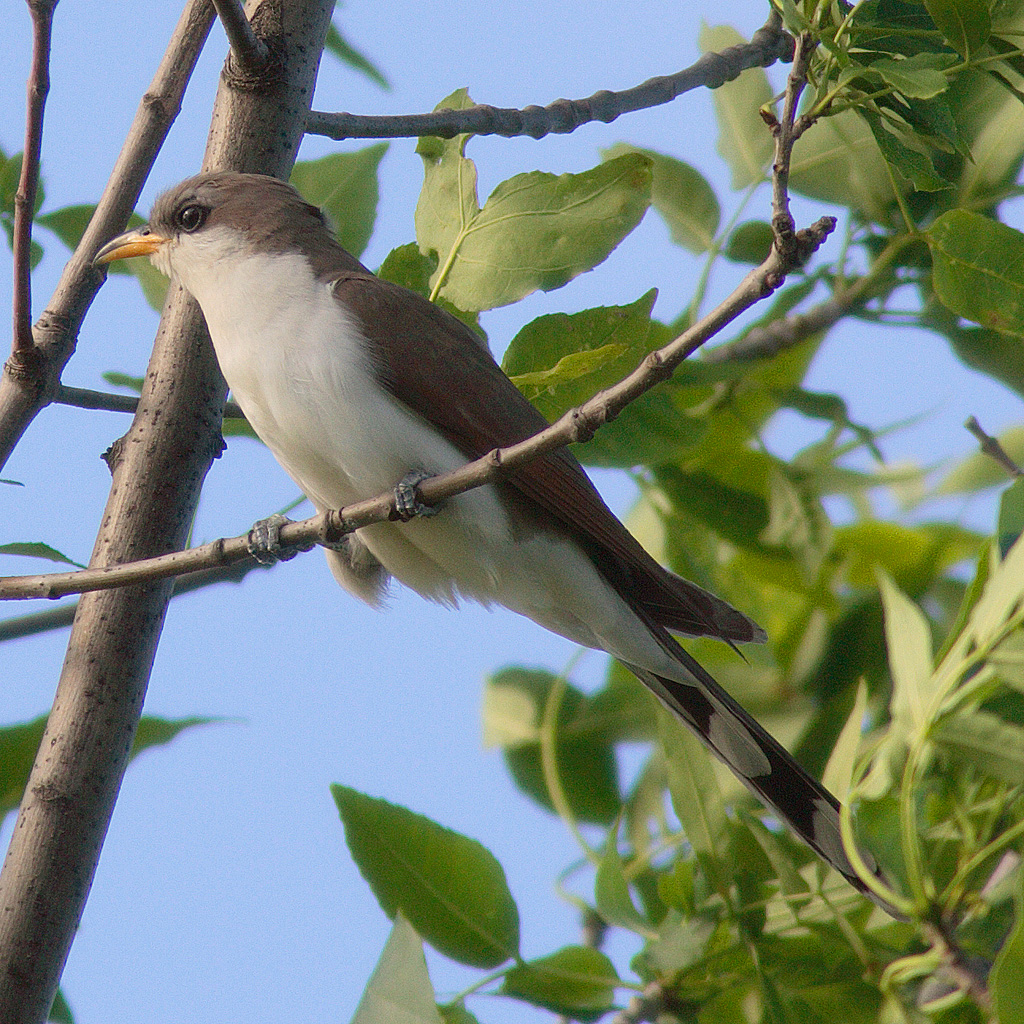
Wikipedia: Yellow-billed cuckoo Source: OTHER
Coccyzus-americanus-001.jpg
![]() The yellow-billed cuckoo (Coccyzus americanus) is a cuckoo. Common folk-names for this bird in the southern United States are rain crow and storm crow. These likely refer to the bird's habit of calling on hot days, often presaging rain or thunderstorms.
[more]
The yellow-billed cuckoo (Coccyzus americanus) is a cuckoo. Common folk-names for this bird in the southern United States are rain crow and storm crow. These likely refer to the bird's habit of calling on hot days, often presaging rain or thunderstorms.
[more]
Profile Wikipedia eBird Audubon AllAboutBirds Xeno-Canto

Wikipedia: Mangrove cuckoo Source: OTHER
1200px-Mangrove_Cuckoo.jpg
![]() The mangrove cuckoo (Coccyzus minor) is a species of cuckoo that is native to the Neotropics.
[more]
The mangrove cuckoo (Coccyzus minor) is a species of cuckoo that is native to the Neotropics.
[more]
Profile Wikipedia eBird Xeno-Canto
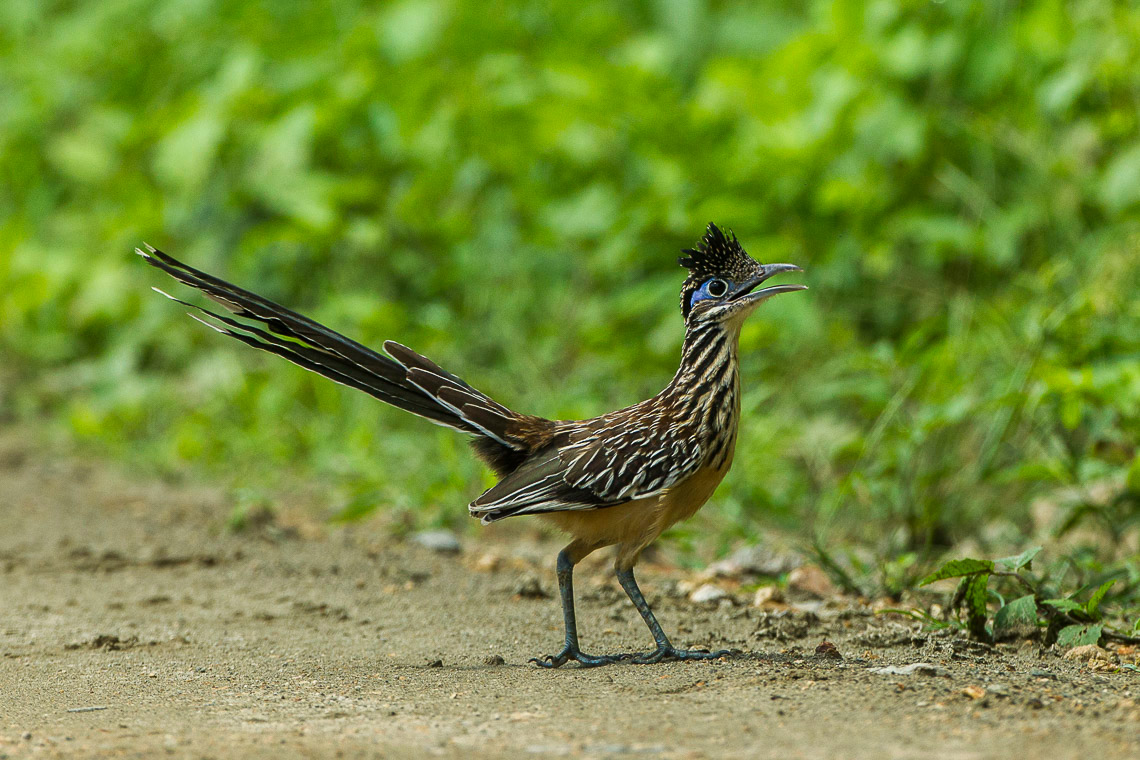
Wikipedia: Lesser roadrunner Source: OTHER
Lesser_Roadrunner_-_Mexico_S4E1497.jpg
Profile Wikipedia eBird Xeno-Canto

Wikipedia: Pheasant cuckoo Source: OTHER
1200px-Dromococcyx_phasianellus_-_Pheasant_Cuckoo%3B_Caxias%2C_Maranh%C3%A3o%2C_Brazil.jpg
General: ![]() The pheasant cuckoo (Dromococcyx phasianellus) is a species of neotropical cuckoo in the subfamily Neomorphinae of the family Cuculidae. It is native to Central and South America where it occurs in lowland tropical forest.
[more]
The pheasant cuckoo (Dromococcyx phasianellus) is a species of neotropical cuckoo in the subfamily Neomorphinae of the family Cuculidae. It is native to Central and South America where it occurs in lowland tropical forest.
[more]

Wikipedia: Peregrine falcon Source: OTHER
Falco_peregrinus_good_-_Christopher_Watson.jpg
This bird appears across the great seas in the following continents:
Europe, North America, South America, Africa, Asia.
![]() The peregrine falcon (Falco peregrinus), also known as the peregrine,[2] and historically as the duck hawk in North America,[3] is a widespread bird of prey (raptor) in the family Falconidae. A large, crow-sized falcon, it has a blue-grey back, barred white underparts, and a black head. The peregrine is renowned for its speed, reaching over 320 km/h (200 mph) during its characteristic hunting stoop (high-speed dive),[4] making it the fastest bird in the world, as well as the fastest member of the animal kingdom.[5][6][7] According to a National Geographic TV program, the highest measured speed of a peregrine falcon is 389 km/h (242 mph).[8][9] As is typical for bird-eating raptors, peregrine falcons are sexually dimorphic, with females being considerably larger than males.[10][11]
[more]
The peregrine falcon (Falco peregrinus), also known as the peregrine,[2] and historically as the duck hawk in North America,[3] is a widespread bird of prey (raptor) in the family Falconidae. A large, crow-sized falcon, it has a blue-grey back, barred white underparts, and a black head. The peregrine is renowned for its speed, reaching over 320 km/h (200 mph) during its characteristic hunting stoop (high-speed dive),[4] making it the fastest bird in the world, as well as the fastest member of the animal kingdom.[5][6][7] According to a National Geographic TV program, the highest measured speed of a peregrine falcon is 389 km/h (242 mph).[8][9] As is typical for bird-eating raptors, peregrine falcons are sexually dimorphic, with females being considerably larger than males.[10][11]
[more]
Vocalization: ![]() A harsh, drawn out "kiaaaa" with emphasised endings repeated in series. Much slower than Merlin, but higher pitched than Gyrfalcon. [Link]
A harsh, drawn out "kiaaaa" with emphasised endings repeated in series. Much slower than Merlin, but higher pitched than Gyrfalcon. [Link]
Calls: ![]() Also shorter, coarse warning-calls. [Link]
Also shorter, coarse warning-calls. [Link]
Physical details: length=36-48 cm,
wingspan=95-110 cm,
weight=582-1300 g
Habitats:
Agricultural

Merlin SoundID bird list. Source: OTHER
Merlin SoundID bird list.jpg
This bird appears across the great seas in the following continents:
Europe, North America, South America, Africa.
Deutschland: Zugvogel, Wintergast
Vocalization: ![]() Series of harsh "kwik-wik wik". Coarseness similar to Peregrine, but pace much quicker. [Link]
Series of harsh "kwik-wik wik". Coarseness similar to Peregrine, but pace much quicker. [Link]
Calls: ![]() Female call harsher than male. Lacking the clearer tones and attack of Kestrel. [Link]
Female call harsher than male. Lacking the clearer tones and attack of Kestrel. [Link]
Physical details: length=25-30 cm,
wingspan=50-62 cm,
weight=125-300 g
Habitats:
Agricultural
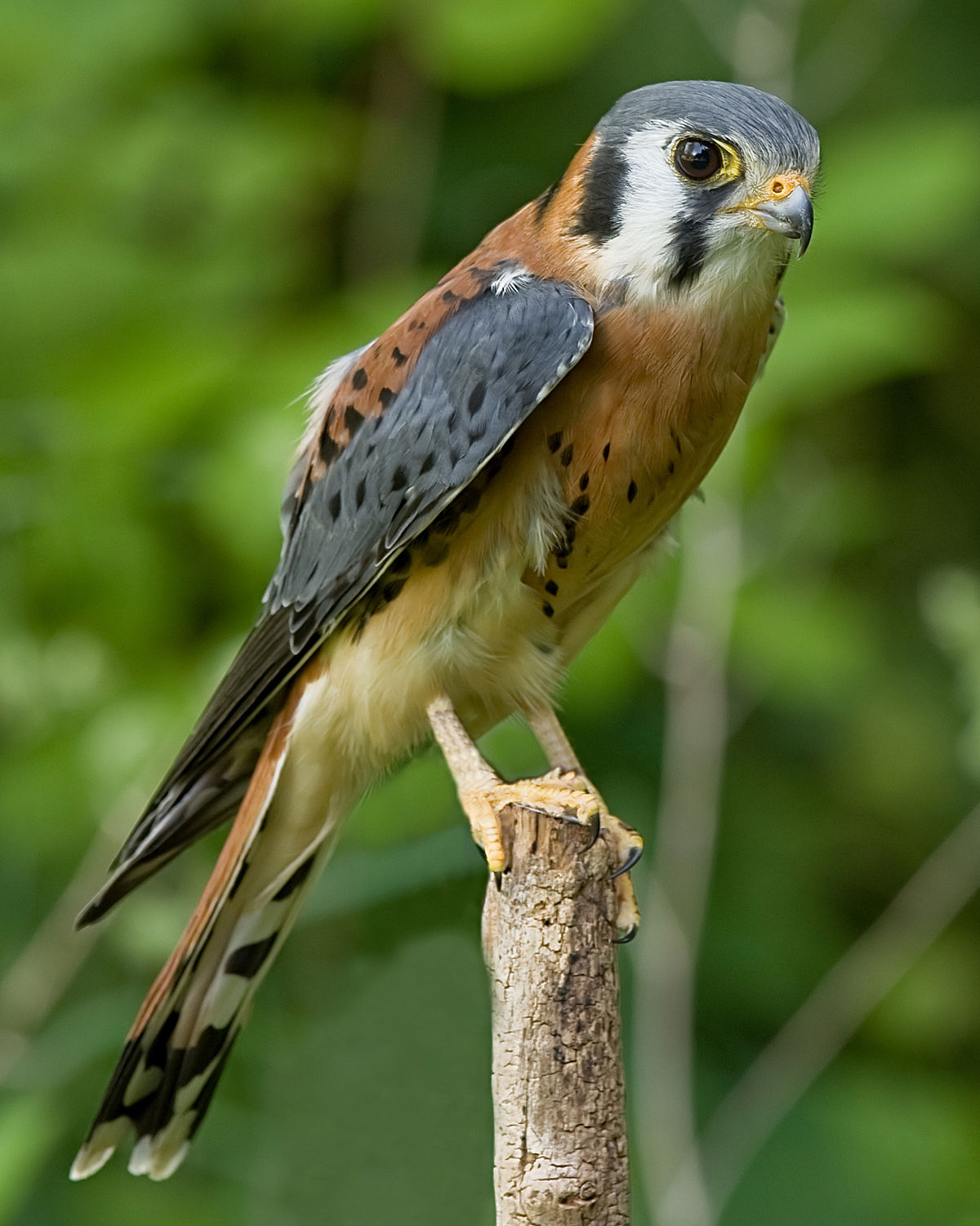
Wikipedia: American kestrel Source: OTHER
1200px-AmericanKestrel02.jpg
General: ![]() The American kestrel (Falco sparverius), also called the sparrow hawk, is the smallest and most common falcon in North America. It has a roughly two-to-one range in size over subspecies and sex, varying in size from about the weight of a blue jay to a mourning dove. It also ranges to South America and is a well-established species that has evolved into 17 subspecies adapted to different environments and habitats throughout the Americas. It exhibits sexual dimorphism in size (females being moderately larger) and plumage, although both sexes have a rufous back with noticeable barring. Its plumage is colorful and attractive, and juveniles are similar in plumage to adults.
[more]
The American kestrel (Falco sparverius), also called the sparrow hawk, is the smallest and most common falcon in North America. It has a roughly two-to-one range in size over subspecies and sex, varying in size from about the weight of a blue jay to a mourning dove. It also ranges to South America and is a well-established species that has evolved into 17 subspecies adapted to different environments and habitats throughout the Americas. It exhibits sexual dimorphism in size (females being moderately larger) and plumage, although both sexes have a rufous back with noticeable barring. Its plumage is colorful and attractive, and juveniles are similar in plumage to adults.
[more]
Profile Wikipedia eBird Audubon AllAboutBirds Xeno-Canto

Wikipedia: Aplomado falcon Source: OTHER
Aplomado_Falcon_portrait.jpg
![]() The aplomado falcon (Falco femoralis) is a medium-sized falcon of the Americas. The species' largest contiguous range is in South America, but not in the deep interior Amazon Basin. It was long known as Falco fusco-coerulescens or Falco fuscocaerulescens, but these names are now believed to refer to the bat falcon (F. rufigularis).[2] Its resemblance in shape to the hobbies accounts for its old name orange-chested hobby. Aplomado is an unusual Spanish word for "lead-colored", referring to the blue-grey areas of the plumage – an approximate English translation would be "plumbeous falcon". Spanish names for the species include halcón aplomado and halcón fajado (roughly "banded falcon" in reference to the characteristic pattern); in Brazil it is known as falcão-de-coleira.
[more]
The aplomado falcon (Falco femoralis) is a medium-sized falcon of the Americas. The species' largest contiguous range is in South America, but not in the deep interior Amazon Basin. It was long known as Falco fusco-coerulescens or Falco fuscocaerulescens, but these names are now believed to refer to the bat falcon (F. rufigularis).[2] Its resemblance in shape to the hobbies accounts for its old name orange-chested hobby. Aplomado is an unusual Spanish word for "lead-colored", referring to the blue-grey areas of the plumage – an approximate English translation would be "plumbeous falcon". Spanish names for the species include halcón aplomado and halcón fajado (roughly "banded falcon" in reference to the characteristic pattern); in Brazil it is known as falcão-de-coleira.
[more]
Profile Wikipedia eBird Xeno-Canto
Bat falcon at cenote xxx. 2023-04-14 13.03.34 Yucatan
First observed in Yucatan on 2023-04-05.
![]() The bat falcon (Falco rufigularis) is a falcon that is a resident breeder in tropical Mexico, Central and South America, and Trinidad. It was long known as Falco albigularis; the names Falco fusco-coerulescens or Falco fuscocaerulescens, long used for the aplomado falcon, are now believed to refer to the present species.[2]
[more]
The bat falcon (Falco rufigularis) is a falcon that is a resident breeder in tropical Mexico, Central and South America, and Trinidad. It was long known as Falco albigularis; the names Falco fusco-coerulescens or Falco fuscocaerulescens, long used for the aplomado falcon, are now believed to refer to the present species.[2]
[more]
Profile Wikipedia eBird Xeno-Canto

Wikipedia: Orange-breasted falcon Source: OTHER
1200px-Falco_deiroleucus_-_Orange-breasted_Falcon.JPG
![]() The orange-breasted falcon (Falco deiroleucus) is a bird of the falcon family. It is probably closely related to and looks like a larger version of the bat falcon. These two, in turn, are probably closest to the aplomado falcon and constitute a rather old American lineage of Falco.[2]
[more]
The orange-breasted falcon (Falco deiroleucus) is a bird of the falcon family. It is probably closely related to and looks like a larger version of the bat falcon. These two, in turn, are probably closest to the aplomado falcon and constitute a rather old American lineage of Falco.[2]
[more]
Profile Wikipedia eBird Xeno-Canto

Wikipedia: Barred forest-falcon Source: OTHER
1200px-Micrastur_ruficollis_-Parque_Estadual_da_Serra_da_Cantareira%2C_Sao_Paulo%2C_Brazil-8.jpg
![]() The barred forest falcon (Micrastur ruficollis) is a species of bird of prey in the family Falconidae which includes the falcons, caracaras, and their relatives. It occurs throughout most of tropical and subtropical Latin America, except the arid Pacific coast in South America, northern and western Mexico, and the Antilles.
[more]
The barred forest falcon (Micrastur ruficollis) is a species of bird of prey in the family Falconidae which includes the falcons, caracaras, and their relatives. It occurs throughout most of tropical and subtropical Latin America, except the arid Pacific coast in South America, northern and western Mexico, and the Antilles.
[more]
Profile Wikipedia eBird Xeno-Canto
Collared forest falcon awaits dinner at Zetzo bat cave near Ixpujil. 2023-04-03 18.00.06 Yucatan
First observed in Yucatan on 2023-04-03.
![]() The collared forest falcon (Micrastur semitorquatus) is a species of bird of prey in the family Falconidae. It is the largest member of the Micrastur genus and a common inhabitant of tropical rainforests in Latin America.[2] Hiding in the dense forest canopy, they are a secretive bird often only recognized by their distinctive call. With a morphology or body type allowing them to be agile in their forested habitat, their diet comprises a wide variety of prey from smaller frogs (20 g) to adult turkeys (2.7-3.2 kg).[3]
[more]
The collared forest falcon (Micrastur semitorquatus) is a species of bird of prey in the family Falconidae. It is the largest member of the Micrastur genus and a common inhabitant of tropical rainforests in Latin America.[2] Hiding in the dense forest canopy, they are a secretive bird often only recognized by their distinctive call. With a morphology or body type allowing them to be agile in their forested habitat, their diet comprises a wide variety of prey from smaller frogs (20 g) to adult turkeys (2.7-3.2 kg).[3]
[more]
Profile Wikipedia eBird Xeno-Canto
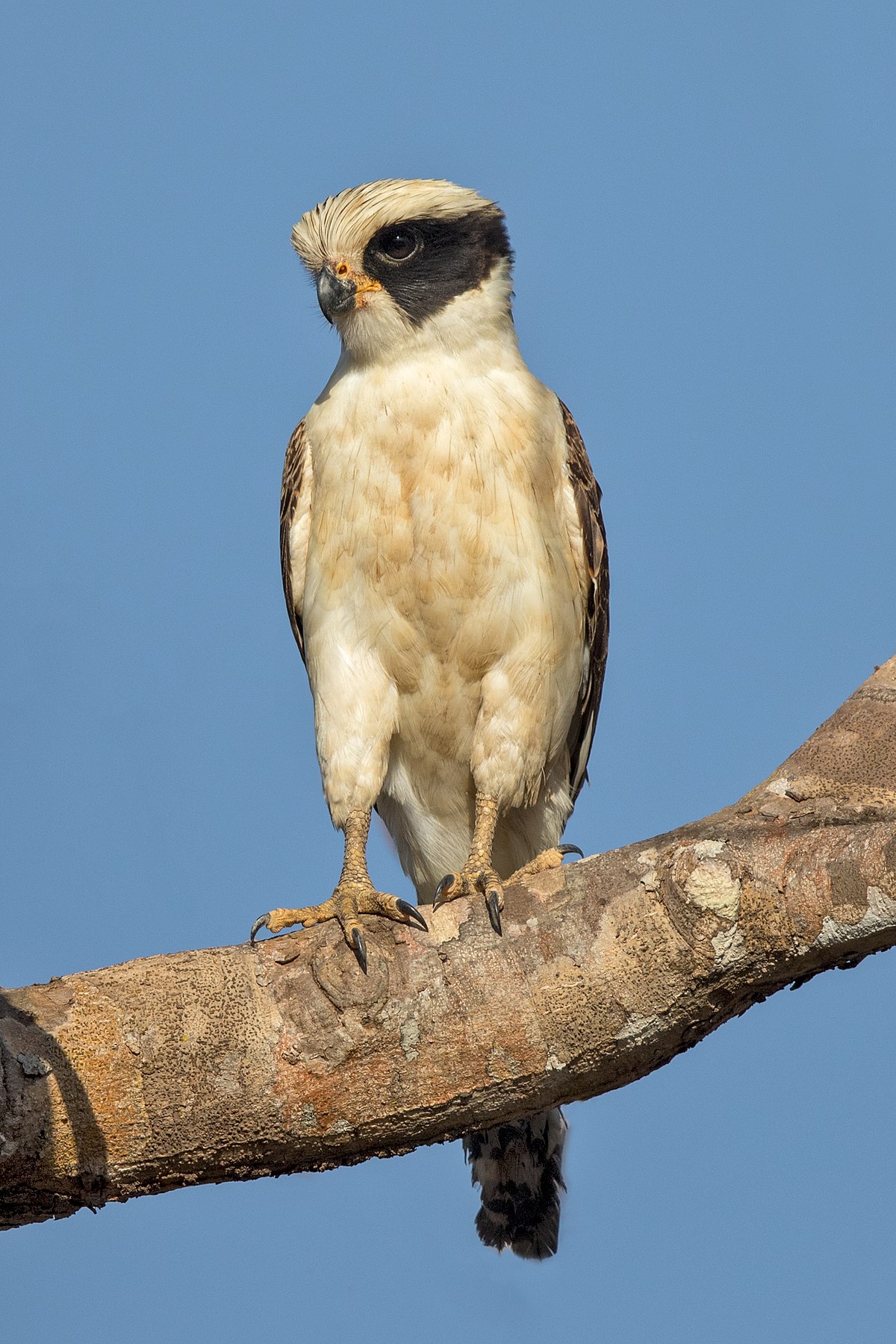
Wikipedia: Laughing falcon Source: OTHER
1200px-Lachfalke.jpg
![]() The laughing falcon (Herpetotheres cachinnans), also called the snake hawk (erroneously, since it is not a hawk), is a medium-sized bird of prey in the falcon family (Falconidae), the only member of the genus Herpetotheres. This Neotropical species is a specialist snake-eater. Its common and scientific names both refer to its distinctive voice.
[more]
The laughing falcon (Herpetotheres cachinnans), also called the snake hawk (erroneously, since it is not a hawk), is a medium-sized bird of prey in the falcon family (Falconidae), the only member of the genus Herpetotheres. This Neotropical species is a specialist snake-eater. Its common and scientific names both refer to its distinctive voice.
[more]

Wikipedia: Crested caracara Source: OTHER
1200px-Schopfkarakara.jpg
![]() The crested caracara (Caracara plancus), is a bird of prey in the family Falconidae. As presently defined, the crested caracara is found in South America, the southern United States, including Florida, where it has been seen on the East coast as far as extreme eastern Seminole County, Florida (Lake Harney), where it is now considered a resident but listed as threatened. There have been reports of the crested caracara as far north as San Francisco, California.[2] and, in 2012, near Crescent City, California.[3] Some are believed to possibly be living in Nova Scotia, with numerous sightings throughout the 2010s.[4] In July 2016 a northern caracara was reported and photographed by numerous people in the upper peninsula of Michigan, just outside of Munising.[5][6][7] In June 2017, a northern caracara was sighted far north in St. George, New Brunswick, Canada.[8] A specimen was photographed in Woodstock, Vermont in March 2020.[citation needed] The species has recently become more common in central and north Texas and is generally common in south Texas and south of the US border.[citation needed] It can also be found (nesting) in the Southern Caribbean (e.g. Aruba, Curaçao and Bonaire)[citation needed], Mexico, and Central America. It was formerly placed in the genus Polyborus.
[more]
The crested caracara (Caracara plancus), is a bird of prey in the family Falconidae. As presently defined, the crested caracara is found in South America, the southern United States, including Florida, where it has been seen on the East coast as far as extreme eastern Seminole County, Florida (Lake Harney), where it is now considered a resident but listed as threatened. There have been reports of the crested caracara as far north as San Francisco, California.[2] and, in 2012, near Crescent City, California.[3] Some are believed to possibly be living in Nova Scotia, with numerous sightings throughout the 2010s.[4] In July 2016 a northern caracara was reported and photographed by numerous people in the upper peninsula of Michigan, just outside of Munising.[5][6][7] In June 2017, a northern caracara was sighted far north in St. George, New Brunswick, Canada.[8] A specimen was photographed in Woodstock, Vermont in March 2020.[citation needed] The species has recently become more common in central and north Texas and is generally common in south Texas and south of the US border.[citation needed] It can also be found (nesting) in the Southern Caribbean (e.g. Aruba, Curaçao and Bonaire)[citation needed], Mexico, and Central America. It was formerly placed in the genus Polyborus.
[more]
Our first caribbean flamingos at Las Colorados - closeup. 2023-04-15 09.33.10 Yucatan
First observed in Yucatan on 2023-04-15.
![]() The American flamingo (Phoenicopterus ruber) is a large species of flamingo closely related to the greater flamingo and Chilean flamingo native to the Neotropics. It was formerly considered conspecific with the greater flamingo, but that treatment is now widely viewed (e.g. by the American and British Ornithologists' Unions) as incorrect due to a lack of evidence. It is also known as the Caribbean flamingo, although it is also present in the Galápagos Islands. It is the only flamingo that naturally inhabits North America.
[more]
The American flamingo (Phoenicopterus ruber) is a large species of flamingo closely related to the greater flamingo and Chilean flamingo native to the Neotropics. It was formerly considered conspecific with the greater flamingo, but that treatment is now widely viewed (e.g. by the American and British Ornithologists' Unions) as incorrect due to a lack of evidence. It is also known as the Caribbean flamingo, although it is also present in the Galápagos Islands. It is the only flamingo that naturally inhabits North America.
[more]

Wikipedia: Golden-olive woodpecker Source: OTHER
1200px-Golden-olive_Woodpecker.jpg
![]() The golden-olive woodpecker (Colaptes rubiginosus) is a resident breeding bird from Mexico south and east to Guyana, northwest Argentina, Trinidad and Tobago. It was formerly placed in the genus Piculus.[4] The scientific name rubiginosus means "full of rust", describing the color of the bird's wings and back.
[more]
The golden-olive woodpecker (Colaptes rubiginosus) is a resident breeding bird from Mexico south and east to Guyana, northwest Argentina, Trinidad and Tobago. It was formerly placed in the genus Piculus.[4] The scientific name rubiginosus means "full of rust", describing the color of the bird's wings and back.
[more]
Smoky brown woodpecker, nature walk in the woods with Jacqueline at Ecotucan. 2023-04-02 11.16.18 Yucatan
First observed in 🇨🇭 on 2020-04-16.
![]() The smoky-brown woodpecker (Leuconotopicus fumigatus) is a species of bird in subfamily Picinae of the woodpecker family Picidae. It is found in Argentina, Belize, Bolivia, Colombia, Costa Rica, Ecuador, El Salvador, Guatemala, Honduras, Mexico, Nicaragua, Panama, Peru, and Venezuela.[2]
[more]
The smoky-brown woodpecker (Leuconotopicus fumigatus) is a species of bird in subfamily Picinae of the woodpecker family Picidae. It is found in Argentina, Belize, Bolivia, Colombia, Costa Rica, Ecuador, El Salvador, Guatemala, Honduras, Mexico, Nicaragua, Panama, Peru, and Venezuela.[2]
[more]
Call:
Automatically generated from Xeno-Canto recording
♫ Source: BirdNet
20210402_173808 birdnet 1398 - Specht in Carona - 2021-04-02 17:38:08 - No confident detection - Lugano.mp3
2021-04-02 17.38.08 Carona (song?)
Profile Wikipedia eBird Xeno-Canto
Lineated woodpecker cahal pech. 2018-02-04 15.57.04 Belize
First observed in Belize on 2018-02-04.
![]() The lineated woodpecker (Dryocopus lineatus) is a very large woodpecker which is a resident breeding bird from southern Mexico to northern Argentina and on Trinidad in the Caribbean.
[more]
The lineated woodpecker (Dryocopus lineatus) is a very large woodpecker which is a resident breeding bird from southern Mexico to northern Argentina and on Trinidad in the Caribbean.
[more]
Profile Wikipedia eBird Audubon AllAboutBirds Xeno-Canto

Wikipedia: Yellow-bellied sapsucker Source: OTHER
1200px-Yellow-bellied_sapsucker_in_CP_%2840484%29.jpg
![]() The yellow-bellied sapsucker (Sphyrapicus varius) is a medium-sized woodpecker that breeds in Canada and the northeastern United States.
[more]
The yellow-bellied sapsucker (Sphyrapicus varius) is a medium-sized woodpecker that breeds in Canada and the northeastern United States.
[more]
Profile Wikipedia eBird Audubon AllAboutBirds Xeno-Canto

Wikipedia: Golden-fronted woodpecker Source: OTHER
Melanerpes_aurifrons2.jpg
![]() The golden-fronted woodpecker (Melanerpes aurifrons) is a North American woodpecker. Its preferred habitat is mesquite, riparian woodlands, and tropical rainforest. It is distributed from Texas and Oklahoma in the United States through Mexico, Belize, Guatemala, El Salvador, Honduras and northern Nicaragua.[2] Cooke listed this species as an abundant resident of the lower Rio Grande Valley, Texas, in 1884.
[more]
The golden-fronted woodpecker (Melanerpes aurifrons) is a North American woodpecker. Its preferred habitat is mesquite, riparian woodlands, and tropical rainforest. It is distributed from Texas and Oklahoma in the United States through Mexico, Belize, Guatemala, El Salvador, Honduras and northern Nicaragua.[2] Cooke listed this species as an abundant resident of the lower Rio Grande Valley, Texas, in 1884.
[more]
Profile Wikipedia eBird Audubon AllAboutBirds Xeno-Canto
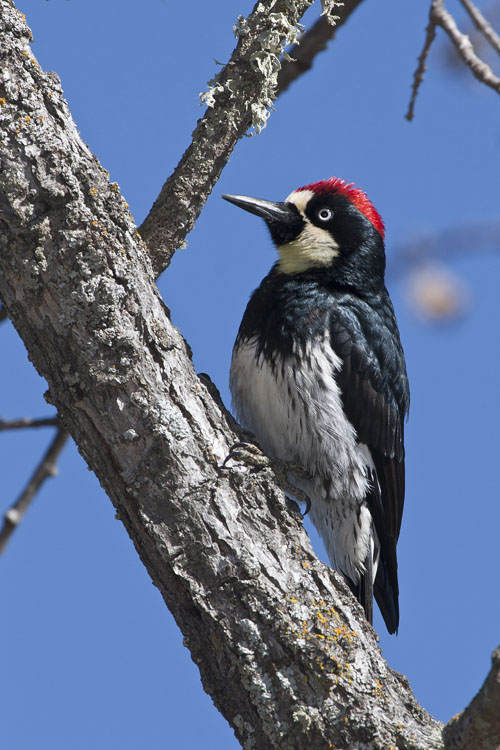
Wikipedia: Acorn woodpecker Source: OTHER
Melanerpes_formicivorus_-San_Luis_Obispo%2C_California%2C_USA_-male-8.jpg
![]() The acorn woodpecker (Melanerpes formicivorus) is a medium-sized woodpecker, 21 cm (8.3 in) long, with an average weight of 85 g (3.0 oz).
[more]
The acorn woodpecker (Melanerpes formicivorus) is a medium-sized woodpecker, 21 cm (8.3 in) long, with an average weight of 85 g (3.0 oz).
[more]
Profile Wikipedia eBird Xeno-Canto
Action among the Yucatan woodpeckers, on tour with Erik. 2023-04-16 07.16.44 Yucatan
First observed in Yucatan on 2023-03-31.
Profile Wikipedia eBird Xeno-Canto
Arenal pale-billed woodpecker. 2018-02-27 15.51.26 Costa Rica
First observed in Costa Rica on 2018-02-27.
General: ![]() The pale-billed woodpecker (Campephilus guatemalensis) is a very large woodpecker that is a resident breeding bird from northern Mexico to western Panama.
[more]
The pale-billed woodpecker (Campephilus guatemalensis) is a very large woodpecker that is a resident breeding bird from northern Mexico to western Panama.
[more]
Profile Wikipedia eBird Xeno-Canto

Wikipedia: Chestnut-colored woodpecker Source: OTHER
Chestnut-coloured_Woodpecker.jpg
![]() The chestnut-colored woodpecker (Celeus castaneus) is a species of bird in the family Picidae.
It is found in Belize, Costa Rica, Guatemala, Honduras, Mexico, Nicaragua, and Panama.
[more]
The chestnut-colored woodpecker (Celeus castaneus) is a species of bird in the family Picidae.
It is found in Belize, Costa Rica, Guatemala, Honduras, Mexico, Nicaragua, and Panama.
[more]

Wikipedia: Ladder-backed woodpecker Source: OTHER
Ladder-back_Woodpecker_on_Cactus.jpg
![]() The ladder-backed woodpecker (Dryobates scalaris) is a North American woodpecker. Some taxonomic authorities, including the American Ornithological Society, continue to place this species in the genus Picoides.
[more]
The ladder-backed woodpecker (Dryobates scalaris) is a North American woodpecker. Some taxonomic authorities, including the American Ornithological Society, continue to place this species in the genus Picoides.
[more]

Wikipedia: Emerald toucanet Source: OTHER
1200px-Aulacorhynchus_prasinus_-perching_on_branch-8a.jpg
![]() The emerald toucanet or northern emerald toucanet (Aulacorhynchus prasinus) is a species of near-passerine bird in the family Ramphastidae occurring in mountainous regions of Mexico and Central America.[4] Several taxa formerly included within this species have now been re-classified into separate species of their own (see Taxonomy).
[more]
The emerald toucanet or northern emerald toucanet (Aulacorhynchus prasinus) is a species of near-passerine bird in the family Ramphastidae occurring in mountainous regions of Mexico and Central America.[4] Several taxa formerly included within this species have now been re-classified into separate species of their own (see Taxonomy).
[more]
Profile Wikipedia eBird Xeno-Canto
Tikal collared aracari. 2018-02-07 12.38.40 Guatemala
First observed in Guatemala on 2018-02-07.
![]() The collared aracari or collared araçari (Pteroglossus torquatus) is a toucan, a near-passerine bird. It breeds from southern Mexico(North America) to Panama; also Ecuador, Colombia, Venezuela and Costa Rica.
[more]
The collared aracari or collared araçari (Pteroglossus torquatus) is a toucan, a near-passerine bird. It breeds from southern Mexico(North America) to Panama; also Ecuador, Colombia, Venezuela and Costa Rica.
[more]
Profile Wikipedia eBird A-Z Animals Xeno-Canto
Keel billed toucan. 2020-02-19 06.49.02
First observed in Costa Rica on 2018-02-28.
We saw this on the grounds of Gamboa Rainforest Resort and around Panama and Costa Rica.
General: ![]() The keel-billed toucan (Ramphastos sulfuratus), also known as sulfur-breasted toucan or rainbow-billed toucan, is a colorful Latin American member of the toucan family. It is the national bird of Belize.[2] The species is found in tropical jungles from southern Mexico to Colombia. It is an omnivorous forest bird that feeds on fruits, seeds, insects, invertebrates, lizards, snakes, and small birds and their eggs.[3]
[more]
The keel-billed toucan (Ramphastos sulfuratus), also known as sulfur-breasted toucan or rainbow-billed toucan, is a colorful Latin American member of the toucan family. It is the national bird of Belize.[2] The species is found in tropical jungles from southern Mexico to Colombia. It is an omnivorous forest bird that feeds on fruits, seeds, insects, invertebrates, lizards, snakes, and small birds and their eggs.[3]
[more]

Probably red-lored amazons flying gamboa. 2020-02-19 17.41.24 Panama
First observed in Panama on 2020-02-19.
It's hard to overlook this parrot because of the incredible racket they make! In Manzanilla, Costa Rica, small groups of them (more properly called pandemoniums) flew past our house every morning and evening.
General: ![]() The red-lored amazon or red-lored parrot (Amazona autumnalis) is a species of amazon parrot, native to tropical regions of the Americas, from eastern Mexico south to Ecuador where it occurs in humid evergreen to semi-deciduous forests up to 1,100 m altitude. It is absent from the Pacific side of Central America north of Costa Rica. Not originally known from El Salvador, a pair - perhaps escaped from captivity - nested successfully in 1995 and 1996 in the outskirts of San Salvador[2] and the species might expand its range permanently into that country in the future.[3] This species has also established feral populations in several California cities.[4]
[more]
The red-lored amazon or red-lored parrot (Amazona autumnalis) is a species of amazon parrot, native to tropical regions of the Americas, from eastern Mexico south to Ecuador where it occurs in humid evergreen to semi-deciduous forests up to 1,100 m altitude. It is absent from the Pacific side of Central America north of Costa Rica. Not originally known from El Salvador, a pair - perhaps escaped from captivity - nested successfully in 1995 and 1996 in the outskirts of San Salvador[2] and the species might expand its range permanently into that country in the future.[3] This species has also established feral populations in several California cities.[4]
[more]

Wikipedia: Yellow-headed parrot Source: OTHER
Amazona_oratrix_belizensis.jpg
This bird appears across the great seas in the following continents:
Europe, North America.
Deutschland: etabliertes Neozoon, Brut-, Jahresvogel
Possibly mealy parrots in Manzanillo, Costa Rica. 2020-03-12 17.25.08 Costa Rica
First observed in Costa Rica on 2020-03-12.
General: ![]() Die Mülleramazone (Amazona farinosa), auch Müller-Amazone geschrieben, ist eine Papageienart aus der Unterfamilie der Neuweltpapageien. Die Grundfärbung des Gefieders dieser 38 Zentimeter groß werdenden Amazonenart ist grün, wobei die Körperoberseite leicht bläulich überhaucht ist. Einzelne Individuen weisen einen deutlich ausgeprägten gelben Scheitelfleck auf. Bei anderen ist dieser Scheitelfleck auf wenige Federn begrenzt. Kopfoberseite, der Nacken sowie die Federn am Hals sind breit graublau gesäumt und weisen violettschwarze Säume auf. Die Vögel weisen keinen Geschlechtsdimorphismus auf. Sie wiegen zwischen 535 und 766 Gramm.[1]
[more]
Die Mülleramazone (Amazona farinosa), auch Müller-Amazone geschrieben, ist eine Papageienart aus der Unterfamilie der Neuweltpapageien. Die Grundfärbung des Gefieders dieser 38 Zentimeter groß werdenden Amazonenart ist grün, wobei die Körperoberseite leicht bläulich überhaucht ist. Einzelne Individuen weisen einen deutlich ausgeprägten gelben Scheitelfleck auf. Bei anderen ist dieser Scheitelfleck auf wenige Federn begrenzt. Kopfoberseite, der Nacken sowie die Federn am Hals sind breit graublau gesäumt und weisen violettschwarze Säume auf. Die Vögel weisen keinen Geschlechtsdimorphismus auf. Sie wiegen zwischen 535 und 766 Gramm.[1]
[more]
White-fronted parrot at hotel Villas Arqueologicas Chichen Itza. 2023-04-13 17.40.54 Yucatan
First observed in Yucatan on 2023-04-13.
![]() The white-fronted amazon (Amazona albifrons) also known as the white-fronted parrot, or by the adopted slang term spectacled amazon parrot, is a Central American species of parrot. Not to be confused with the red-spectacled amazon. They can imitate a range from 30 to 40 different sounds. Like other large parrots, the white-fronted parrot has a long potential life span, usually around 40 years.
[more]
The white-fronted amazon (Amazona albifrons) also known as the white-fronted parrot, or by the adopted slang term spectacled amazon parrot, is a Central American species of parrot. Not to be confused with the red-spectacled amazon. They can imitate a range from 30 to 40 different sounds. Like other large parrots, the white-fronted parrot has a long potential life span, usually around 40 years.
[more]

Wikipedia: Yellow-lored parrot Source: OTHER
1200px-Amazona_xantholora_-Xcaret_Eco_Park_-Mexico-8b.jpg
Mexico
Endemic (country/region)
Arenal white-crowned parrot tentative ID by MerlinBirdID. 2018-03-01 06.54.32 Costa Rica
First observed in Costa Rica on 2018-03-01.
General: ![]() The white-capped parrot (Pionus seniloides) is a bird in the family Psittacidae formerly considered conspecific with the speckle-faced parrot (Pionus tumultuosus).
The species is found in the Andes mountains from northwestern Venezuela, through Colombia and Ecuador, to northern Peru.[2]
[more]
The white-capped parrot (Pionus seniloides) is a bird in the family Psittacidae formerly considered conspecific with the speckle-faced parrot (Pionus tumultuosus).
The species is found in the Andes mountains from northwestern Venezuela, through Colombia and Ecuador, to northern Peru.[2]
[more]

Wikipedia: Monk parakeet Source: OTHER
1200px-Monk_Parakeet_%28Myiopsitta_monachus%29_%2828420470712%29.jpg
This bird appears across the great seas in the following continents:
Europe, North America, Africa.
![]() The monk parakeet (Myiopsitta monachus), also known as the Quaker parrot, is a species of true parrot in the family Psittacidae. It is a small, bright-green parrot with a greyish breast and greenish-yellow abdomen. Its average lifespan is 20–30 years. It originates from the temperate to subtropical areas of Argentina and the surrounding countries in South America. Self-sustaining feral populations occur in many places, mainly in North America and Europe.
[more]
The monk parakeet (Myiopsitta monachus), also known as the Quaker parrot, is a species of true parrot in the family Psittacidae. It is a small, bright-green parrot with a greyish breast and greenish-yellow abdomen. Its average lifespan is 20–30 years. It originates from the temperate to subtropical areas of Argentina and the surrounding countries in South America. Self-sustaining feral populations occur in many places, mainly in North America and Europe.
[more]
Olive throated parakeet, Ecotucan, Bacalar. 2023-03-31 12.04.54 Yucatan
First observed in Yucatan on 2023-03-31.
![]() The olive-throated parakeet (Eupsittula nana), also known as the olive-throated conure in aviculture, is a species of parrot in the family Psittacidae. It is found in forest and woodland in Jamaica, Mexico and Central America, and has been introduced to the Dominican Republic.
[more]
The olive-throated parakeet (Eupsittula nana), also known as the olive-throated conure in aviculture, is a species of parrot in the family Psittacidae. It is found in forest and woodland in Jamaica, Mexico and Central America, and has been introduced to the Dominican Republic.
[more]

Wikipedia: Brown-hooded parrot Source: OTHER
1200px-Brown-hooded_Parrot_%28Pyrilia_haematotis%29.jpg
![]() The brown-hooded parrot (Pyrilia haematotis) is a small parrot which is a resident breeding species from southeastern Mexico to north-western Colombia. Until recently, it was placed in the genus Pionopsitta, which now is restricted to the type species, the pileated parrot. It is sometimes considered conspecific with the rose-faced parrot (P. pulchra). This species has been adversely affected by deforestation.
[more]
The brown-hooded parrot (Pyrilia haematotis) is a small parrot which is a resident breeding species from southeastern Mexico to north-western Colombia. Until recently, it was placed in the genus Pionopsitta, which now is restricted to the type species, the pileated parrot. It is sometimes considered conspecific with the rose-faced parrot (P. pulchra). This species has been adversely affected by deforestation.
[more]
Profile Wikipedia eBird A-Z Animals Audubon AllAboutBirds Xeno-Canto
Pied-billed grebe, Bacalar. 2023-03-31 13.17.14 Yucatan
First observed in Yucatan on 2023-03-31.
This bird appears across the great seas in the following continents:
North America, South America, Africa.
![]() The pied-billed grebe (Podilymbus podiceps) is a species of the grebe family of water birds. Since the Atitlán grebe (Podilymbus gigas) has become extinct, it is the sole extant member of the genus Podilymbus.[2] The pied-billed grebe is primarily found in ponds throughout the Americas.[3] Other names of this grebe include American dabchick, rail, dabchick, Carolina grebe, devil-diver, dive-dapper, dipper, hell-diver, pied-billed dabchick, pied-bill, thick-billed grebe, and water witch.[4][5]
[more]
The pied-billed grebe (Podilymbus podiceps) is a species of the grebe family of water birds. Since the Atitlán grebe (Podilymbus gigas) has become extinct, it is the sole extant member of the genus Podilymbus.[2] The pied-billed grebe is primarily found in ponds throughout the Americas.[3] Other names of this grebe include American dabchick, rail, dabchick, Carolina grebe, devil-diver, dive-dapper, dipper, hell-diver, pied-billed dabchick, pied-bill, thick-billed grebe, and water witch.[4][5]
[more]
Profile Wikipedia eBird Audubon AllAboutBirds Xeno-Canto

Wikipedia: Least grebe Source: OTHER
Least_grebe.jpg
![]() The least grebe (Tachybaptus dominicus), an aquatic bird, is the smallest member of the grebe family. It occurs in the New World from the southwestern United States and Mexico to Argentina, and also on Trinidad and Tobago, the Bahamas and the Greater Antilles.
[more]
The least grebe (Tachybaptus dominicus), an aquatic bird, is the smallest member of the grebe family. It occurs in the New World from the southwestern United States and Mexico to Argentina, and also on Trinidad and Tobago, the Bahamas and the Greater Antilles.
[more]
This bird appears across the great seas in the following continents:
Europe, North America, South America.
![]() Der Wellenläufer (Oceanodroma leucorhoa) ist eine von weltweit 13 Vogelarten der Gattung der Wellenläufer. Ihren Namen verdanken die Wellenläufer der Verhaltensweise, oft mit herunterhängenden Beinen dicht über dem Wasser zu gleiten. Dabei tauchen sie mit den Füßen ins Wasser ein.
[more]
Der Wellenläufer (Oceanodroma leucorhoa) ist eine von weltweit 13 Vogelarten der Gattung der Wellenläufer. Ihren Namen verdanken die Wellenläufer der Verhaltensweise, oft mit herunterhängenden Beinen dicht über dem Wasser zu gleiten. Dabei tauchen sie mit den Füßen ins Wasser ein.
[more]

Wikipedia: Great horned owl Source: OTHER
1200px-Bubo_virginianus_06.jpg
![]() About 12, see text
[more]
About 12, see text
[more]

Wikipedia: Short-eared owl Source: OTHER
1200px-Hibou_des_marais.jpg
This bird appears across the great seas in the following continents:
Europe, North America, South America, Africa, Asia.
Deutschland: Brut-, Zugvogel, Wintergast RL 1
Habitats:
Wetland

Wikipedia: Stygian owl Source: OTHER
Stygian_Owl_%28Asio_stygius%29.jpg
Profile Wikipedia eBird Audubon AllAboutBirds Xeno-Canto
Ferruginous pygmy owl - what a name! 2023-04-16 08.56.50 Yucatan
First observed in Yucatan on 2023-04-16.
General: ![]() The ferruginous pygmy owl (Glaucidium brasilianum) is a small owl that breeds in south-central Arizona and southern Texas in the United States, south through Mexico and Central America, to South America into Bolivia, Paraguay and Argentina.
[more]
The ferruginous pygmy owl (Glaucidium brasilianum) is a small owl that breeds in south-central Arizona and southern Texas in the United States, south through Mexico and Central America, to South America into Bolivia, Paraguay and Argentina.
[more]

Wikipedia: Variable screech-owl Source: OTHER
Megascops_atricapilla_-Vale_do_Ribeira%2C_Registro%2C_Sao_Paulo%2C_Brazil-8.jpg
![]() The black-capped screech owl (Megascops atricapilla), or variable screech owl, is a species of owl in the family Strigidae. It is found in Argentina, Brazil, and Paraguay.[3][4]
[more]
The black-capped screech owl (Megascops atricapilla), or variable screech owl, is a species of owl in the family Strigidae. It is found in Argentina, Brazil, and Paraguay.[3][4]
[more]

Wikipedia: Barn owl Source: OTHER
1200px-Tyto_alba_-British_Wildlife_Centre%2C_Surrey%2C_England-8a_%281%29.jpg
This bird appears across the great seas in the following continents:
Europe, North America, South America, Africa, Asia.
![]() The barn owl (Tyto alba) is the most widely distributed species of owl in the world and one of the most widespread of all species of birds, being found almost everywhere in the world except for the polar and desert regions, Asia north of the Himalayas, most of Indonesia, and some Pacific Islands. It is also known as the common barn owl, to distinguish it from the other species in its family, Tytonidae, which forms one of the two main lineages of living owls, the other being the typical owls (Strigidae).
[more]
The barn owl (Tyto alba) is the most widely distributed species of owl in the world and one of the most widespread of all species of birds, being found almost everywhere in the world except for the polar and desert regions, Asia north of the Himalayas, most of Indonesia, and some Pacific Islands. It is also known as the common barn owl, to distinguish it from the other species in its family, Tytonidae, which forms one of the two main lineages of living owls, the other being the typical owls (Strigidae).
[more]
Vocalization: ![]() Large repertoire of mainly hissing and screeching sounds. [Link]
Large repertoire of mainly hissing and screeching sounds. [Link]
Song: ![]() Song consists of a single, drawn screech, lasting about a second and is often performed in flight. Starting in a very hoarse tone, then progressing with a rising pitch into a more burbling sound, before suddenly ending. [Link]
Song consists of a single, drawn screech, lasting about a second and is often performed in flight. Starting in a very hoarse tone, then progressing with a rising pitch into a more burbling sound, before suddenly ending. [Link]
Physical details: length=33-35 cm,
wingspan=80-95 cm,
weight=240-350 g
Habitats:
Agricultural
Profile Wikipedia eBird Xeno-Canto
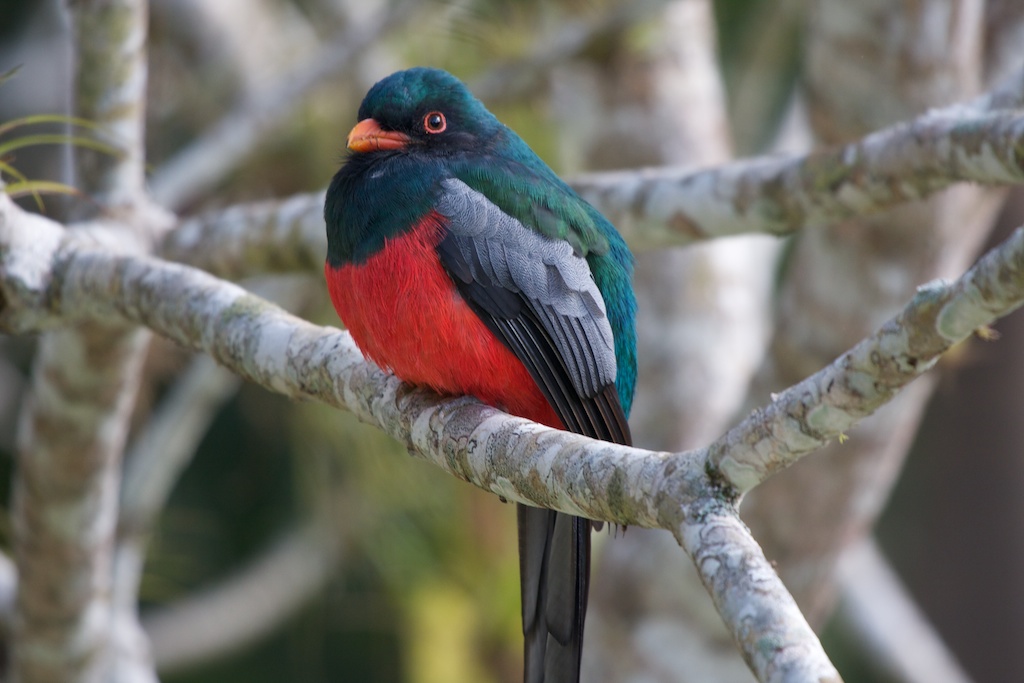
Wikipedia: Slaty-tailed trogon Source: OTHER
Trogon_massena_-Belize_-male-8.jpg
General: ![]() The slaty-tailed trogon (Trogon massena) is a near passerine bird in the trogon family, Trogonidae. It breeds in lowlands from southeastern Mexico south through Central America, to Colombia, and a small region of northwestern Ecuador.
[more]
The slaty-tailed trogon (Trogon massena) is a near passerine bird in the trogon family, Trogonidae. It breeds in lowlands from southeastern Mexico south through Central America, to Colombia, and a small region of northwestern Ecuador.
[more]
Profile Wikipedia eBird Xeno-Canto
Night tour - sleeping trogon, tenative ID by MerlinBirdID collared trogon. 2018-02-14 18.46.34 Costa Rica
First observed in Costa Rica on 2018-02-14.
![]() The collared trogon (Trogon collaris) is a near passerine bird in the trogon family, Trogonidae.
[more]
The collared trogon (Trogon collaris) is a near passerine bird in the trogon family, Trogonidae.
[more]
Profile Wikipedia eBird Xeno-Canto
Troupe of black headed trogons. 2023-04-01 09.15.04 Yucatan
First observed in Yucatan on 2023-03-31.
![]() The black-headed trogon (Trogon melanocephalus) is a species of bird in the family Trogonidae. It is found in Belize, Costa Rica, El Salvador, Guatemala, Honduras, Mexico, and Nicaragua. Its natural habitats are subtropical or tropical dry forest, subtropical or tropical moist lowland forest, and heavily degraded former forest.
[more]
The black-headed trogon (Trogon melanocephalus) is a species of bird in the family Trogonidae. It is found in Belize, Costa Rica, El Salvador, Guatemala, Honduras, Mexico, and Nicaragua. Its natural habitats are subtropical or tropical dry forest, subtropical or tropical moist lowland forest, and heavily degraded former forest.
[more]
Profile Wikipedia eBird Xeno-Canto
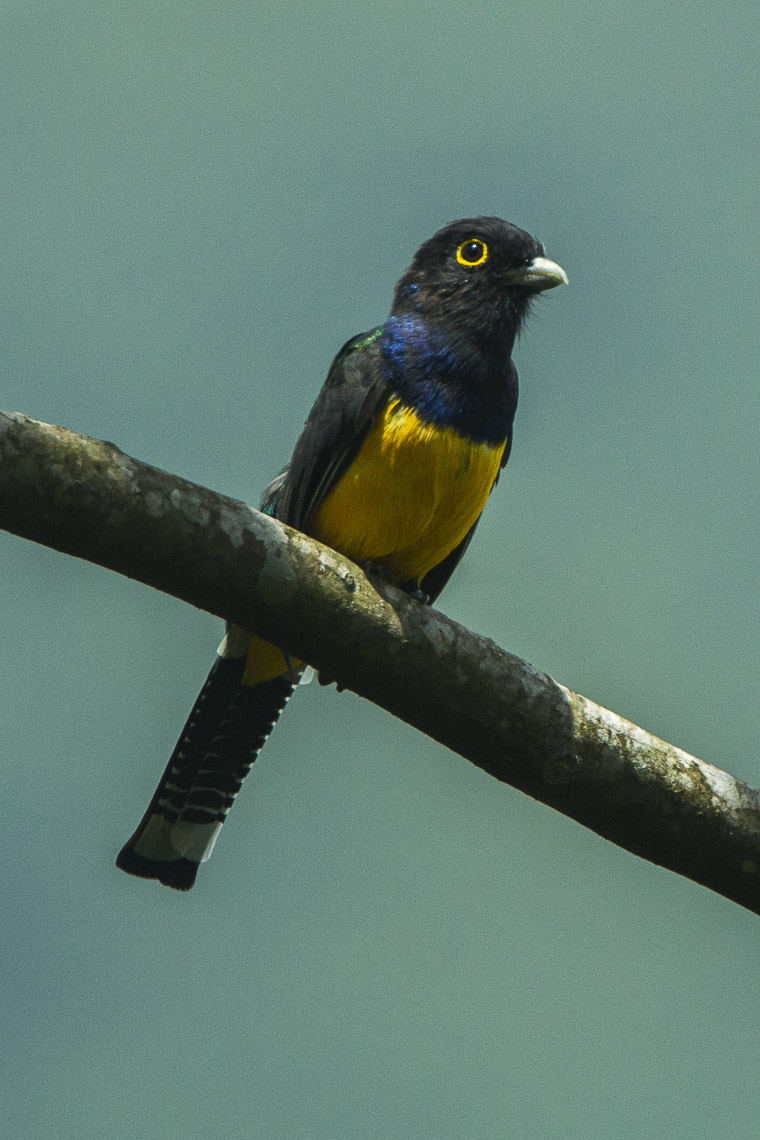
Wikipedia: Gartered trogon Source: OTHER
Gartered_Trogon_-_Mexico_S4E9784.jpg
![]() The gartered trogon (Trogon caligatus), also known as the northern violaceous trogon, is a near passerine bird in the trogon family, Trogonidae. It is found in forests in east-central Mexico, south through Central America, to north-western South America (west or north of the Andes in Colombia, Ecuador and Venezuela).[2] It was formerly treated as a subspecies of the violaceous trogon.[1][3]
[more]
The gartered trogon (Trogon caligatus), also known as the northern violaceous trogon, is a near passerine bird in the trogon family, Trogonidae. It is found in forests in east-central Mexico, south through Central America, to north-western South America (west or north of the Andes in Colombia, Ecuador and Venezuela).[2] It was formerly treated as a subspecies of the violaceous trogon.[1][3]
[more]
Profile Wikipedia eBird Xeno-Canto

Wikipedia: Rufous-tailed jacamar Source: OTHER
1200px-Rufous-tailed_jacamar_%28Galbula_ruficauda%29_male_2.JPG
![]() The rufous-tailed jacamar (Galbula ruficauda) is a near-passerine bird which breeds in the tropical New World in southern Mexico, Central America and South America as far south as southern Brazil and Ecuador.
[more]
The rufous-tailed jacamar (Galbula ruficauda) is a near-passerine bird which breeds in the tropical New World in southern Mexico, Central America and South America as far south as southern Brazil and Ecuador.
[more]
Profile Wikipedia eBird Xeno-Canto

Wikipedia: White-necked puffbird Source: OTHER
Notharchus_hyperrhynchus_-Belize_-perching_in_tree-8.jpg
![]() The white-necked puffbird (Notharchus hyperrhynchus) is a species of puffbird in the family Bucconidae.
[more]
The white-necked puffbird (Notharchus hyperrhynchus) is a species of puffbird in the family Bucconidae.
[more]
Profile Wikipedia eBird Xeno-Canto
Tikal great curassow. 2018-02-07 12.29.42 Guatemala
First observed in Guatemala on 2018-02-07.
![]() The great curassow (Crax rubra) (Spanish: hocofaisán, pavón norteño) is a large, pheasant-like bird from the Neotropical rainforests, its range extending from eastern Mexico, through Central America to western Colombia and northwestern Ecuador. Male birds are black with curly crests and yellow beaks; females come in three colour morphs, barred, rufous and black. These birds form small groups, foraging mainly on the ground for fruits and arthropods, and the occasional small vertebrate, but they roost and nest in trees. This species is monogamous, the male usually building the rather small nest of leaves in which two eggs are laid. This species is threatened by loss of habitat and hunting, and the International Union for Conservation of Nature has rated its conservation status as "vulnerable".
[more]
The great curassow (Crax rubra) (Spanish: hocofaisán, pavón norteño) is a large, pheasant-like bird from the Neotropical rainforests, its range extending from eastern Mexico, through Central America to western Colombia and northwestern Ecuador. Male birds are black with curly crests and yellow beaks; females come in three colour morphs, barred, rufous and black. These birds form small groups, foraging mainly on the ground for fruits and arthropods, and the occasional small vertebrate, but they roost and nest in trees. This species is monogamous, the male usually building the rather small nest of leaves in which two eggs are laid. This species is threatened by loss of habitat and hunting, and the International Union for Conservation of Nature has rated its conservation status as "vulnerable".
[more]
Ocellated turkey. 2018-02-07 11.57.56 Guatemala
First observed in Guatemala on 2018-02-07.
![]() The ocellated turkey (Meleagris ocellata) is a species of turkey residing primarily in the Yucatán Peninsula, Mexico, as well as in parts of Belize and Guatemala. A relative of the North American wild turkey (Meleagris gallopavo), it was sometimes previously treated in a genus of its own (Agriocharis), but the differences between the two turkeys are currently considered too small to justify generic segregation. It is a relatively large bird, at around 70–122 cm (28–48 in) long and an average weight of 3 kg (6.6 lb) in females and 5 kg (11 lb) in males.
[more]
The ocellated turkey (Meleagris ocellata) is a species of turkey residing primarily in the Yucatán Peninsula, Mexico, as well as in parts of Belize and Guatemala. A relative of the North American wild turkey (Meleagris gallopavo), it was sometimes previously treated in a genus of its own (Agriocharis), but the differences between the two turkeys are currently considered too small to justify generic segregation. It is a relatively large bird, at around 70–122 cm (28–48 in) long and an average weight of 3 kg (6.6 lb) in females and 5 kg (11 lb) in males.
[more]

Wikipedia: Black-throated bobwhite Source: OTHER
1200px-Colinus_nigrogularis_14054859.jpg

Wikipedia: Spotted wood quail Source: OTHER
1200px-Spotted_Wood_Quail%2C_Costa_Rica%2C_January_2018_%2827083973248%29.jpg
General: ![]() The spotted wood quail (Odontophorus guttatus) is a small ground-dwelling bird in the New World quail family. It is a resident breeder in the mountains of Central America from southern Mexico to western Panama.
[more]
The spotted wood quail (Odontophorus guttatus) is a small ground-dwelling bird in the New World quail family. It is a resident breeder in the mountains of Central America from southern Mexico to western Panama.
[more]
Profile Wikipedia eBird Xeno-Canto

Wikipedia: Singing quail Source: OTHER
1200px-Codorniz_Silbadora%2C_Singing_Quail%2C_Dactylortyx_thoracicus_%2823387866083%29.jpg
Profile Wikipedia eBird Xeno-Canto

Wikipedia: White-collared swift Source: OTHER
Streptoprocne_zonaris%2C_White-collared_Swift.jpg
General: ![]() The white-collared swift (Streptoprocne zonaris) is a resident breeding bird from central Mexico, the Greater Antilles and Trinidad south to Peru, northern Argentina and southeastern Brazil.
[more]
The white-collared swift (Streptoprocne zonaris) is a resident breeding bird from central Mexico, the Greater Antilles and Trinidad south to Peru, northern Argentina and southeastern Brazil.
[more]
Profile Wikipedia eBird Audubon AllAboutBirds Xeno-Canto

Wikipedia: Chimney swift Source: OTHER
Chimney_swift_overhead.jpg
![]() The chimney swift (Chaetura pelagica) is a bird belonging to the swift family Apodidae. A member of the genus Chaetura, it is closely related to both the Vaux's swift and the Chapman's swift; in the past, the three were sometimes considered to be conspecific. It has no subspecies. The chimney swift is a medium-sized, sooty gray bird with very long, slender wings and very short legs. Like all swifts, it is incapable of perching, and can only cling vertically to surfaces.
[more]
The chimney swift (Chaetura pelagica) is a bird belonging to the swift family Apodidae. A member of the genus Chaetura, it is closely related to both the Vaux's swift and the Chapman's swift; in the past, the three were sometimes considered to be conspecific. It has no subspecies. The chimney swift is a medium-sized, sooty gray bird with very long, slender wings and very short legs. Like all swifts, it is incapable of perching, and can only cling vertically to surfaces.
[more]
Profile Wikipedia eBird Audubon AllAboutBirds Xeno-Canto

Wikipedia: Vaux's swift Source: OTHER
Vaux%27s_Swift_-_La_Paz_-_Costa_Rica_MG_1768_%2826435571450%29.jpg
![]() Vaux's swift (Chaetura vauxi) is a small swift native to North America and northern South America. It was named for the American scientist William Sansom Vaux.
[more]
Vaux's swift (Chaetura vauxi) is a small swift native to North America and northern South America. It was named for the American scientist William Sansom Vaux.
[more]
Profile Wikipedia eBird Xeno-Canto
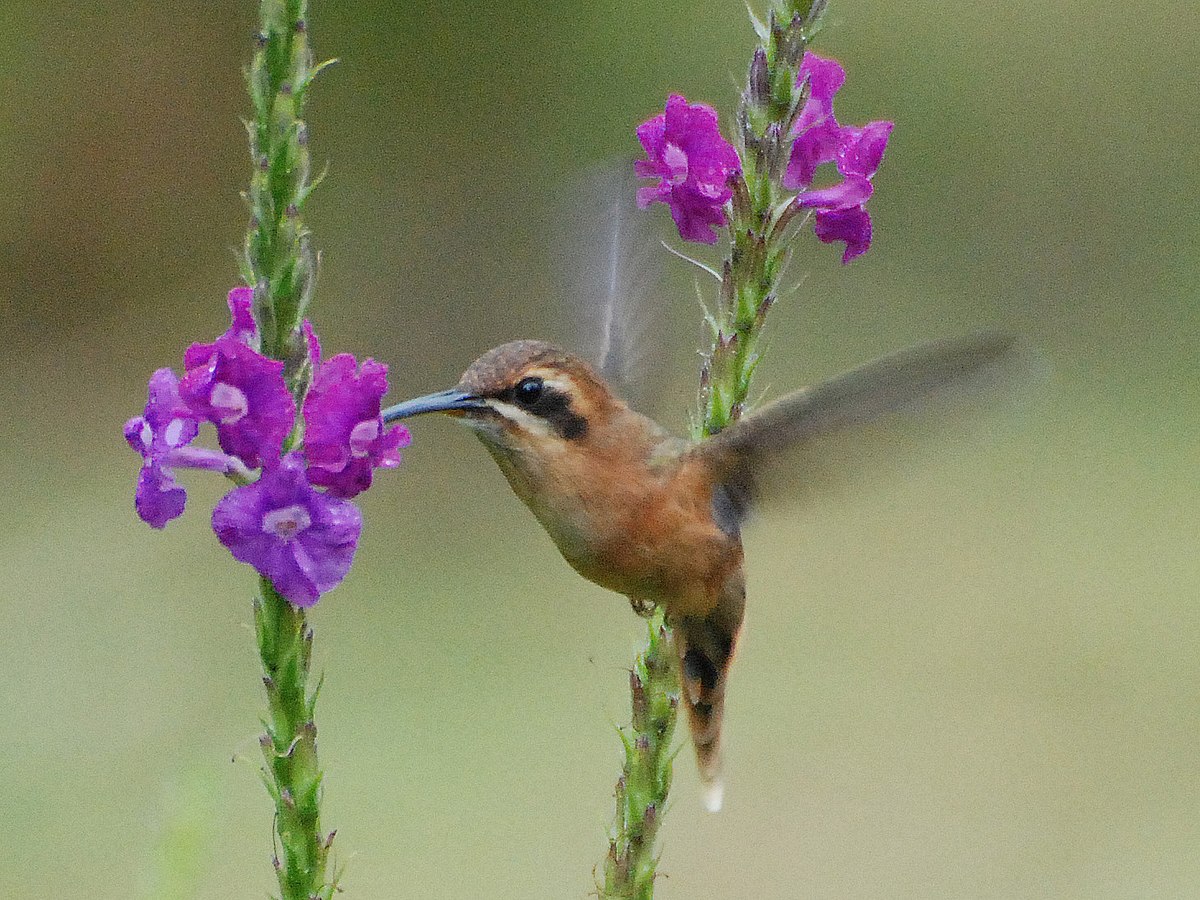
Wikipedia: Stripe-throated hermit Source: OTHER
1200px-Phaethornis_striigularis.jpg
![]() The stripe-throated hermit (Phaethornis striigularis) is a species of hummingbird from Central America and north-western South America. It is generally fairly common and considered Least Concern by BirdLife International.
[more]
The stripe-throated hermit (Phaethornis striigularis) is a species of hummingbird from Central America and north-western South America. It is generally fairly common and considered Least Concern by BirdLife International.
[more]

Wikipedia: Buff-bellied hummingbird Source: OTHER
1200px-Buff-bellied_Hummingbird-Sabal_Palm_Bird_Sanctuary-TX_-_2015-05-21at11-43-412_%2821421266100%29.jpg
![]() The buff-bellied hummingbird (Amazilia yucatanensis) is a medium-sized hummingbird. It is 10–11 cm (3.9–4.3 in) long and has a mass of 4–5 g (0.14–0.18 oz).
[more]
The buff-bellied hummingbird (Amazilia yucatanensis) is a medium-sized hummingbird. It is 10–11 cm (3.9–4.3 in) long and has a mass of 4–5 g (0.14–0.18 oz).
[more]
Cinnamon hummingbird on morning walk in Holbox. 2023-04-21 07.33.30 Yucatan
First observed in Yucatan on 2023-04-21.
![]() The cinnamon hummingbird (Amazilia rutila) is a species of hummingbird in the family Trochilidae. It is found from northwestern Mexico to Costa Rica. Its natural habitats are subtropical or tropical dry forest, subtropical or tropical moist lowland forest, subtropical or tropical dry shrubland, and heavily degraded former forest.
[more]
The cinnamon hummingbird (Amazilia rutila) is a species of hummingbird in the family Trochilidae. It is found from northwestern Mexico to Costa Rica. Its natural habitats are subtropical or tropical dry forest, subtropical or tropical moist lowland forest, subtropical or tropical dry shrubland, and heavily degraded former forest.
[more]
Funky bird on Bastimentos Island, Panama, possibly green-breasted mango. 2020-03-10 12.07.52 Panama
First observed in Panama on 2020-03-10.
![]() The green-breasted mango (Anthracothorax prevostii) is a hummingbird from tropical America. The scientific name of this bird commemorates the French naturalist Florent Prévost.
[more]
The green-breasted mango (Anthracothorax prevostii) is a hummingbird from tropical America. The scientific name of this bird commemorates the French naturalist Florent Prévost.
[more]

Wikipedia: Ruby-throated hummingbird Source: OTHER
Rubythroathummer65.jpg
![]() The ruby-throated hummingbird (Archilochus colubris) is a species of hummingbird that generally spends the winter in Central America, Mexico, and Florida, and migrates to Canada and other parts of Eastern North America for the summer to breed. It is by far the most common hummingbird seen east of the Mississippi River in North America.
[more]
The ruby-throated hummingbird (Archilochus colubris) is a species of hummingbird that generally spends the winter in Central America, Mexico, and Florida, and migrates to Canada and other parts of Eastern North America for the summer to breed. It is by far the most common hummingbird seen east of the Mississippi River in North America.
[more]
Profile Wikipedia eBird Xeno-Canto

Wikipedia: Purple-crowned fairy Source: OTHER
1200px-Heliothryx_barroti_on_nest.jpg
![]() The purple-crowned fairy (Heliothryx barroti) is a large hummingbird that breeds in the lowlands and hills from southeastern Mexico south to southwestern Ecuador.
[more]
The purple-crowned fairy (Heliothryx barroti) is a large hummingbird that breeds in the lowlands and hills from southeastern Mexico south to southwestern Ecuador.
[more]
Profile Wikipedia eBird Xeno-Canto

Wikipedia: Scaly-breasted hummingbird Source: OTHER
Scaly-breasted_Hummingbird_-_Sarapiqui_-_Costa_Rica_S4E0291_%2826084747394%29.jpg
![]() The scaly-breasted hummingbird (Phaeochroa cuvierii) is a species of hummingbird in the family Trochilidae. It is the only species placed in the genus Phaeochroa.
[more]
The scaly-breasted hummingbird (Phaeochroa cuvierii) is a species of hummingbird in the family Trochilidae. It is the only species placed in the genus Phaeochroa.
[more]
Profile Wikipedia eBird Xeno-Canto
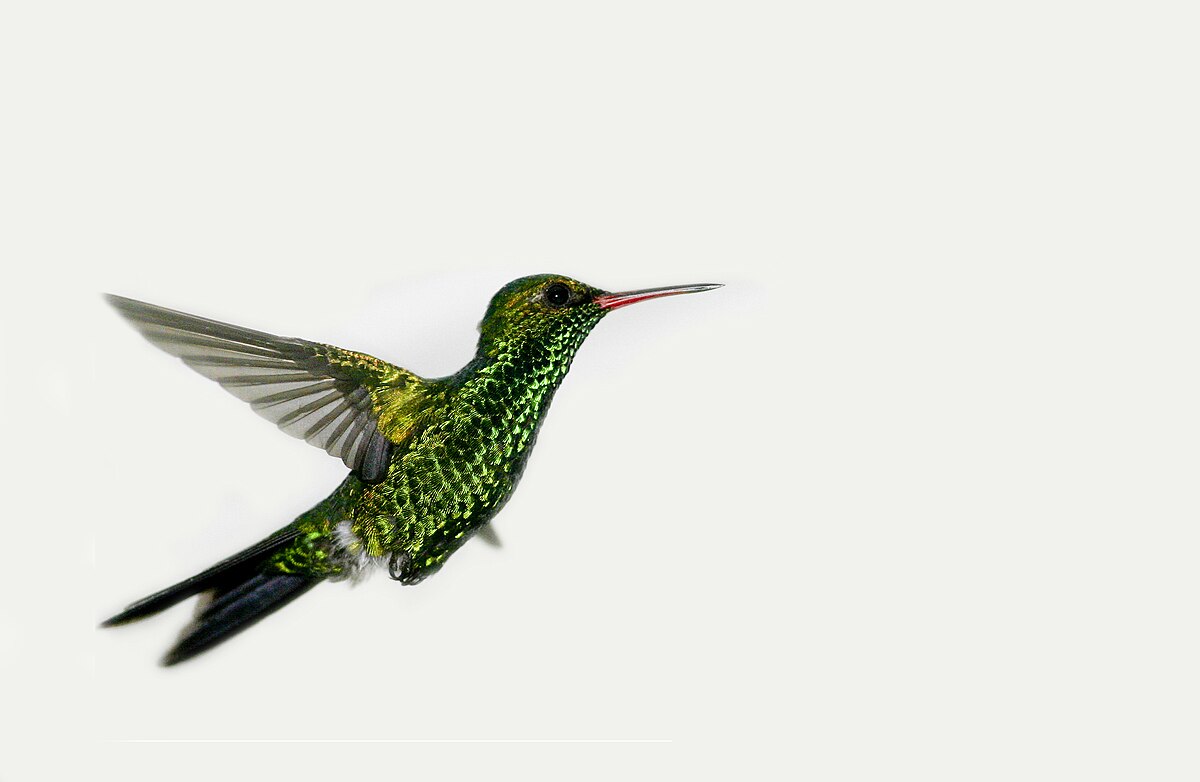
Wikipedia: Canivet's emerald Source: OTHER
1200px-Chlorostilbon_canivetii_-Utila_-Honduras-8.jpg
![]() Canivet's emerald (Cynanthus canivetii) or the fork-tailed emerald, is a species of hummingbird in the family Trochilidae. It is found in Belize, Costa Rica, El Salvador, Guatemala, Honduras, Mexico, and Nicaragua. Its natural habitats are subtropical or tropical dry forest, subtropical or tropical moist lowland forest, and heavily degraded former forest.
[more]
Canivet's emerald (Cynanthus canivetii) or the fork-tailed emerald, is a species of hummingbird in the family Trochilidae. It is found in Belize, Costa Rica, El Salvador, Guatemala, Honduras, Mexico, and Nicaragua. Its natural habitats are subtropical or tropical dry forest, subtropical or tropical moist lowland forest, and heavily degraded former forest.
[more]
Profile Wikipedia eBird Xeno-Canto

Wikipedia: Cozumel emerald Source: OTHER
1200px-Cozumel_Emerald_%286842663996%29.jpg
Endemic
Profile Wikipedia eBird Xeno-Canto
Mexican sheartail female in Rio Lagartos. 2023-04-14 16.14.26 Yucatan
First observed in Yucatan on 2023-04-14.
Endemic (country/region)

Wikipedia: Pauraque Source: OTHER
1200px-Nyctidromus_albicollis2.jpg
General: ![]() The pauraque (Nyctidromus albicollis) – also called the common pauraque to distinguish it from similar species – is a nightjar species, one of two birds in the genus Nyctidromus. It breeds in the subtropical and tropical of the New World, and except for northernmost birds it is largely resident all year round.[2]
[more]
The pauraque (Nyctidromus albicollis) – also called the common pauraque to distinguish it from similar species – is a nightjar species, one of two birds in the genus Nyctidromus. It breeds in the subtropical and tropical of the New World, and except for northernmost birds it is largely resident all year round.[2]
[more]

Wikipedia: Spot-tailed nightjar Source: OTHER
1200px-Hydropsalis_maculicaudus_-_Caprimulgus_maculicaudus_-_Spot-tailed_Nightjar.JPG

Wikipedia: Common nighthawk Source: OTHER
1200px-Common_Nighthawk_%2814428313550%29.jpg
General: ![]() The common nighthawk (Chordeiles minor) is a medium-sized [3][4] crepuscular or nocturnal bird[3][5] of the Americas within the nightjar family, whose presence and identity are best revealed by its vocalization. Typically dark[3] (grey, black and brown),[5] displaying cryptic colouration and intricate patterns, this bird is difficult to spot with the naked eye during the day. Once aerial, with its buoyant but erratic flight, this bird is most conspicuous. The most remarkable feature of this aerial insectivore is its small beak that belies the massiveness of its mouth. Some claim appearance similarities to owls. With its horizontal stance[3] and short legs, the common nighthawk does not travel frequently on the ground, instead preferring to perch horizontally, parallel to branches, on posts, on the ground or on a roof.[5] The males of this species may roost together but the bird is primarily solitary. The common nighthawk shows variability in territory size.[4]
[more]
The common nighthawk (Chordeiles minor) is a medium-sized [3][4] crepuscular or nocturnal bird[3][5] of the Americas within the nightjar family, whose presence and identity are best revealed by its vocalization. Typically dark[3] (grey, black and brown),[5] displaying cryptic colouration and intricate patterns, this bird is difficult to spot with the naked eye during the day. Once aerial, with its buoyant but erratic flight, this bird is most conspicuous. The most remarkable feature of this aerial insectivore is its small beak that belies the massiveness of its mouth. Some claim appearance similarities to owls. With its horizontal stance[3] and short legs, the common nighthawk does not travel frequently on the ground, instead preferring to perch horizontally, parallel to branches, on posts, on the ground or on a roof.[5] The males of this species may roost together but the bird is primarily solitary. The common nighthawk shows variability in territory size.[4]
[more]
Profile Wikipedia eBird Audubon AllAboutBirds Xeno-Canto

Wikipedia: Lesser nighthawk Source: OTHER
1200px-Chordeiles_acutipennis_-_Lesser_Nighthawk.jpg
![]() The lesser nighthawk (Chordeiles acutipennis) is a nightjar found throughout a large part of the Americas.
[more]
The lesser nighthawk (Chordeiles acutipennis) is a nightjar found throughout a large part of the Americas.
[more]

Wikipedia: Chuck-will's-widow Source: OTHER
1200px-Chuck-wills-widow_RWD7.jpg
![]() The chuck-will's-widow (Antrostomus carolinensis) is a nocturnal bird of the nightjar family Caprimulgidae. It is found in the southeastern United States near swamps, rocky uplands, and pine woods. It migrates to the West Indies, Central America, and northwestern South America.
[more]
The chuck-will's-widow (Antrostomus carolinensis) is a nocturnal bird of the nightjar family Caprimulgidae. It is found in the southeastern United States near swamps, rocky uplands, and pine woods. It migrates to the West Indies, Central America, and northwestern South America.
[more]
Profile Wikipedia eBird Xeno-Canto

Wikipedia: Yucatan nightjar Source: OTHER
1200px-Antrostomus_badius_map.svg.png
Endemic
Profile Wikipedia eBird A-Z Animals Xeno-Canto
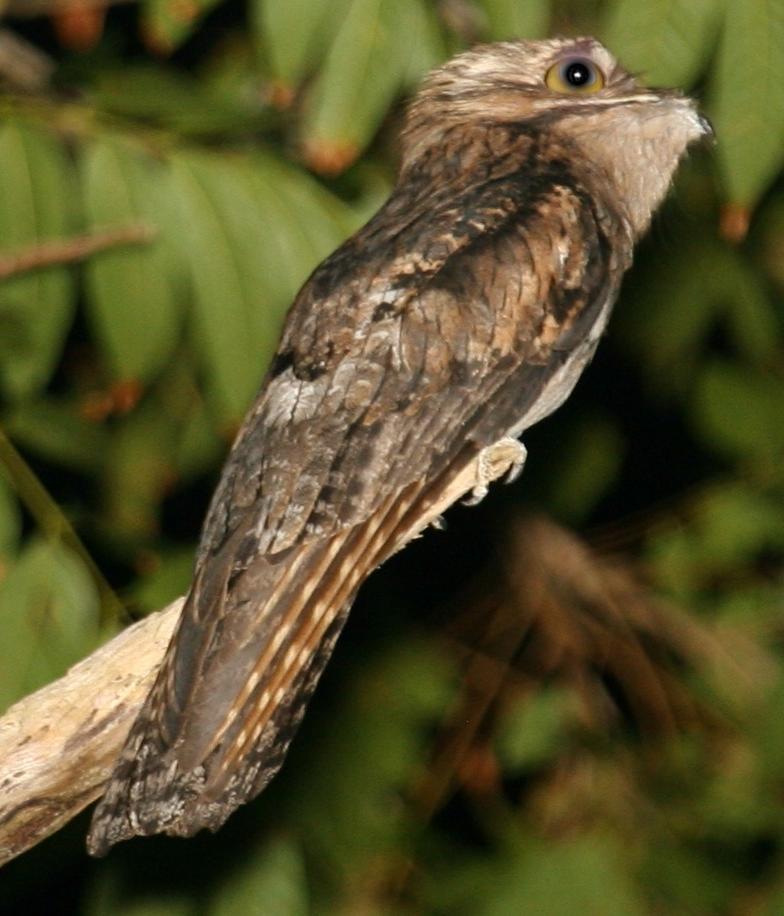
Wikipedia: Northern potoo Source: OTHER
Nyctibius_jamaicensis.jpg
General: ![]() The northern potoo (Nyctibius jamaicensis) is a nocturnal bird belonging to the potoo family, Nyctibiidae. It is found from Mexico south to Costa Rica, and on the islands of Jamaica and Hispaniola (Dominican Republic). It was formerly classified as a subspecies of the common potoo (Nyctibius griseus) but is now usually treated as a separate species based on differences in vocalizations.
[more]
The northern potoo (Nyctibius jamaicensis) is a nocturnal bird belonging to the potoo family, Nyctibiidae. It is found from Mexico south to Costa Rica, and on the islands of Jamaica and Hispaniola (Dominican Republic). It was formerly classified as a subspecies of the common potoo (Nyctibius griseus) but is now usually treated as a separate species based on differences in vocalizations.
[more]
Classification errors:
Double-crested cormorant / Ohrenscharbe (Nannopterum auritum)
Double-crested cormorants hang out on the lightpost in Campeche. 2023-04-06 16.59.40 Yucatan
First observed in Yucatan on 2023-04-06.
![]() The double-crested cormorant (Phalacrocorax auritus) is a member of the cormorant family of water birds. Its habitat is near rivers and lakes as well as in coastal areas, and is widely distributed across North America, from the Aleutian Islands in Alaska down to Florida and Mexico. Measuring 70–90 cm (28–35 in) in length, it is an all-black bird which gains a small double crest of black and white feathers in breeding season. It has a bare patch of orange-yellow facial skin. Five subspecies are recognized. It mainly eats fish and hunts by swimming and diving. Its feathers, like those of all cormorants, are not waterproof and it must spend time drying them out after spending time in the water. Once threatened by the use of DDT, the numbers of this bird have increased markedly in recent years.
[more]
The double-crested cormorant (Phalacrocorax auritus) is a member of the cormorant family of water birds. Its habitat is near rivers and lakes as well as in coastal areas, and is widely distributed across North America, from the Aleutian Islands in Alaska down to Florida and Mexico. Measuring 70–90 cm (28–35 in) in length, it is an all-black bird which gains a small double crest of black and white feathers in breeding season. It has a bare patch of orange-yellow facial skin. Five subspecies are recognized. It mainly eats fish and hunts by swimming and diving. Its feathers, like those of all cormorants, are not waterproof and it must spend time drying them out after spending time in the water. Once threatened by the use of DDT, the numbers of this bird have increased markedly in recent years.
[more]
Ruby-crowned kinglet (Corthylio calendula)
Profile Wikipedia eBird A-Z Animals Audubon AllAboutBirds Xeno-Canto
Ruby-crowned kinglet. 2022-04-29 10.02.10 Maryland
First observed in Maryland on 2022-04-29.
![]() The ruby-crowned kinglet (Regulus calendula) is a very small passerine bird found throughout North America. It is a member of the kinglet family. The bird has olive-green plumage with two white wing bars and a white eye-ring. Males have a red crown patch, which is usually concealed. The sexes are identical (apart from the crown), and juveniles are similar in plumage to adults. It is one of the smallest songbirds in North America. The ruby-crowned kinglet is not closely related to other kinglets, and is put in its own subgenus, Corthylio. Three subspecies are currently recognized.
[more]
The ruby-crowned kinglet (Regulus calendula) is a very small passerine bird found throughout North America. It is a member of the kinglet family. The bird has olive-green plumage with two white wing bars and a white eye-ring. Males have a red crown patch, which is usually concealed. The sexes are identical (apart from the crown), and juveniles are similar in plumage to adults. It is one of the smallest songbirds in North America. The ruby-crowned kinglet is not closely related to other kinglets, and is put in its own subgenus, Corthylio. Three subspecies are currently recognized.
[more]
White-bellied emerald / Bronzekopfamazilie (Chlorestes candida)
Profile Wikipedia eBird Xeno-Canto

Wikipedia: White-bellied emerald Source: OTHER
1200px-White-bellied_emerald_%28Chlorestes_candida_candida%29_in_flight_Peten.jpg
![]() The white-bellied emerald (Chlorestes candida) is a species of hummingbird in the "emeralds", tribe Trochilini of subfamily Trochilinae. It is found in Belize, Guatemala, Honduras, Panamá, Mexico, and Nicaragua.[4][3]
[more]
The white-bellied emerald (Chlorestes candida) is a species of hummingbird in the "emeralds", tribe Trochilini of subfamily Trochilinae. It is found in Belize, Guatemala, Honduras, Panamá, Mexico, and Nicaragua.[4][3]
[more]
White hawk (alternate) / Schneebussard (Pseudastur albicollis)
![]() Der Schneebussard (Pseudastur albicollis, Syn.: Leucopternis albicollis) ist ein Greifvogel aus der Familie der Habichtartigen. Die nur wenig erforschte Art ist in den tropischen und subtropischen Wäldern Süd- und Mittelamerikas verbreitet. Besonders auffällig ist das kontrastreiche Gefieder, das in Schwarz- und Weißtönen gefärbt ist. Schneebussarde gelten allgemein als nicht gefährdet, ihr Bestand nimmt jedoch durch das zunehmende Verschwinden der Wälder in der Region kontinuierlich ab.
[more]
Der Schneebussard (Pseudastur albicollis, Syn.: Leucopternis albicollis) ist ein Greifvogel aus der Familie der Habichtartigen. Die nur wenig erforschte Art ist in den tropischen und subtropischen Wäldern Süd- und Mittelamerikas verbreitet. Besonders auffällig ist das kontrastreiche Gefieder, das in Schwarz- und Weißtönen gefärbt ist. Schneebussarde gelten allgemein als nicht gefährdet, ihr Bestand nimmt jedoch durch das zunehmende Verschwinden der Wälder in der Region kontinuierlich ab.
[more]
Lesser swallow-tailed swift (Panyptila cayennensis)
Profile Wikipedia eBird Xeno-Canto

Wikipedia: Lesser swallow-tailed swift Source: OTHER
Panyptila_cayennensis_-NW_Ecuador-4.jpg
![]() The lesser swallow-tailed swift or Cayenne swift (Panyptila cayennensis) is a species of bird in subfamily Apodinae of the swift family Apodidae. It is found from southern Mexico through Central America; in every mainland South America country except Argentina, Chile, Paraguay, and Uruguay; and on Trinidad.[2][3][4]
[more]
The lesser swallow-tailed swift or Cayenne swift (Panyptila cayennensis) is a species of bird in subfamily Apodinae of the swift family Apodidae. It is found from southern Mexico through Central America; in every mainland South America country except Argentina, Chile, Paraguay, and Uruguay; and on Trinidad.[2][3][4]
[more]
Lesser greenlet (alternate) (Pachysylvia decurtata)
Wedge-tailed sabrewing (alternate) / Blaukron-Degenflügel (Pampa curvipennis)

